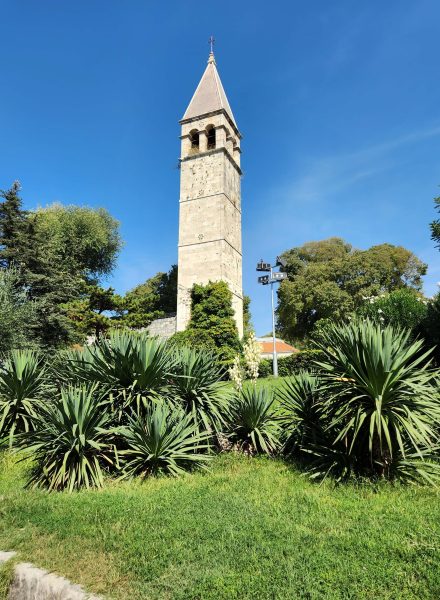Can = able to do something.
May = permission to do something.

Can = able to do something.
May = permission to do something.


Over the years, when I’ve checked into various places, I’ve discovered that there are other women with the same first and last names as mine. One time, I asked the check-in person how many other people shared my name on her list and she said, “Five.” Just the other day, I asked again and the registrar said, “Eight.” Wow!
When my kids were little, I took Jeff to the pediatrician for something or other, and the nurse needed clarification about which Diane and Jeff we were because there was another mother who shared my name and had a son named Jeff. During a recent (flattering) check-in experience, the check-in lady asked me to re-verify my birthdate. I told her I know there are other women with the same name as mine, but I didn’t know I shared a birthdate with any of them. “Oh, no,” she said, “you don’t. You just didn’t look that old.” 🙂
In all the time I’ve known about these name doppelgangers, I’ve never met one until (drum roll, please) my last haircut appointment. When I checked in, the check-in lady asked if I was with Donna or Michelle (the stylists). I said “Donna.” She replied that her computer showed me scheduled with Michelle. Then she noticed that I was listed with both Donna and Michelle. At that moment, another woman spoke up and said she had an appointment with Michelle, and we all realized that the other woman and I had the same first and last names.
Here I am with my name twin. We were seated in side-by-side chairs while we waited for Donna and Michelle, so we chatted with each other and decided we should have a photo of ourselves. You can see Donna and Michelle in the mirror behind us. Donna is taking the picture.
Today, there was serendipity at the salon.
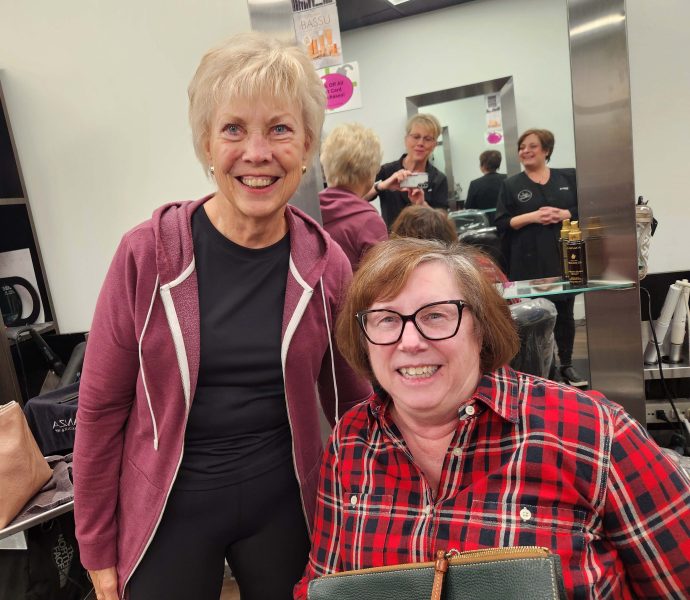

One of our gallery pictures of our grandson has always hung crooked, no matter what I did to straighten it. One day, I decided to weight the picture with pennies. Unfortunately, between Ted and me, we had only one penny, and that turned out to be insufficient. The picture still hung crooked.
I mentioned this little problem at a family gathering and said I thought I needed another two cents. The conversation moved on, but after a few minutes, Dylan re-entered the room and handed me two cents. Thank you, Dylan!
I added Dylan’s pennies to the back of the picture and it still didn’t hang straight, so I tried a nickel. That didn’t help, so I moved up to a quarter. That helped a little. When I added a second quarter, the picture hung straight.
I don’t think I’ve ever added more than two cents to a picture, but this one was a 53-cent job. The bottom corner of the picture butted up against the door frame. I wonder how far it would have tilted if the door frame didn’t stop it. Well, at least it’s finally straight and this little guy’s picture is no longer cockeyed.
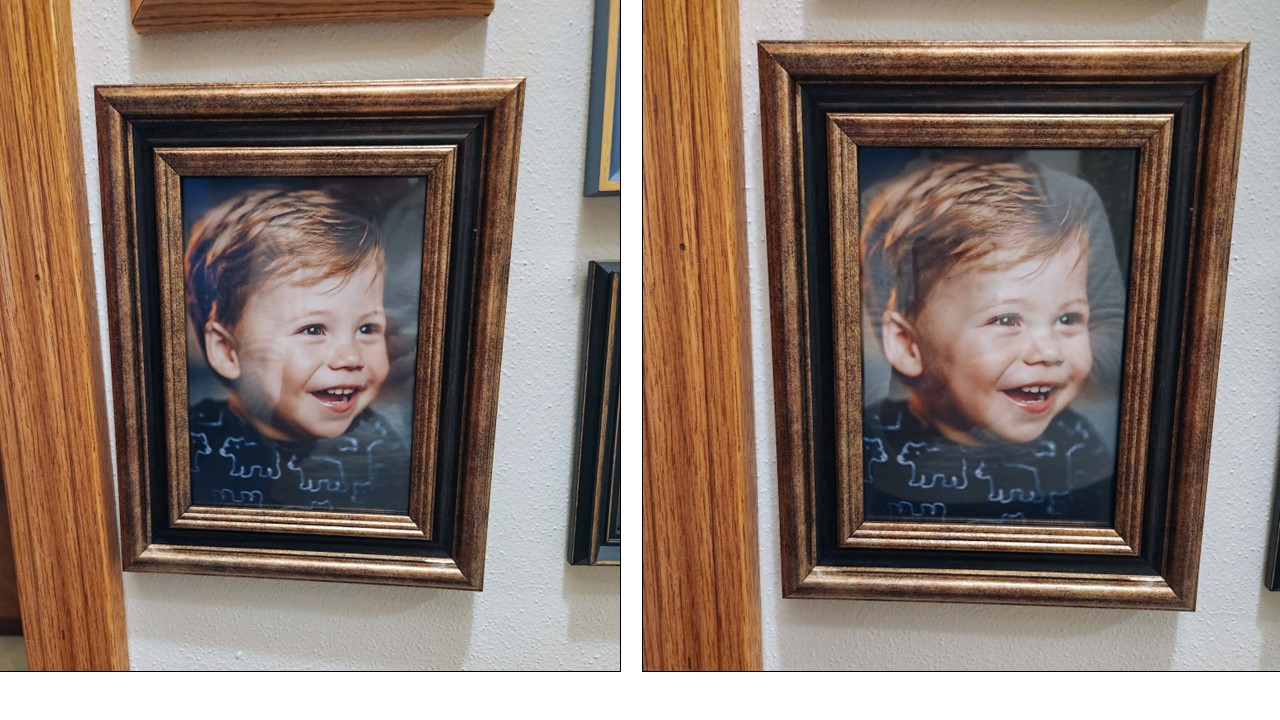
Ted and I had to clear our walls for the painters in Fall 2022. We were both tired of looking at the same old things on the walls, so we decided that we would only re-hang the things we missed looking at. One of the things we missed looking at was a two-piece sculpture. It’s not an easy thing to hang. The two pieces need to be properly aligned; they are heavy and awkward to handle; and the design pieces have sharp corners. An added challenge is that it needs to be hung on eight irregularly arranged hangers.
I decided that a template would probably avoid repeated trial-and-error efforts, so we spread some large, taped-together sheets of paper on the basement floor and properly aligned the sculpture pieces on them. Then we marked where the irregular hangers were so we’d know where to put the nails into the wall. The hangers are welded to the sculpture frame, but the frame does not extend to the edges of the sculpture. That provided another challenge: deciding where to place the template on the wall so that the sculpture would hang where we wanted it to be. We worked with the outside measurements of the sculpture and the template to determine the center, transferred those measurements to the wall, and then taped the template to the wall.
Instead of pounding the nails all the way in on the template markings, I tapped them just hard enough to make a visible dent in the drywall. Then we removed the template and put in four of the eight nails we needed–just enough to hold the sculpture temporarily–before hanging the sculpture to check its placement. It looked good, so we took it down and hammered in the other four nails. Now the sculpture is securely hung and the placement looks good. Nice work, if I do say so myself.
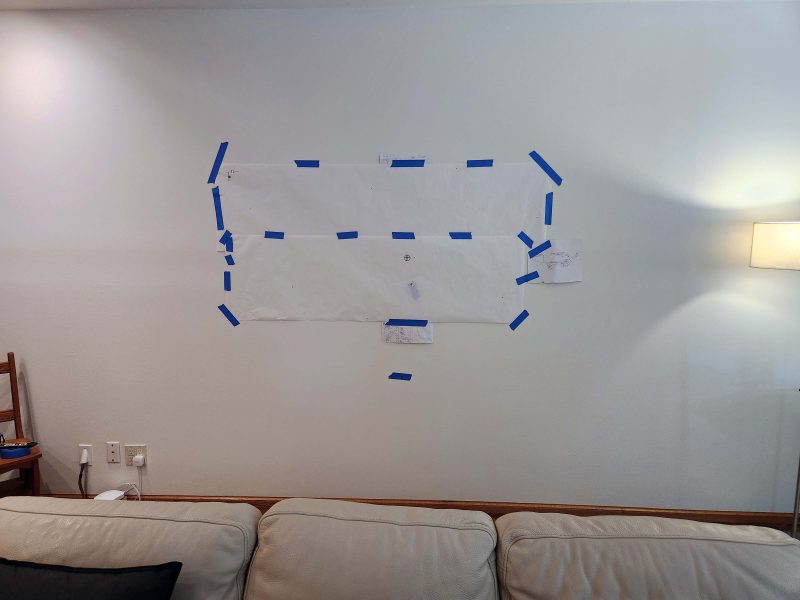
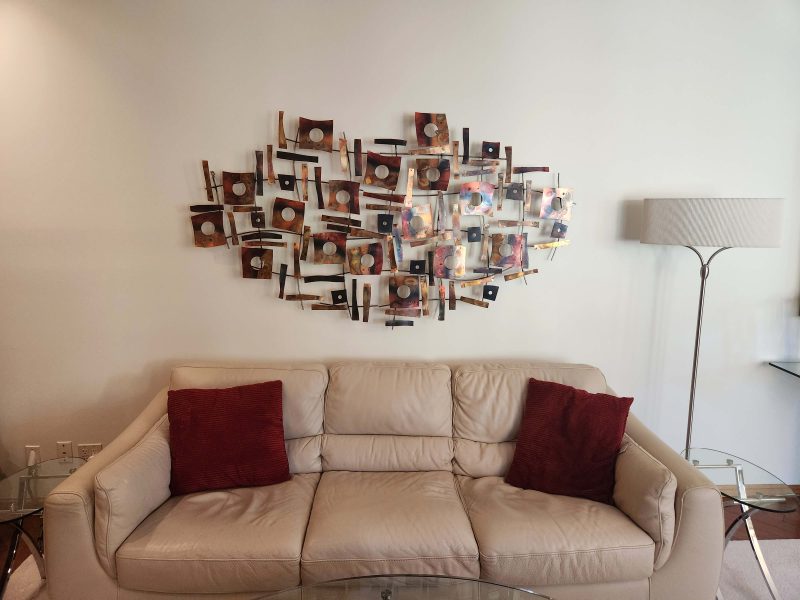
I saw this sign when I was shopping on historic Main Street in St. Charles.
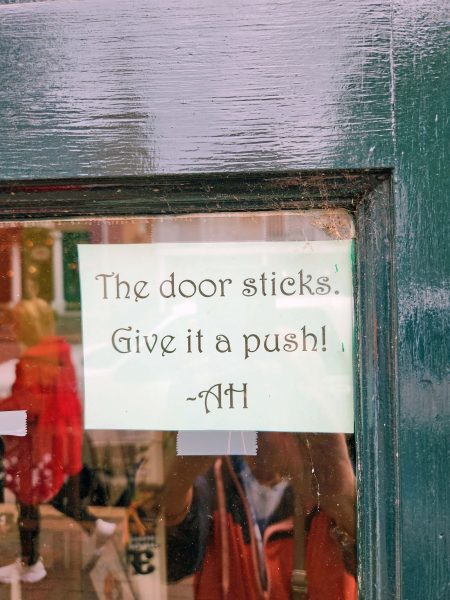
Question: What kind of shoes does an optometrist wear?
Answer: “Seeing eye” shoes. Really. This is what my optometrist was wearing at my appointment.
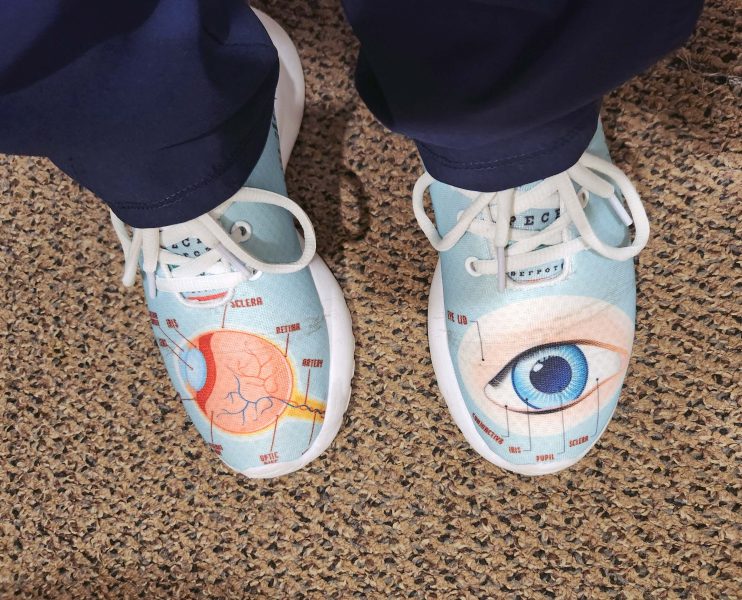

Back in September, the U.S. Marine Corps literally lost (as in couldn’t find) one of its aircraft in South Carolina. The F-35 Lightning II stealth fighter jet went missing after the pilot ejected. The plane flew about 60 miles without its pilot and then crashed into a wooded area. The Marine Corps ordered a two-day stand down while they searched for the jet.
According to CNN, Rep. Nancy Mace of South Caroline wrote on X “How in the hell do you lose an F-35? How is there not a tracking device and we’re asking the public to what, find a jet and turn it in?”
Here’s an idea from Walt Handelsman, a cartoonist.

Thanks to the kitchen update, the basement workshop got an update too. The last time we updated our kitchen, we selected some of the old, to-be-removed cabinets from the kitchen and had them moved to the workshop for neater storage down there.
The cabinets pictured below were original to the house, and are now 44 years old. They show their age and the drawers no longer work very well. Naturally, the upper cabinet is installed (i.e., fastened to the wall). The lower three pieces, however, are just set in place against the wall with the countertop pieces simply resting on the cabinet tops, making those pieces easy to move. Not surprisingly, we never moved them. The PVC pipe drains the washing machine above, so the cabinets were placed separately on each side of it. The dark portions of the cabinet sides are the original color of the cabinets. I hated that dark color when we bought the house, so I stripped the cabinets and stained them lighter. The dark areas were against adjacent cabinets, so those portions didn’t get stripped. You can see the raw edge of the Formica countertop in the center. That countertop wasn’t originally on that cabinet; the workers at the time cut it to fit.
This was the workshop in the basement, so we didn’t need or expect beautiful cabinetry. We were satisfied for many years, but with new cabinets coming to the kitchen, it was the perfect time to replace these worn-out cabinets with something only half their age.
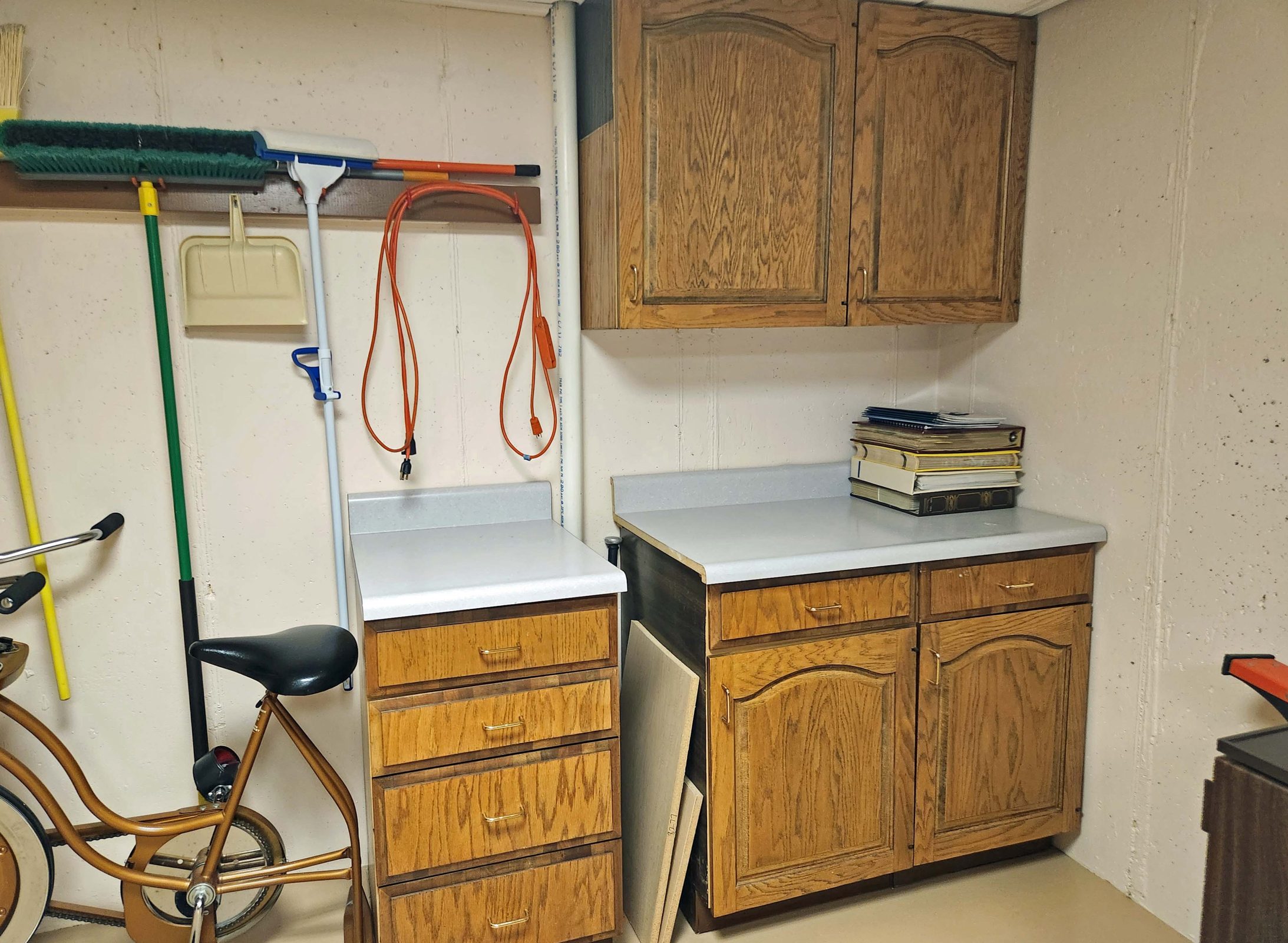
When our kitchen crew, Christian and Craig, removed the upper cabinets in the workshop, they noticed mold and some ceiling tile damage. That must have developed years ago when the washer hose broke and sent a full load of water to the basement floor–gallons of wash water and more gallons of rinse water. I left the washer running while I was away from home, so I wasn’t there to immediately turn off the water. Oops! What a mess that was to clean up! Since the cabinets were installed before the washer hose ruptured, we couldn’t dry the water or remove the ceiling tiles above them, and we couldn’t see the resulting damage. As a result, the water absorbed by the ceiling tiles in that area dried slowly enough to develop mold. It’s a good thing Christian and Craig could repair it now.
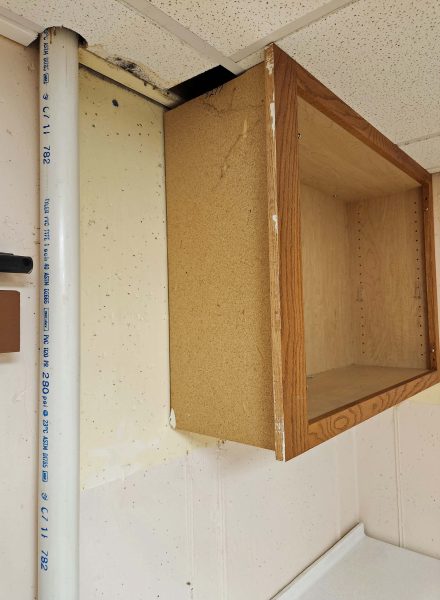
I expected the same kind of installation from Christian and Craig as we had last time: attach the upper cabinet to the wall, put the lower ones in place, and cut the countertop(s) to fit. Wow! Was I surprised!
These guys didn’t put the cabinets in the basement; they installed them. They leveled everything and fastened every cabinet to its adjacent wall and to its adjacent cabinet. To hide the drainpipe space needed between the cabinets, the guys cut a spacer from a flat wood panel taken from a to-be-trashed cabinet from the kitchen, and inserted the spacer between the cabinet sections (arrow). None of the removed countertop pieces was long enough for the entire lower surface, so the right portion has a backsplash and the left portion doesn’t. To make a continuous countertop around the drainpipe, Christian cut a half-circle into the back edge of the countertop and joined the two pieces with a nearly invisible seam sealed with clear caulk. The back edge is also caulked along the wall. All of those details make the four lower cabinet pieces look like a single unit. Compare the photo below with the top photo above. Attention to detail makes a big difference!
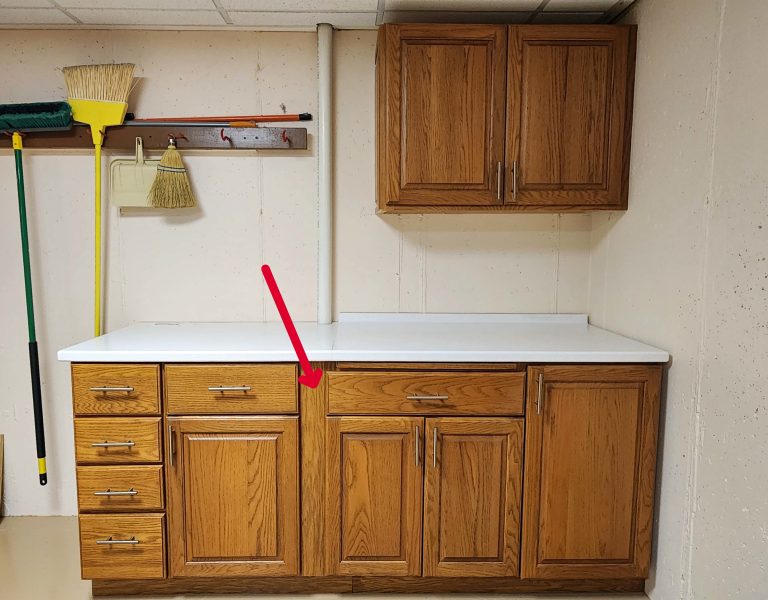
Speaking of details, . . . The over-the-top thing the guys did in the basement was to cover the exposed end of the upper cabinet with a trim piece (below). It’s not a perfect fit, but, like the spacer and the continuous countertop, I didn’t expect that level of detail in the workshop. Craig cut the piece from one of the old, matching cabinet doors and attached it to make the upper cabinet look nice from the side. Uh, that would be the side that faces the storage room. Doesn’t everyone want to see a beautifully finished workshop cabinet edge from the storage room?! Christian and Craig certainly do!
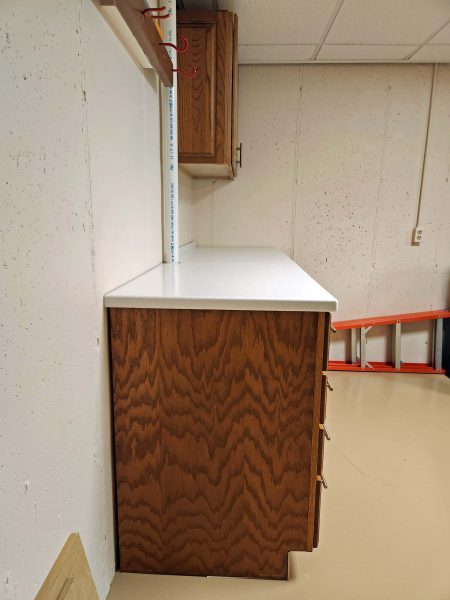
I expected these repurposed cabinets to look a lot like the previous ones, but in better condition. Instead, I feel like we ought to do something special in this room to justify such nice cabinetry. When I repeatedly complimented Christian and Craig on how beautiful the cabinets looked, they kind of shrugged as if to say, “How else would we have done it?” and Craig said, “Well, I like my workshop nice.” Obviously, it could have been done as simply as the previous crew did with the previous cabinets, but that’s not how these guys roll.
When we emptied all of our living area rooms for painting and carpeting in Fall 2022, we got rid of so many things, that we removed shelving and still have extra shelf space. The same was true when we refilled the “new” basement cabinets–we have extra space in our updated workshop. I wonder how long it will take us to fill all the empty shelf space we now have throughout the house. There’s a saying that the more countertop you have, the more things you set on it. I’ll bet the same is true for closets and shelves.
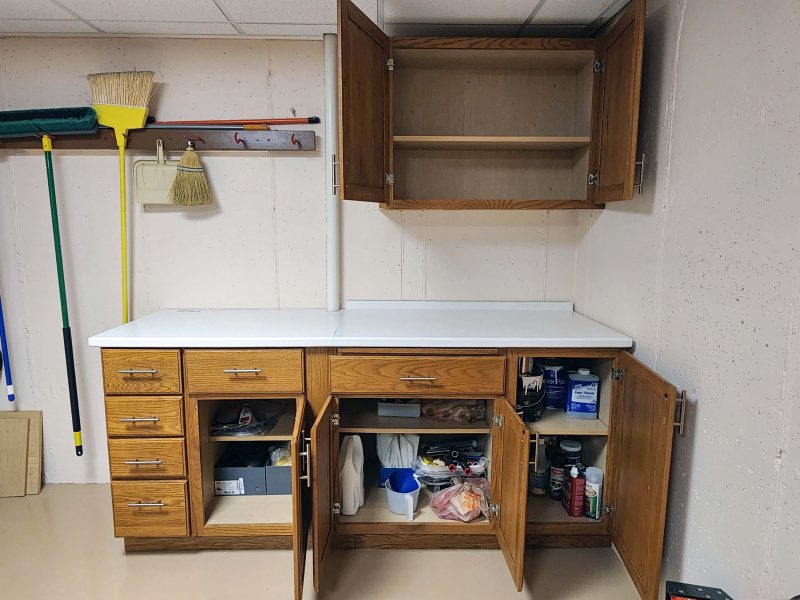
Our kitchen update project included some changes to bring our kitchen from its circa 2000 look to the 2020s era of design. Most of the changes were optional. One was not.
One evening last spring, while Ted and I were eating dinner, the chandelier we installed when we updated our kitchen 20+ years ago abruptly turned itself off. Everything looked good when we checked the breakers and the light switch connection. We tested the five light bulbs in another lamp and they all worked fine. In August 2022, we had the electrical box for this light moved to center it over the kitchen table. We wondered if there might be a problem with the installation, and felt nervous about using a light that might have wiring problems. I called our electrician, and he assured me that, as long as the switch was turned off, we were not in danger of an electrical fire. We planned to replace the chandelier with a new one during our kitchen update, but now we had a sense of urgency to shop.
We bought a new chandelier and called the electrician to install it. When he removed the damaged light from the ceiling connection, he found the problem. The installer who moved the kitchen table light in 2022 (same company) pinched some wires with a screw when he attached the chandelier to the electrical box, and that eventually broke the wire. You can see the damage indicated by the arrows in the photo below. After installing the new light, the electrician prepared to leave and informed us there was no charge for the service. The company, he said, stands behind its work and we lost a chandelier due to their error. He even offered $100 toward our new light.
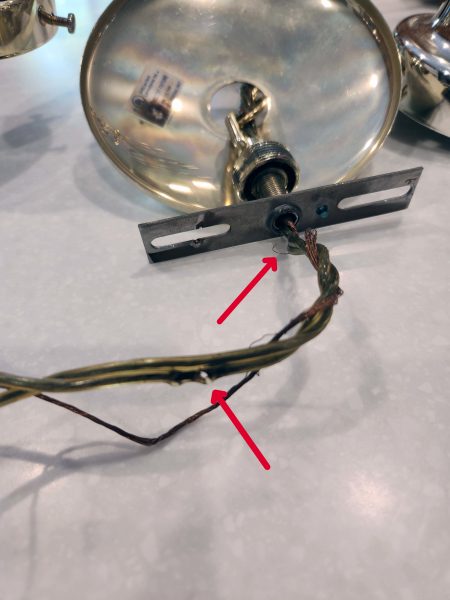
While he left his work area to get some other tools, the electrician let the (relatively heavy) new chandelier hang by a wire designed to hold the fixture during the installation process (left). I’d have been nervous about doing that, but it worked just fine. We used a 1980s vintage pole lamp from the basement (in the corner, left photo) for table lighting while we shopped and waited for the new chandelier installation. The right photo shows the new chandelier, properly attached to the ceiling.
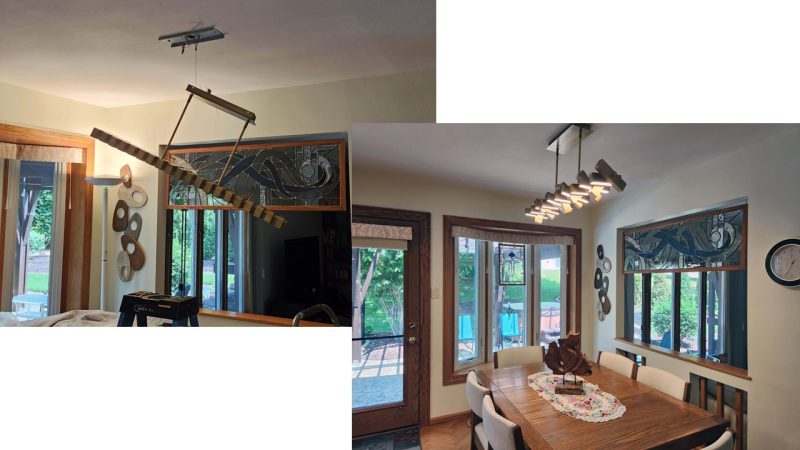
In addition to the new chandelier, we made a number of other changes to our kitchen design. There weren’t a lot of home devices to charge in the late 1990s when we last updated our kitchen, so one of our kitchen outlets used to look like the left photo. All of those plugs are inserted into a six-gang tree with 2 USB chargers which, in turn, is plugged into a two-gang outlet. Twenty-some years later, we had a six-gang outlet with built-in chargers installed to accommodate our current needs at that location. Much neater.
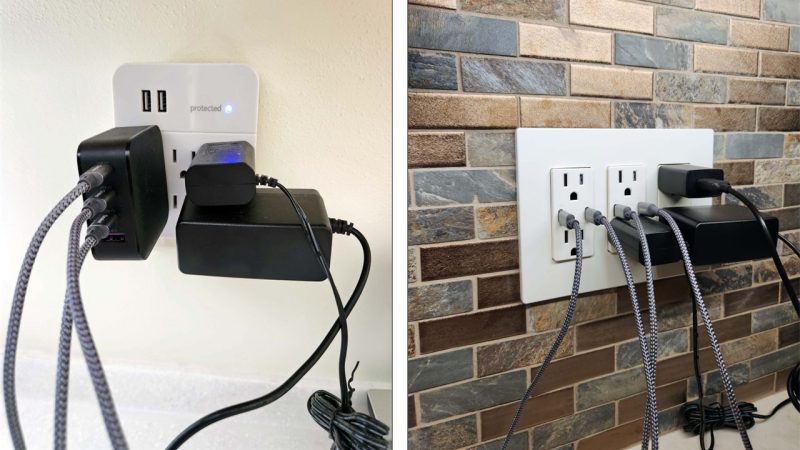
Instead of our Bed, Bath & Beyond silverware tray, we now have a two-tiered built-in silverware tray in this drawer.
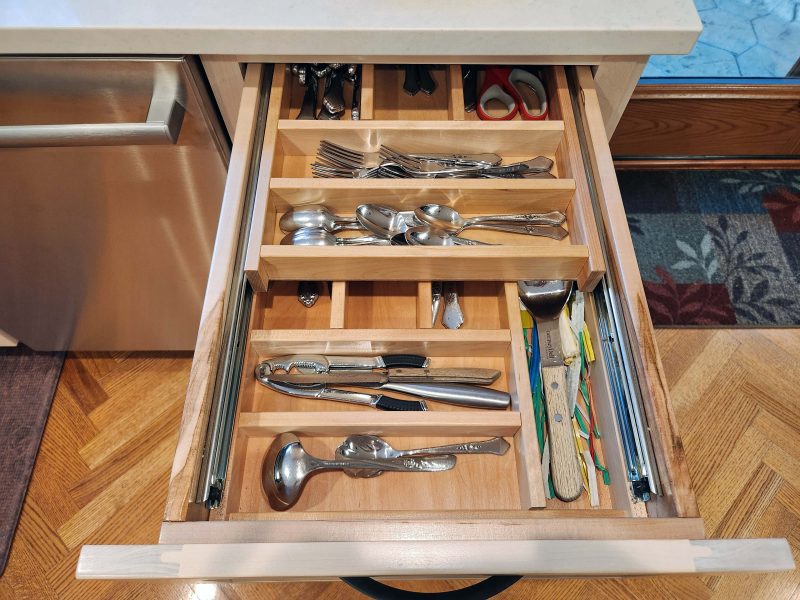
All of the lower cabinets have drawers instead of shelves. Now it’s much easier to put things away and to get them out because we don’t have to remove the items in the front to extract an item from the back.
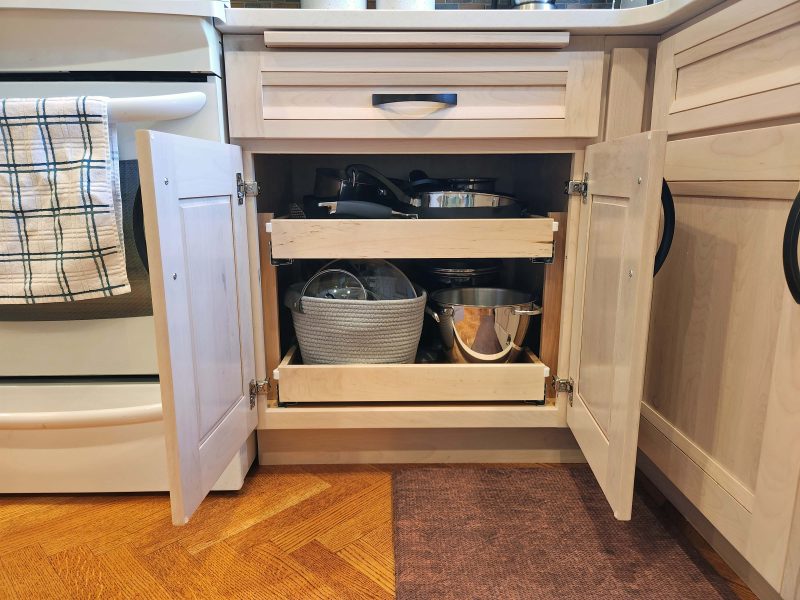
We added a drawer to the island so that we can store placemats and napkins conveniently near the table.
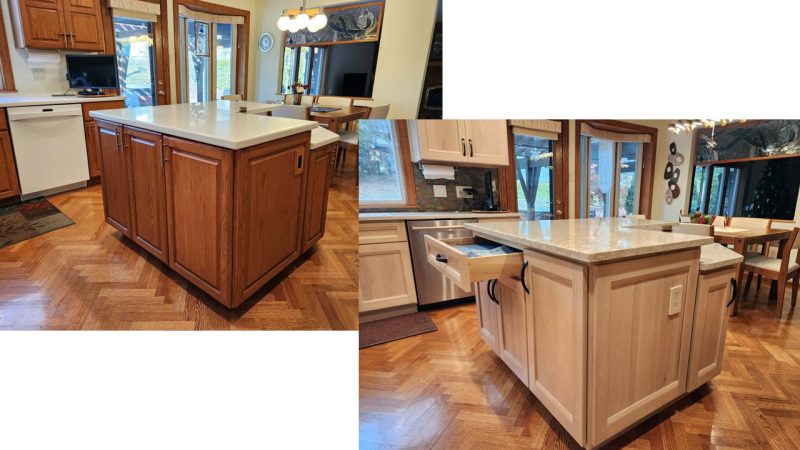
In our last kitchen update, the island backsplash matched the countertop. This time, we matched it to the backsplash over the cabinets.
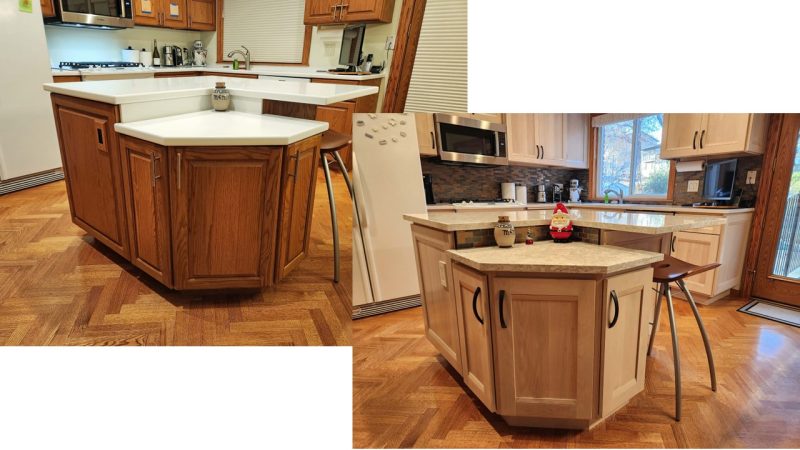
Some of our previous cabinets had a matching flat panel on the exposed sides. This time, we added a trim panel to all the exposed sides, even in the corner where we keep the stool.
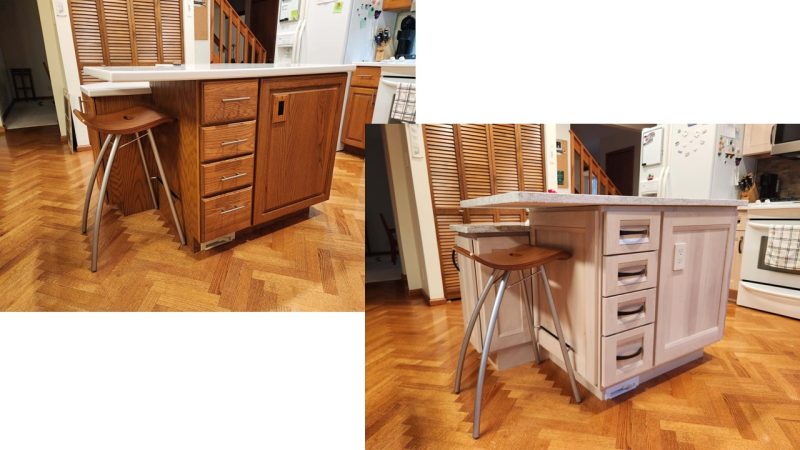
We replaced our Corian sink with a composite one. The Corian sink was still in great shape, but could not be removed from the surrounding Corian countertops, since they were poured together. Now we have a composite sink attached separately to the countertops.
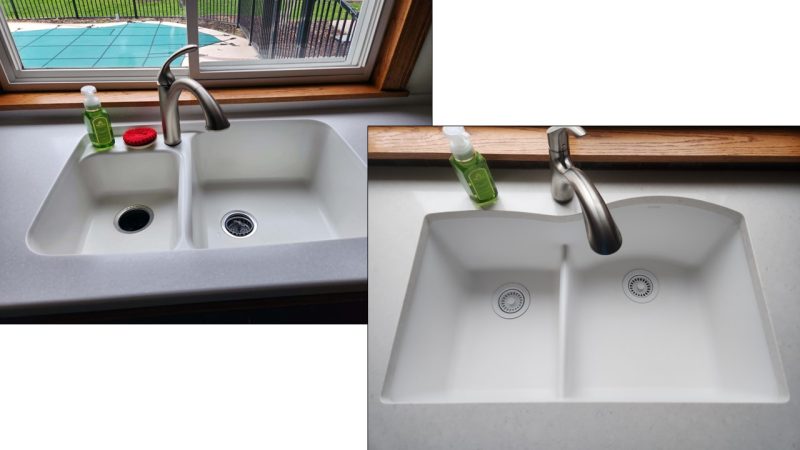
For this update, we ordered upper cabinets of varied depths to eliminate the straight-line front edge of the upper cabinets. Compare the old kitchen look (left) with the updated look (right).

Here’s a picture of Jimmy’s, Christian’s, Craig’s, Ted’s, and my favorite change: the LED strip lighting over the countertops. It’s gorgeous in the evenings when the random bronze-colored backsplash tiles shine softly in the light.
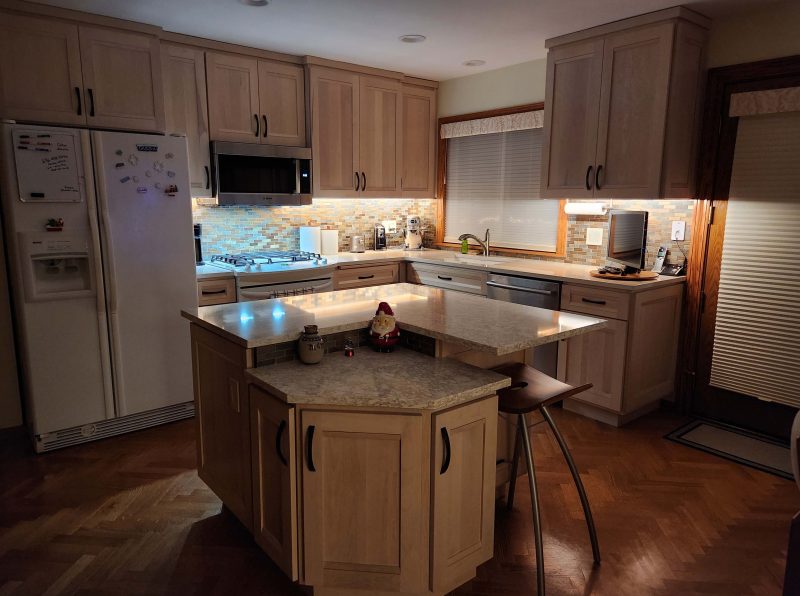
In addition to setting up temporary kitchen/dining areas in the basement, we had to empty all of the kitchen cabinets before the crew could begin their work.
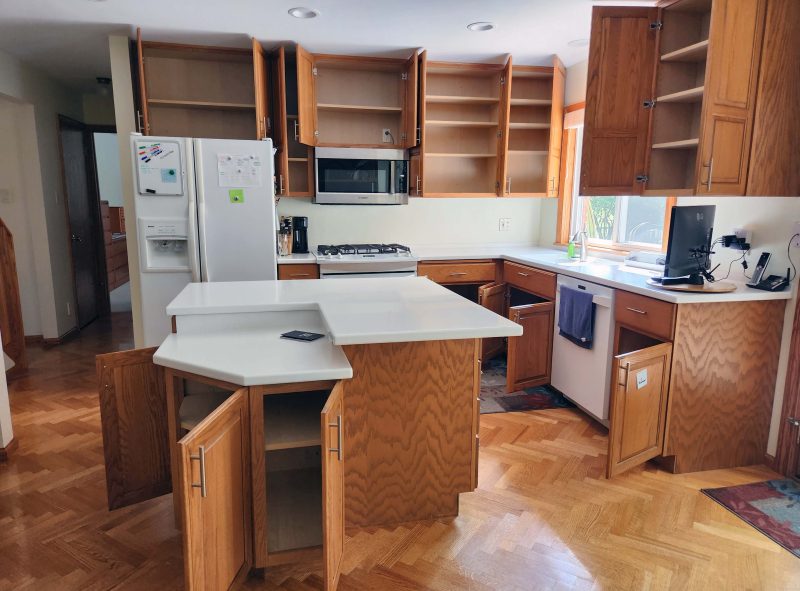
Just like closets, you can get a lot of stuff in cabinets!

Jimmy, the company owner, sent Christian (left) and Craig (obviously, right) to start working on our kitchen on June 21. The two guys worked daily through July 16. They started by removing our old (20+ years) cabinets. The cabinets were installed from right to left, so needed to be removed in the opposite direction.
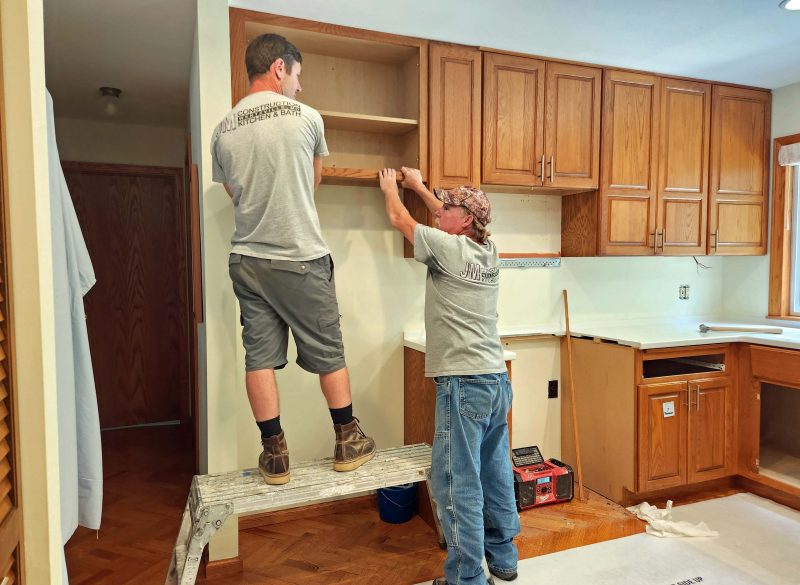
The cabinets are gone and the hardwood floor is well-protected. The kitchen looks so spacious!
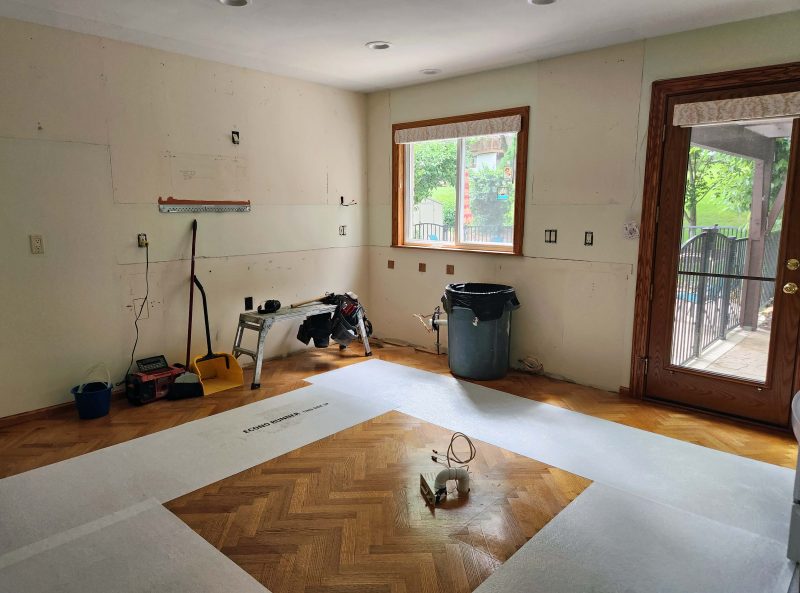
When we replaced the original kitchen cabinets in our house, we put some of them in the basement to provide closed/covered storage. They are now 44 years old and definitely show their age. In our current kitchen contract, we included removing those original cabinets and replacing them with some of our current (now old) cabinets.
During this project, the guys made their mess in the garage and in the driveway, and cleaned it up every day. In the photo below, the truck is delivering the new cabinets and Christian is cutting one of our current/now old countertops to fit the new/old cabinet arrangement in the basement.
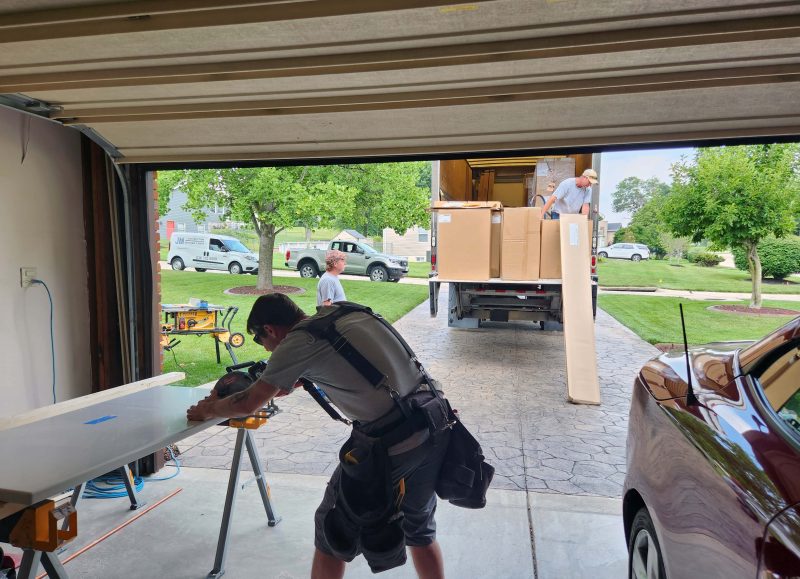
The first cabinet is installed. The wood is birch.
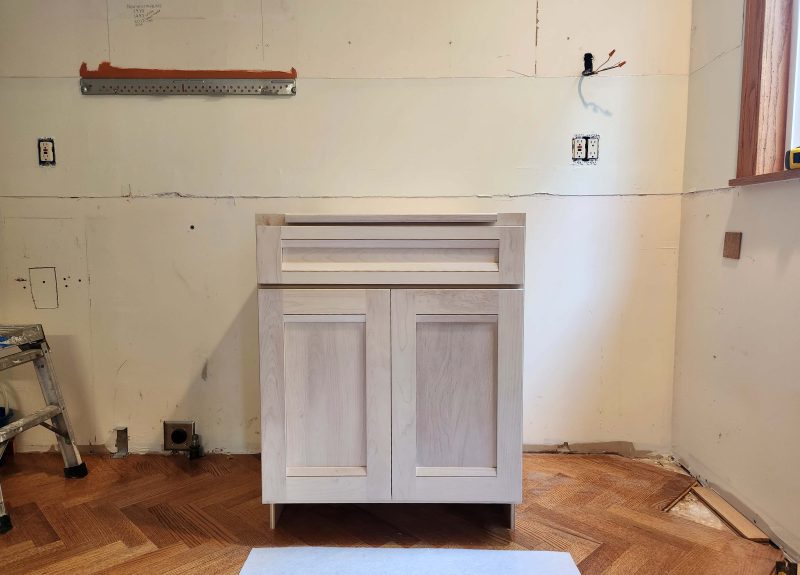
All of the base cabinets are installed. By doing the lower cabinets first, the guys can keep busy working on the upper cabinets while waiting for the countertops to be measured, manufactured, and installed. The island is actually four cabinets. It looks like a cabinet puzzle fitted together in this photo.
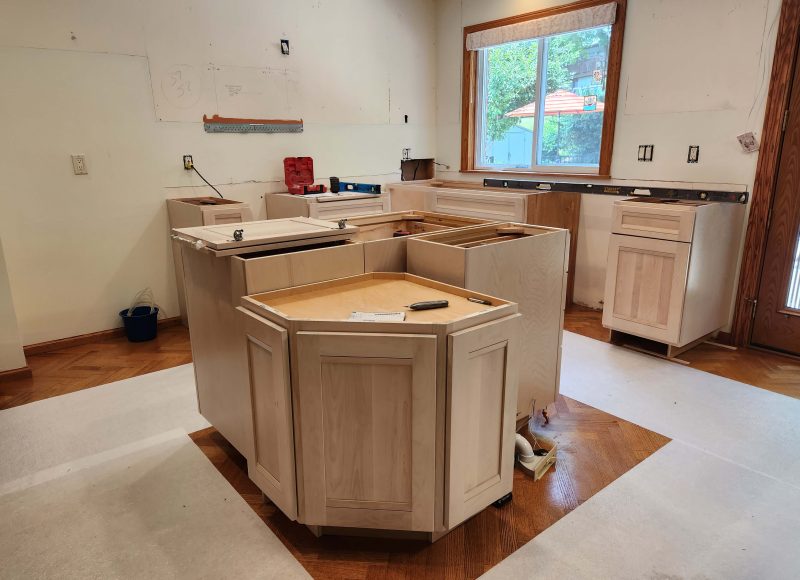
Even the interiors of the cabinets are beautifully finished.
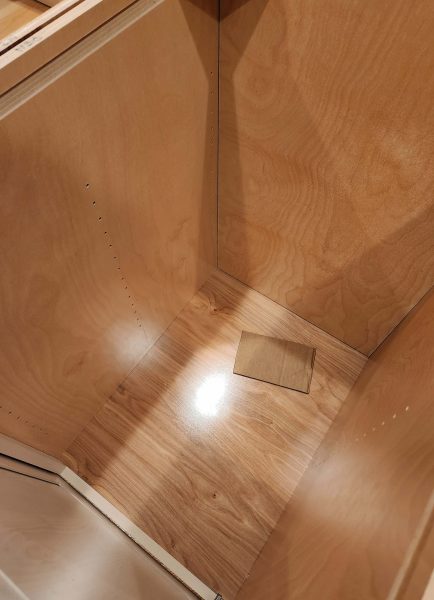
Some of the separate cabinets for the island were built with full-length side panels. When two cabinets were placed side-by-side, this created a great place to stub toes while working at the island (left image). Fortunately, Christian had a neat little toe kick saw that could cut a square corner under the cabinet (upper right image) to allow for a continuous toe kick all the way around the island (lower right image).
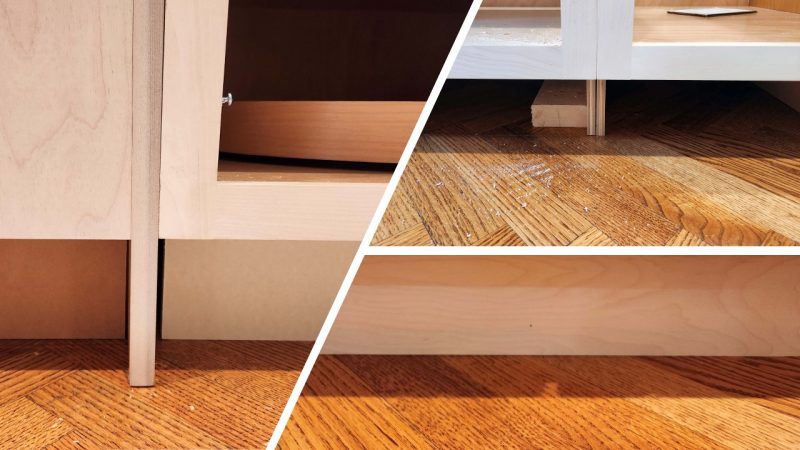
Christian was at least as picky as I am about details. His level was his constant companion. Are these cabinets level by themselves as well as with each other? . . .
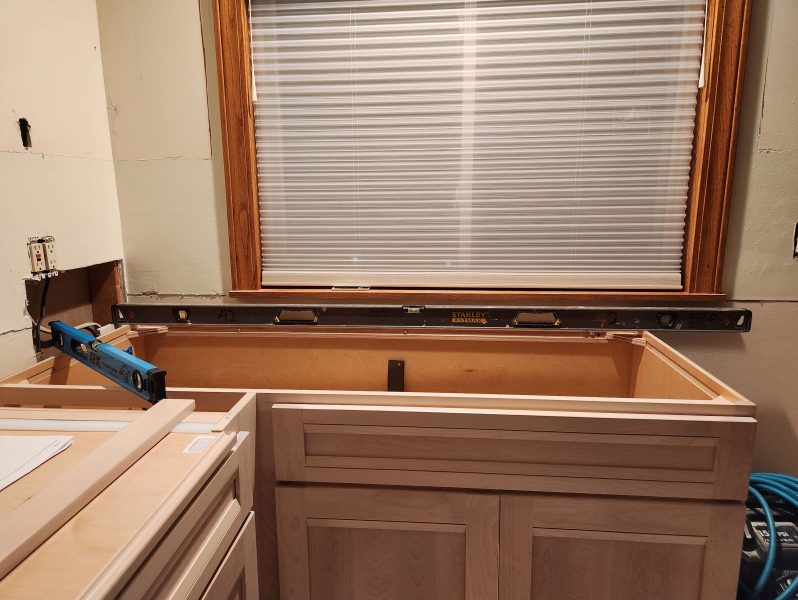
. . . You bet they are!
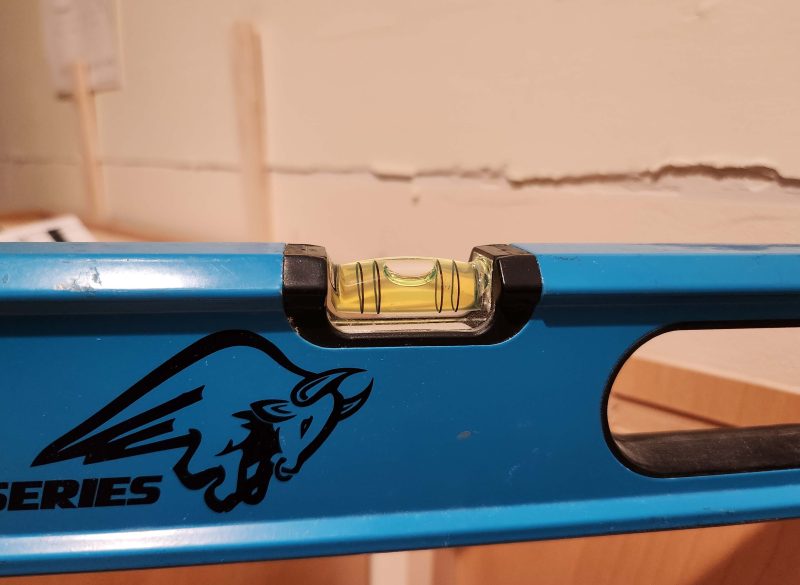
Under-cabinet lighting for all the upper cabinets was part of our design and required new electrical work. You can see the large hole in the wall and wires extending from the walls where the lights will be connected to the switch.
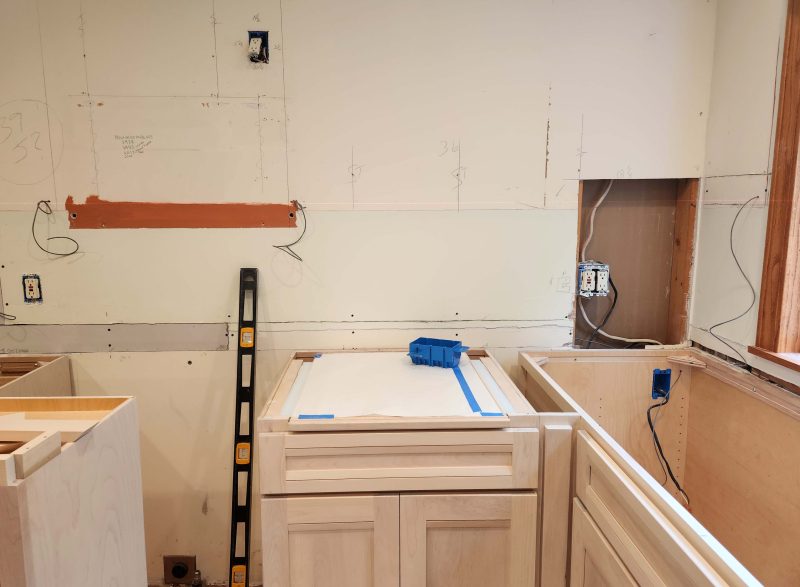
At this point, we ran into a problem and the guys had to pause their work for ten days while we waited for the countertops and a new cabinet to be made and delivered. Notice that rust-colored stripe of paint in the left center of the above photo. That was formerly covered by our microwave, which was mounted beneath a 24-inch long cabinet. You can also see the outline of the microwave installation template in that photo as well as the handwritten dates for each new microwave oven we installed. The delivered cabinet (short upper one, below) was only 18 inches long. Christian said he called the designer to verify the size because it seemed high to him. She verified an 18-inch long cabinet, so he installed it.
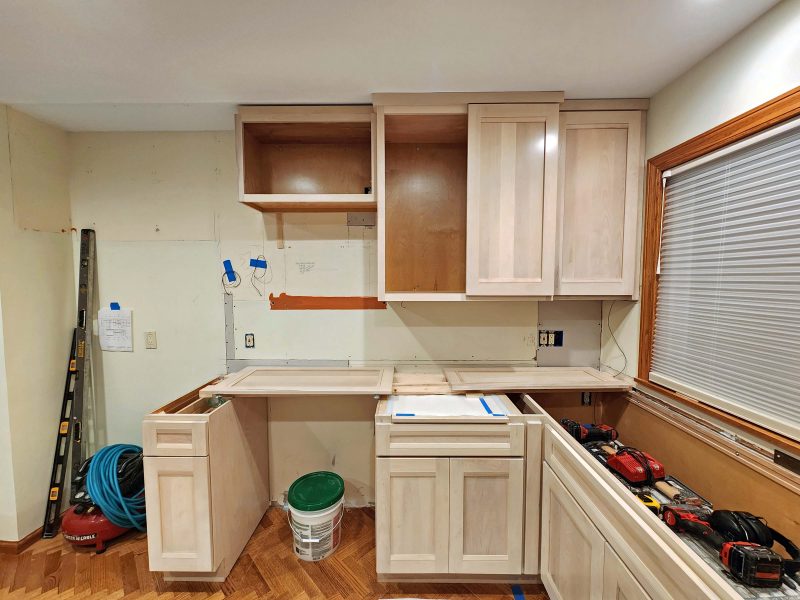
Why was that a problem? If we’d installed the microwave beneath that 18-inch cabinet, the bottom edge of the microwave would be where the top edge of the blue tape is in the photo below. The microwave cooking tray would be three inches above that line and the top edges of the cooking dishes in the microwave would be even higher. Check the blue tape line and my line of sight. I would have been unable to see whatever was in the microwave! Christian and Craig removed the 18-inch cabinet and the contractor ordered a longer one.
The mystery is why the designer planned an 18-inch cabinet for that space and why Jimmy, the boss man, who came to measure the cabinet dimensions in person didn’t catch the error either. As for Ted and me, cabinet length never came up in our design conversations, and we made the assumptions that the experts used standard lengths, and that the length of the two 24-inch long cabinets we’ve had above the microwave over the past 44 years was a standard length.

After the ten-day hiatus, work resumed on July 26 with the installation of the countertops.
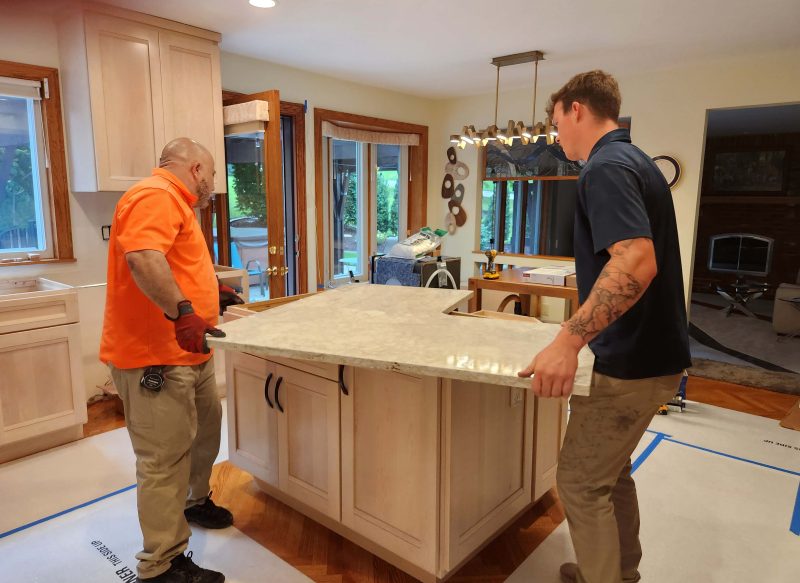
After the countertops were installed (still waiting for that over-the-microwave cabinet), Christian got started on the backsplash. You can see it below on the island between the two countertop levels and to the left of the exterior door. The wall above the cabinets on the left is multi-colored because there was another problem.
After Christian and Craig installed the stove, I noticed that its back edge was more than one-quarter inch farther from the wall on the left than on the right. Even to a non-perfectionist, the stove looked like it wasn’t pushed in all the way on the left. I tried pushing it in, but it was tight against the front edge of the lower cabinets and didn’t budge. I told Christian it was going to drive me crazy to have the stove looking crooked every day for the next 20 (?) years and he agreed. He explained that he (as a fellow perfectionist) squared that line of cabinets with the line of cabinets under the window. Doing that revealed that the two walls formed a greater-than-90-degree corner. This didn’t affect the line of the cabinets, because the countertop was measured and fitted after they were installed and it fit tightly against the fronts of the cabinets and against the wall.
To compensate for the crooked wall, Christian painstakingly built up the wall surface (the dark-colored stuff) that would be behind the backsplash. When the backsplash was installed, the back edge of the stove was in parallel with the backsplash. The refrigerator covers the left edge of the backsplash, but if you move the refrigerator and examine that backsplash edge, you’ll see that there’s one-quarter inch of built-up surface material visible behind the standard backsplash trim piece. Christian is my kind of project worker!

In this photo, Craig is installing the garbage disposal and Christian is finishing up the under-cabinet lighting. He admitted it was hard on his back and he was glad to be finished with that task.
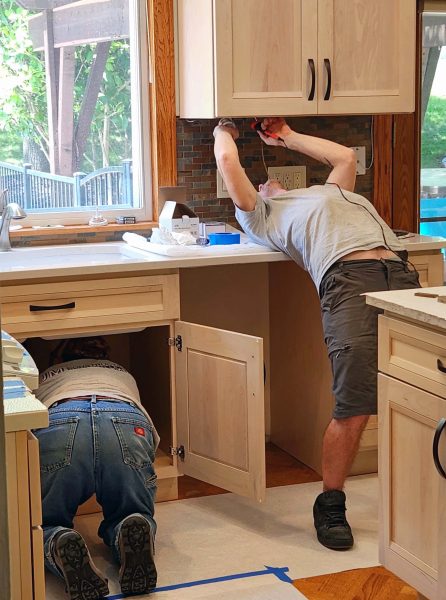
The guys worked through August 1 and then went on another hiatus and worked on other jobs. The cabinet for over the microwave had not yet arrived, and Ted and I needed to prepare for our overseas trip. The remaining upper cabinets and some finishing work were completed on October 21 after we returned home.
Most of our interior house update was completed by December 2022. In February 2023, Ted and I got serious about updating the kitchen. We updated the lighting and had the room painted in 2022, but that’s all. We had our first appointment with our kitchen designer on February 21. The planning, selection, and ordering processes took awhile, and we were finally scheduled for the professional workers to arrive on June 21.
Before giving the pros permission to demolish our kitchen, we had to set up an alternate eating and cooking space. Just like 25 years ago, that space was in the basement. We got out my old Wal-Mart craft table and some of the folding chairs we acquired in the early 1970s with grocery store trading stamps, and voilà! we had a dining room.
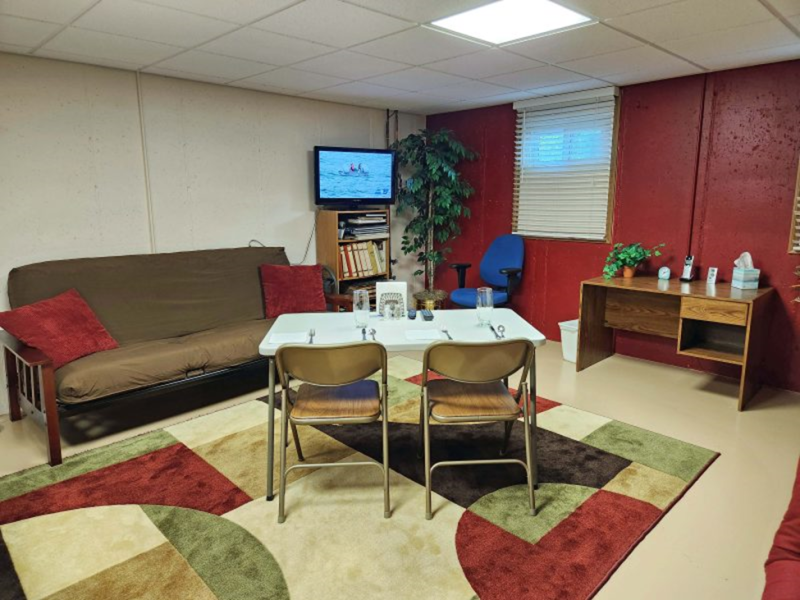
We also needed a prep/storage area. We set that up in the shop, where we have a table with a power outlet for the microwave. We won’t have the convenience of a stove for awhile, so I cooked and froze some meals in advance. We’re going to count on the microwave and eating out until the kitchen update is functional again. We used the shop table and our wedding gift kitchen table for prepping food and for storing the things we needed while the upstairs kitchen was unavailable. The paint cans under the table are not food-related. They are waiting to be put into “new” cabinets coming from our current kitchen.
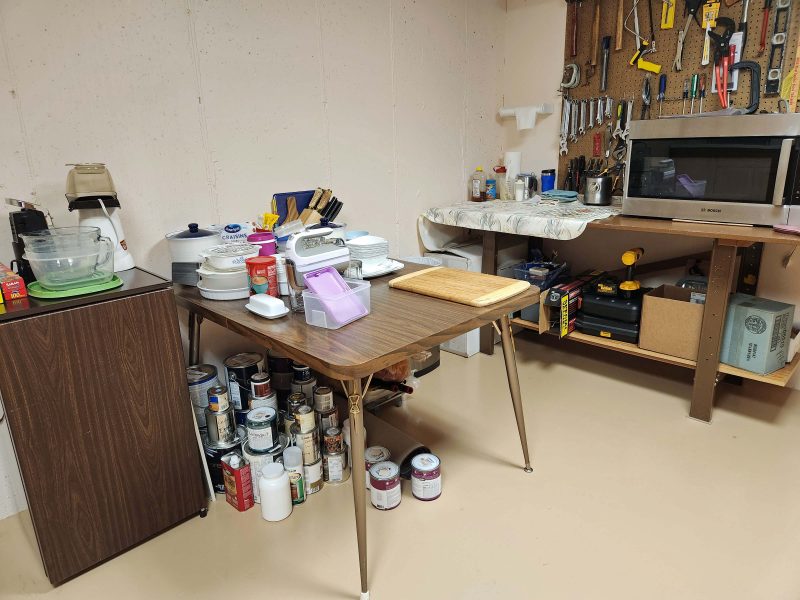
Dishwashing was a challenge, but not impossible. Since we didn’t do any big cooking projects, we didn’t have many pots or pans to wash. Our system was to scrape the dirty dishes, then stack them in the bathroom sink. A dishpan on the right worked for washing and one on the left took care of rinsing the dishes. A large cutting board on our 1972 vintage baby high chair served as a place to drain the rinsed dishes before drying them. Then we stacked the clean, dry dishes on our trading stamp card table just outside the bathroom door before taking them back to the shop and putting them in the prep/storage area. (Photographer visible in mirror.)
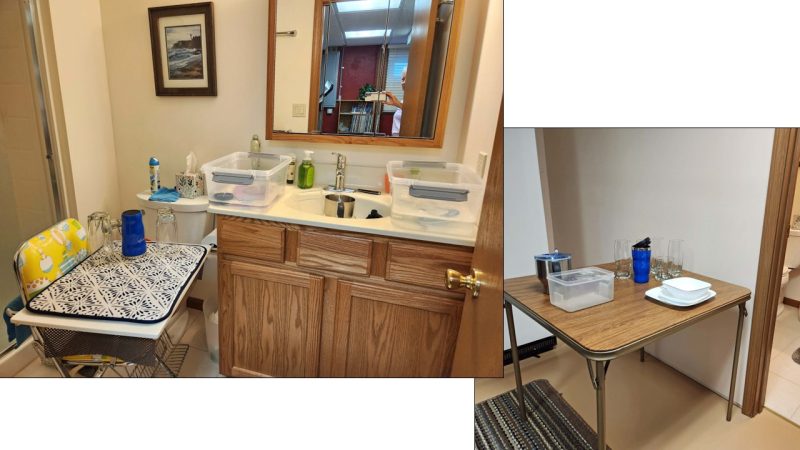
The crew had to pause our job for ten days while we waited for the delivery of a cabinet. It had already been five weeks since the work started, and my frozen dinner supply was running very low (i.e., gone). Fortunately, the guys were at a point at which they could connect the stove. (Still no sink or water source in the kitchen.) By then, we appreciated the luxury of having a stove and an oven. We had no countertops, so the microwave had to stay in the basement. All but two of the cabinets were installed and off the floor, so there was room for us to collapse our kitchen table and to eat beside our soon-to-be installed dishwasher. We’re moving up in the world–literally up–from the basement.
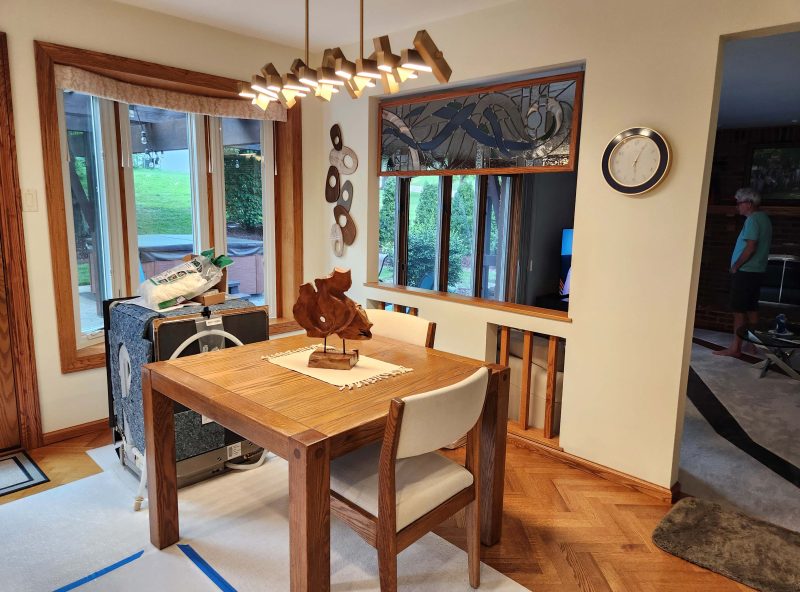
We laid some of the shelving from the yet-to-be-installed cabinets over the unfinished island to create some surface space. That made it possible for us to set things down somewhere in the room. Some 2x4s and two doors from our old cabinets covered with plastic tablecloths gave us counter space under the window and beside the stove.
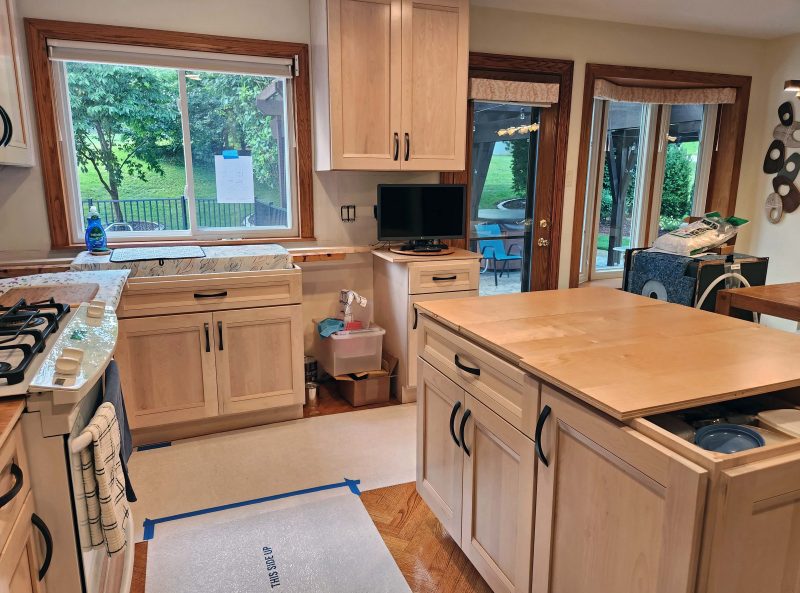
Even dishwashing became a little easier. We didn’t have running water or a drain in the kitchen yet, but at least the dirty dishes could be set on the stove, washed and rinsed in our trusty dishpans, and set to dry where the future sink would be installed. Clean, dry dishes could be put on the shelf-covered island. That’s a lot more space than we had for doing dishes in the basement! We could work side-by-side and move our elbows!
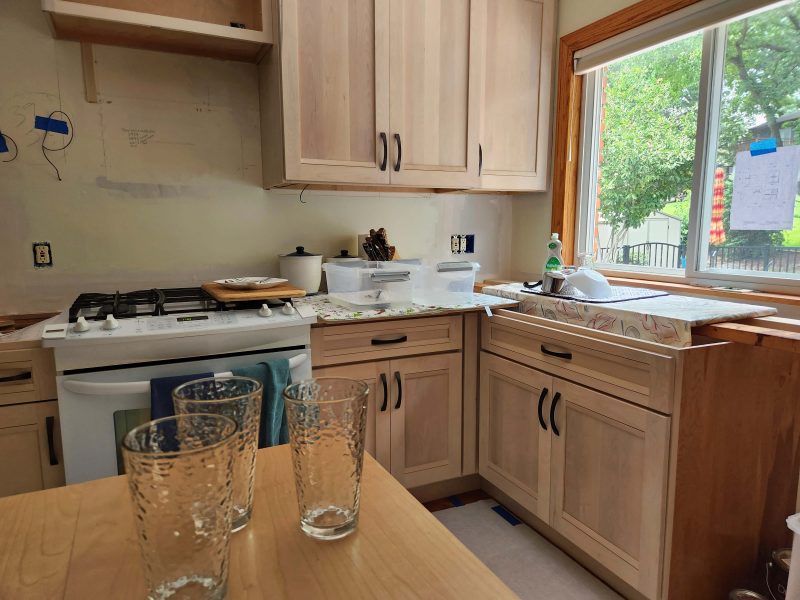
All of the above was inconvenient, but not especially difficult. In fact, it worked well enough that we decided we could entertain guests. We didn’t have enough space in the kitchen yet, but we invited Kari’s family to join us for a pizza party in our basement dining room. With paper plates and cups and carry-out pizzas, it was easy and fun.
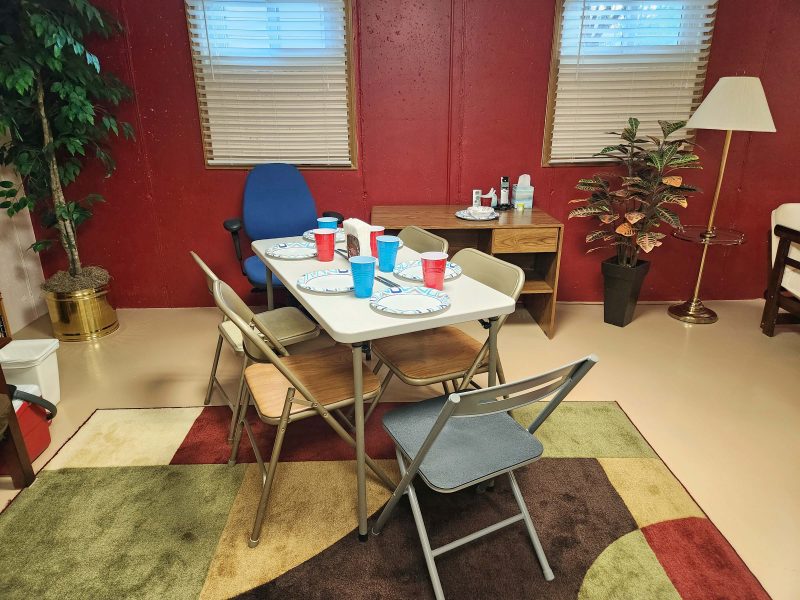
For several months, workers have been laying cables for broadband throughout our county. One day, this truck was parked on our street. It’s hard to read in the photo, but right above the orange cone, it says “We’ll be at your house in a Gigabit.”

Hallowe’en was more than a month ago, but I think this display is worth posting.
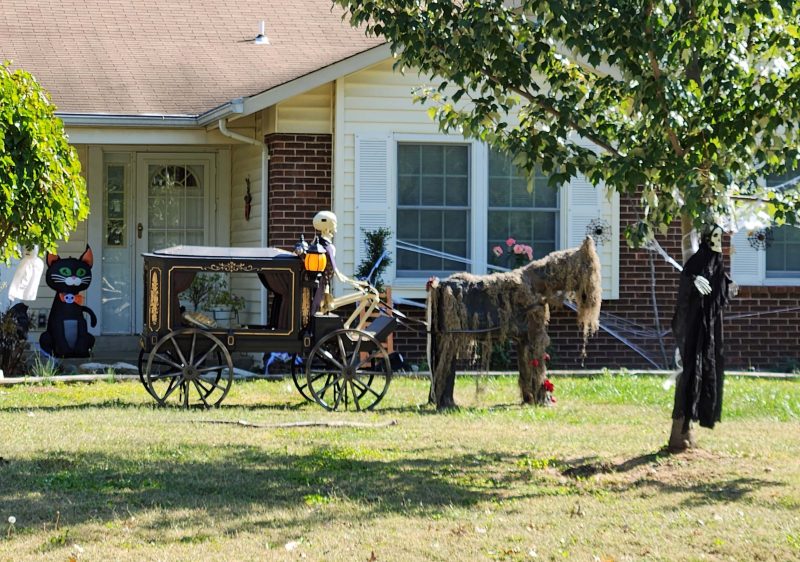
This neighborhood sign encapsulates the issue with only a few words.

Wow! What a trip this has been! We saw so many amazing things that it’s a little bit hard to process it all. Recording our experiences and reviewing our photos as I wrote the 2023 BT blog posts was like re-visiting everything again, but with more time to consider it and to cherish the memories. We don’t have a lot of photos of ourselves, but here are some that show us in places we’ve never been before.
This is the restaurant we went to with two other couples on our second night in Jerusalem. We added another couple to our group within a day or two and the eight of us sat together for dinner every evening during our time in Jerusalem and Egypt. We all have each other’s email addresses and are keeping in touch with each other. We also became acquainted with and knew the names of at least ten other couples during this time, so it’s fun to look at our photos and to recognize so many of the people in them as we toured together in a group.
We asked the waitress to take a picture of our group of six in the restaurant. Her pictures didn’t turn out very well, but here’s the setting, and it should be easy to imagine six new friends enjoying a delicious dinner together in an open-air dining room on a warm summer night in Jerusalem.
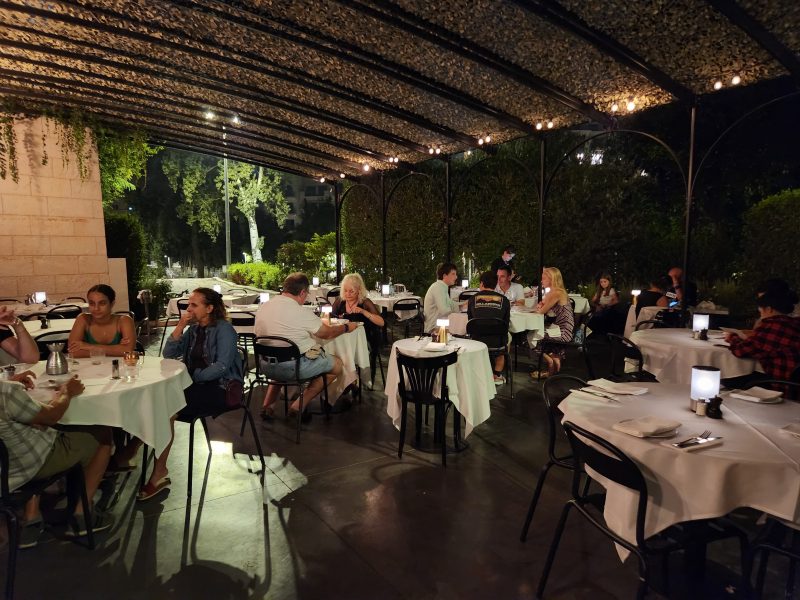
The Great Sphinx! It was so exciting to be up close and personal with the Great Pyramids and the Great Sphinx in Giza, Egypt.
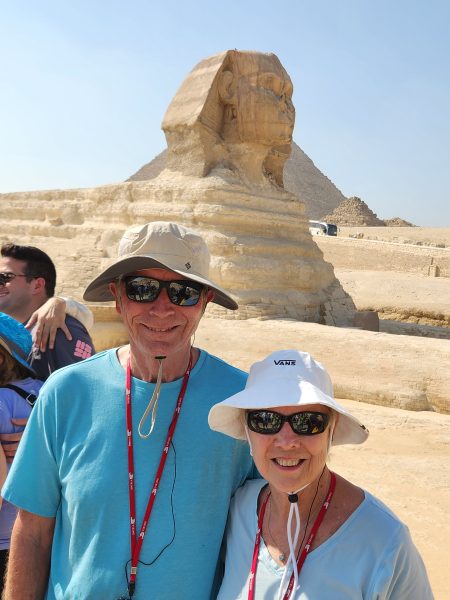
Edfu, Egypt
Sometimes, it was fun to simply relax on our ship as we sailed past the Nile River scenery.

Ok, the fake Trojan horse is pretty corny, but we had just toured the ruins of Troy, Türkiye, and it seemed appropriate to have a corny vacation picture.
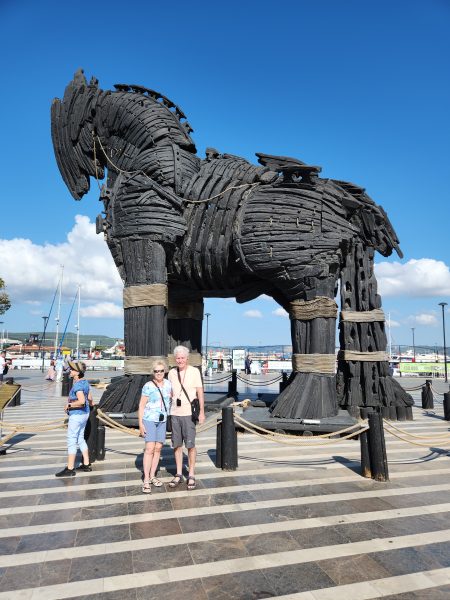
When we had a free morning, it was relaxing to have coffee and hot chocolate in the Winter Garden on board our ocean ship before our afternoon excursion.
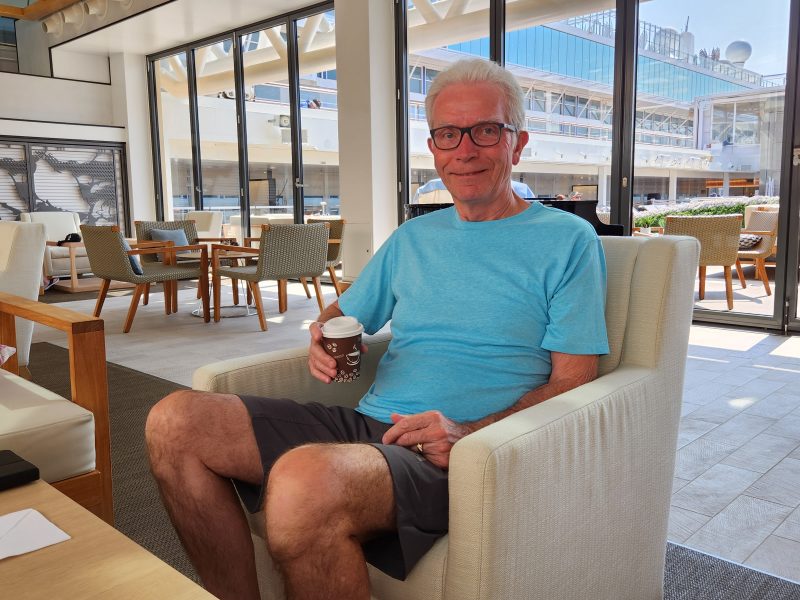
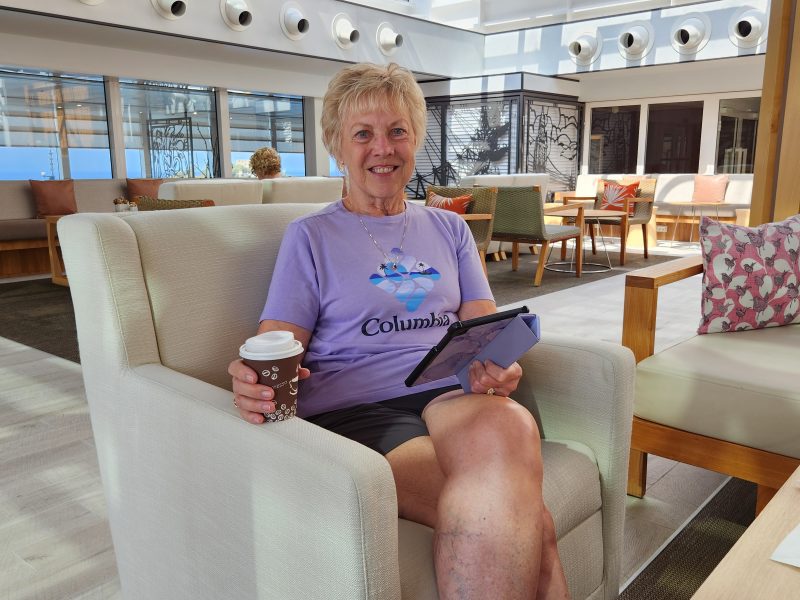
Kotor—home of the serpentine road. What a ride! The views at the 25th curve were magnificent, and after lunch at a local restaurant, there was time for a few minutes of exercise on a swing.
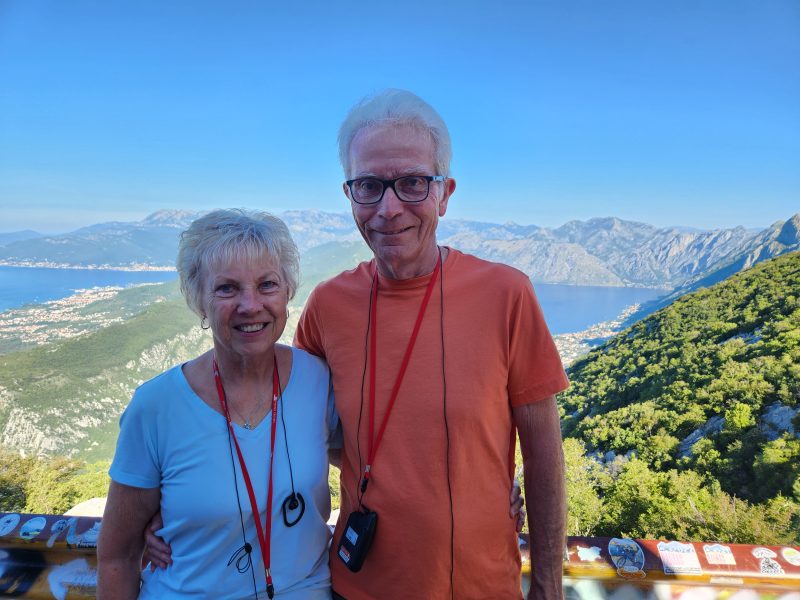
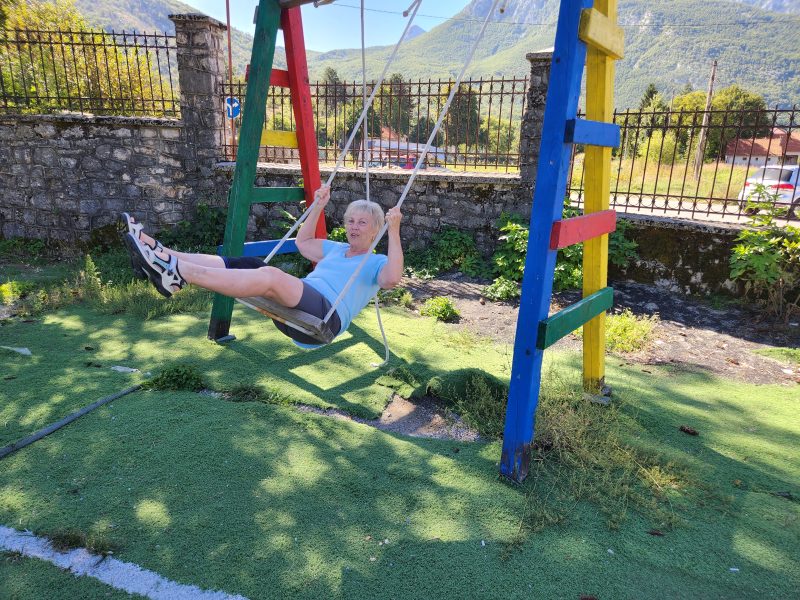
We toured Taormina and heard some local legends about how to treat a man who cheats on you and how to drink wine like a Greek, then had time for a break to relax and admire the Ionian Sea.
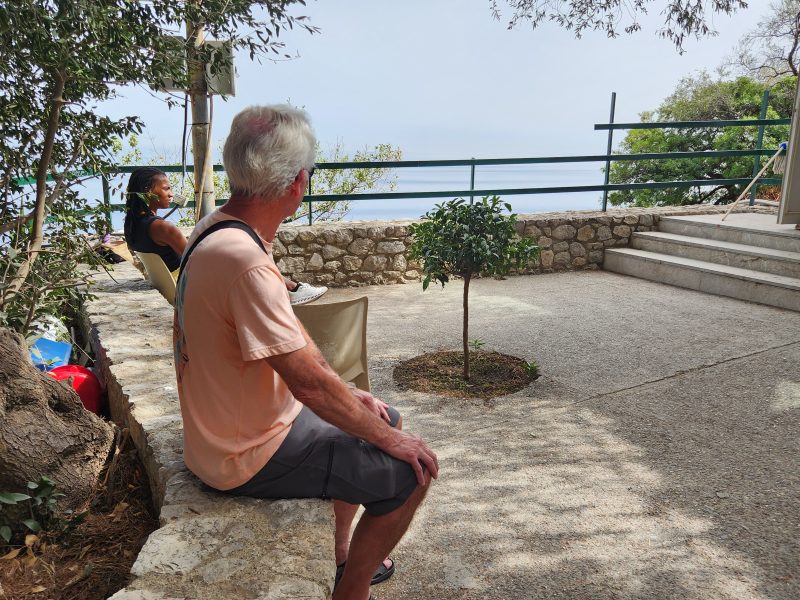
Pompeii, the site of a 79 AD tragedy, was a fascinating place to tour in the shadow of Mt. Vesuvius. Some of the things the Romans included in the infrastructure and the buildings were amazingly advanced, especially the (could be) “pizza” oven!
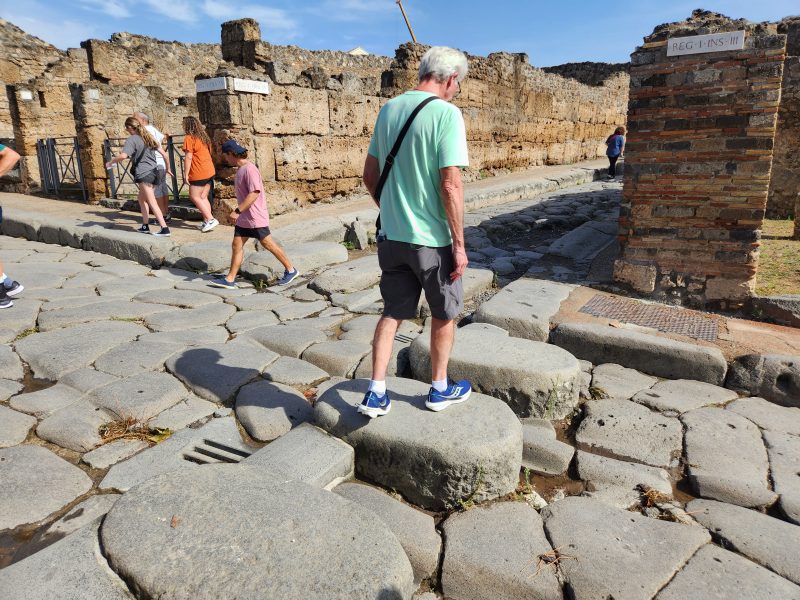
Pisa is sinking and the tower is leaning. Every day, Ted and I learned something new. At Pisa, I learned that the Leaning Tower is a bell tower and only one structure of a religious unit including the tower, the adjacent cathedral, and the baptistry. It was hard to take pictures because the sun shone directly at the camera. We had to guess what we were aiming at and hope for the best.
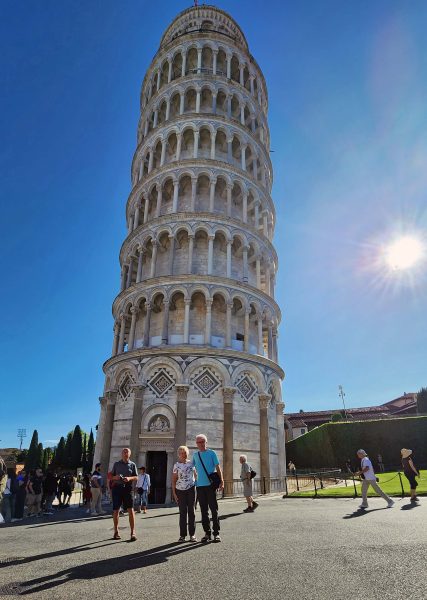
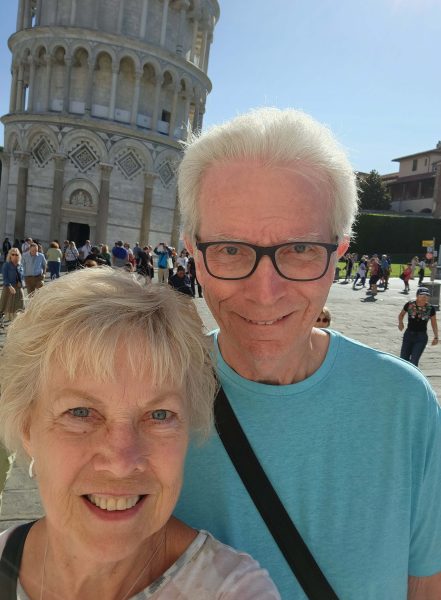
Gaudi’s name is so familiar to me after seeing La Sagrada Familia and the Park Güell in Barcelona that I’m not sure if I ever heard of Gaudi before this or not. I’ll never forget him now! How could a single person design such magnificent structures and include so much meaning in every part of those structures?!
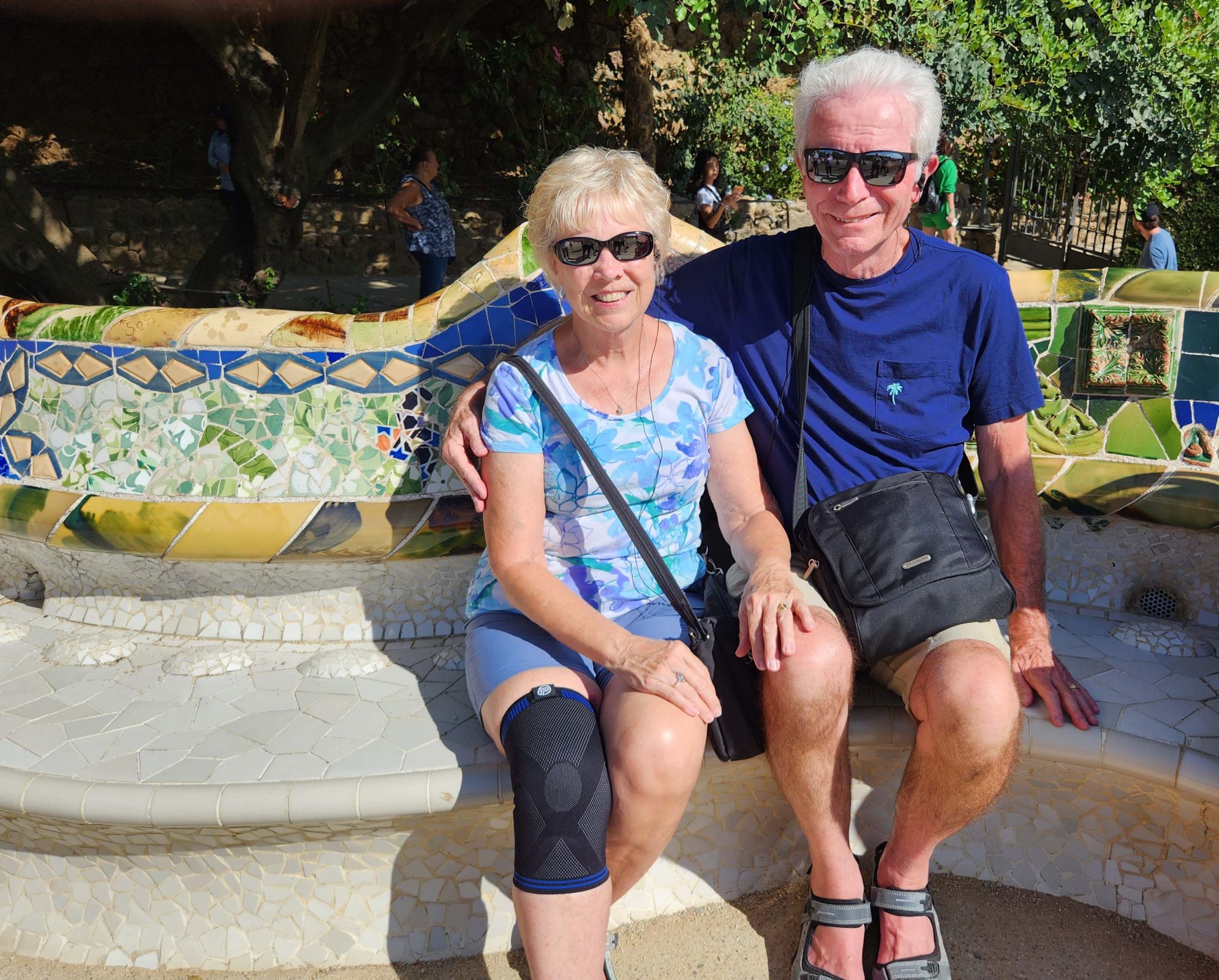
Every time we come home from visiting new places, Ted remarks that we probably just had the best trip ever. The same thing was true after the 2023 BT, but this one will be hard to top with the next new places we see.
After the grandeur of the Sagrada Familia and the intensity of its symbolism, it was time for something lighter. Part 2 of our day in Barcelona was spent at Güell Park. From the park, we had this beautiful view of the Mediterranean coast and the city.

Güell Park reflects Gaudi’s naturalist phase of the early 1900s. He used organic shapes and designed new structural solutions based on geometry. Rigidity is absent in his designs of this period. He partnered with Güell to plan a natural park. They envisioned an organized group of high-quality homes set into the mountainside, designed for maximum comfort with an artistic touch, and furnished with the latest technological developments. Unfortunately, this was an unsuccessful venture. Only two houses were built, neither was designed by Gaudi, and one of the two was put up for sale but had no buyers.
The unsuccessful housing project was converted to a municipal garden, designed to bring peace and calm to visitors. The park has some fantastically shaped buildings and a serpentine bench. The curves on the bench create a number of enclaves to promote a more social atmosphere. When you sit side-by-side with someone, the curves of the bench are conducive to facing each other for easy conversation. Much of the bench design was done by a collaborator of Gaudi.
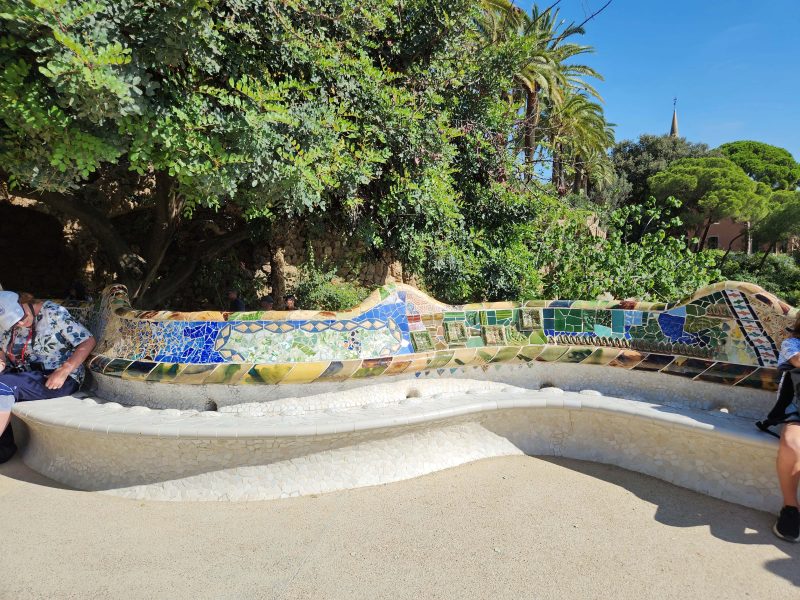
The bench is ergonomically designed and is unexpectedly comfortable, not to mention colorful. The back of the bench is curved to fit your back. I’m not sure what the corrugated bumps on the seat do, but when you’re sitting between them, it feels like the bench fits you. Gaudi designed the holes in the back of the bench to drain rainwater into a pipe that transferred it to an underground cistern. This allows for ecological watering of the gardens and also provides a supply of water for the fountains.
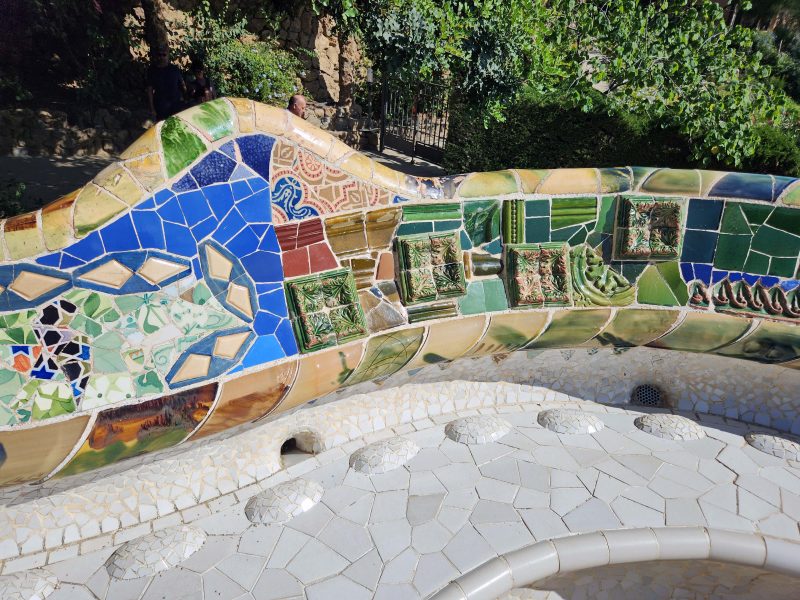
The main terrace is the focal point of the park. The serpentine bench surrounds the terrace. If you zoom in on the picture and look between the people who are standing and walking around, you can see people sitting on the bench all around the edges of the terrace. Gaudi intended this terrace to be used for socializing and for community gatherings for the housing project residents.
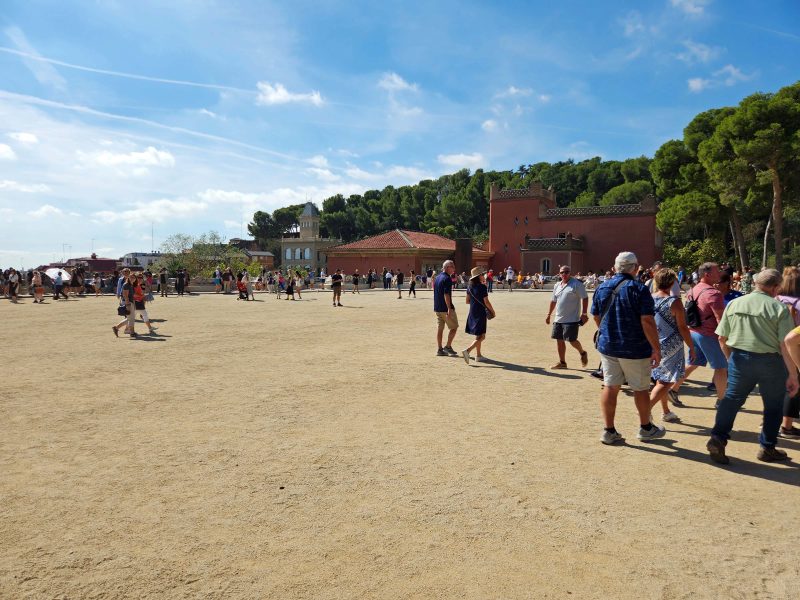
These two houses are commonly referred to as the “gingerbread houses.” Gaudi bought the larger one, moved into it with his family, and lived there from 1906-1926, when he died. The house is now a museum.
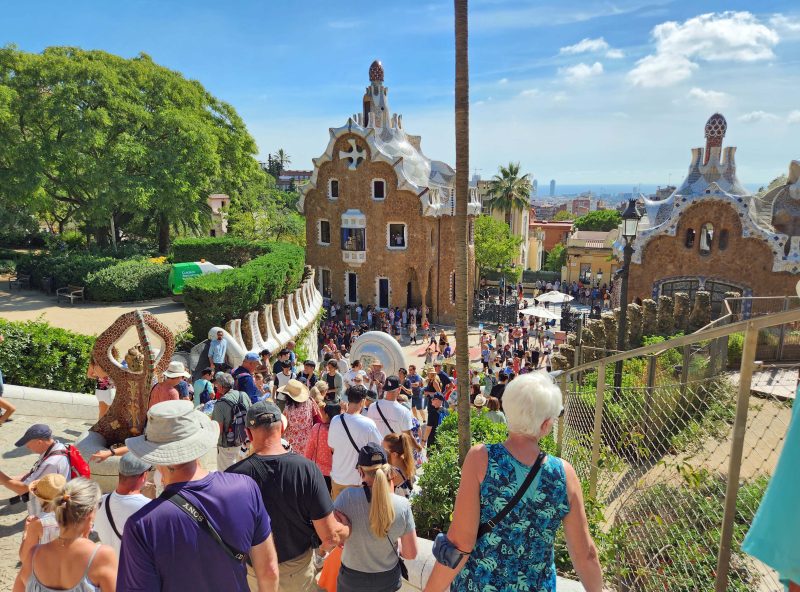
The smaller gingerbread house has become the park gift shop. Look closely. There’s a lady standing at the second-floor window, apparently checking out the crowd of tourists.
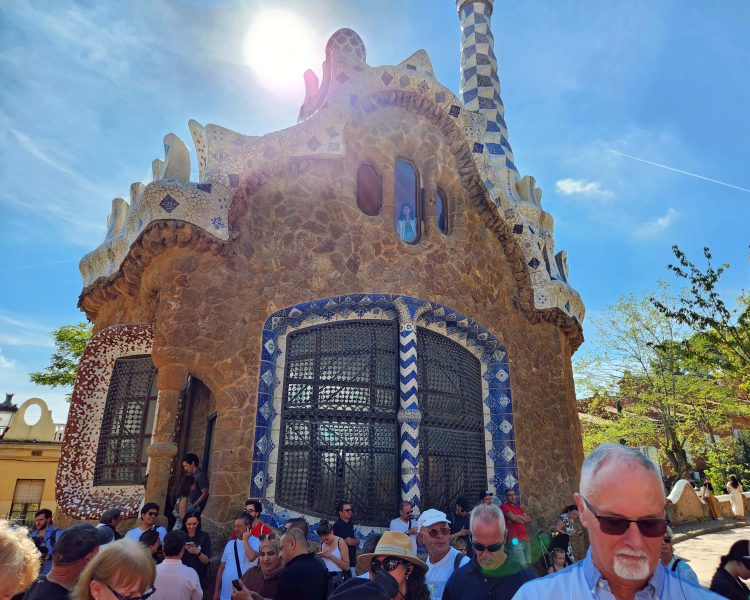
The Grand Entrance Stairway, usually called the Dragon Stairway, has a twin flight of steps flanked by two walls of merlons (those post-like things pointing upward) that form terraces. Under each terrace is a grotto. Check out the oddly-shaped roof at the top of the stairway.

Here’s the dragon of the Dragon Stairway. It’s official name is the Park Güell Lizard, but it is better known as the Dragon. Its colors and patterns are formed by mosaic tiles.
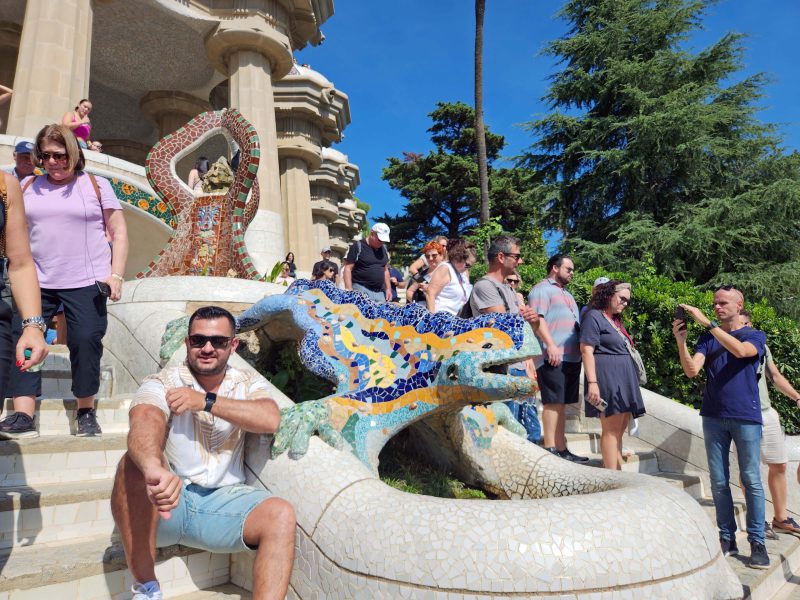
This is one of the grottos under a terrace beside the stairway. These are the merlons visible in the first stairway picture. The grotto was intended for use as a waiting shelter or for carriages.

The mosaic pattern in this curved wall (merlons again–gotta love Gaudi!) was created with colored glass tiles.
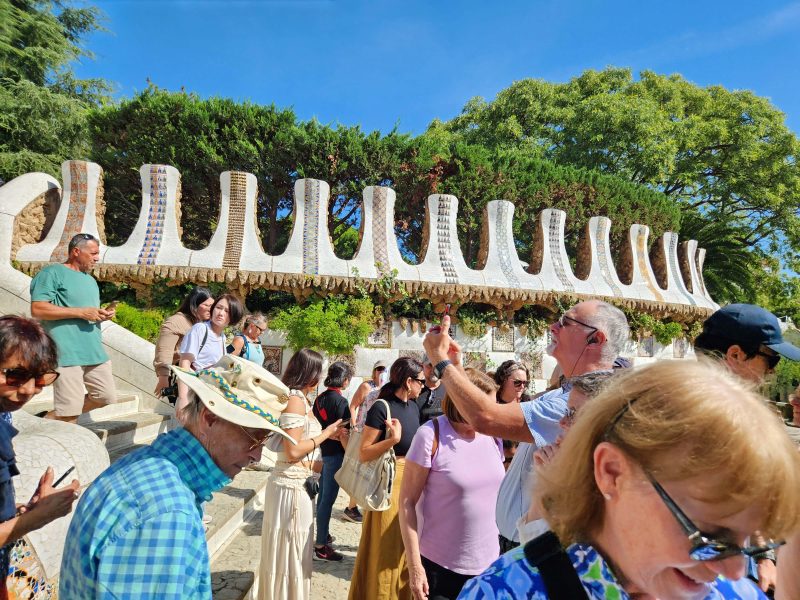
The Grand Entrance Stairway leads to the Hypostyle Room. “Hypostyle” means “supported by columns.” Gaudi’s Hypostyle Room has 86 grooved columns. Like trees in a forest (nature), they are not all perfectly vertical, so they create an atmosphere of movement. The lower, light part of the columns appears to be identical on each column, but in fact, they vary in height. To prove it, our guide walked to a column, placed her hand on her face at the top edge of the light part, and then walked to some other columns. No two columns reached the same point on her face or body, varying by about 6-12 inches. The Hypostyle Room was intended to be a marketplace in the housing development, but that never happened.
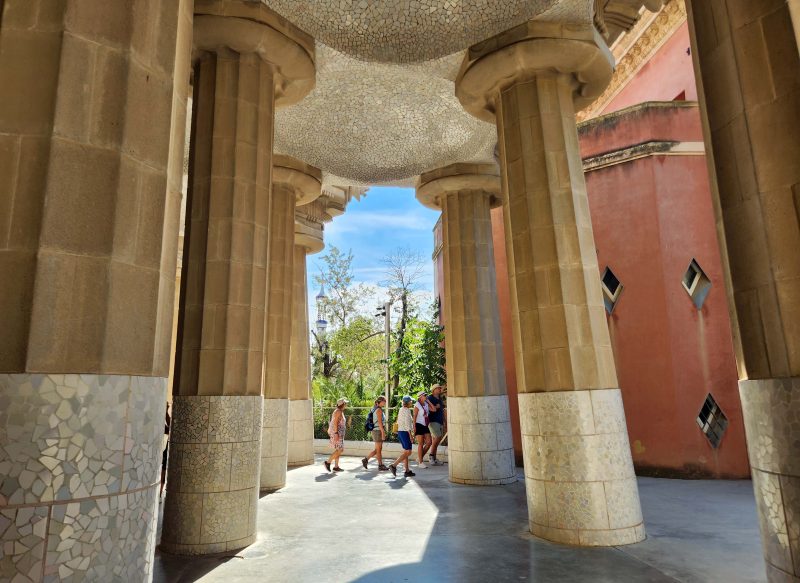
The mosaics on the ceiling of the Hypostyle Room represent the four seasons and the lunar cycles.
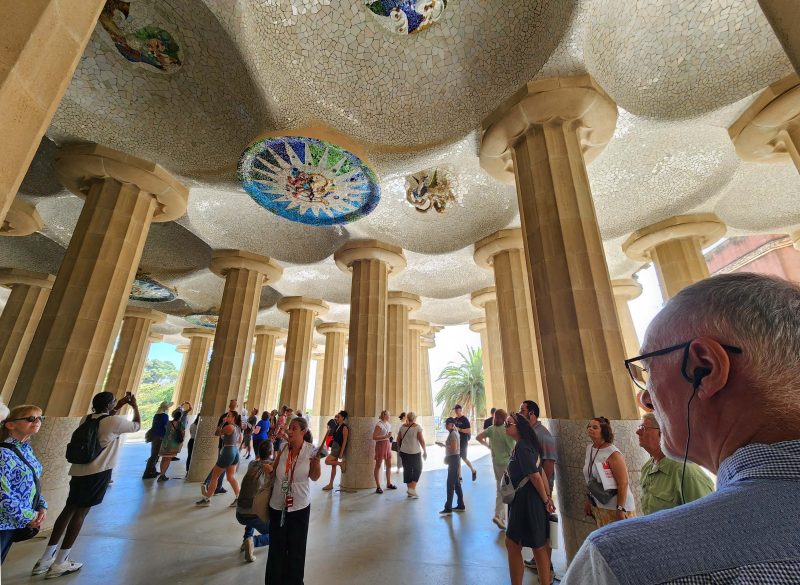
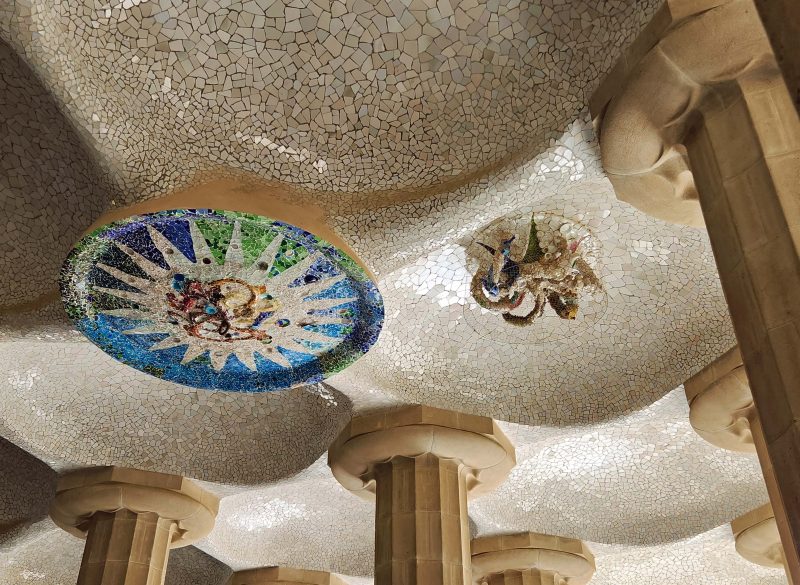
Arcades like this one are built over the footpaths in the park. They were intended to minimize the intrusion of roads, and they echo natural forms. They are meant to resemble tree trunks branching and meeting overhead (more nature–Gaudi’s favorite theme).
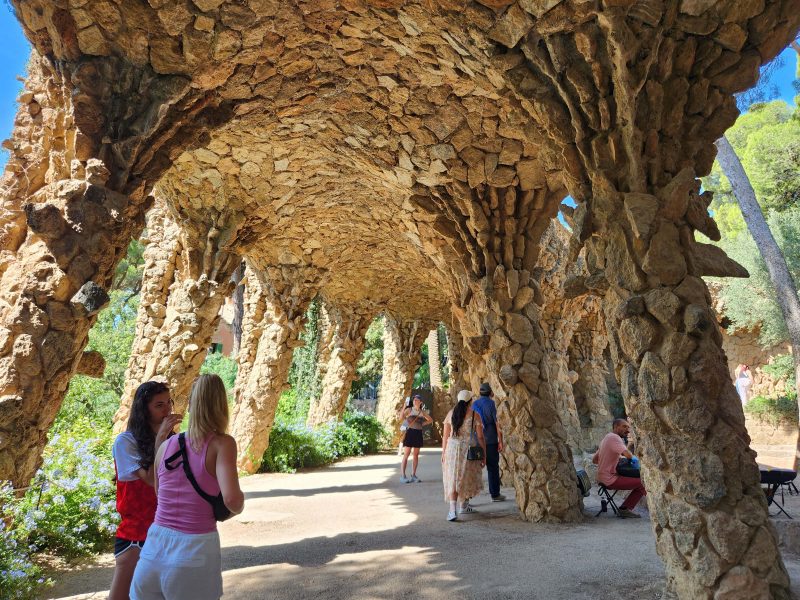
After two long tours in Barcelona, we returned to our ship just in time to grab our last Pool Grill hamburger for a late (i.e., mid-afternoon) lunch. We love the Pool Grill burgers, so it was a treat. The entertainment for the evening featured a local group of rumba dancers. The music was good, and the swirly skirts were fun.

Sometimes they twirled scarves.
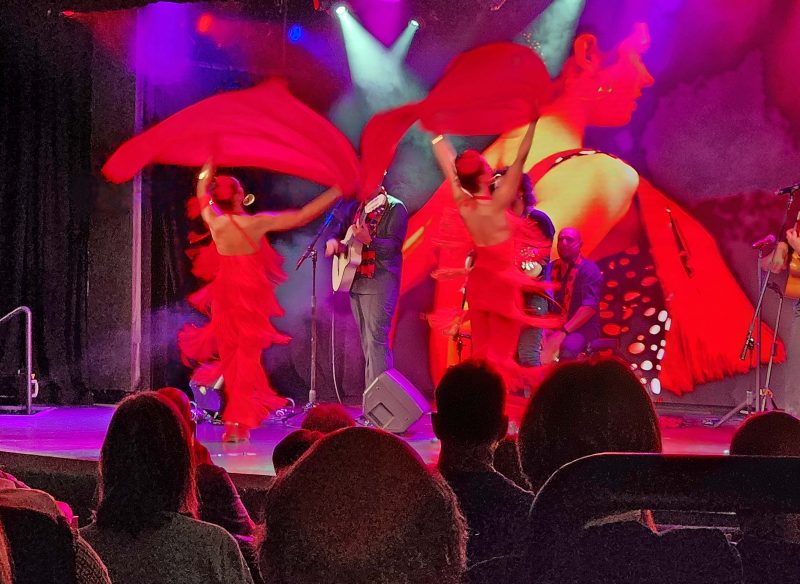
Near the end of the performance, the dancers selected a few audience members to rumba with them.
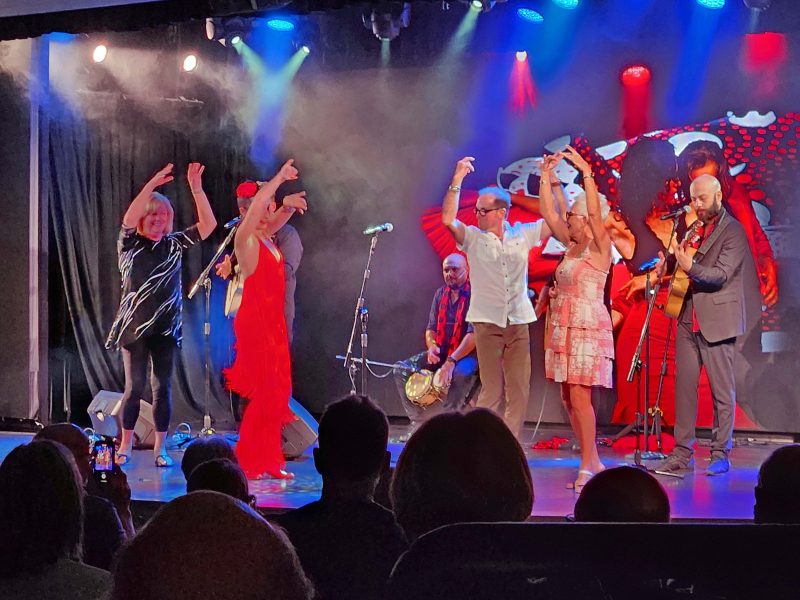
Ted and I have had a great trip, and we’ve seen so many amazing things and had so many wonderful experiences, that it’s hard to process all of it. It’s been a lot of fun, but we’re ready to head for home tomorrow and to sleep in our own bed–after what we expect to be about a 26-hour travel day–if we have no significant delays.
As we rode through Barcelona this morning, we saw several interesting landmarks.
Columbus reported to Queen Isabella and King Ferdinand of Spain after his first trip to the New World, so it’s not surprising to see a monument in downtown Barcelona honoring Columbus. It is said that the statue of Columbus is pointing toward the New World with his right hand while holding a scroll in his left. Fact check: The statue is facing southeast, so Columbus is more accurately pointing toward a spot near Constantine, Algeria.

This sculpture is titled “Ones,” and is located at the entrance to the harbor breakwater. It symbolizes waves extending a welcome or a farewell to those arriving in or leaving the city of Barcelona by sea.
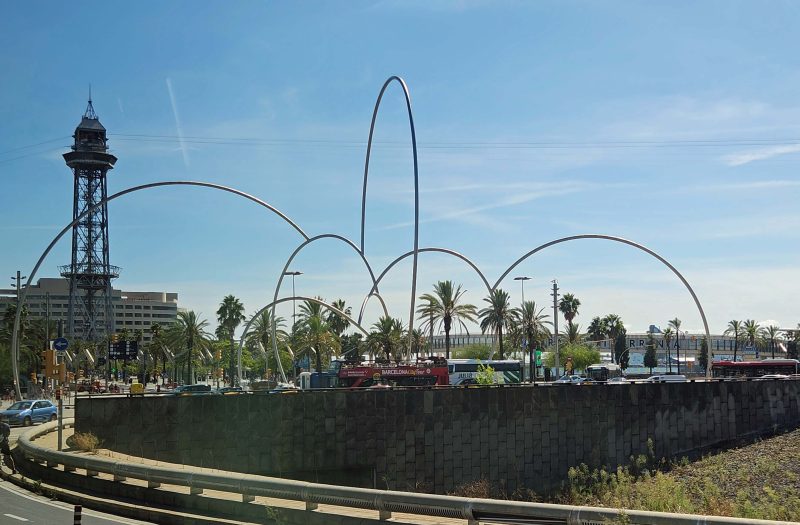
Barcelona’s Arc de Triomf (Triumphal Arch) was built in 1888 and was the main access gate for the 1888 Barcelona Universal Exposition.

The highlight—and I do mean highlight—of our day today was a visit to La Sagrada Familia (The Sacred Family), a Roman Catholic minor basilica. It is Antoni Gaudi’s masterpiece, and every part of its entire structure symbolizes the lifetime of Jesus Christ. Areas of the sanctuary represent saints, virtues, sins, regions, etc., and the three entrances to the sanctuary–the Nativity façade (the birth of Jesus), the Passion façade (the trial, suffering, and death of Jesus), and the Glory façade (the resurrection and everlasting life of Jesus)—are intricately carved to depict those three phases of Jesus Christ’s life. Only the Nativity façade was completed during Gaudi’s lifetime.
Construction of the church began in 1882. Work on the building was interrupted during the Spanish Civil War; later, it was delayed due to funding and conservation work; and in 2020, work was halted during the pandemic. Furthermore, in 1926, it was discovered that a building permit had never been issued, so construction was briefly stopped until a permit was granted. The building permit will expire in 2026, the most recent projected completion date, and the centenary of Gaudi’s death.
Gaudi predicted the church would take 200 years to complete, and he never expected to live long enough to see its finished form, so he left sufficient information regarding his ideas for others to develop. In 1926, as he was crossing a street on his way to meet with his model builder, Gaudi was struck by a tram and died. He is buried in a crypt in the Sagrada Familia.
At the time of his death, Gaudi had completed designs for the naves and for the Passion façade, as well as a model for the sacristy dome, and he was working on designs for the crossing, the central towers, and the main façade (the Glory façade). He also left a full model of the church. The model was built on a 1:10 scale and was so large, you could walk inside and through it. That made it possible for people after him to continue the work on the church.
Gaudi’s main goal for the church was to teach people about Catholicism through architecture. For example, the three entrances to the interior represent the three virtues: love, hope, and faith. The 18 towers of the church are also symbolic, with 12 for the disciples, 4 for the evangelists, one for Mary, and the tallest, center tower for Jesus. The Sagrada Familia is the second largest church in the world (St. Peters Basilica in Rome is the largest), and the Jesus Tower, at 236 feet tall, will make it the tallest church in the world. Early in the design process for the church, a geodesist measured the tallest hill in Barcelona; then the central tower was designed to be one meter shorter than that hill because Gaudi believed no man’s work should be taller than a work of God. Zoning laws in Barcelona now prohibit buildings taller than the Sagrada Familia.
The first glimpse of the Sagrada Familia is stunning, both for its size and for its detailed decorations. There is an unusual piece of symbolism in the picture below. Look for a green cypress tree (it looks like a Christmas tree) on top of the short tower in the right center of the picture. You’ll see a flock of white doves flying around the tree, representing the tree of life which is always associated with sacred places.

This is the Nativity façade that depicts the birth of Jesus Christ, and it’s where we entered the church. Look at the detail of the building! To appreciate the scale of the Sagrada Familia, compare it to the size of the people at the door.
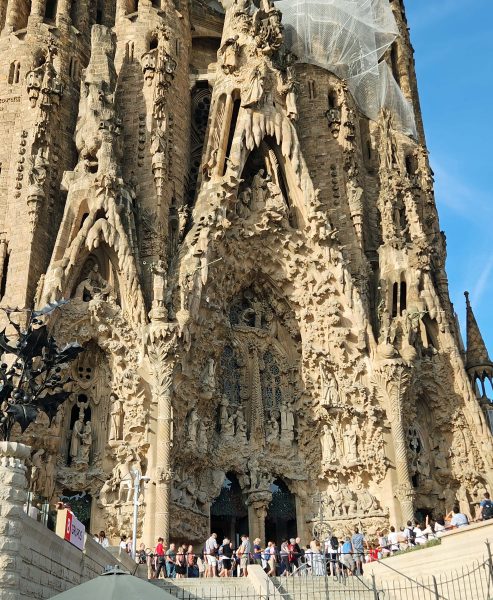
These sculpture groupings are above the doorway in the preceding photo. The sculpture on the left is the Nativity—Mary, Joseph, and Jesus. The center sculpture is Joseph with Jesus. Joseph was present at Jesus’ birth, but not at his crucifixion and passion, so Joseph only appears on the Nativity façade of the Sagrada Familia. The sculpture on the right depicts The Martyrdom of the Innocents when, following the news of Jesus’ birth, Herod the Great ordered the execution of all male children two years old and younger in the vicinity of Bethlehem.

While we were waiting to enter the church, we examined this model of the Sagrada Familia. The gray parts indicate completed areas, but I’m not sure how current the model is. At the time of our visit, the statues of Matthew and Luke had been placed on their towers. Mark and John were standing in the nave. Mark’s head was attached—an indication that workers were preparing to add the sculpture to the top of the third evangelist tower; John was still headless. The Mary and Jesus towers were not yet finished.
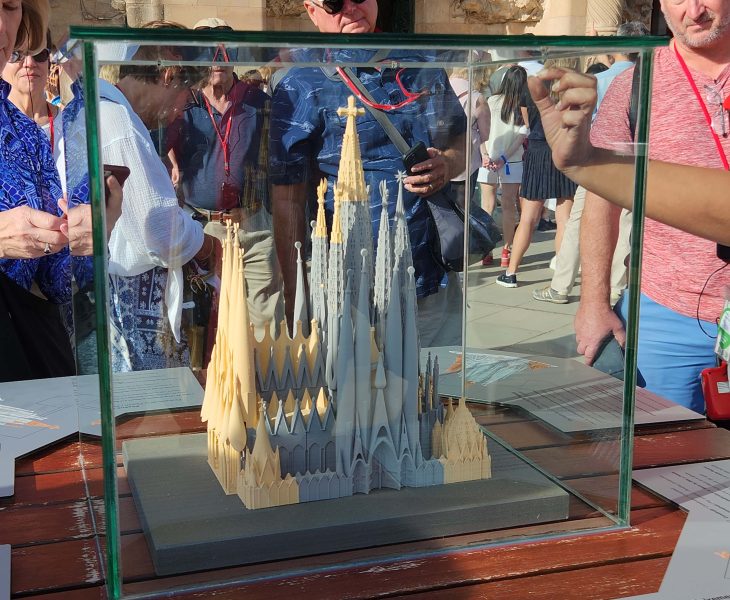
Standing at the Nativity entry, you can look across the nave to the Passion entry. The Glory entry (still unfinished) will be to the left of this picture and will serve as the main entrance to the church.

The interior dome, pictured here, was built according to Gaudi’s model. Each of the four center columns has a lighted icon representing one of the four evangelists.

This is a close-up of the lighted icon for Mark.
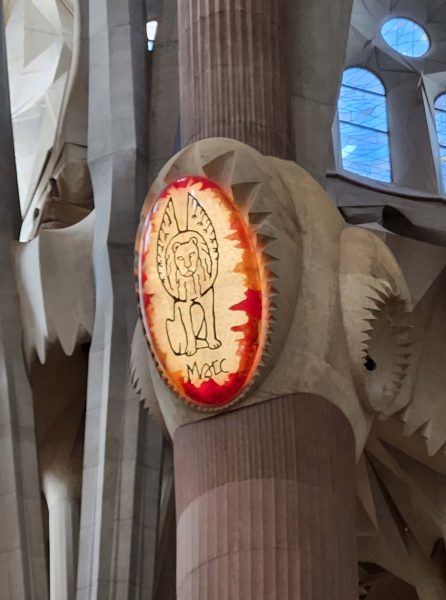
You can (barely) see the main altar and the pipe organ at the distant wall. It’s a long way from the back of the church. I was standing roughly halfway between the front and the back of the nave to take this picture. Only special services are held in this area (Christmas, Easter, etc.); Sunday services are held in a smaller chapel.

Gaudi believed that nature was the source of all knowledge and inspiration, so he included nature in his designs. He knew he would need buttresses to support the roof of the Sagrada Familia, but he hated buttresses and wanted the interior columns to resemble trees instead, as in nature. To make this possible, he built a model of the church, including its roof, and hung ropes from the model’s roof, then used them to place and design his columns. The columns are created in the form of tree trunks to evoke the illusion of a canopy of palm trees. Here’s a picture of the “tree colonnade.” With so many large, tall columns, you can’t help looking upward (to heaven?) when you’re in the building.
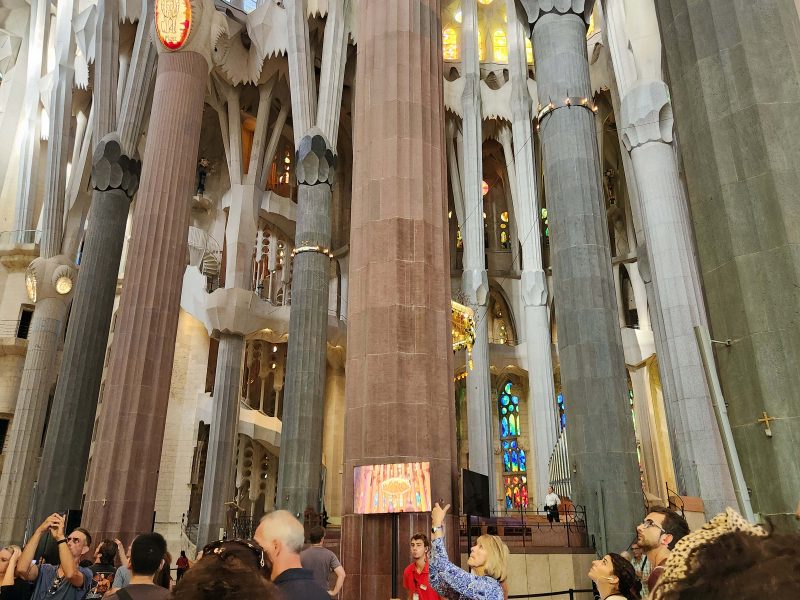
These are two of the large colored class windows in the nave. Each window features different colors in different places, so the light inside the nave changes with the position of the sun during the day.
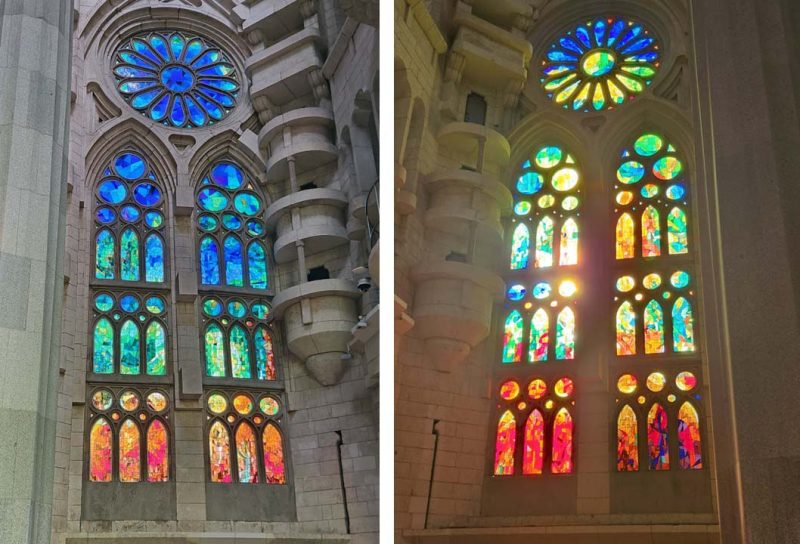
Every part of La Sagrada Familia is extremely detailed and every detail symbolizes something in the life of Jesus Christ. The objects on these rooftops are fruits and grains to represent the bread and wine of Holy Communion. Some of the objects resemble bananas, but a closer look shows that they are grains for bread. (Not banana bread.)
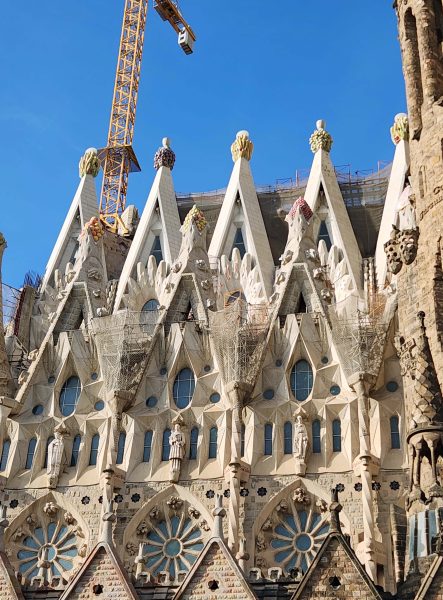
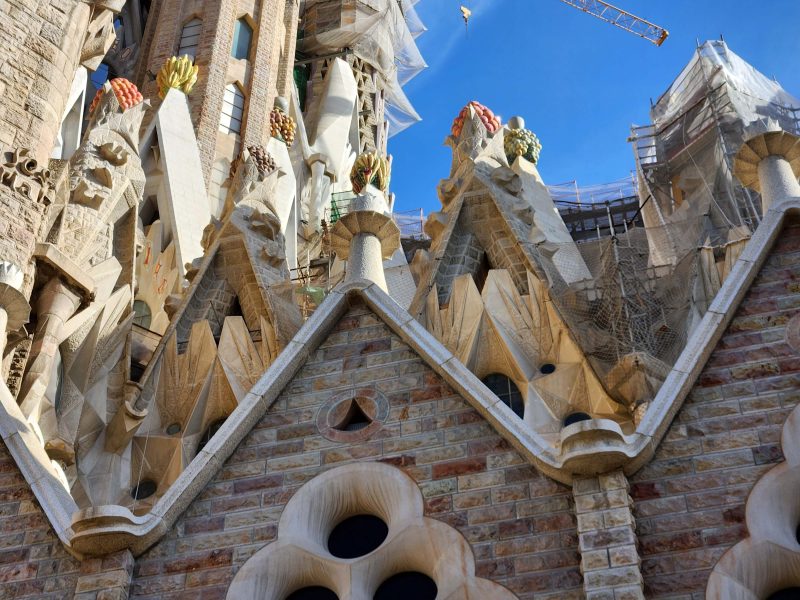
I’m not sure what the words–Honor, Podor, and Forca–on this rooftop mean, even though I looked up the translations and found, “honor,” “can,” and “strength.” Perhaps, given Gaudi’s devotion to God and his intent to tell the Christian story through his work, it means that with God’s help, we can live with honor, power, and strength.
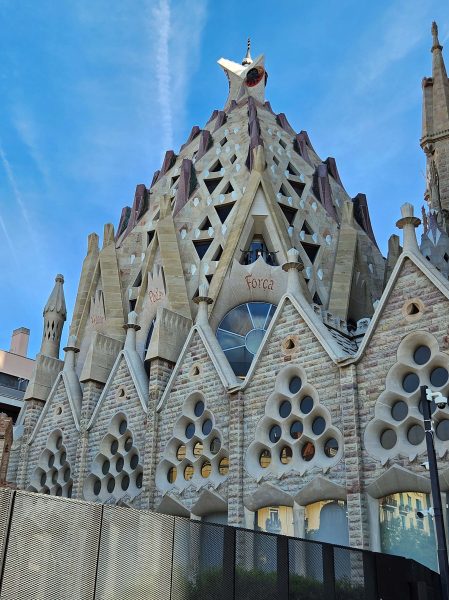
The following photos are from the Passion façade. This one portrays the Last Supper.
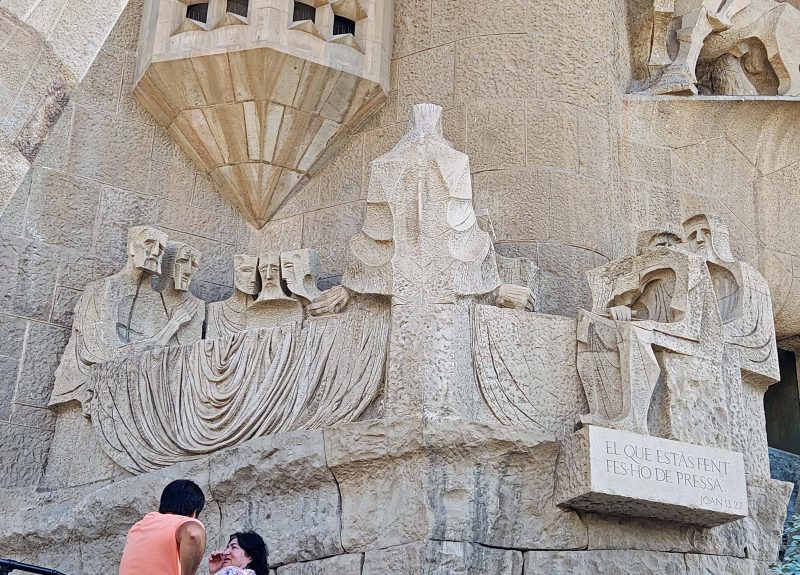
The figures on the right in this picture illustrate Judas’ betrayal of Jesus. Jesus was actually shorter than Judas, but Gaudi portrayed him as taller because Jesus has more power than Judas. If you look at the numerical plate on the wall, you’ll see that the four numbers in each row, each column, and both diagonals equal 33—Jesus’ age when he died. (Go ahead. You know you’re going to add them up to check.)
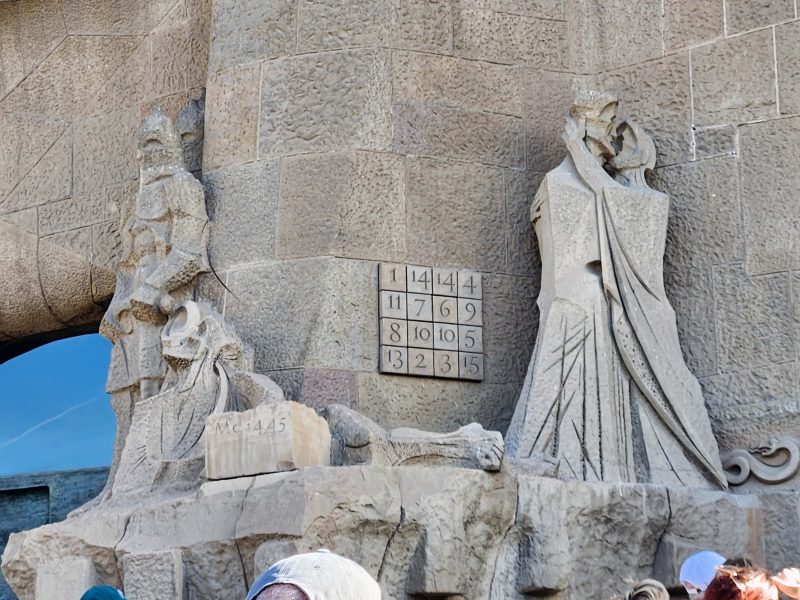
The sculptural grouping in this pediment depicts Jesus’ crucifixion. Gaudi intended this façade to be gloomy and to show the cruelty of the crucifixion. There are 18 bone-shaped pillars on this façade to symbolize those who died. The covered space they create is meant to convey the Bosom of Abraham, a place of comfort.
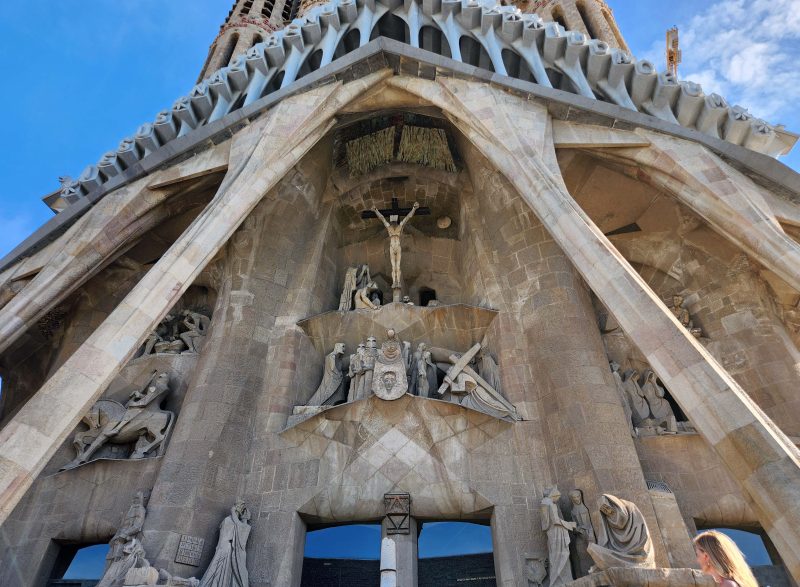
The figures in the grouping below Jesus on the cross are Roman soldiers. I don’t remember all of the symbolism, but I think the woman-like figure on the right might be Jesus’ mother, Mary, who witnessed his crucifixion. The skull at the foot of the cross is a symbol of death and refers to Golgotha, which is known as the “mountain of skulls” and is the place where Jesus Christ was crucified.

Every detail of the Sagrada Familia is a WOW! Our guide said she began studying the church when she was a teenager (she’s probably in her 30s), and she now gives four tours of it every day (I presume with some days off), but she still doesn’t know what everything in and on the building means. Every detail designed by Gaudi and those who followed him has a symbolic Biblical meaning. As the local saying goes, “Oh, my Gaudi!”
I’m tempted to say this was the most amazing thing Ted and I saw on our 2023 BT, but then I think about other things we’ve seen, and I hear myself sounding like Ted. After every trip we take, he says he thinks it was our best trip ever. Then the next trip is the best trip ever, and so on. I might be feeling the same way about all the wonderful things we saw and did on this trip. Still, La Sagrada Familia sets a high bar for everything else and left us on a high note on the last day of our 2023 BT.
Today’s excursion was titled “Scenic Sète on Foot.” The city of Sète is set on a narrow strip of land and was right beside our ship. The tour promised us a walk along the main canal with views of the fishing fleet, the Old Port, churches, and other public buildings along the quay. After that, we’d be on our own to to shop and walk back to the ship.
Ted and I voted to skip that and to have a final day relaxing onboard the ship. Tomorrow we will arrive at Barcelona–the last port of our 2023 BT, so we started packing our things in the afternoon.
At Barcelona, our ship will turn around and head back to Istanbul, where Ted and I began our cruise. That means all passengers onboard will disembark the day after we arrive in Barcelona. In recognition of this, there was a farewell ceremony for the crew and for the passengers this evening. Ted and I attended the event so that we could thank our favorite crew members again for their wonderful service to us, and so that we could enjoy the champagne and snacks they offered in appreciation to us for sailing with them.
Dinner in one of the upscale restaurants tonight included Grand Marnier Soufflé–a dessert we’d had earlier on the cruise and definitely wanted to have again. It was an enjoyable and relaxing day. Feel free to drool when you look at the picture of Grand Marnier Soufflé. I’ve got to learn how to make this!

After visiting Saint Rémy this morning, we drove through more of the pretty countryside of Provence as we headed for the medieval stone village of Les Baux-de-Provence.

The limestone in the Alpilles mountain range has been (and continues to be) shaped by the Mistral winds. The Alpilles are not very high mountains—the altitude of the highest peak in the range is 1,634 feet.

Before arriving in Les Baux, we stopped for lunch at a wonderful nearby restaurant set on the mountainside. The limestone mountain in the background is part of the Alpilles.
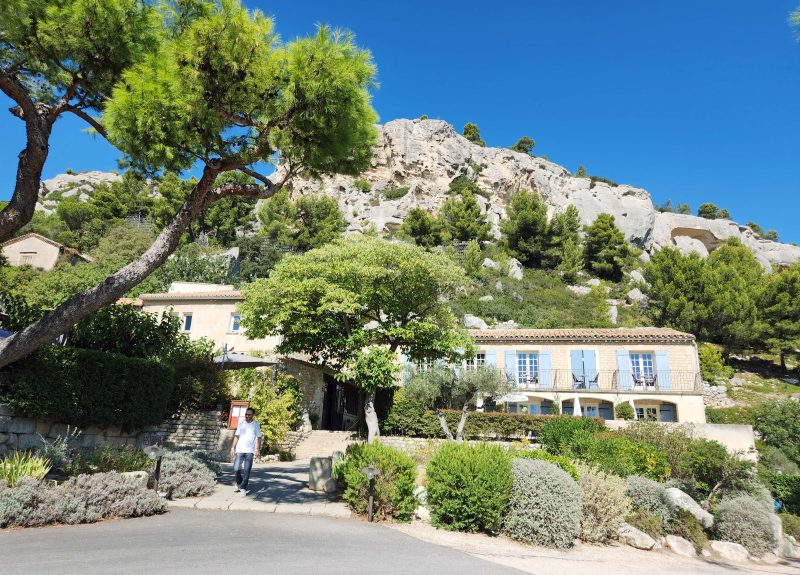
This was our view from the restaurant. Our group of about a dozen people dined al fresco at a shaded table on the patio. You can see a corner of the patio in the lower right of the picture. The meal was so-o-o-o good. The host and servers were very friendly, and we all had a good time.
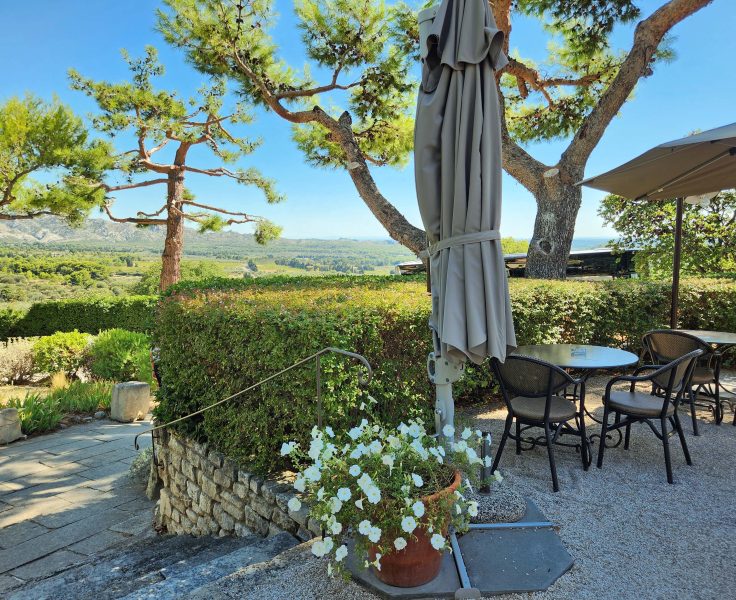
After our leisurely lunch, it was time to visit the stone village of Les-Baux-de-Provence.
Because of its position on an escarpment, the fortress of Les Baux protected the mountain valley and the village’s food supply. The natural ridge on which it was built allowed the village to control all approaches to the citadel, including passage up and down the Rhône River, as well as access from the Mediterranean Sea. As a result of its geography, the fortress of Les Baux was impregnable to the military technology of the time.
The House of Baux was one of the richest and most powerful families of medieval Provence, and is still thriving today in Naples. The family used its name for the fortress on which they built their castle and for the stone village surrounding it. The French word baux means “cliffs” or “escarpments” and is well-suited to this area.
The Old Fortress is in the upper center of this photo, and you can see that it sits in a great defensive position.
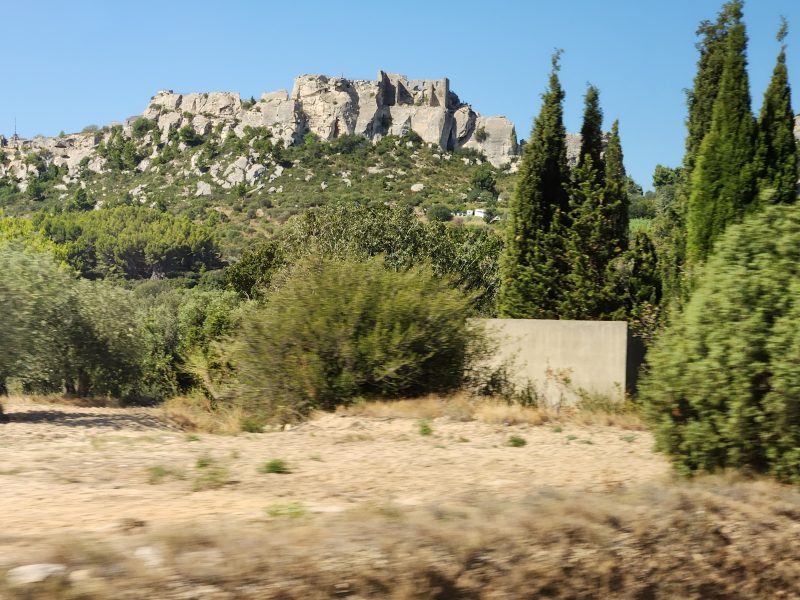
This house was one of the first buildings we passed on our way from the parking lot uphill to the fortress. Our guide told us this is less than half of the house; the other half is cut into the rock behind it.

The left half of this photo shows the Church of St. Vincent, and so does the right half. The left half is an extension of the original church; the original church is built into the rock on the right side of the photo.
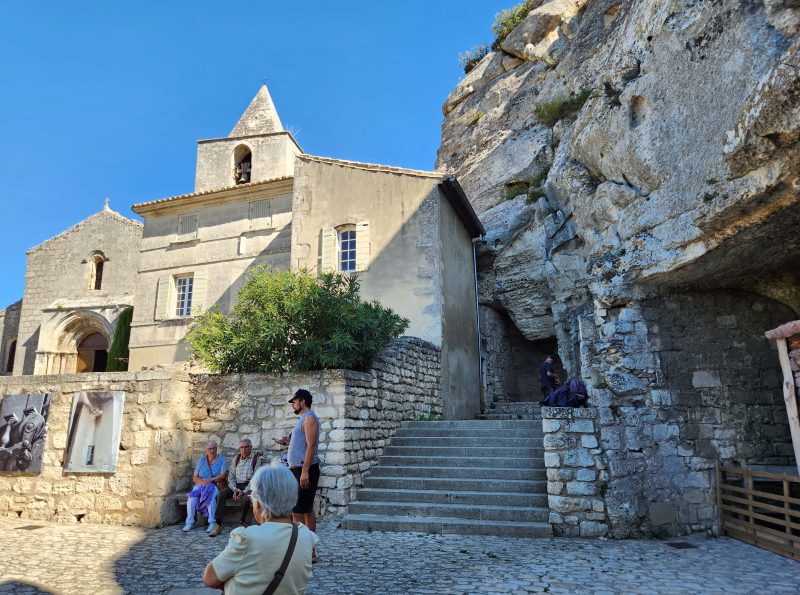
Here’s the main altar of the church. Much of this area is located within the rock shown in the photo above. When the morning sun shines on the eastward-facing stained-glass windows, it sends colored light into the nave.
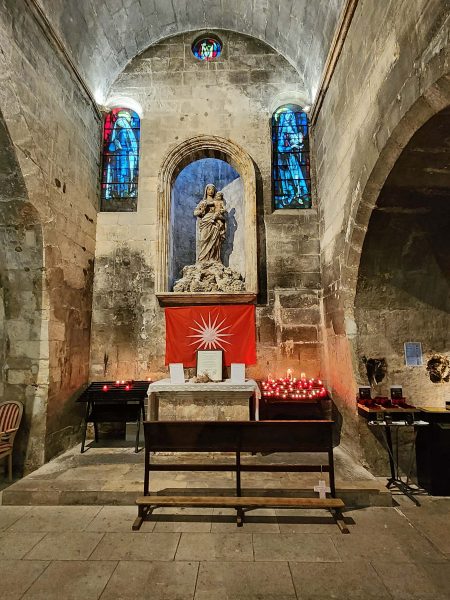
This carved niche of St. Vincent’s Church is cut out of the mountain rock. At Christmas, it is used to stage the Nativity. A lamb is placed in the small cart and brought by the “shepherd” to Baby Jesus. Merino sheep are raised in this region of France, so sheep are very important to the economy here.
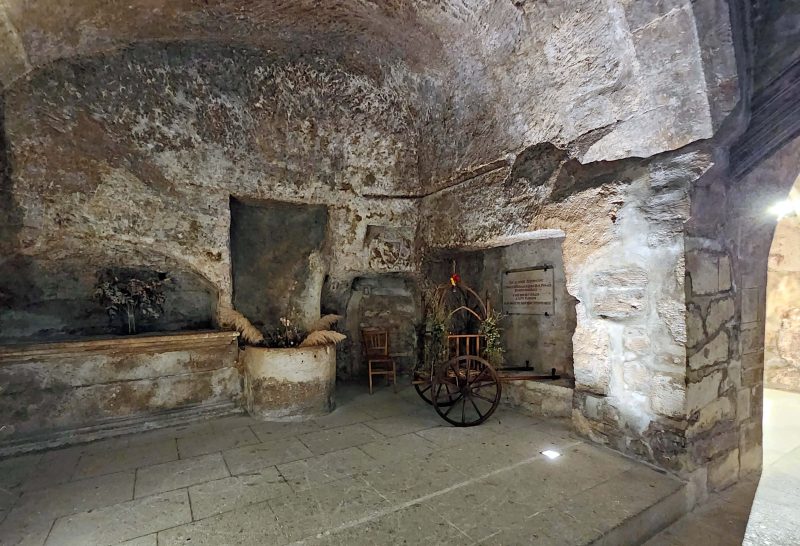
In addition to carving the visible mountain rocks, the Mistral winds have shaped small caves like this, as well as larger ones, in the mountains. La citerne means “the cistern”—a tank for storing water, especially for flushing toilets. Maybe the restrooms were near this little cave. (Hopefully, not in it.)
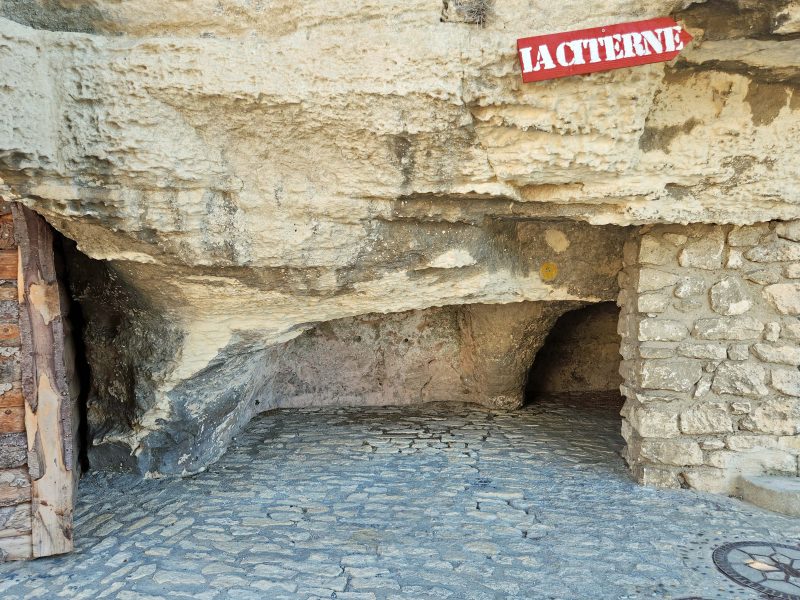
At its peak, Les Baux had about 6,000 residents; today, fewer than 300 people live there. It is much noisier and busier today than it was in Medieval times, however, because more than 1.5 million tourists visit it each year. That explains the large number of shops in the village.
Here are some scenes from the stone village of Les Baux.
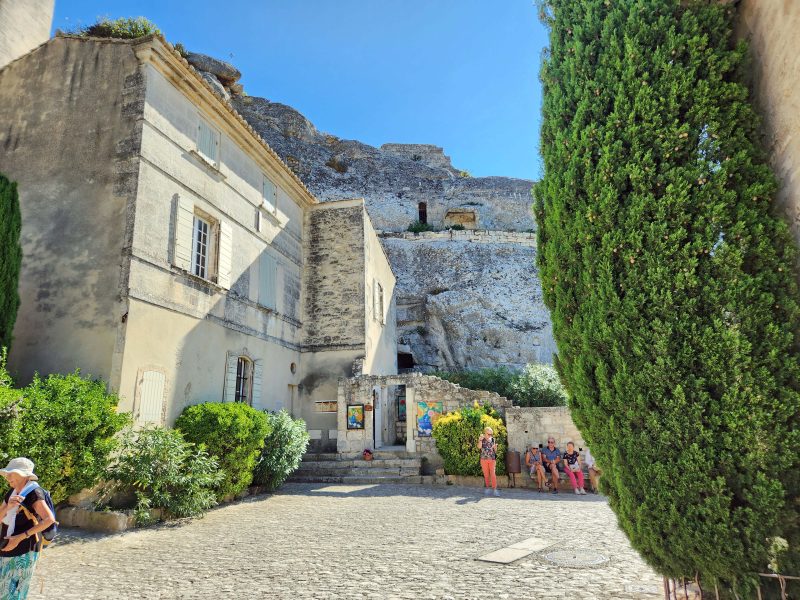

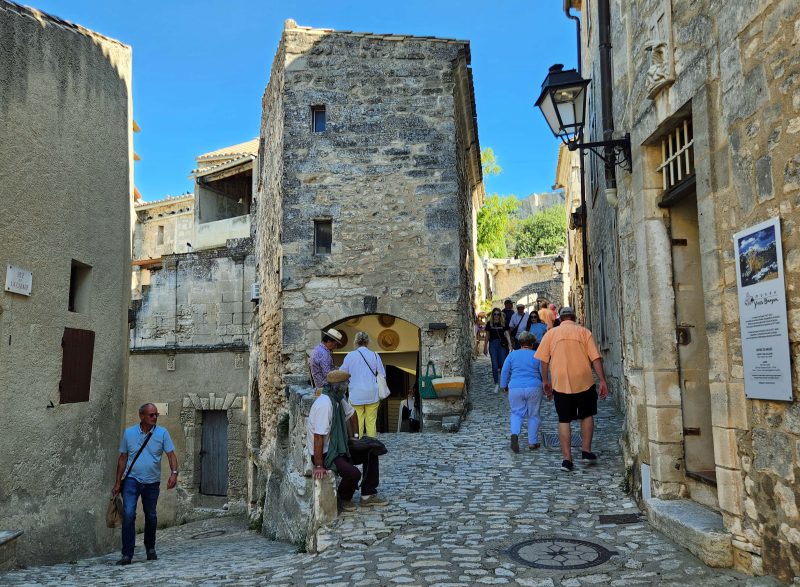
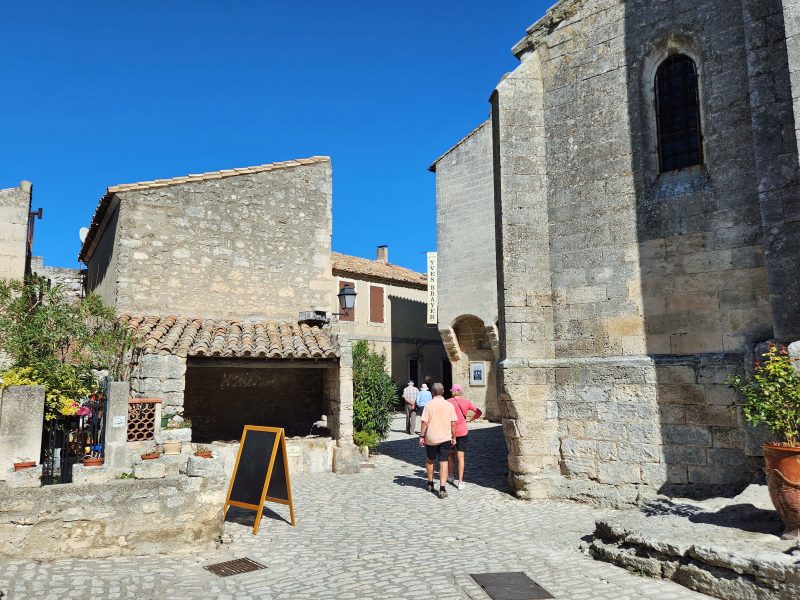
This is a café, but it didn’t qualify for my “tiny cafés” post because the single umbrella provides shade in the reception area while waiting for the hostess to seat you. The café itself is beyond the arched doorway in the left center of the photo and has a beautiful view overlooking a valley.
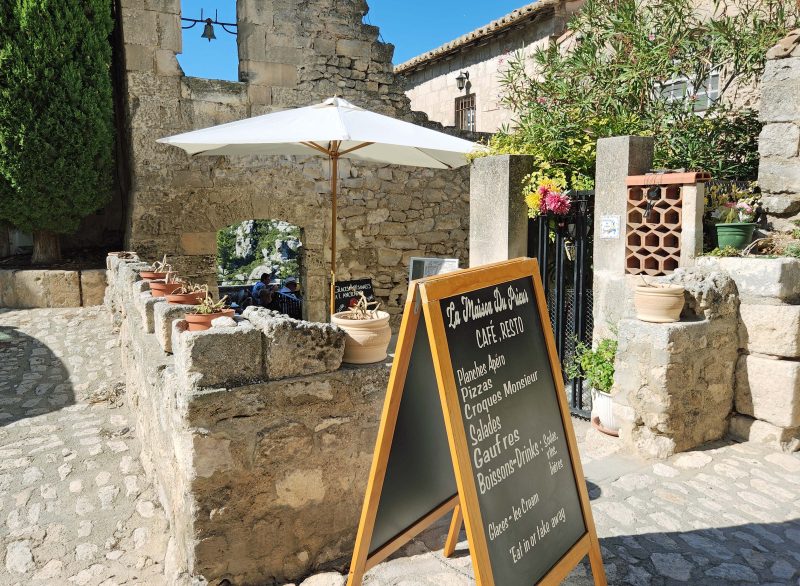
It was a lovely day to be outdoors, and it was interesting to walk around Les Baux. It’s the only place I’ve ever been where all the buildings, streets, and scenery are made of rock—with the exception of a few bits of decorative greenery.
Today, our ship was docked at Marseille, France, but Ted and I chose a shore excursion to Saint-Rémy-de-Provence to walk “In the Footsteps of van Gogh.” Ted and I were second-guessing ourselves about choosing this excursion, but we stuck with our plans and it turned out to be a good thing.
The village of St. Rémy is a place that I think would be very nice to live. It’s attractive, has lots of small businesses, and is small enough to meet and greet friends. Or maybe it was just a relief to be away from all those places we’ve visited that were overwhelmingly crowded. Whatever, we had to travel through some of the countryside of Provence, a province in the southeast corner of France, to get from the dock to Saint Rémy. The Alpilles Mountains are in the background.


Along the way, our guide, Corina, told us about the Mistral—a cold and dry strong wind that blows from the north along the lower Rhône River valley toward southeast France and the Mediterranean Sea. The Mistral usually blows in winter or spring, but it can occur in any season. Its average wind speeds are about 30 mph, but it calms at night and usually lasts for only a single day. One of the effects of the Mistral is an unusually sunny climate in the Provence area. St. Louis has an average of 2,600 hours of sunshine per year (I checked); Provence averages 2,700-2,900 hours of sunshine per year because of the dry, clear air left behind the Mistral.
When we arrived in Saint Rémy, we began our walk around the village. It was early in the morning, and still cool in late September, so the cafés were pretty and inviting, but also closed and empty.
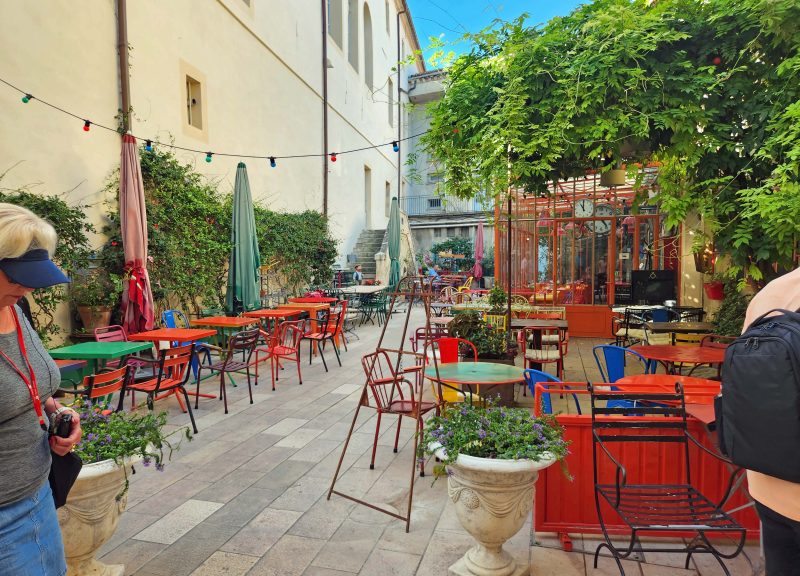
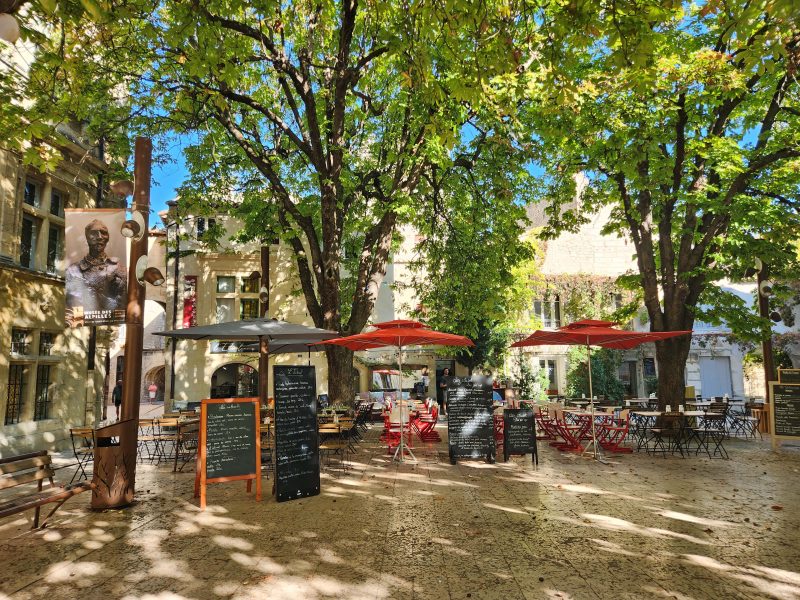
We toured a church in the village, but I don’t remember the name of it. As Corina said, “If you’ve been touring in Europe, you’ve already seen a lot of churches.” So true! They’ve all been beautiful, but they also blur together. The church names that Ted and I remember from our travels are those of the most unique buildings we’ve seen—and even then, we sometimes only remember the city in which we saw them. Here are some pictures of the not-to-be-named church we visited in Saint Rémy.
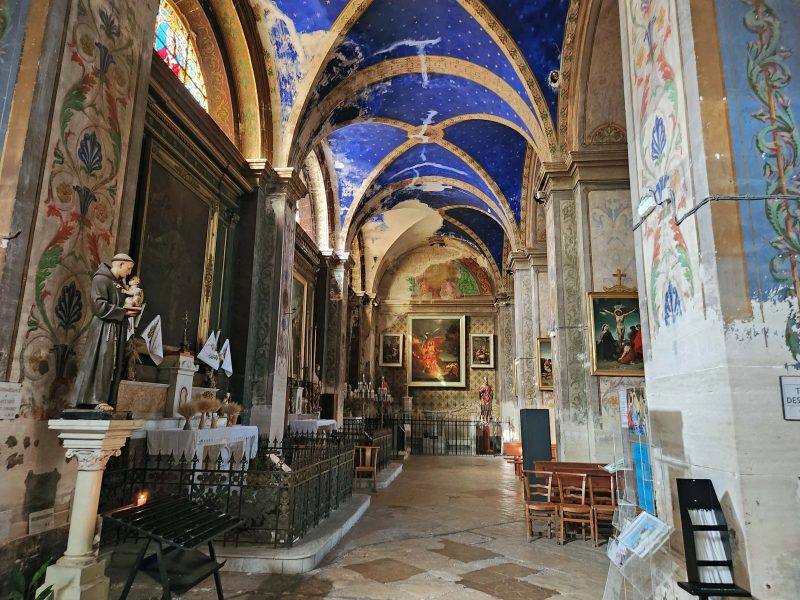
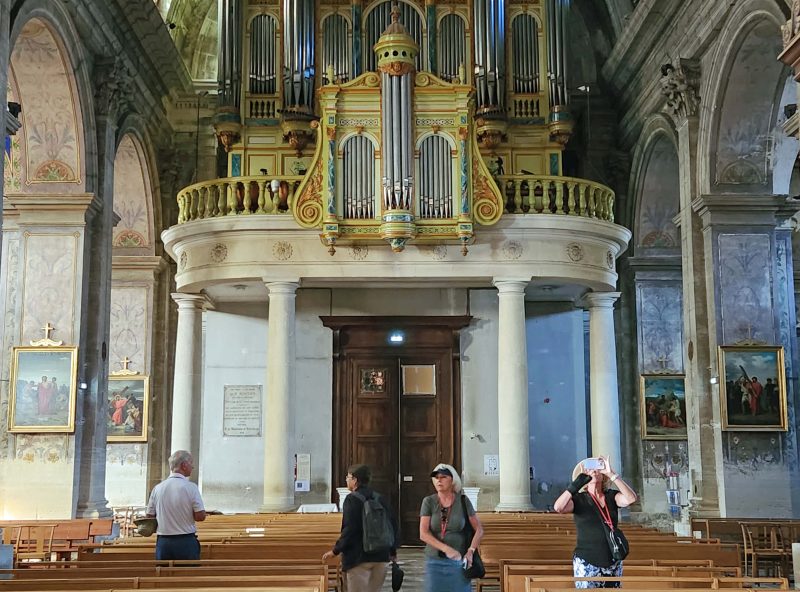

As we walked around the village, Corina pointed out this corner apartment (on the left). It is the birthplace and home of Nostradamus. Nostradamus was an astrologer and a physician. He wrote a mysterious book filled with prophecies and predictions that he published in 1555. The book earned him fame during and after his lifetime. He has been credited by his loyal followers for predicting pivotal historical events such as the French Revolution, the rise of Adolph Hitler, the September 11, 2001 attacks on the Twin Towers in New York City, and even the 2020 coronavirus pandemic. According to Nostradamus, the world will end in the year 3797. Get ready.
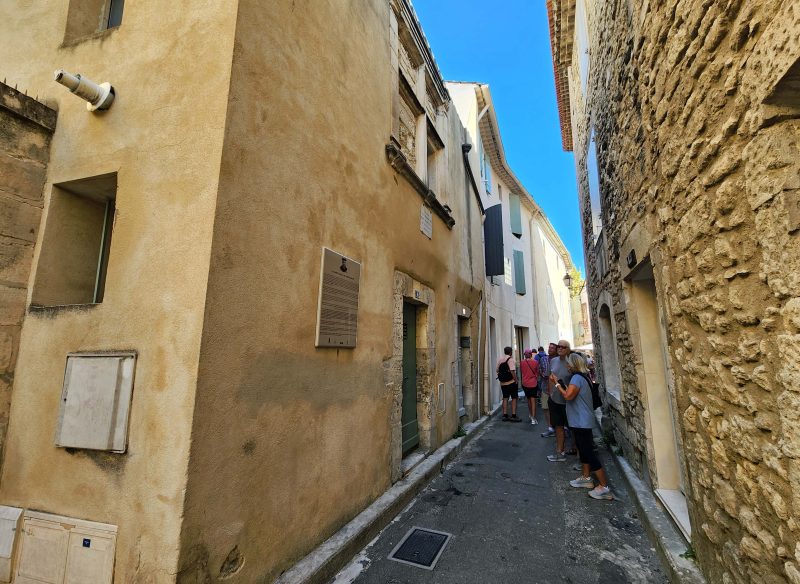
We walked through more of the village as we headed for the downtown area and the shops.
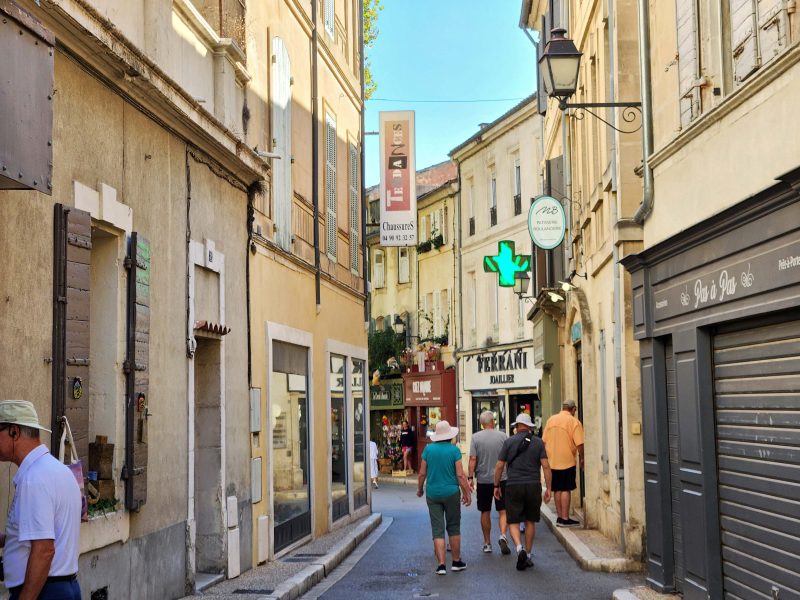
Not all the shops were open, but we entered one that was obviously part of the planned tour route. The proprietor told us about Marseille soap—which she sells in her shop. To tell the truth, Marseille soap is pretty amazing.
Just as genuine champagne can only be made using grapes grown in the Champagne region of France, genuine savon de Marseille (Marseille soap) can only be made in the Marseille region, and it must be made using the ancient and natural processing methods developed in the 1600s. The soap is 100 percent natural and is gentle enough for bathing babies and for irritated skin. In fact, dermatologists often recommend it to treat skin conditions such as eczema and psoriasis. It works well on the body as a facial cleanser, make-up remover, shaving cream, shampoo, toothpaste, wound and burn treatment, and for pet soap. Around the house, it can replace most household cleaners for cleaning surfaces and floors (even stone floors), dishwashing, and laundry, and it is also an excellent stain-remover and moth-repellent for clothing. Surprise! In addition to cleaning baby skin and wounds, it’s an effective insecticide and can be used as an agricultural pesticide.
To recognize authentic Marseille soap, look for the following:
At our bus pick-up point in Saint Rémy, we saw these Roman ruins. This was originally the Mausoleum of Glanum, a monument erected between 30 and 20 BC. Corina grew up in Saint Rémy and, when we passed the ruins of a Roman building (the frame of a house), Corinne told us that when she was little and on a school field trip, she visited those ruins and others around the village. She asked her guide why the Romans never completed their buildings because she didn’t understand that what she saw was the remains of something larger. That’s kind of how Ted and I are feeling after seeing so many ruins in such a concentrated period of time. We might be “ruined.” (Insert groan here.)

After our time in the village, we drove to the outskirts of town to visit the psychiatric hospital of Saint Rémy, located in the monastery of Saint-Paul-de-Mausole. The building still serves as a hospital, but not for psychiatric patients. Vincent van Gogh admitted himself to this hospital and spent one year in it as a patient. Despite his unstable mental health at the time, he was very productive and completed about 150 paintings during that year. His time in the asylum did not cure him as he had hoped it would, and he died by suicide shortly afterward.
At the entrance gate is a statue of van Gogh holding a sunflower. He loved sunflowers and planted some in the garden behind the hospital. I doubt if the sunflowers in my photo are those planted by van Gogh 130 years ago, but they were pretty.
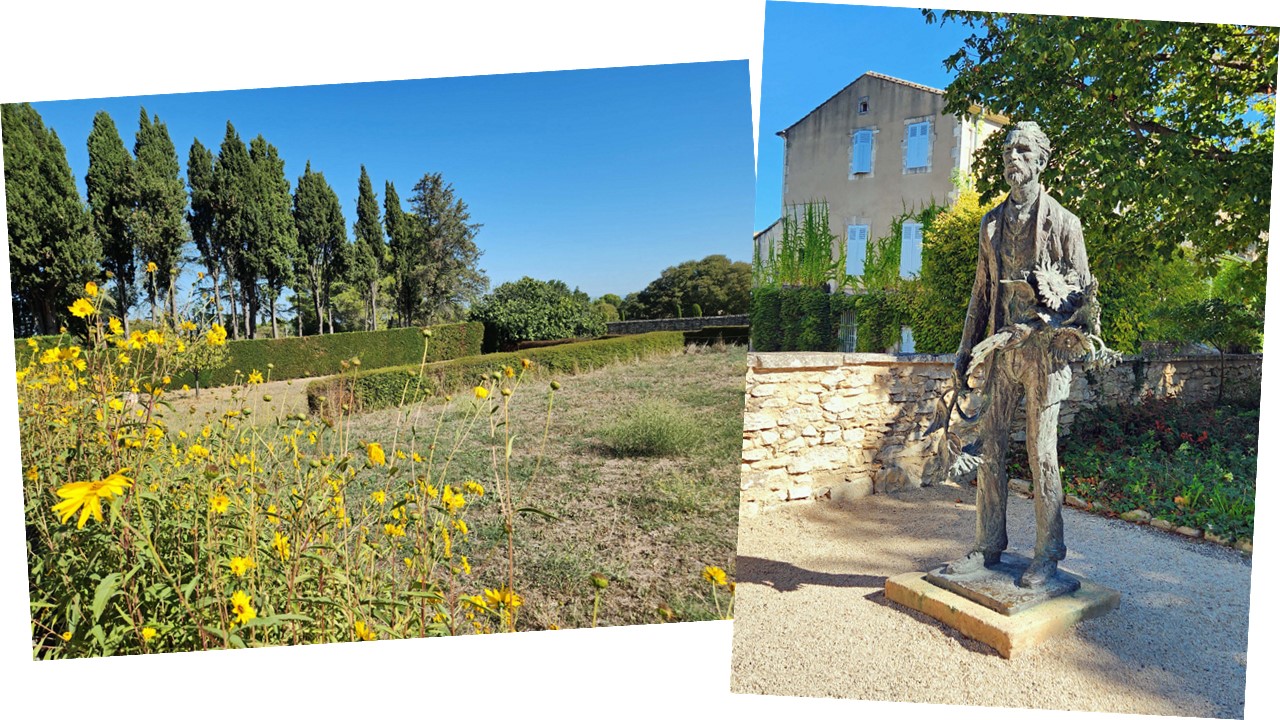
As we walked from the entrance along the path to the asylum door, we passed a display of replicas of van Gogh’s paintings. These two have always been my favorites.
“Starry Night”

“Irises”
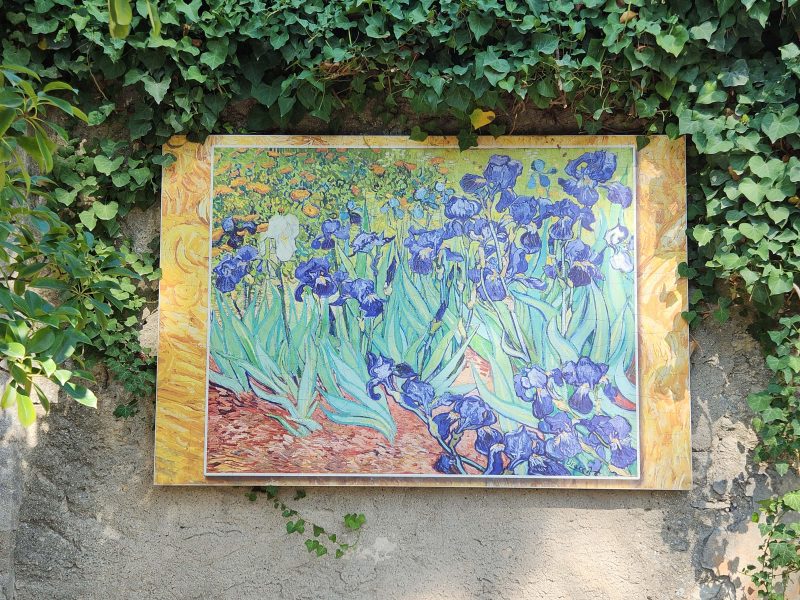
Some of the scenes van Gogh painted were visible along the path to the building entrance. They were set at the scene van Gogh painted, and each had an explanatory plaque that included a picture of van Gogh’s painting for visitors to compare with the current landscape.
“Olive Grove”
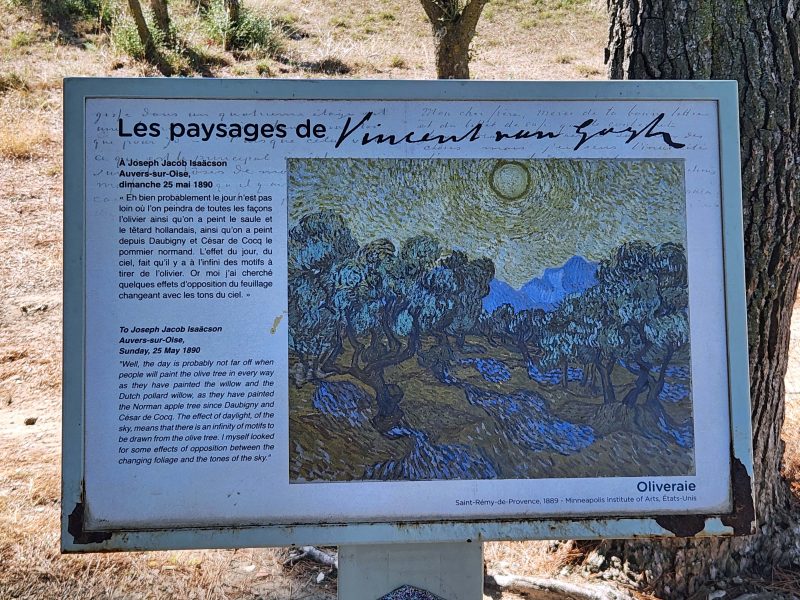

“The Alpilles (mountain range) with Olive Trees”
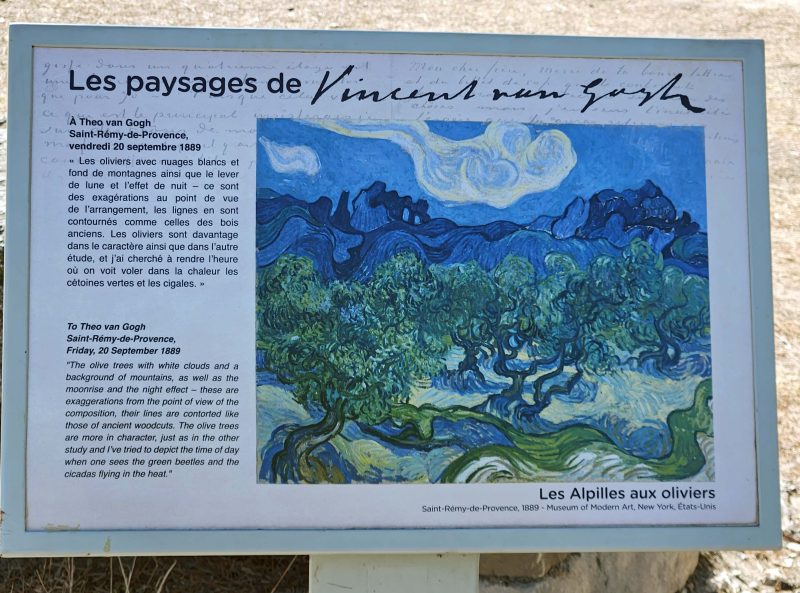
Sorry, no clouds in the sky today to match the original.

“First Steps”
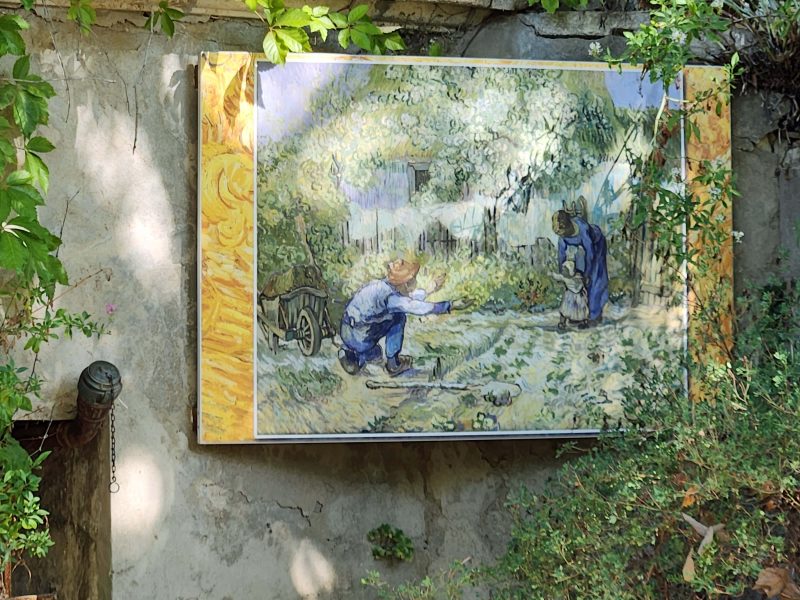

“Bedroom” (This was van Gogh’s room in the hospital.)
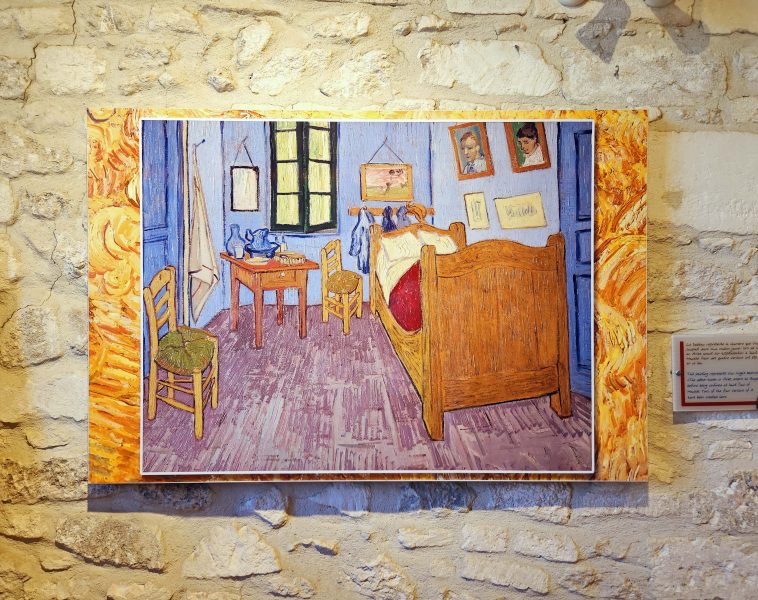
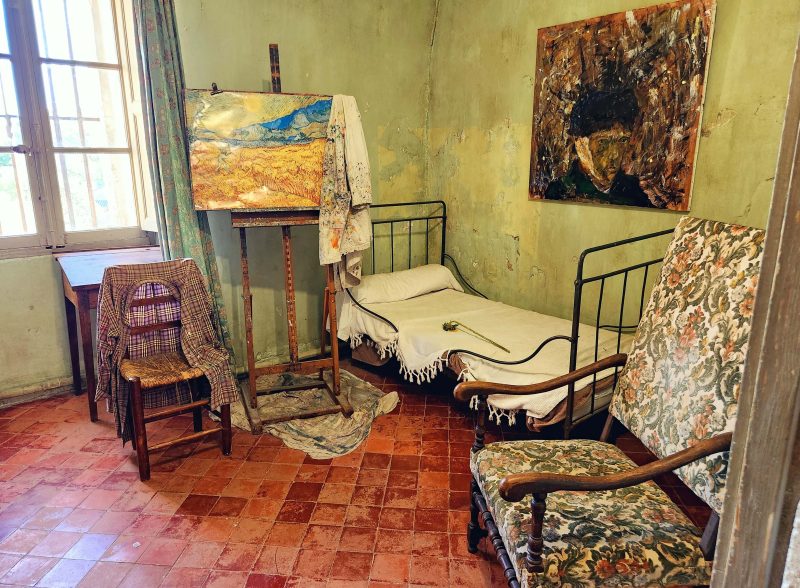
The hospital/museum has a pretty courtyard.
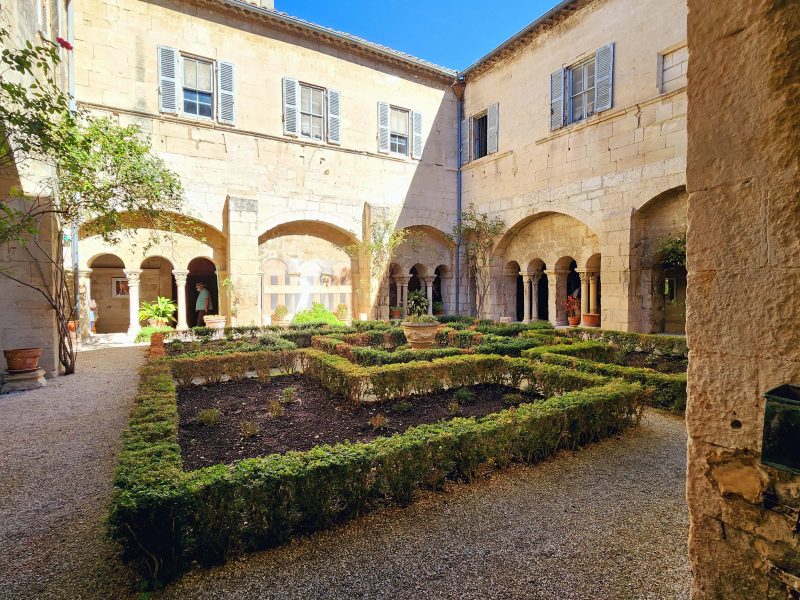
Here’s a copy of van Gogh’s self-portrait. In addition to the outdoor replicas of van Gogh’s paintings, there was a gallery of his work inside the building.
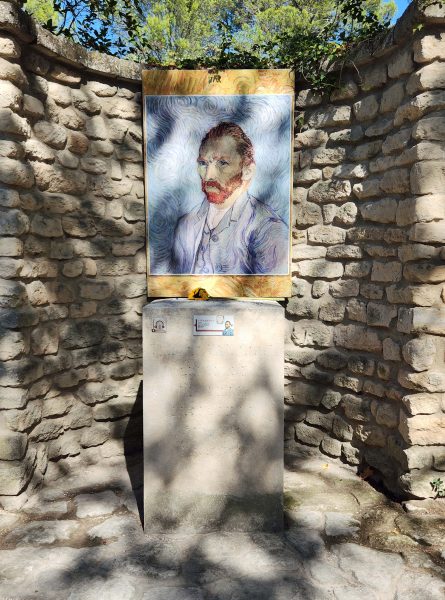
What we thought would be a ho-hum morning turned out to be a relaxing walk around a friendly village and a chance to look at beautiful art by a renowned artist. When we returned to our stateroom, we smiled when we saw a complimentary three-ounce bar of Marseille soap. Now it’s decision-making time: What shall we use it for?
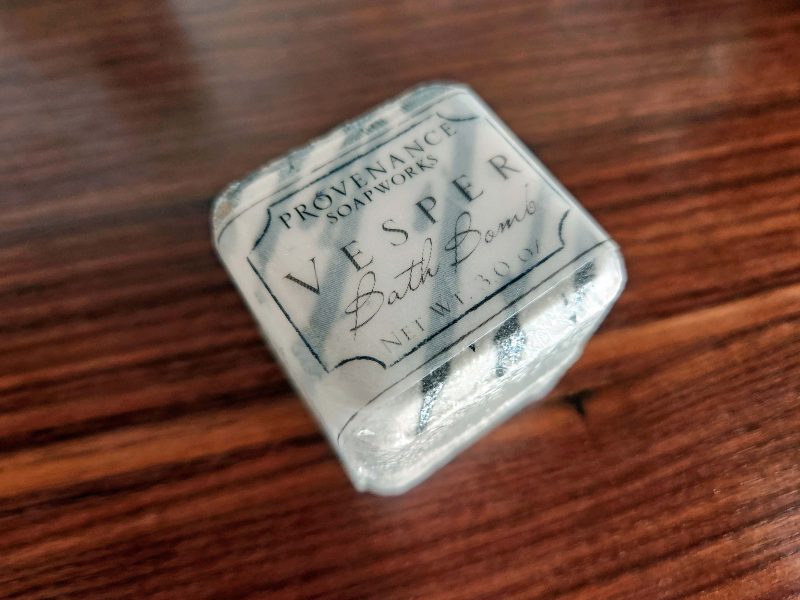
One of my favorite things about traveling in Europe is the abundance of sidewalk cafés. On our travels, Ted and I have eaten in far more outdoor cafés than indoor restaurants. Full disclosure requires me to add that our European travels have been during the summer months, when the weather is warm. In some places, like Chioggia, Italy the sidewalks are exceptionally wide, allowing ample space for café tables and chairs.
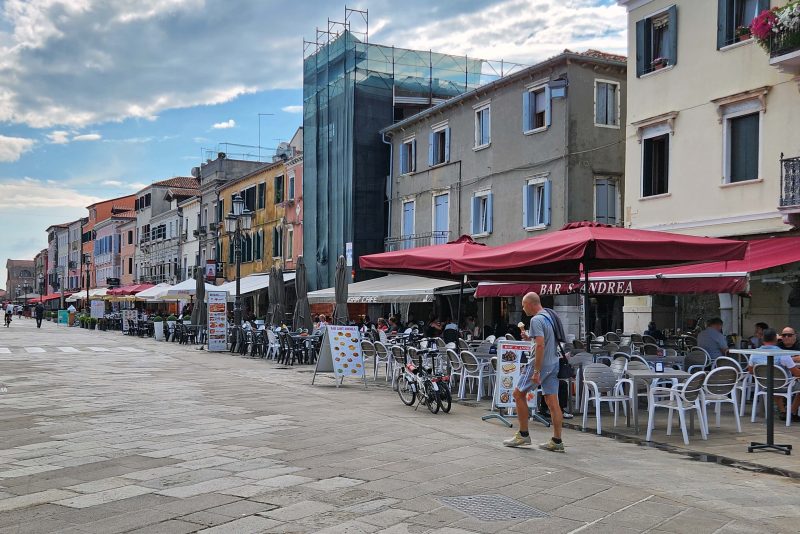
Other places, however, seem to have the philosophy of “If the space is large enough for a table and chairs, it’s large enough for a café.” Here are some of the scrunchiest spaces in which we saw sidewalk cafés on our 2023 Big BT.
Dubrovnik, Croatia–just enough space to walk by.
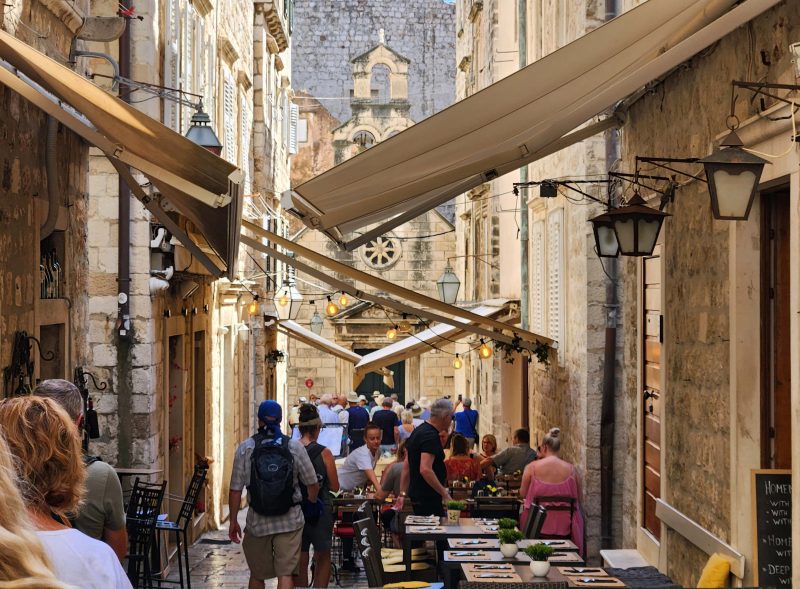
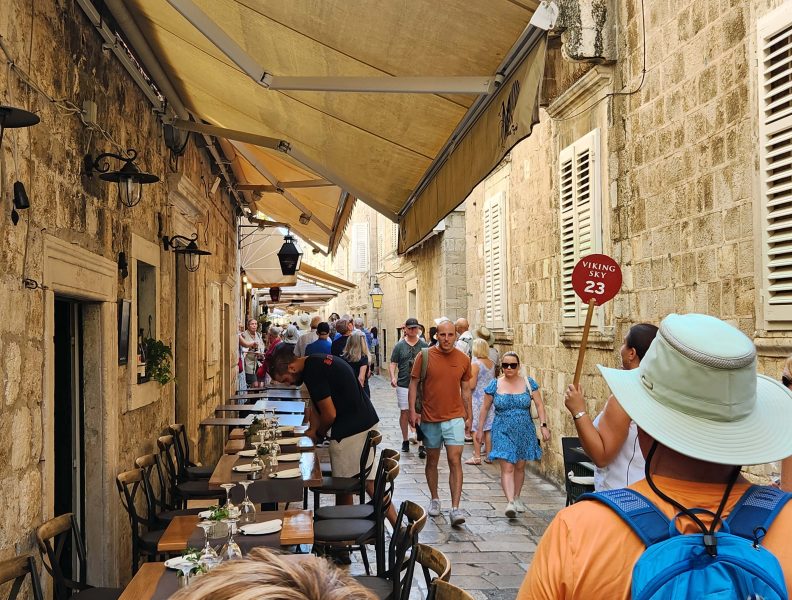
Corfu, Greece–four tables for a nice conversational grouping.
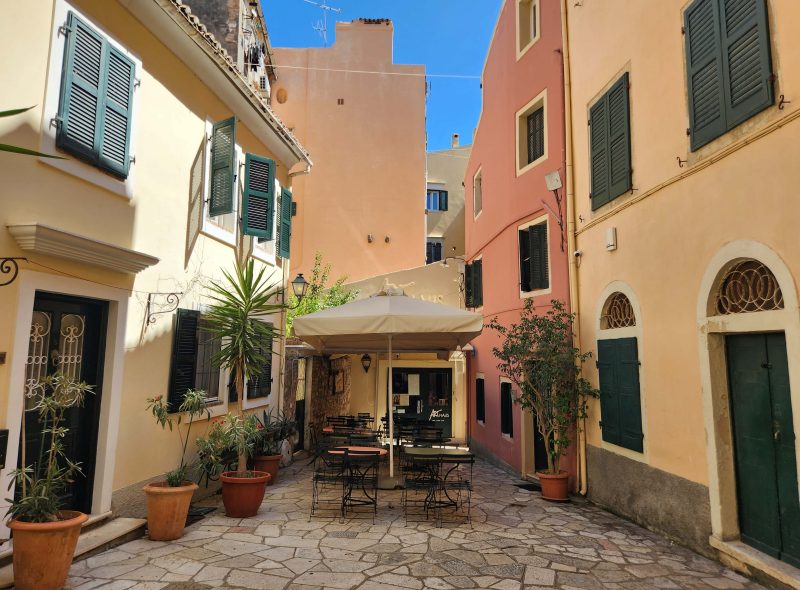
Kotor, Montenegro–three cafés in this space!
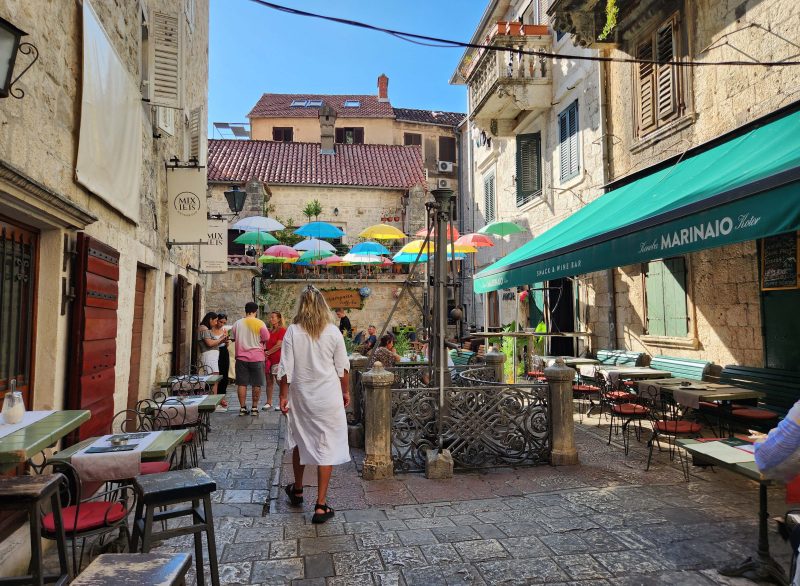
Taormina, Sicily–access at the stairway landing.
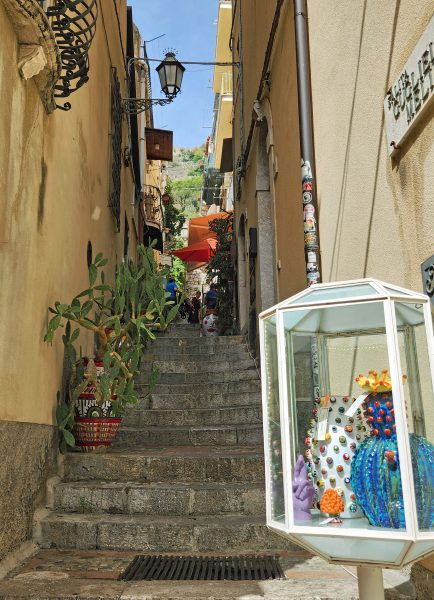
Taormina again, with stair-step tables up to the next street.
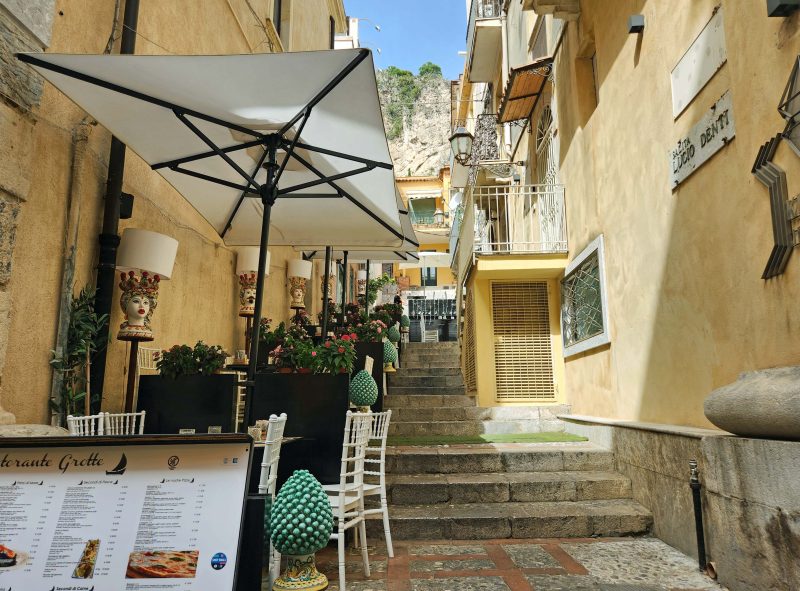
Ostuni, Italy–thankfully, more tables inside.
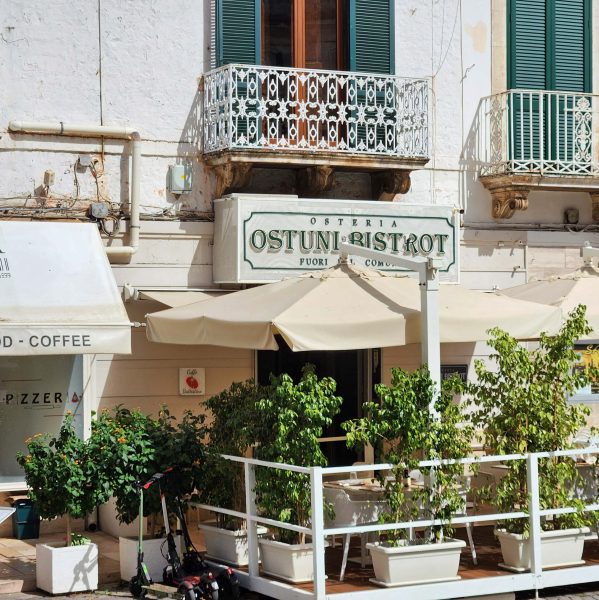
Alberobello, Italy–winner of the smallest outdoor café seating area we’ve ever seen.
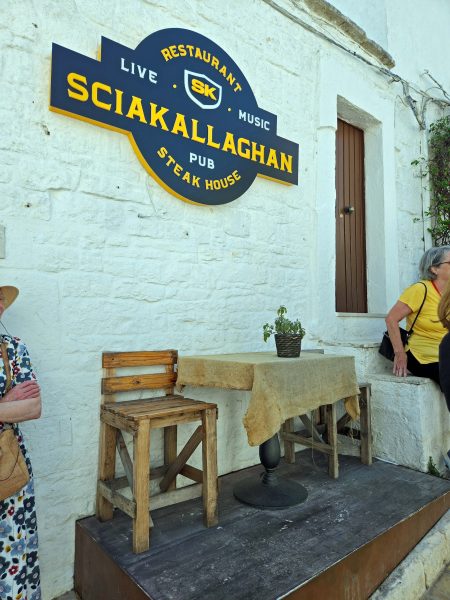
With a total area of approximately three-fourths of a square mile (about 500 acres for the farmers out there) and a population of just over 36,000 people (2023), Monaco is the second-smallest and the most densely populated country in the world. Only Vatican City is smaller—and it’s far less densely populated.
Fun fact: Monaco is tax-free because tourist money covers all government expenses.
There are four quarters in Monaco: (1) the town of Monaco, or “the Rock” headland that includes the old town; (2) the business district; (3) Fontvieille, the newer zone; and (4) Monte Carlo, the administrative area that includes the gambling casino. Monaco is such a small place, we were in all four quarters.
Monaco is governed by a constitutional monarchy and has been ruled by the House of Grimaldi since 1297. Its current head of state is Albert II, prince of Monaco, the only son of Prince Rainier III and Princess Grace Kelly. Because the head of state is a prince, the country is a principality, and not a kingdom. Monaco is a very expensive place to live. It’s common for property in Monte Carlo to rent at €72,000 per square meter ($7,250 per square foot), and some places cost as much as €90,000 per square meter ($97,500 per square foot),
We needed to take a tender from our ship to the dock in Monaco. This is how our approach to the dock looked. The building in the upper right is part of the old town atop “the Rock.” The red brick building on the left is part of Fontvieille, the new town.

Here’s a view of the harbor from on land. You can see how “the Rock” juts out into the water. The white building on the Rock is the same one as the building on the right in the photo above. We went around the Rock to disembark from the tender.
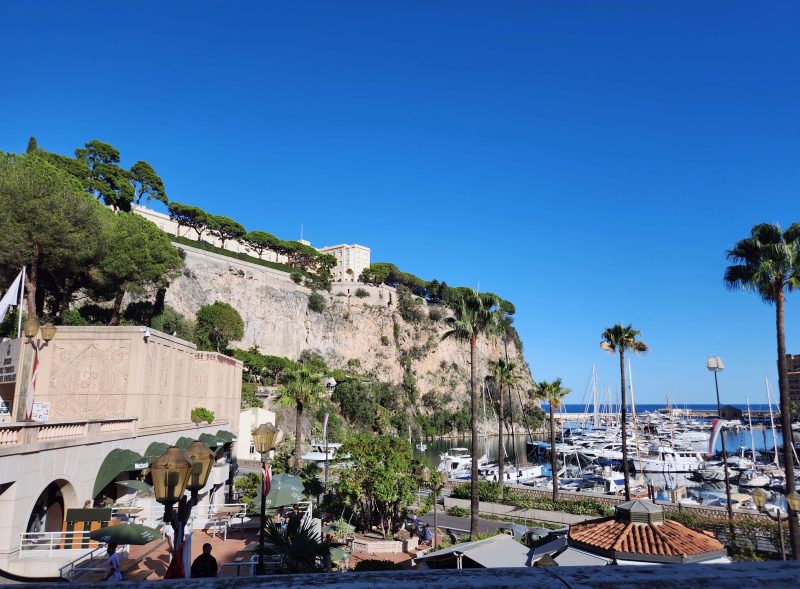
All of Monaco can be seen from the top of the Rock, so we climbed to the top. There were some outdoor escalators at the very steep parts; the rest of the way we walked on a sidewalk like this.
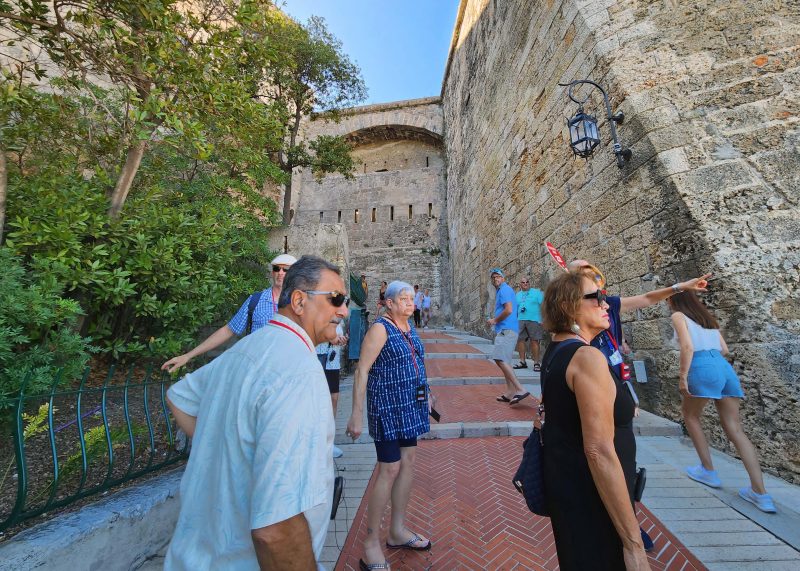
As we climbed higher, beautiful views appeared. This is another view of Fontvieilli from above. The harbor was filled in to provide a foundation for all these newer buildings.

The photo below shows Monte Carlo as seen in publicity shots. It’s beautiful in person! Crowded, but beautiful. In the right center of the photo, there is a white tower directly in front of a taller blue tower. Below that and slightly to the right, there are two relatively small green domes, about halfway between the tower and the water. (Zoom in on the photo if you can’t find them.) That’s the famous Monte Carlo casino. To give you an idea of the size of Monaco, the country’s border with France falls pretty much where the buildings end on the mountainsides.
The last week of May is the busiest time of the year in Monaco. It’s the week of the superyacht show and the Monaco Grand Prix race. During that week, it costs €150,000 ($163,000) to moor your superyacht in the harbor. The Grand Prix is run on the narrow city streets of this area in a loop from downtown, past the casino, and back—78 times. Our guide told us that, because of the crowds and the noise of the race, many residents leave the city during this week and rent their properties as Airbnbs. She also mentioned that it’s kind of “a thing” to park your superyacht here that week, just to show that you can afford to do so. I’m so glad I don’t have to deal with that kind of peer pressure.

While we were walking around the city square, these classic Formula 1 cars drove by. On the back of the last car are the words “Try Me Now” in case you’ve been dreaming of driving a Formula 1 car.
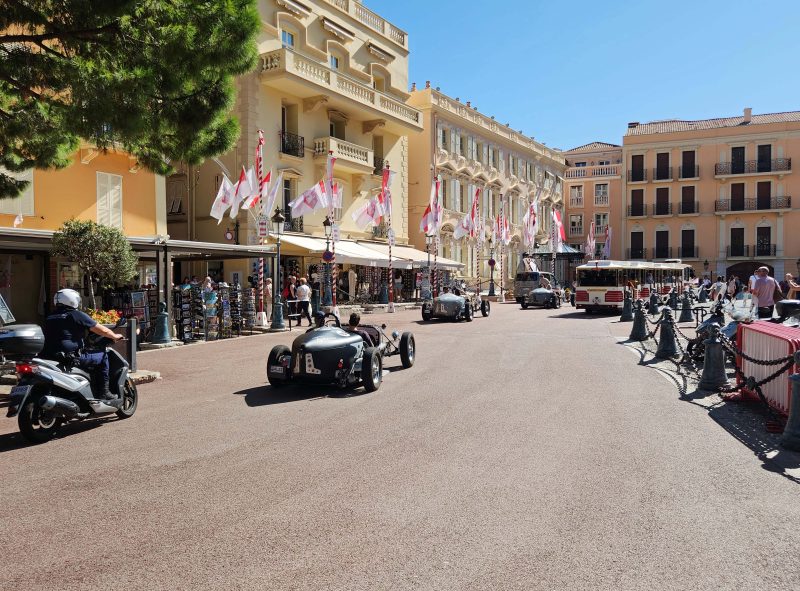
The city trolley also drove by while we were on the square.
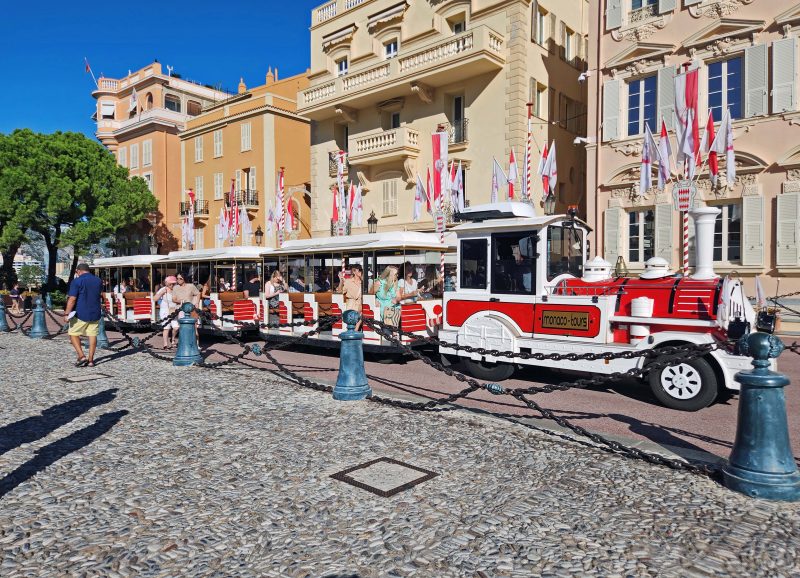
This is the royal palace. The flag is flying atop the tower, so the royal family is in residence in Monaco, but not necessarily in the palace itself. According to our guide, the royal family is a part of the city and its members are well known to all. They walk and drive around the city just like regular folks.

Monaco gained its independence in 1861 when the monks rose up and killed the country’s soldiers. In honor of that action, a monk with a knife is a city symbol.

As we walked around the city, we saw the usual narrow streets and some nice homes.
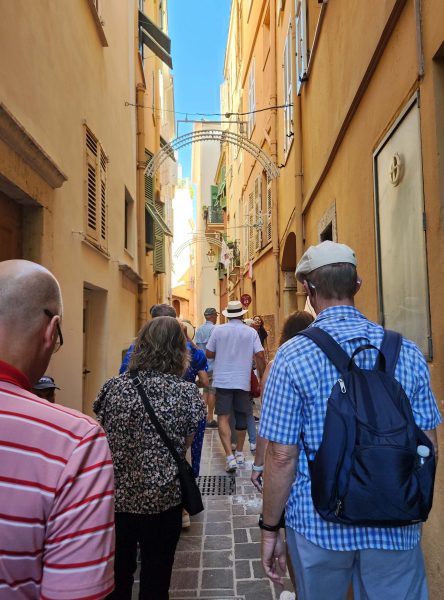
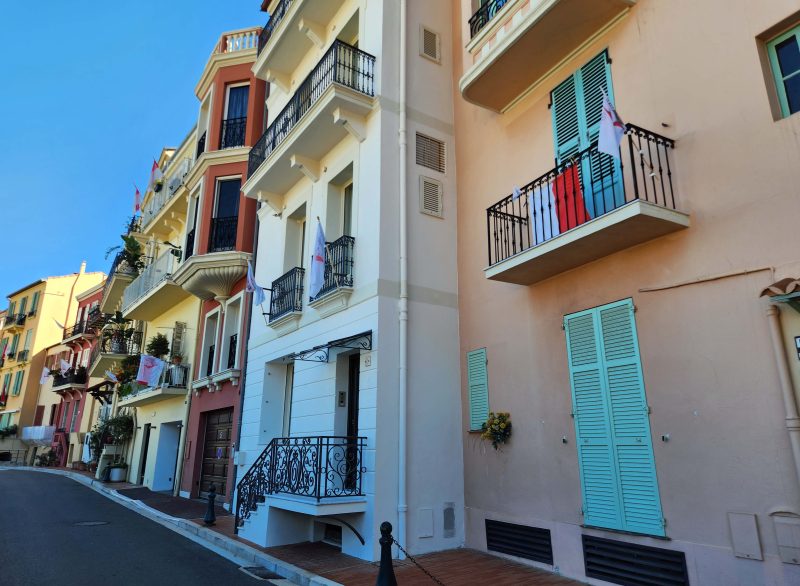
Prince Rainier III and Princess Grace were beloved by the people of Monaco. There are a number of statues and other things in remembrance of them around the city.

Prince Rainier III was born on May 31, 1923, and we were there while the country was celebrating the 100th anniversary of his birth. There were flags everywhere in the Prince’s honor.
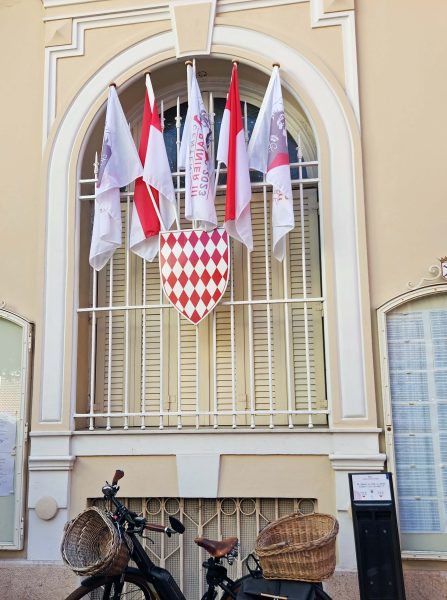
When Ted and I saw this hedge, we thought it might be something for us to consider doing when our boxwood hedge grows a bit thicker.
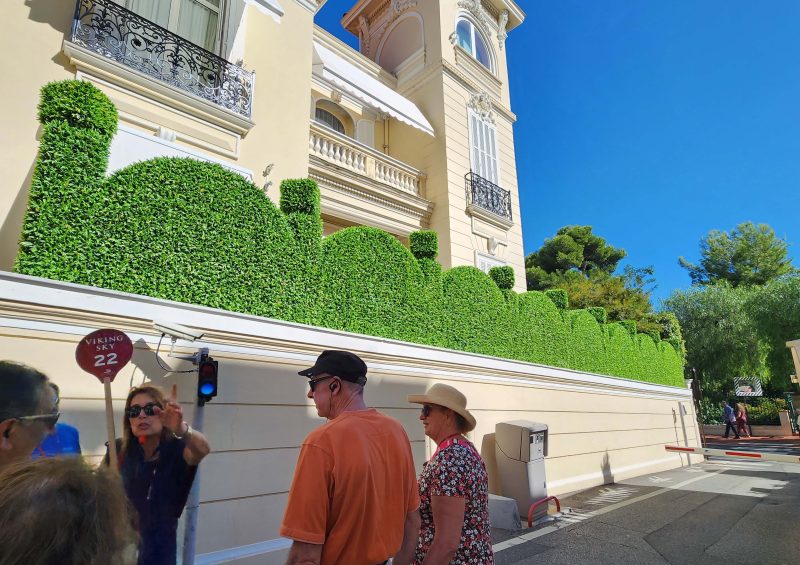
Monaco’s Oceanographic Museum was founded by Prince Albert I, a pioneer of oceanography. The Museum is renowned for its aquarium with its 90 pools that provide a home for more than 6,000 specimens and 350 species of fish. I don’t know what type of rock covers the exterior of the museum, but our guide told us it is self-cleaning when it rains. That sounds nice, but I couldn’t verify it, so it might be just a wishful thought.
Prince Rainier III was a lover of the sea and was concerned about protecting the environment, so he appointed Jacques Cousteau as the head of Monaco’s Oceanographic Museum in 1957. Cousteau led the institution for 30 years.
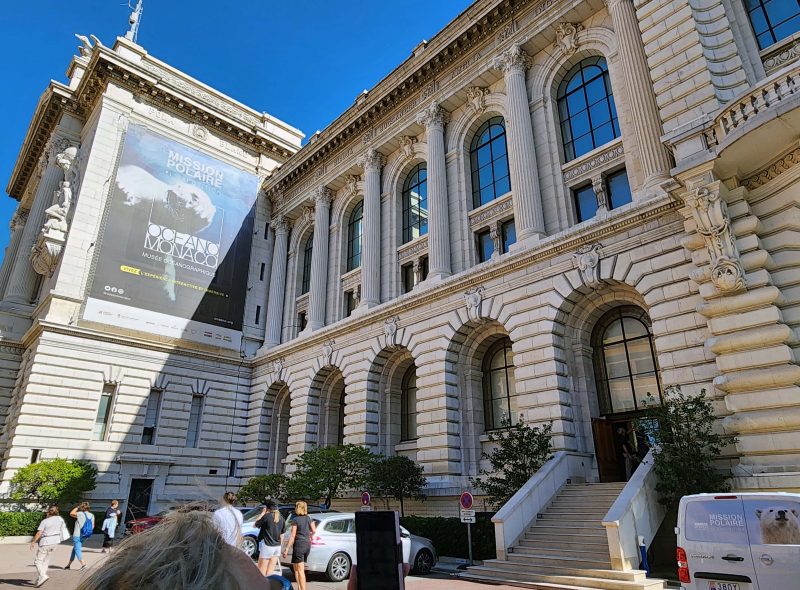
Here’s a close-up of part of the front of the museum. You can tell by the emptiness on the right, that we’re on top of the Rock here. The exterior of the building looks pretty clean, so maybe it rained recently.
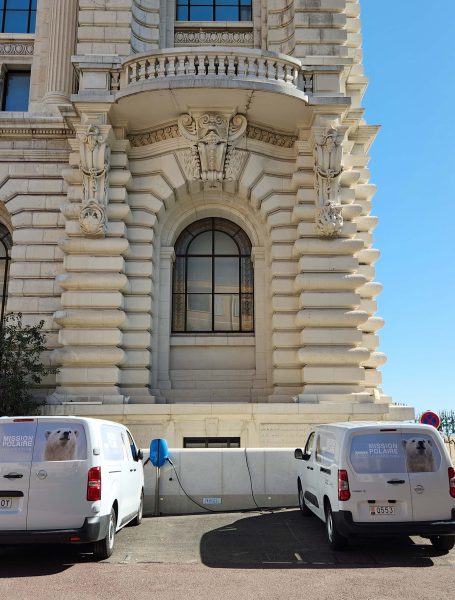
Beside the museum is Monaco’s only national park. It’s not large. You can walk through it in 20 minutes—or sit on a bench and enjoy it for as long as you like.
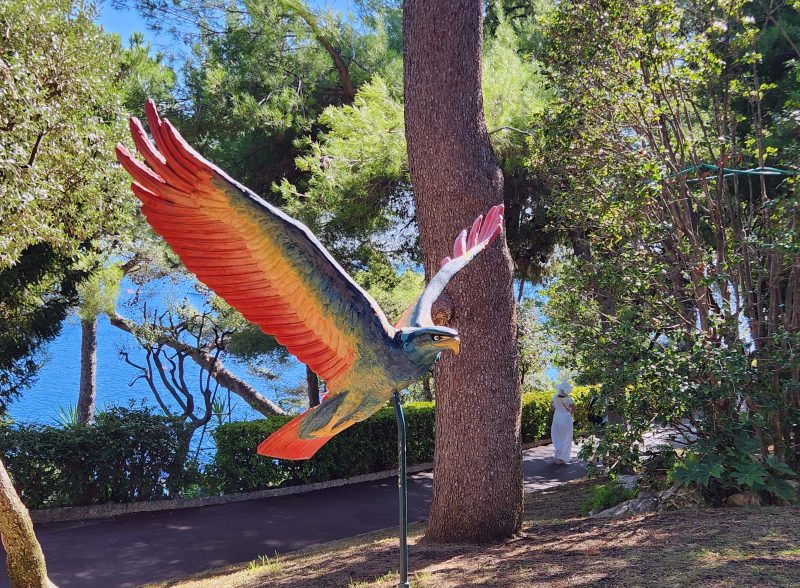

After the park, we walked to St. Nicholas Cathedral, the church where Prince Rainier and Princess Grace were married, attended services, and were buried.
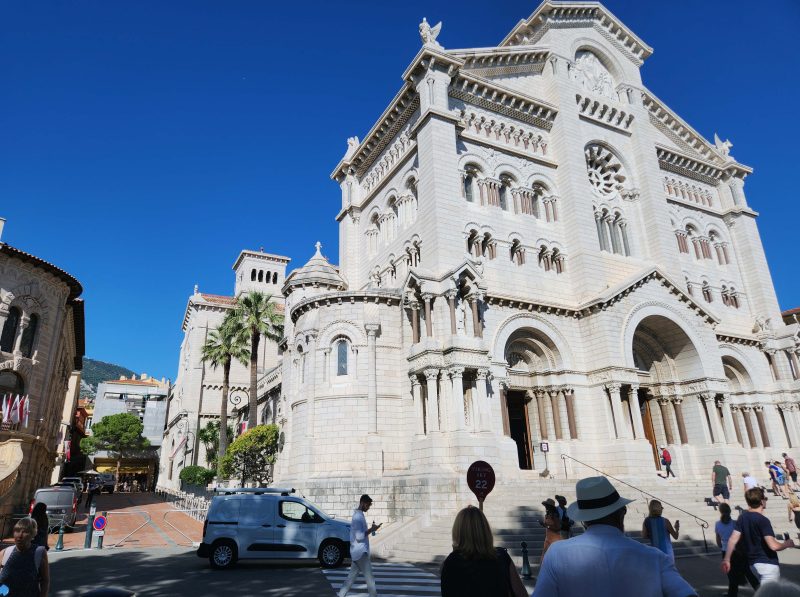
This is the nave of the church.
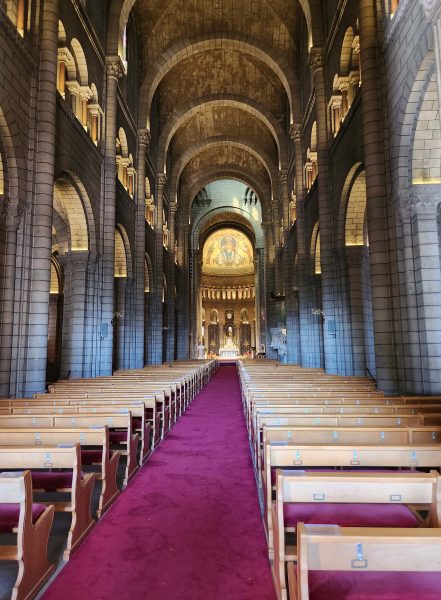
These chairs are in the front of the nave, close to the pulpit. They are where the royal family is seated for services. I guess it it’s pretty obvious if they skip church–or if they fall asleep during the sermon.
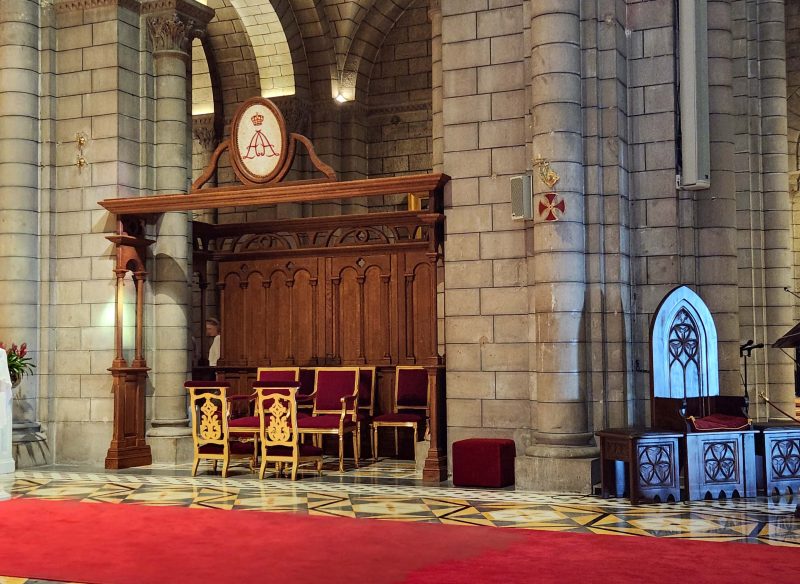
The tombs in the church include the relics of bishops and VIPs in the order of their deaths, so Princess Grace and Prince Rainier are the last two tombs. Two tombs are always left empty in case of an unexpected death. Most of the princely Grimaldi family is buried in this cathedral, from Jean II Grimaldi, who died in 1505; to Grace Kelly, who died in an automobile accident in 1982; and Rainier III, who passed away in 2005. You can see that people still put flowers on the Prince and Princess’s tombs.
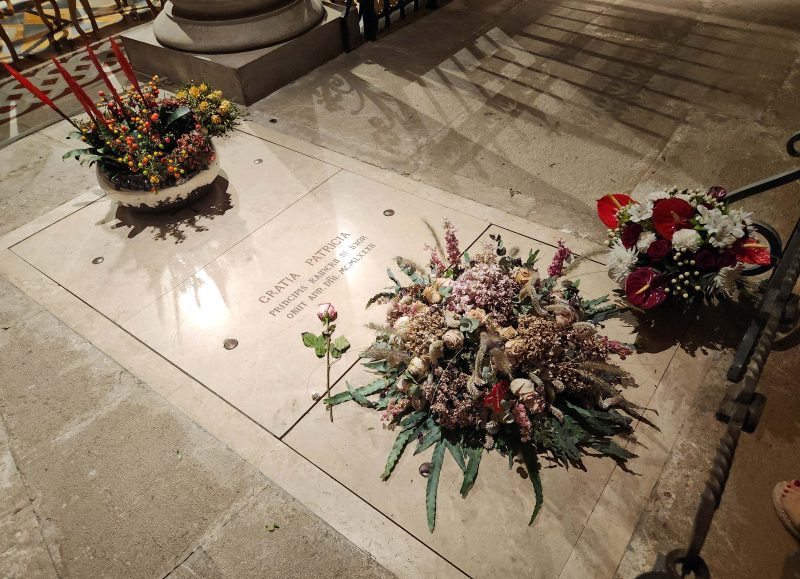
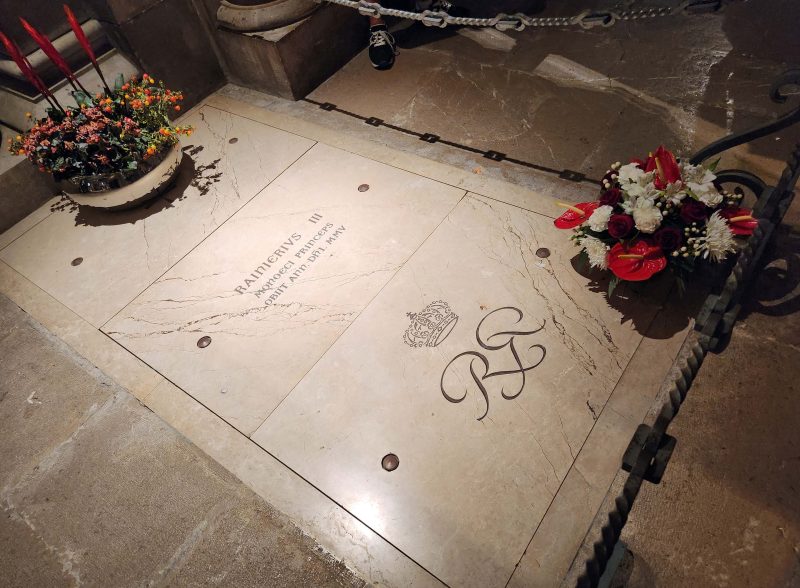
As Ted and I were walking around the city eating ice cream cones, I saw this parking sign. Isn’t it a great idea to inform drivers how many parking places are available so they don’t have to face repeated disappointments driving from lot to lot?
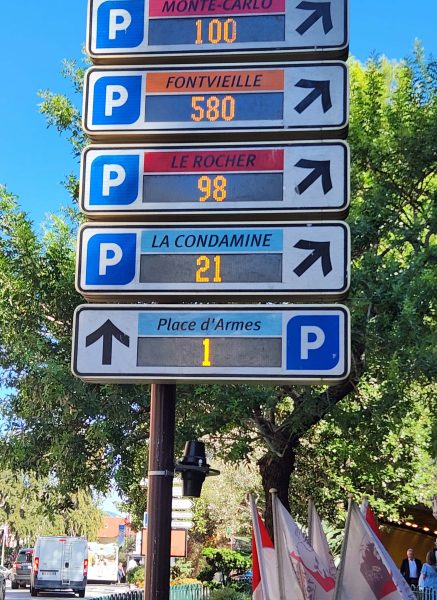
Monaco was a beautiful place to visit on a beautiful day. Ted and I have been lucky with weather on our 2023 BT. The only rain we had was in Athens, and it was dry during the hours we visited the Parthenon and the other buildings on the Acropolis. I guess we’re living right. I know for sure our life is good.
I like remembering the things that make us smile when we travel. I previously posted some amusing things we’d seen. Here are some things we heard that made us laugh.
While we were in Naples, our guide pointed out two different law enforcement uniforms—the polizei (local police) and the carabinieri (military police). In general, she said, people don’t like the carabinieri, so they make up jokes about them. Here’s one:
A trained monkey (polizei) and an astronaut (carabinieri) are sent into space on an experimental flight to see how well the monkey can do. Instructions appear on the screen and are directed at the monkey, telling it to press the red button, then turn left. The monkey does it and the vehicle turns left. The next instructions appear and tell the monkey to press the red button, then the green button, then the thrusters. The monkey does it and the thrusters engage. After a series of instructions come for the monkey, the astronaut sends a message to mission control and asks when he will have a chance to do something. Mission control replies, “Be quiet and feed the monkey.”
************
The Viking crew member who gave the daily “port talk” describing the next day’s port highlights and the shore excursions ended every presentation with a joke. Here are two of them.
The son of a godfather brings his report card home from school and shows it to his dad: Reading—A+; Science—A+; Geography–B+. The godfather looks at the report card and reaches for his gun, then shoots his son. The mother is distraught and crying and asks, “Why did you shoot him?” The godfather answers, “He knew too much.”
************
Walter and Mary go to the county fair and, every year, Walter tells Mary he wants to take the helicopter ride. Mary says, “No, it’s $400, and $400 is $400,” so they don’t ride.
The helicopter pilot overhears Walter and Mary and approaches them. He says, “I’ll give you a ride at no cost on one condition: you can’t say a word. If you say anything, the deal is off.” Walter and Mary agree and get onboard.
Walter gets into the front seat beside the pilot and buckles up while Mary gets settled in the back seat. The pilot takes them up and starts doing tricks with the helicopter, then moves on to death-defying tricks, but neither Walter nor Mary makes a sound. When they land, the pilot says, “You’re amazing. I did everything I could to make you scream and you never made a sound.”
“Well, to tell you the truth, ” says Walter, “I almost said something when Mary fell out of the helicopter, but $400 is $400.”
************
At the end of one of our excursion in Saint-Remy-de-Provence, while several of us were chatting with our guide, Corina, she laughingly said, “When I conduct tours at the start of a cruise, everyone is tired because they’re jet-lagged; at the end of a cruise, everyone is tired because they’re exhausted.”
As Ted and I rode our tour bus to Pisa, we saw these mountains—the Apuan Alps. Our guide told us that the white areas are marble, not snow. This is where the famous Carrara marble comes from. Michelangelo used Carrara marble, and it’s used in construction around the world. Imagine mountains that are white rock when you dig instead of brown or gray.

A little bit later, we crossed the Arno River where some kayakers looked like they were preparing for a race.
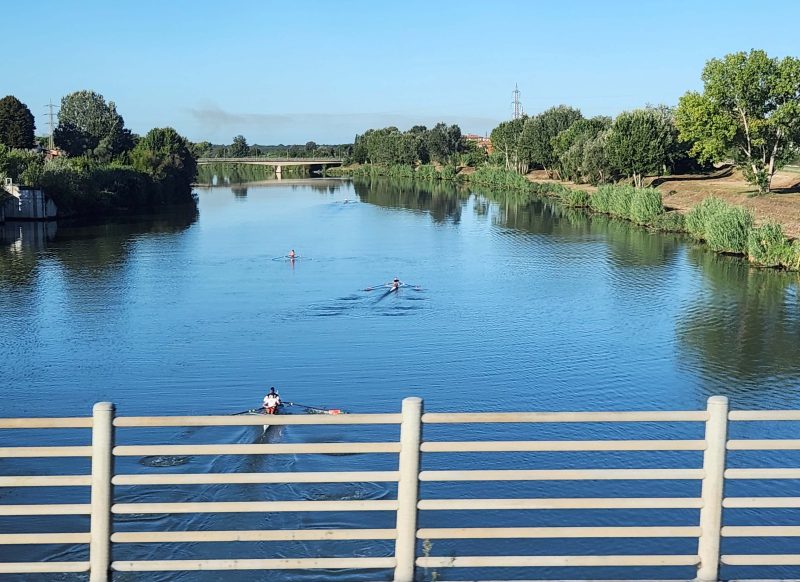
Until we signed up for this excursion, I always thought the Leaning Tower of Pisa was a solitary icon. In truth, I never gave it much thought unless I saw a picture of it. Now I know it’s a bell tower and is only one of four structures in Pisa’s Cathedral Square. The other three structures are the Baptistry, the Cathedral, and the Campo Santo (Holy Field, a cemetery). Three other buildings stood on this site before the current Cathedral was built in 1118, but they were torn down because they had been erected by previous conquerors. The entire complex is within the Old City walls. In the picture below, the Baptistry is in front, then the Cathedral, and then the Bell (Leaning) Tower in the background (center right). The Campo Santo is the low building on the left.

This is the Baptistry. Baptistries are always round or octagonal to symbolize “everlasting.” The octagonal shape also recalls the eighth day, when Christ rose and loosened the bondage of death for Christians. It is the building in which baptisms take place and in which catechumens are instructed. The entrance to the baptistry always faces the entrance to the church to symbolize that baptism is the means to enter the church.

We were visiting Pisa on a Sunday, and there was a baptism taking place. You can see the priest near the door, and the lady on the left is carrying the baby to be baptized. You can see part of the baby’s flowing white baptismal dress and its little bald head. 🙂
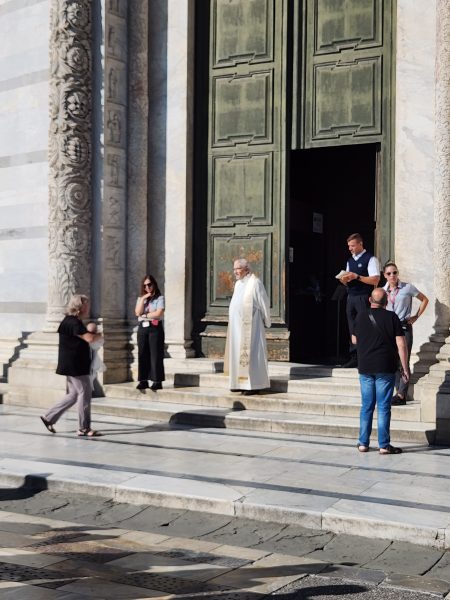
The Cathedral is very impressive. Sunday services were being held, so we were not able to go inside, but pictures I’ve seen online since then show a beautiful interior.

Someone in our group asked the purpose of the scaffolding covering one wing of the Cathedral. Our guide said that some part of the Cathedral is always being repaired or cleaned. This wing is currently being cleaned so the marble will be brightly white again.

The Pisa Cathedral, like most other marble buildings at the time, was built with recycled marble from older Roman buildings. This was done partly because the people didn’t have any money to spare, but also partly to show that the polytheistic religion of the Romans was gone and powerless and that Christianity was stronger.
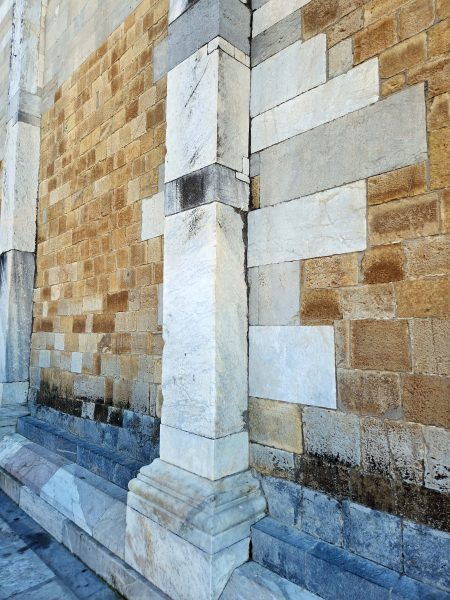
This piece of recycled marble was part of a sarcophagus.
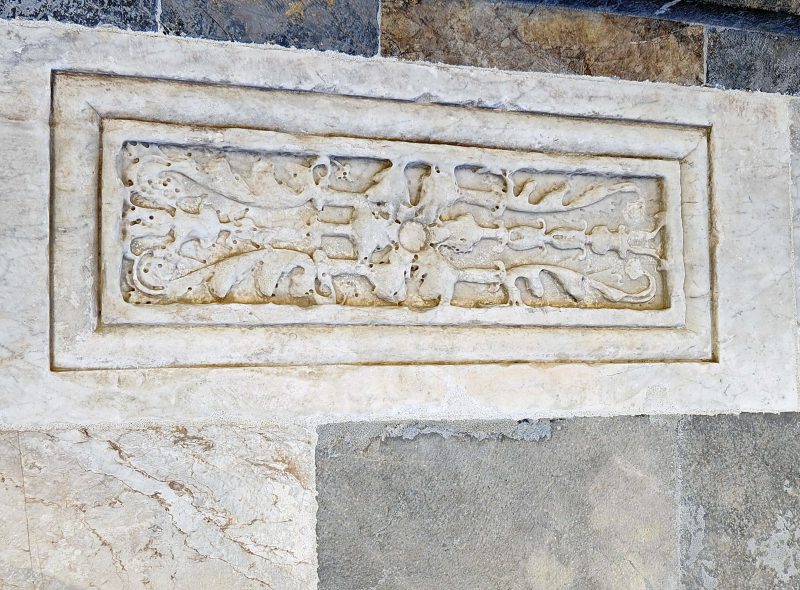
Another random piece had a decorative rose on it.
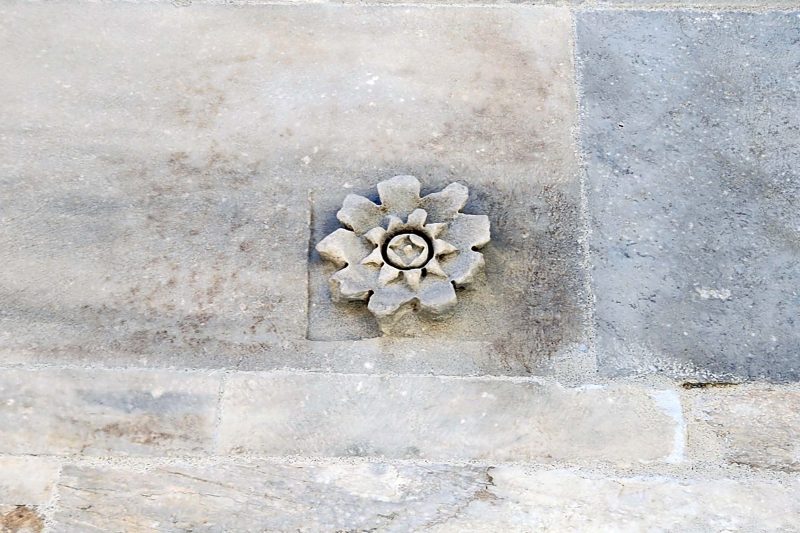
Because Caesar’s name was on this piece of recycled marble, it was placed upside-down to show that Caesar was no longer in power in Pisa.
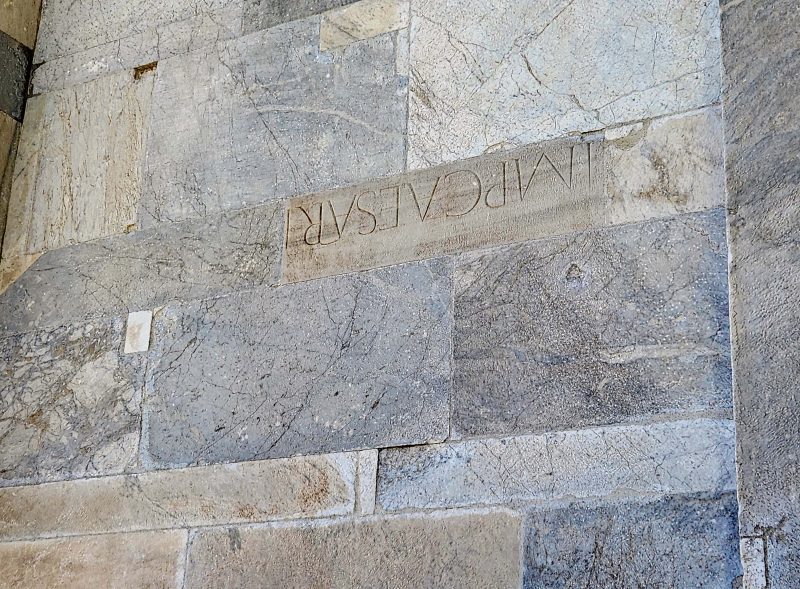
This sculpture on the ground near the Cathedral is called the Fallen Angel.
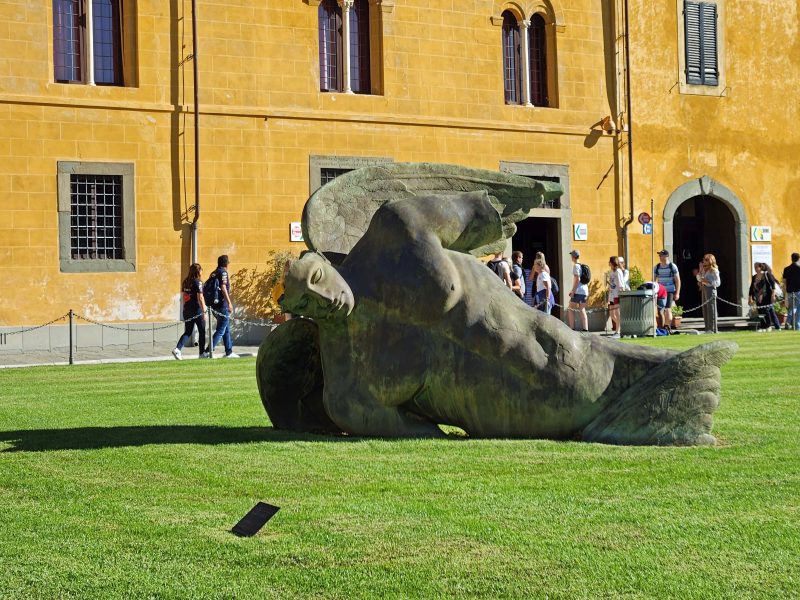
The most iconic building in Cathedral Square is, of course, the Leaning Tower of Pisa. It has seven floors in all, plus the bell chamber with its seven bells—one for each of the notes in the musical scale. The shoreline of the Tyrrhenian Sea (part of the Mediterranean) used to be here, but silt deposits have moved the shoreline 5 miles away from Pisa. Because of this sandy foundation, all the buildings in Cathedral Square lean. Yes, the Cathedral and the Baptistry too.
The Leaning Tower started sinking while the second floor was under construction. By 1990, the tower was leaning 5.5 degrees and the high side was 2.8 feet higher than the low side. After the abrupt collapse of another leaning tower (the Civic Tower of Pavia, 1989), work began to make Pisa’s tower safer. The high side was counterweighted with steel plates, and steel cables were used to harness the tower to prevent it from falling during the drilling.
Drilling was done to place tubes under the tower, and soil was carefully removed through the tubes, gradually creating a basin beneath the tower. The soil was removed at the rate of about a bag of sugar per day to avoid overstressing the tower. The tower gradually dropped into the basin as the digging progressed. Work continued until the tower was straightened about 20 inches to a 4-degree lean. It is expected to be safe for another 100-200 years. Or so the engineers hope.
The Leaning Tower has survived four major earthquakes since 1230, because it sits on such soggy, soft soil. Because the building is rigid and the soil is soft, the tower doesn’t resonate with earthquake ground movements. The anomaly of the situation is that the same soil causing the tower to sink is the soil that helps it survive.
Here’s proof that Ted and I visited Pisa.

The Leaning Tower is ornately decorated, just like the Cathedral and the Baptistry. This is the entrance if you want to climb to the top. It costs €25 to do that. The Leaning Tower can be described as a column of columns. There is a second cylinder inside the structure. The 251 stairs to the top are very narrow and there are no landings at which to rest and no windows to look outside. Once you begin to climb, there is no room to turn around or to change your mind, and the people farther back continually urge those ahead of them to keep moving.

The line waiting to climb to the top of the Leaning Tower was already long at 10:15 a.m.. Forty people per hour are allowed to enter the tower to make the climb. Ted and I guesstimated about 200-250 people in line.
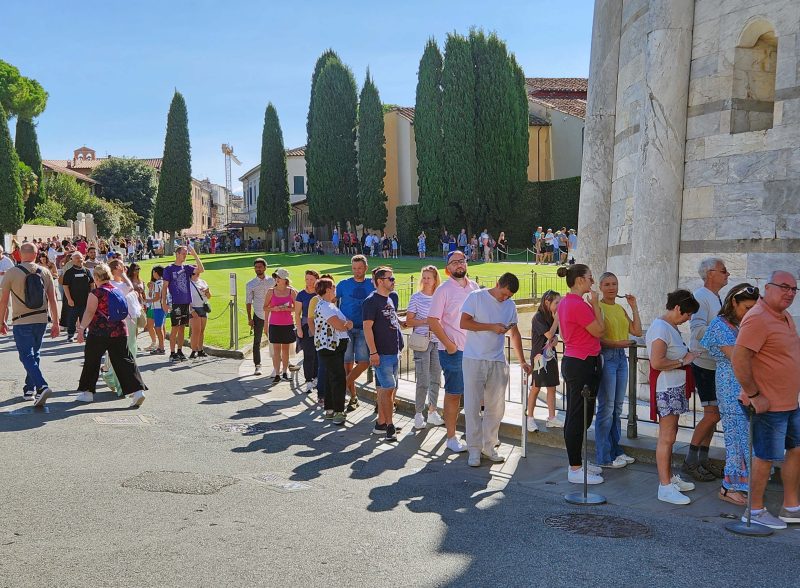
These people made it to the top. You don’t get to ring the bells when you arrive.

The fourth building in Cathedral Square is the Campo Santo, or the Holy Field. It is a rectangular building with a grassy quadrangle in its center. The Holy Field, a cemetery, includes a shipload of soil (about 600 cubic feet) from Golgotha, the site of Jesus’ crucifixion. Legend says that bodies buried in the Holy Field rot in 24 hours. This cemetery is still in use today, but only popes, bishops, cardinals, priests, and VIPs (i.e., nobles and rich people) may be buried here.
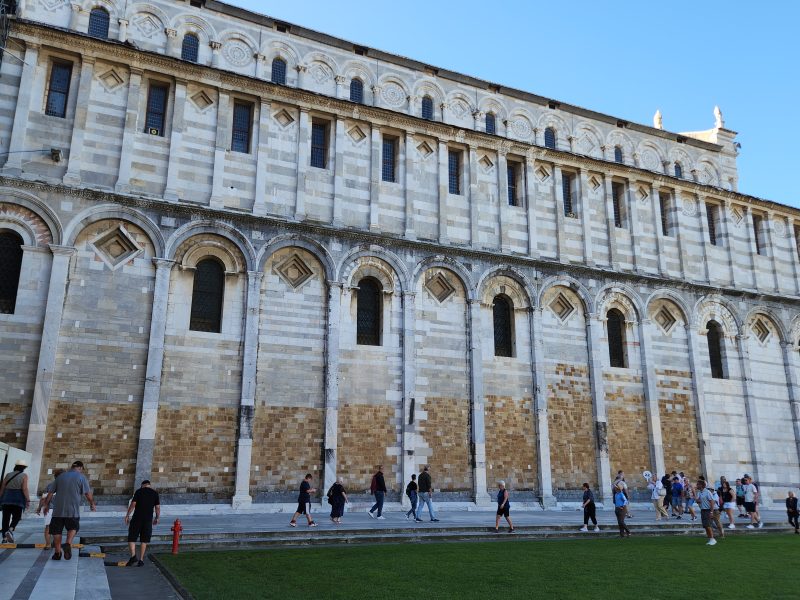
When we returned from Pisa, Ted and I had time to walk around Livorno (our port of call) for a little while. We saw the Old Fortress of Livorno in which (according to the sign) the ceremony proclaiming Livorno a city took place in 1606.

This sculpture is called the Quattro Mori (the Four Moors). The statue at the top of the pedestal is Ferdinando I de’Medici, the Grand Duke of Tuscany. Ferdinano I’s father created the Order of Knighthood of St. Stephen to protect the Tuscan seas. Ferdinando I strengthened the fleet and defeated the pirates, known as “mori.” This sculpture celebrates the victories of the Knights over the pirates on the Barbary Coast in 1607 and over the Turkish fleet in 1608.
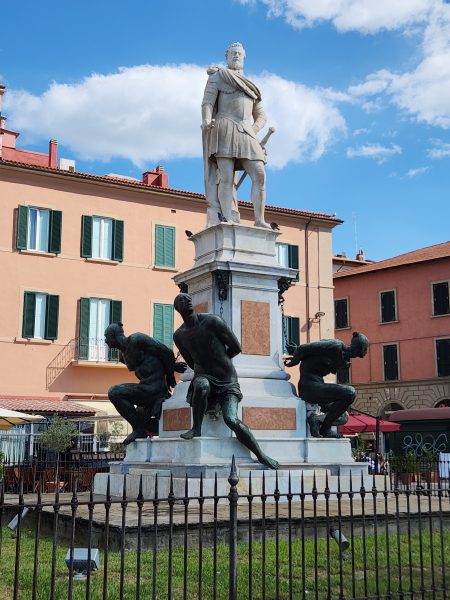
There is a plaque near this sculpture that says it is possible to see the noses of all four pirates if you stand at a certain place. The place was not identified, but I found it.
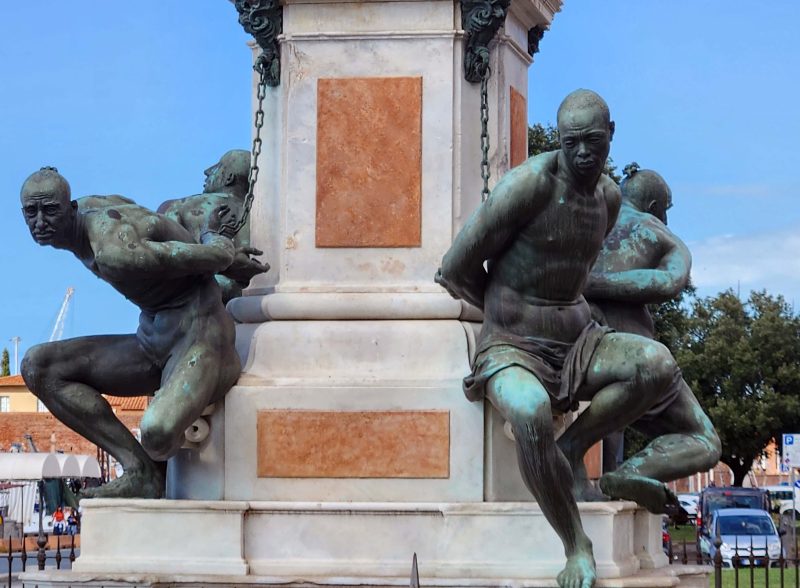
After our walk, Ted and I returned to our ship for dinner and departure to our next destination: Monte Carlo.
Our day in Florence began with a drive through the Tuscan countryside. That sounds so romantic! An hour-long ride on a bus from the port at Livorno to Florence wasn’t especially romantic, but the countryside was certainly beautiful.
Our first stop was at the Accademia Gallery in Florence where we saw the sculpture titled The Abduction of the Sabine Women. This sculpture portrays an incident in the legendary history of Rome. When Rome was a new city, Romulus—its leader—feared that there were not enough women to keep Rome populated and powerful. Residents of the surrounding area were called Sabines. When the Roman men tried to marry the Sabine women, the Sabine men feared losing their power to the Romans and made it illegal for their women to marry the Romans.
Romulus decided to trick the Sabines and scheduled a day of games and festivities. He invited the Sabines to the festival, and they came because they wanted to see the new city. At a signal from Romulus, the Roman men captured the Sabine women and fought off the Sabine men. Romulus’ wife worked to bring an end to the wars between the Romans and the Sabines and, later, Romulus basically decreed the women should accept the way things turned out and marry the Roman men.
This sculpture of that legendary event was created by Giambologna, the official sculptor of the Medici family. Our guide pointed out how different the sculpture looks from each side, and she was right.
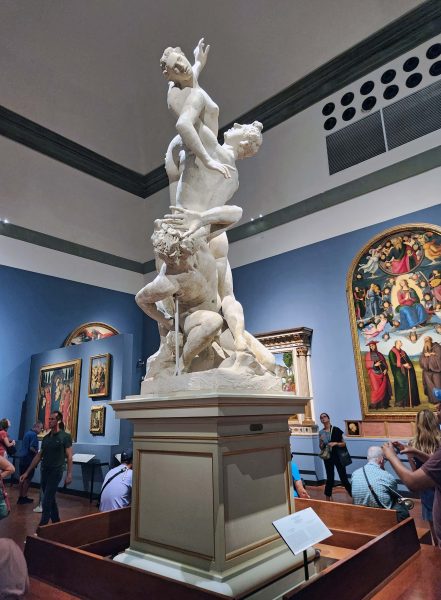
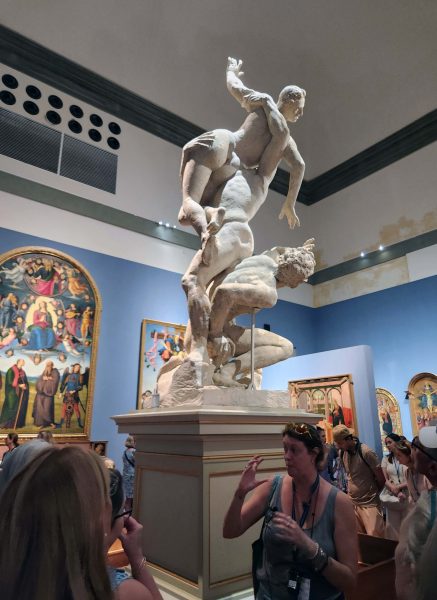
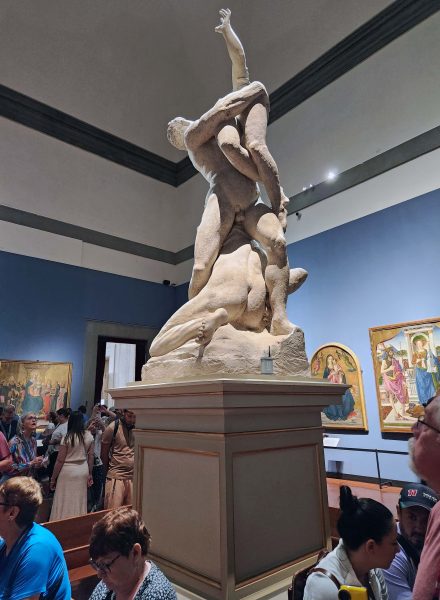
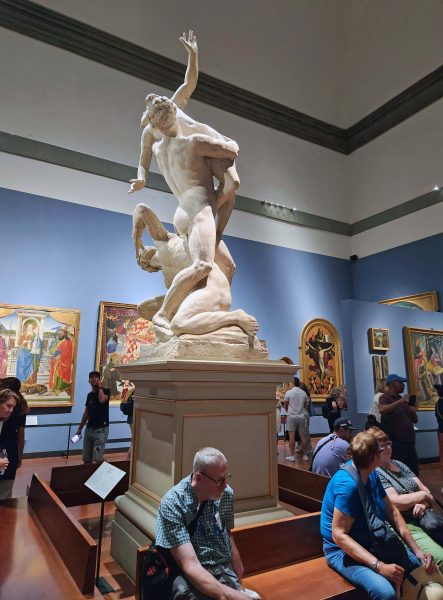
We walked through several more rooms at the Accademia before we came to the prize exhibit: Michelangelo’s David. Before we entered that room, our guide teased us by saying, “Prepare for a WOW.” She was right. WOW!
David is 17 feet tall, weighs more than 12,000 pounds, and is sculpted from a single piece of marble. Michelangelo portrayed David as a very strong man, ready to go into battle and to beat Goliath. His slingshot is over his shoulder, and he holds a rock in his right hand. The veins on his hands and arms are swollen, indicating that he’s flexing them. There’s a hollow at the base of his throat because he’s taking a deep breath. (Take a deep breath and watch the base of your throat in a mirror. You’ll see that hollow appear.) David is standing in a comfortable position with his weight on his right leg and with his left leg flexed, ready for the right moment.
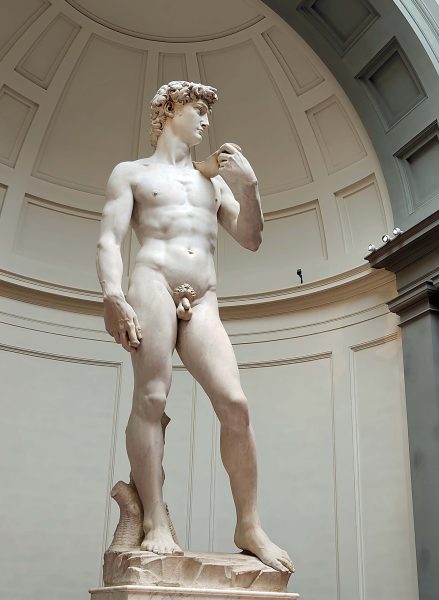
When I saw the Pietà in St. Peter’s Basilica in Rome, my heart broke for Mary because the sculpture evoked such deep pain. It sounds weird, but I could actually feel power emanating from David. How can a sculptor capture such a range of emotions from pieces of rocks??!!
Michelangelo never used models for his sculpture; he studied cadavers and sculpted from that knowledge. Master sculptors begin with clay, then they move up to plaster, and when they are very experienced, they work with marble, which is very expensive. Michelangelo went directly to marble. He sculped the Pietà when he was 23 and he was already the most famous and highest-paid sculptor when, at the age of 26, he created the David. He made David’s head oversized because the sculpture was intended to be placed in a high alcove above the main entrance to the cathedral where a normal-size head would look too small. (Un)fortunately, the sculpture was considered too risqué for the cathedral and was placed in a museum instead.
Before leaving the gallery, our guide showed us a picture of what happened to David during the COVID lockdown.
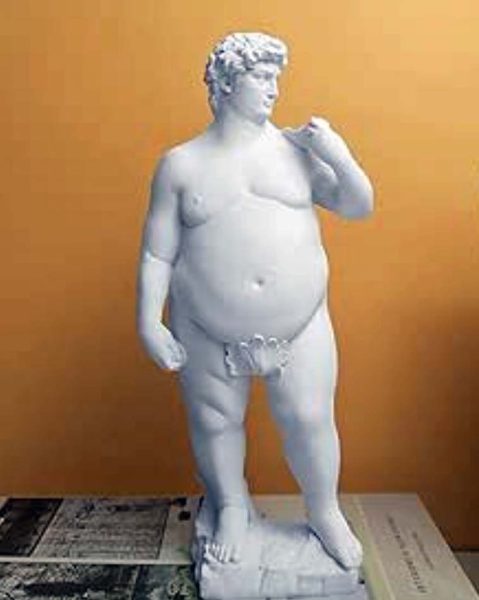
Our next stop was the Old Palace—the Palazzo Vecchio—which has been the government headquarters and the symbol of civil power in Florence since the 7th century and is the most characteristic building in the Piazza della Signoria (Signoria Square). It is still the political focus of the city.
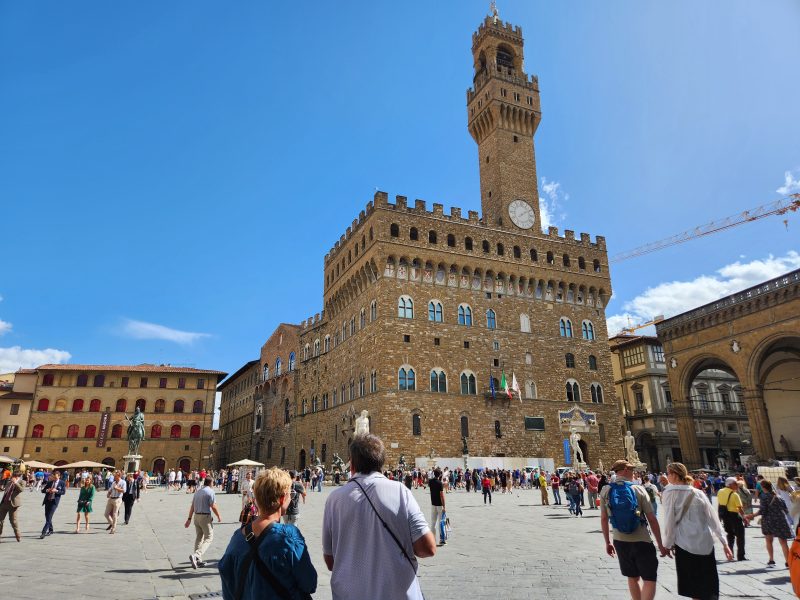
Cosimo I de Medici named himself the Grand Duke of Tuscany, giving Tuscany a total of one Grand Duke. Then he bought the Old Palace and ordered a restructuring and decoration of the building to make it his residence. According to our guide, Cosimo I’s wife thought the Old Palace was too small for their 11 children plus the governmental entities that shared the building, so Cosimo I bought the Pitti Palace across the Arno River for her. It was difficult to guard the self-proclaimed Grand Duke while he walked from building to building. To solve that problem, Cosimo I ordered the construction of the Vasari Corridor as a “secret passage” to connect the Pitti Palace on the north side of the Arno with the government administration offices in the Uffizi (office) Building on the south side of the river. This allowed him to walk from one place to the other without being seen by the public. The Uffizi Building is now the Uffizi Gallery and the Vasari Corridor, pictured below, is now called the Ponte Vecchio (Old Bridge).

On either side of the main entrance to the Palazzo Vecchio is a pair of statues. A replica of Michelangelo’s David is on the left, and a statue of Hercules and Cacus stands on the right. The statues were commissioned by two different rulers of Florence and make a statement about the different political agendas Florence has experienced under each of its rulers. If you look at the picture of the Old Palace above, you can see this doorway with these statues at the front right corner of the building.
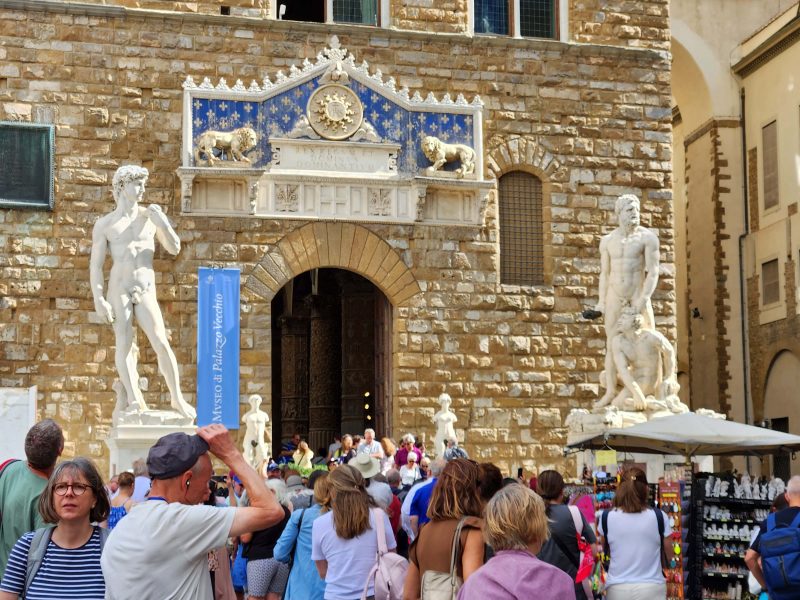
From the Palazzo Vecchio, we walked through the Piazza del Santa Croce and saw the Santa Croce Church.
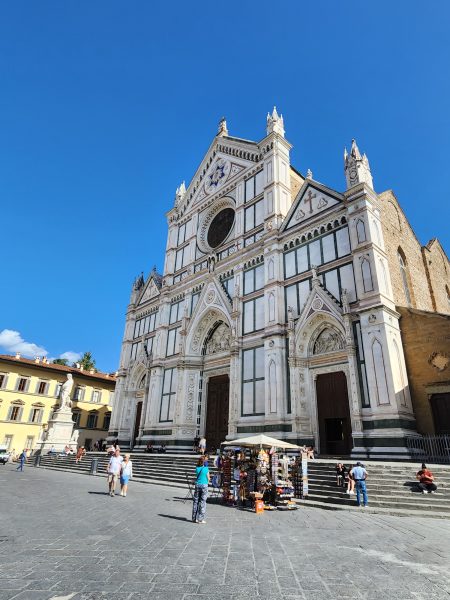
Near the church is a statue of Dante Alighieri, considered to be one of the Western world’s greatest poets. He is most famous for his epic poem The Divine Comedy. You can see the statue of Dante on the left side of the church in the photo above, and a closer view of it below.

Before leaving the site of Dante’s statue, our guide told us to prepare ourselves for another WOW! and walked us across the square to the Basilica de Santa Maria del Fiore (Church of St. Mary of the Flower). Again, WOW! The church is huge! It’s the second-largest church in the world, after St. Peter’s Basilica in Rome. It is one of the most important buildings in Italy and has become the most iconic symbol of Florence because it revolutionized the city of Florence. If you see the domes of the cathedral, you’ll know you’re looking at Florence.
Here’s the north side of the cathedral.

This is the front (west side) of the cathedral. The large alcove directly above the pointed decoration over the center door is the place where the David was supposed to be installed. The other statues across the front of the church at that level are important Italian historical figures, including Michelangelo. The church complex includes the cathedral, the bell tower (on the right in the photo), and the baptistery, which faces the front of the church. I didn’t take a picture of the baptistery, but it’s a very large, hexagonal building decorated like the cathedral.
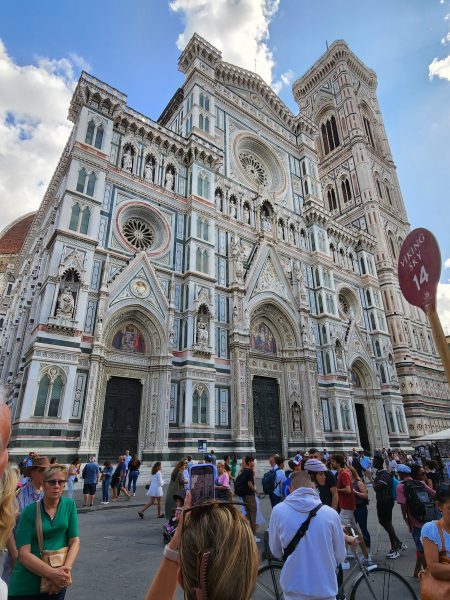
The free-standing bell tower—the Campanile di Giotto (Giotto was the architect)–is at the corner of the front of the church and the south side of the building. If you climb the 414 steps to its top, you’ll see Florence from its highest viewing platform. The view is described as “worth its weight in gold,” although I’m not sure how a view can have weight. You get the idea.
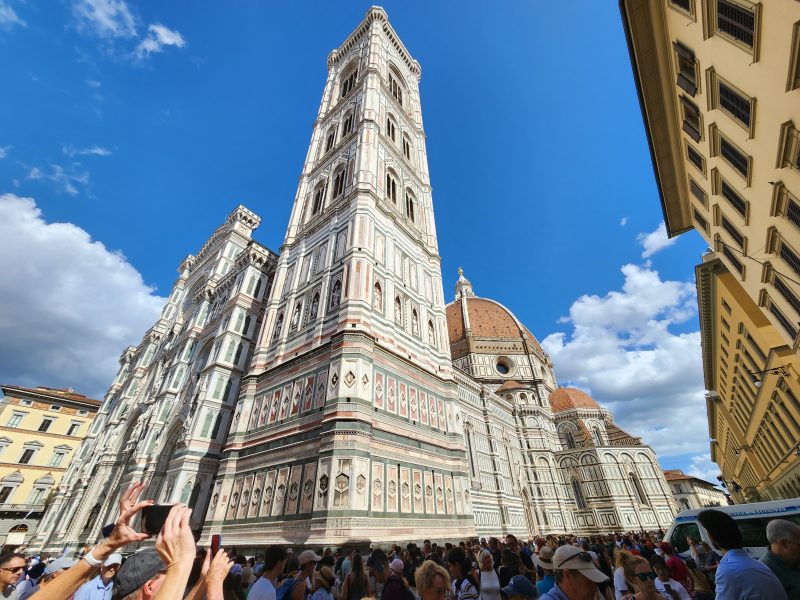
The entire cathedral is faced with three colors of marble—white, pink, and green. The colors are not representative of the Italian flag. The cathedral was completed in 1296; Italy’s current flag was adopted in 1946.

At this point, our guide left us to explore this historic area on our own. We saw this fountain with Neptune in the center. The sculptor fashioned Neptune’s features after Cosimo I in honor of Cosimo’s victory over Pisa, giving Florence access to the Mediterranean for trade.

The Chiasso d’Baroncelli is a back street that connects two buildings that are part of a quadrangle. It’s near the Uffizi Gallery.
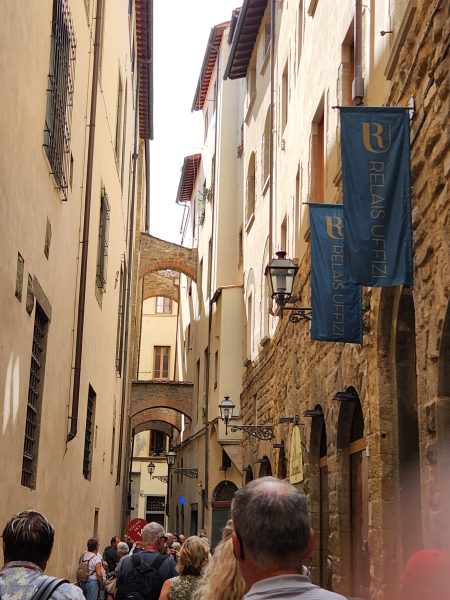
The Arcone Triumphal Arch is in the ancient heart of Florence, where artists and intellectuals gathered in the early 1900s. It was originally the site of Florence’s forum.
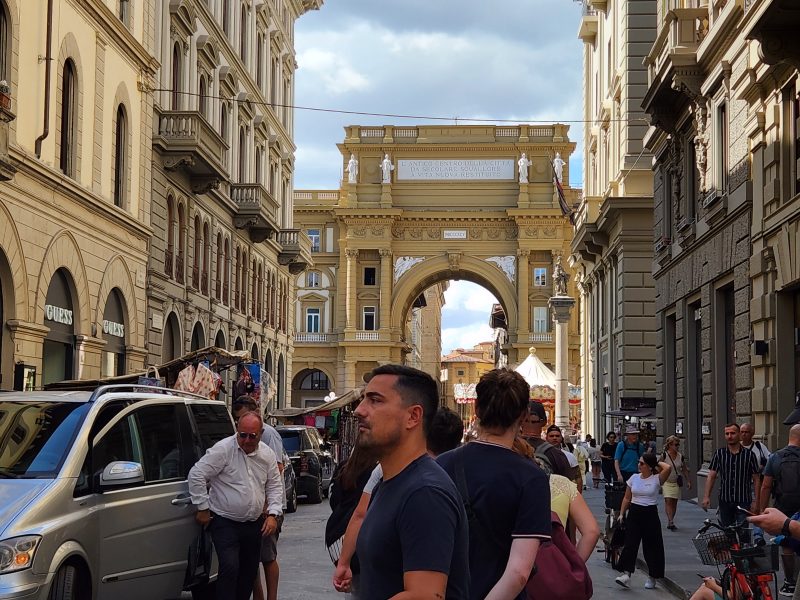
As we walked around the many piazzas in the area, we saw and heard two opera singers. This is one of them. I’m sure we’ve all seen guitar players, as well as other musicians and singers with some item on the ground to collect contributions in tourist-crowded areas, but I’ve never heard an opera singer outside of Italy—and we heard two within a few blocks of each other!
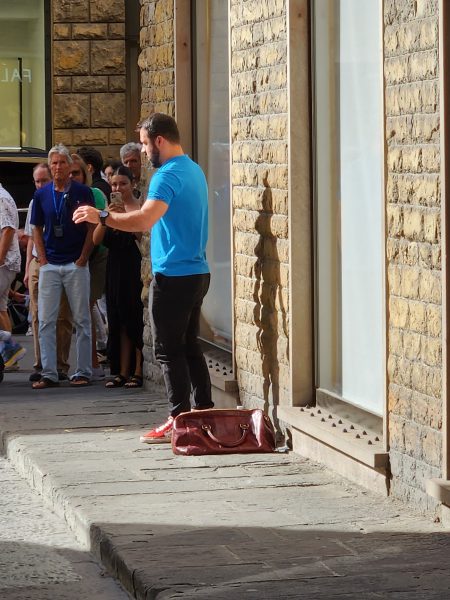
This figure on the Uffize Gallery is called “I passi d’oro”—”The Golden Strides.” In May 1993, Florence was struck by a Sicilian mafia (Cosa Nostra) attack that severely damaged several buildings including the Uffizi Gallery, killed five people, and injured 48 others. The attack was retribution for the trial and life imprisonment of a mafia boss. Similar attacks occurred in Milan and in Rome. On the 20th anniversary of the attack, the Uffizi Gallery commissioned this sculpture to portray hope and life after the tragic event. The six-foot statue of bronze, covered in gold leaf, depicts a striding figure on a blade of stone. The large figure is carrying five small figures (you can’t see all five from my angle) representing each of the five victims of the attack.
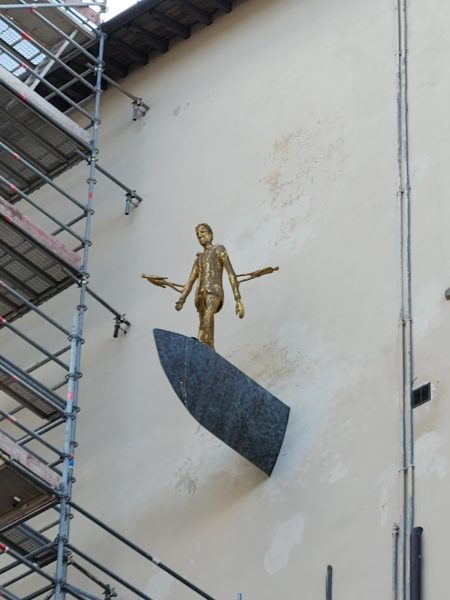
The “Albero della Pace,” or “Tree of Peace,” also commemorates the 1993 Mafia attack. It represents an olive tree with its roots clearly visible—a symbol of the close connection between the past and the present. It replaces a 100-year-old olive tree that was originally placed at this site but did not grow well. Like “The Golden Strides” and the original olive tree, its purpose is to pursue the ideals of love and hope.
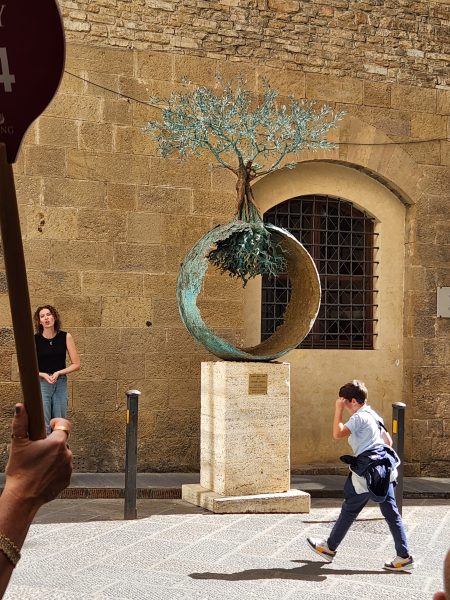
Before heading back to our group meeting place, Ted and I spent some time walking along the Arno River.

Tuscany is famous for its dramatic light, and there are actually destination sites for viewing the Tuscan sunsets. The sun set as we drove from Florence back to our ship in Livorno, and I’m sure our bus was not a prime sunset viewing spot. Still, even through the bus window, the sunset was the most magical one I’ve ever seen—everything turned gold, including the air and the light. I had to take this picture from the moving bus, but I wanted to remember that Tuscan gold sunset. The Tuscan sun is a real thing, not just a movie title.

In addition to its sunsets, Tuscany is famous for the Vespa scooter—a simple, practical vehicle that can be seen all over Italy. It became the first globally successful scooter after Gregory Peck and Audrey Hepburn rode a Vespa around Rome in the movie Roman Holiday.
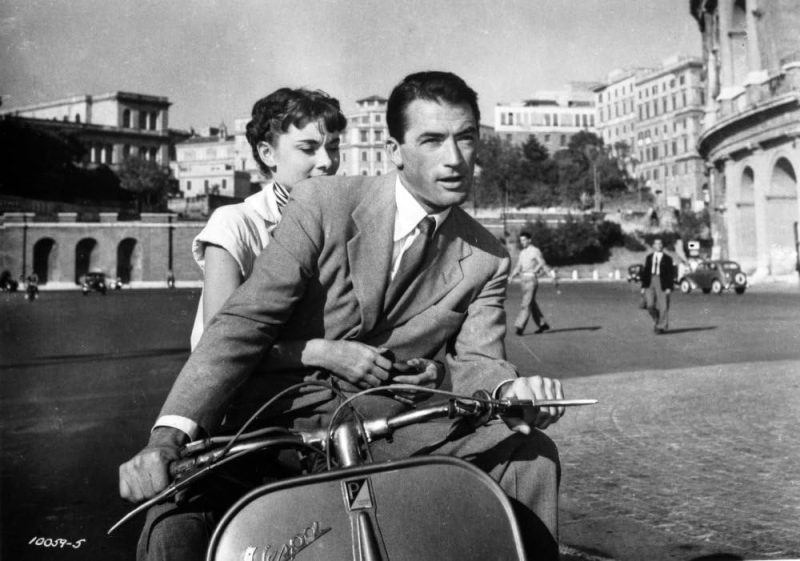
A bit of Italian trivia
How do you get out of a parking space in Florence? First drive forward and bump the car ahead of you; then bump the car behind you; and then pull out into the street. Ted and I actually saw cars parallel parked within two inches of the adjacent cars, so this advice might be true.
The Italian alphabet has no j or k, so our guide’s name was Giullia, not Julia. Ch changes the c sound to a k as in chianti and Pinocchio.
Guillia taught us Italian hand gestures for ordering beverages:
Today, our port destination was Rome. Ted and I decided to take the day off and to stay onboard the ship. We made that decision after some discussion, not because we didn’t want to see Rome but because, when we spent five days in Rome in 2019, we had such outstanding private tours of the Eternal City that we knew today’s scheduled tours would be disappointing.
Our hours-long 2019 tours included only the two of us and an extremely knowledgeable guide who shared in-depth and interesting information about the Coliseum and the Forum (the best tour we have ever had anywhere); St. Peter’s Basilica and the Sistine Chapel; and the Vatican museums. We also had a city tour drive that stopped at lesser-known sites such as the Pantheon, the Capital Hill complex designed by Michelangelo, and St. Mary’s Basilica, which is decorated with paintings by Michelangelo. (Can you even imagine attending church every week, surrounded by Michelangelo’s work?) Our hotel was a short walk from the Spanish Steps and the Trevi Fountain, so we visited those sites daily, just because we could.
Viking offered excursions to the most popular sites—all of which we visited in 2019. With only one day in Rome, a Viking excursion would have allowed us to visit only one site for about three hours, spending most of the allotted time on our own after hearing an overview from a local guide. We decided we didn’t want to spend the day talking about how much better our 2019 visit to Rome had been.
Instead, we enjoyed sleeping later than usual and then relaxing in the Winter Garden with coffee and hot chocolate. After lunch, we used the free laundry (there’s a free laundry on every passenger deck) to provide us with enough clean clothes to last until we get home. There was no line for the washers and dryers because most passengers had—not surprisingly–chosen to go into Rome.
Casting off is entertainment for a lot of people, so Ted and I were sitting on our veranda to watch the port area recede into the distance when a flock of seagulls surrounded our ship. While we were sitting there, one of the gulls flew parallel to our ship and just a few feet away from our veranda for nearly a full minute before the ship picked up enough speed to outpace it. It was kind of neat to move forward with a bird at our sides.
We had nothing important to do immediately after dinner, so we counted the offerings on the ship’s buffet, then ended the day by going to the pool deck to watch Roman Holiday under the stars. The entire day and evening were a nice change of pace from walking up and down hills and absorbing new information every day.
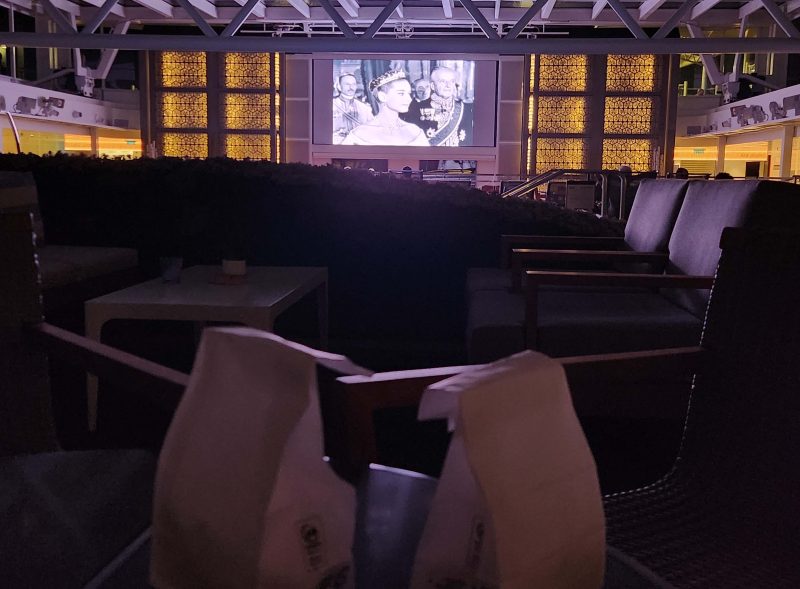
We did it! There’s a 35-pound limit for carry-on airline luggage and a 50-pound limit for checked bags. Ted’s and my goal for smart packing has been the 35-pound mark for our suitcases. Success came when we packed for our 2023 BT. According to our luggage scale, our carry-on suitcases weighed 33 pounds each and our backpacks weighed 13 pounds each—for a seven-week trip. Yea for us! We mentally smirked a little bit and figuratively patted ourselves on our backs every time we saw other people traveling with 25- and 30-inch suitcases, plus their carry-on suitcases and their personal items/backpacks. They reminded us of our first cruise when we overpacked like that.
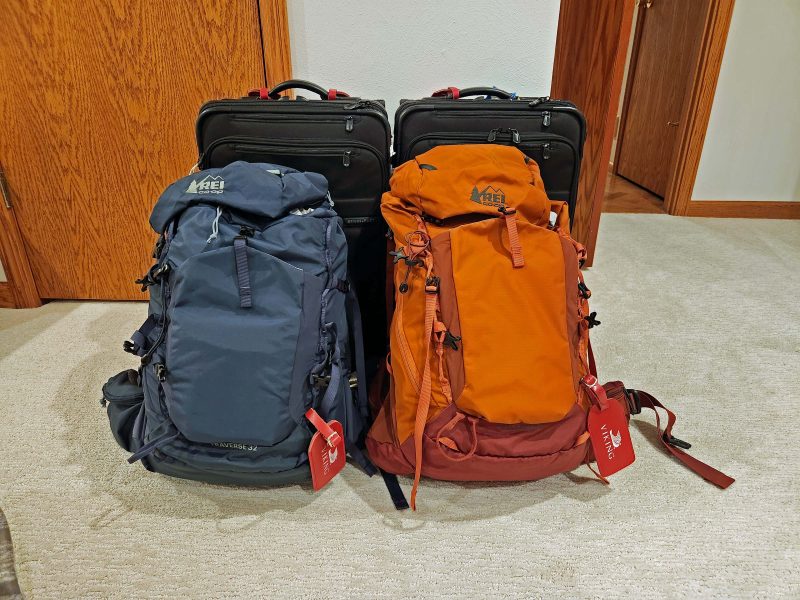
When Ted and I travel, we always put all our essential items in our backpacks, including three days’ worth of clean clothes, in case of lost luggage. At least that gives us what we really need, with enough clothes to wear while we wash the dirty things and wait for our luggage to arrive.
We checked our suitcases for the 2023 BT, even though they were carry-on size. We’ve learned from experience that it’s very inconvenient to keep them at our sides during hours-long layovers. We’ve walked up to six miles within an airport, getting to and from the gates and killing time during the layover. Our overseas flights have kept us on the go for 25-36 hours, depending on the destination, the length of the layover, and the time until we can check into our hotel room. (Example: arriving in the morning and having to wait until 3:00 p.m. for the room.) Checked baggage is definitely the way to go for long trips.
Travel news feeds this year have repeatedly reported travelers waiting for days/weeks for their luggage to arrive. I tried all summer to buy air tags for our luggage, but they were out of stock until a week before we left. Luckily, they arrived in time for the 2023 BT. With that precaution tucked into our suitcases, we had eight uneventful flights, no lengthy delays, no cancelled flights, and no lost luggage. I guess we would have been fine without the air tags, but an ounce of prevention, . . . Anyway, we had more than enough issues with other things.
On the third of our eight flights, either the Tel Aviv (departure) or the Cairo (arrival) airport damaged my lifetime guaranteed suitcase by ripping off one end of the top handle and losing my luggage ID tags as well.
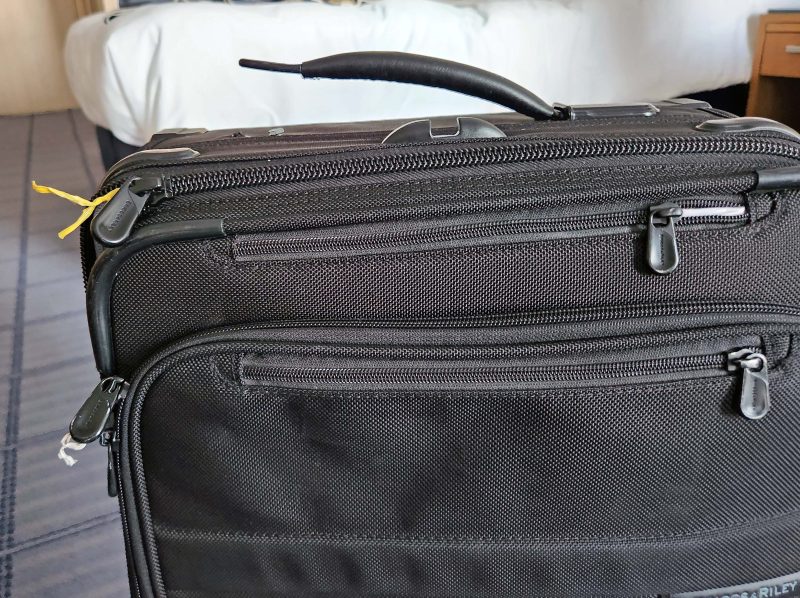
The baggage handlers actually stripped the bolt/nut attachment out of the suitcase’s hard frame! After that, every time I checked the suitcase, the agent had to slap a “damaged” sticker on it to prove it wasn’t that airline’s fault. Anyone who needed to lift my suitcase (me, porters, baggage handlers, stewards, valets, etc.) had to hunt for the semi-concealed handle along the long side of the suitcase.
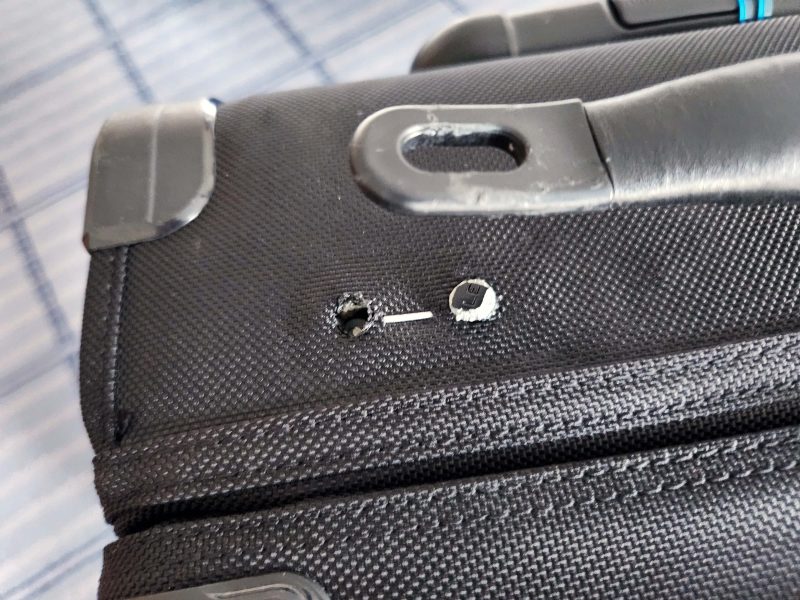
After we were back home, the broken handle was an easy problem to fix because the suitcase is guaranteed for life with no questions asked, and there was a Briggs & Riley repair shop within 20 minutes of our house. I brought the suitcase in, pointed out the broken handle and, sure enough, there were no questions asked. The guy just said, “If we have the handle in stock, it will be ready in two days; otherwise, it will be about a week.” I had it back in 2 days. Thank you, Briggs & Riley.
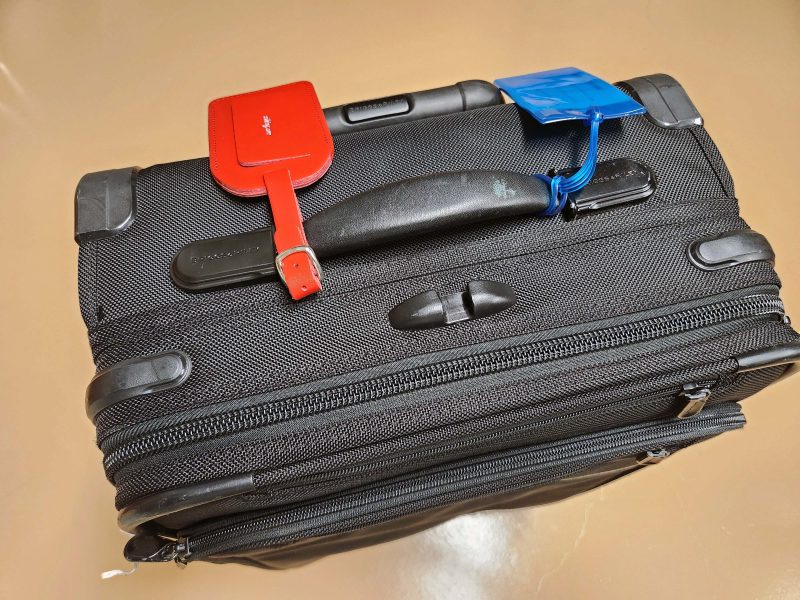
The next item to suffer damage was my RFID-blocking Travelon purse which is pickpocket and purse-snatcher proof with steel cables in the strap, a lock on every zipper, and fabric that defies cuts and tears. Apparently, the thread used to stitch the purse together is less durable.
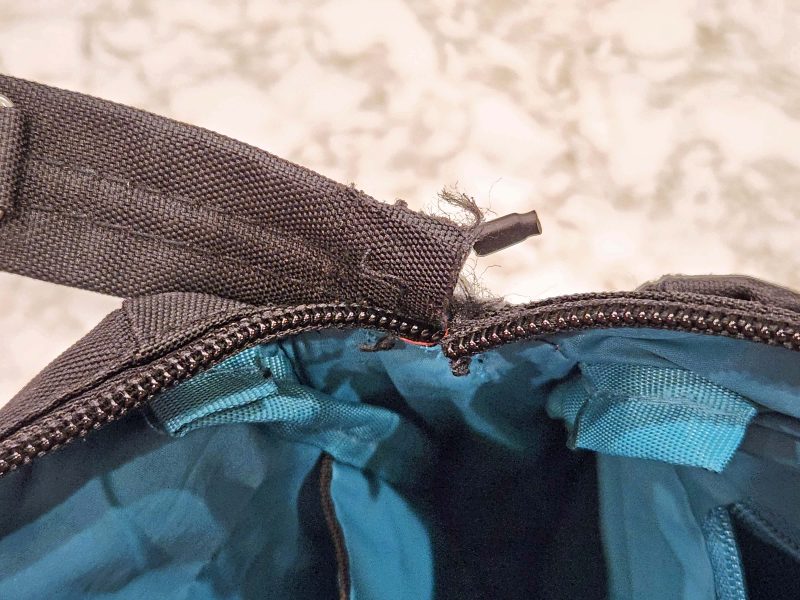
Luckily, I always bring a handful of safety pins with me when I travel, and I managed to pin the handle on so that I could continue using the purse to keep a bottle of water, my passport, phone, sunglasses, etc. with me for our onshore excursions.
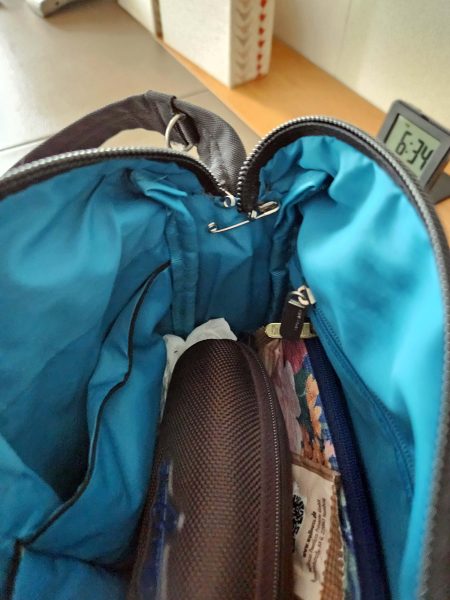
The glitches continued. We had to show our passports so many times (especially in Israel and Egypt) that constantly sliding them out and in wore out the edges of our RFID passport holders, causing the sides to tear. An airport agent gave me some tape to hold my passport sleeve together. You can tell the tape is intended to identify some kind of baggage.
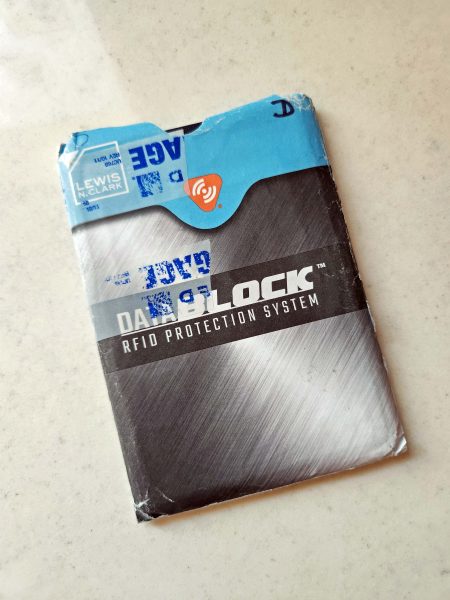
On the positive side, our passports include three more stamps: Egypt, Türkiye, and Spain.
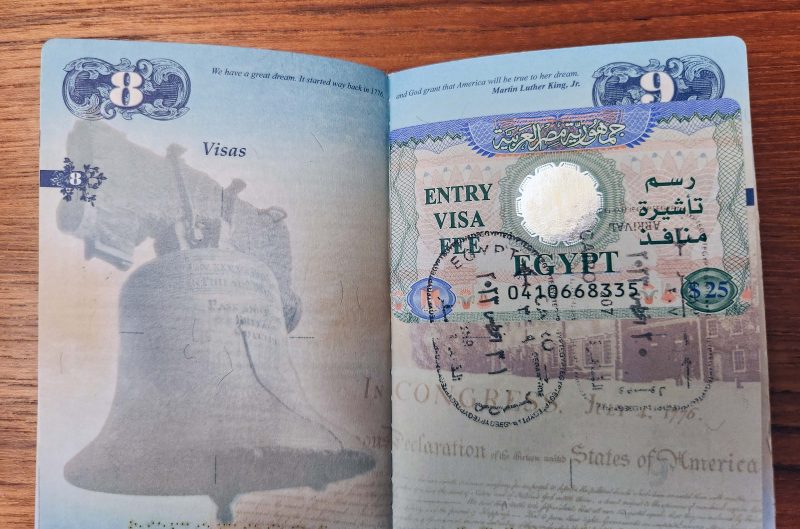

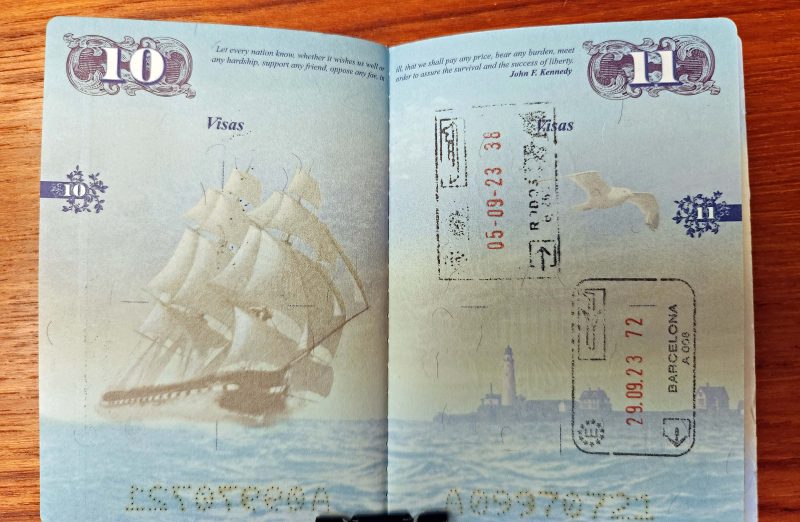
Long airport walks and layovers are easier with a hip belt backpack. It rests the weight of the pack on your hipbones and eliminates all that strain on your shoulders and your back while you tote it around all day. We knew we’d have eight flights on the 2023 BT, so Ted and I bought hip belt backpacks earlier in the year. (Thanks, Kari, for mentioning that after receiving a hip belt backpack as a gift from Thom and Katie.)
On our way home, we had a problem with our new backpacks. The Barcelona airport security scanner managed to pull a clip off our backpacks when we arrived. Unbelievable! We lost the same clip at the same time on both backpacks. Coincidence or evil plot? You decide.
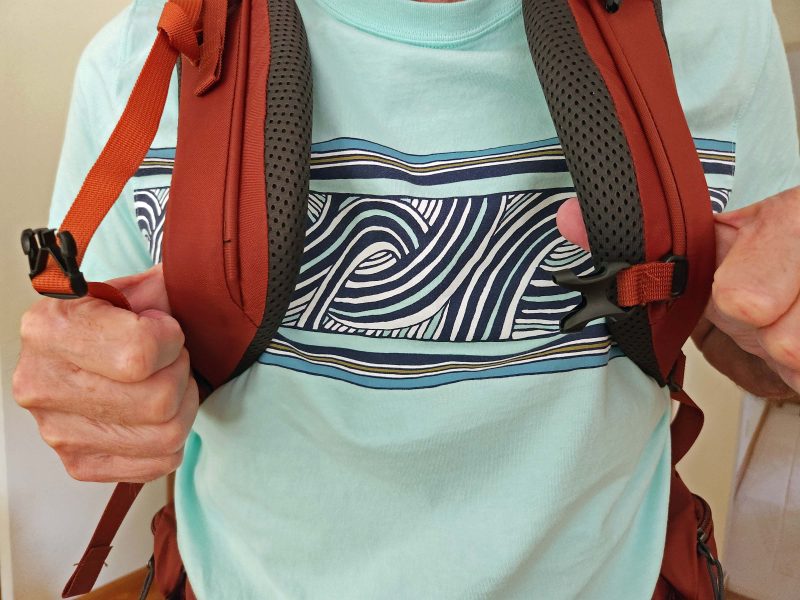
The backpacks are new to us (first-time use) and have a lot of straps. Thinking we might have simply forgotten which strap went where, we spent some time looking for the correct pieces to fasten the chest strap but couldn’t find them.
A few days after we got home, we took the backpacks to REI, hoping they could show us how to attach the chest strap in case we’d just forgotten. The salesman knew immediately that the clip had been pulled off. His reaction was a calm “That happens—they’re only clipped on.” In my opinion, if “that happens,” it might be time for a design change in how the clip is attached to the backpack. REI is a good company, though, and since the backpacks were less than a year old, they simply replaced them for us at no cost. Thanks, REI.
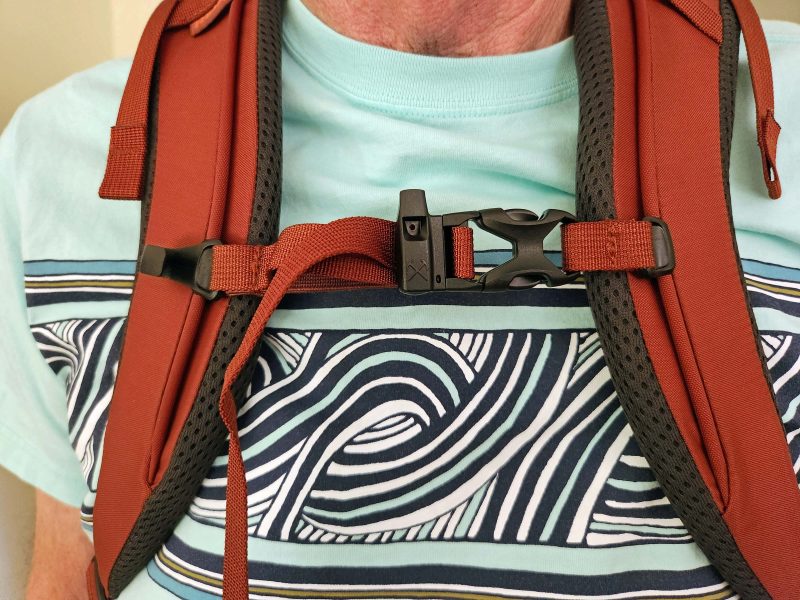
Viking has a very efficient luggage system. Before we leave home, after a pre-cruise extension (four days in Israel this time), before a post-cruise extension (four days in Switzerland in 2019), or before we disembark to go directly home (from Barcelona this time), luggage tags are delivered to us. The tags have our identification information printed on them, and they are color-coded to match our destination and the bus we are assigned to. There are at least ten color codes, then as many group numbers for that color as needed. The tag colors and numbers are assigned by airport, airline, and departure time.
When it’s time to turn our luggage over to the Viking porters, directions for time, transfer bus number, etc. are given by color and group number. Let’s say we have red tags with the number 4 on them. We attach the tags and set our suitcases outside our stateroom door at a designated time before departure and, almost immediately, the deck stewards take them to a collection area. All luggage tagged Red 4 goes to the same place and is delivered to the same bus. Before the luggage is loaded on the bus filled with Red 4 passengers and before we board the bus, we identify our luggage to be sure we and our luggage will be on the same bus. Upon arrival at the ship or at a hotel, the luggage is removed from the bus, we identify our own as soon as we get off the bus, and our luggage is placed in our stateroom or hotel room. At an airport, it’s set beside the bus for us to take inside. It’s a very smooth and orderly procedure.
When all 980 passengers are leaving the ship at the end of a cruise, as we did in Barcelona, there is a lot of luggage to tag, move, and sort. Here’s a photo of roughly one-half of the luggage in the storage/warehouse where our luggage was placed prior to us boarding our bus to the airport. You can see how the bags are arranged by color and number codes for easy identification and delivery.
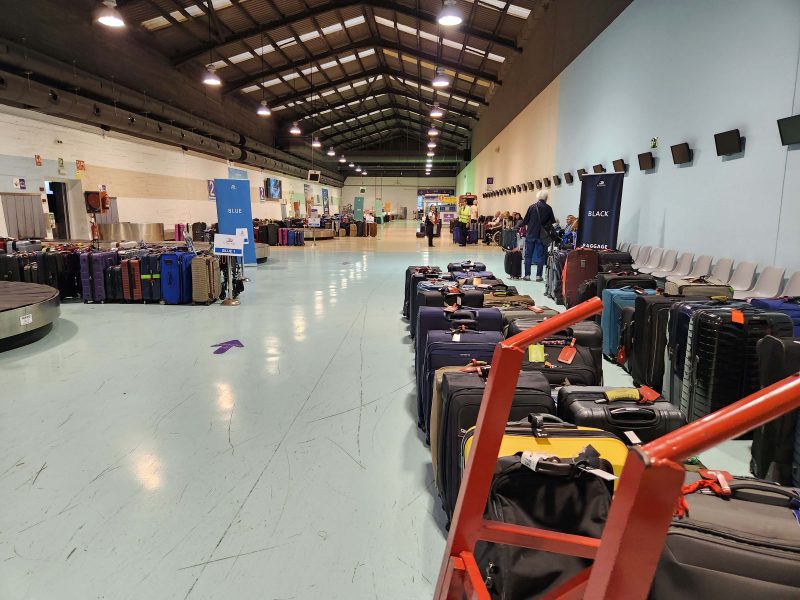
To find and identify our bags among those of the other 978 passengers, Ted and I simply matched our tag color and number to the sign with the same color and number.
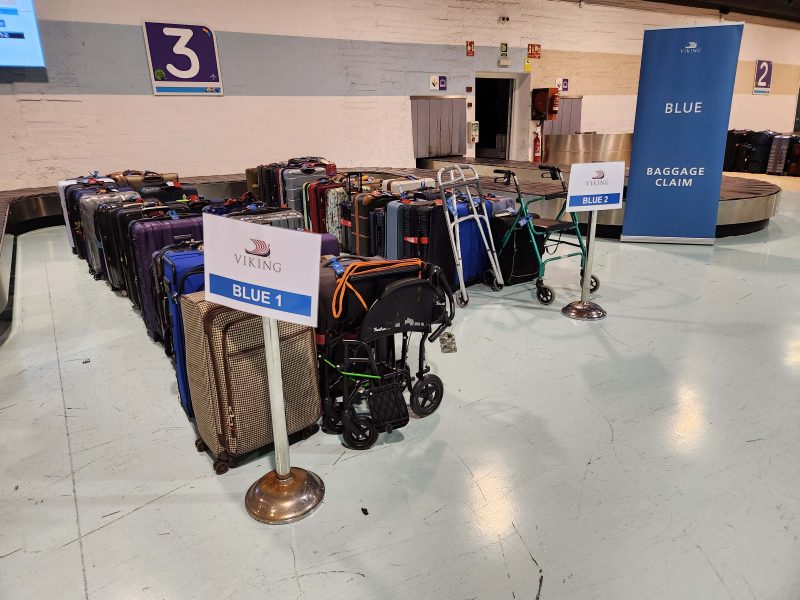
I’ve lost count of how many times Viking has transferred our luggage since our first cruise with them in 2015, and they have never misplaced any of our bags. They did, however, make a typo on our luggage tags this time.
We scheduled two back-to-back cruises (Nile River and Mediterranean) that, naturally, embarked on two different dates. The luggage tags sent to our home before we left indicated that both departures were scheduled for the same date. When we arrived in Luxor for the first cruise, we showed the tags to a Guest Services staff member and she promptly verified that all was well for our second cruise two weeks later. She was less concerned about the typo on the tags than we were, so this was a very minor glitch.
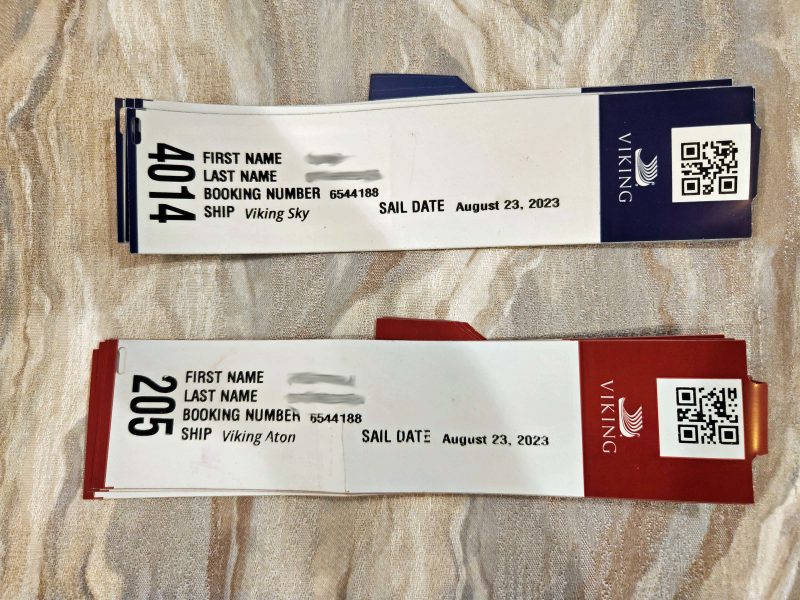
We always have travel stories to tell, but we’ve never had so many glitches on a single trip. None of them interfered with the fun we had our 2023 BT, and all of them were easily resolved, so we’ll keep traveling.
Like the Great Pyramids, the Great Sphinx, the Parthenon, Venice, Florence, and Pisa, Pompeii was one of the Big Deals for me on this trip. It was exciting just to drive past Mt. Vesuvius on our way to Pompeii. This is the only volcano on Europe’s mainland that has erupted within the last 100 years. It is considered to be one of the most dangerous volcanoes in the world because 3,000,000 people live close enough to be affected by it; 600,000 people live in the “danger zone,” making it the most populated volcanic region in the world.

Pompeii was the Beverly Hills or the Monte Carlo of the first century. Extremely wealthy people made Pompeii their playground for gambling, games in the forum, the theater, the baths, and—let’s say “the pleasures of the flesh.” These wealthy people had 180 days off every year and didn’t work after 11:00 a.m. during the rest of the year. It was truly a city of pleasure where slaves did all the work.
Educated and skilled slaves were very valuable and could cost $2 million in today’s money. These slaves might have been Greeks who could teach Latin, mathematics, philosophy, etc. or skilled blacksmiths, carpenters, tailors, and the like. Because they were so expensive, they were well cared for—an investment to be protected. Some people who were educated or skilled volunteered to become slaves because, after a certain number of years, they were given their freedom as well as enough money to begin their own careers.
Our bus dropped us off on the street and, without a traffic light, we crossed a multi-lane busy street to this wide sidewalk. Our guide told us there are hand signals between drivers and pedestrians. (Of course there are hand signals—this is Italy, the country famous for hand gestures while speaking.) The driver might briefly put a hand over his eyes to say “I don’t see you, so I’m not stopping.” In response, a pedestrian might point a finger at his/her chest, then two fingers at his/her eyes, and then a finger at the driver to say, “I see you and I know you see me, so I’m crossing the street here.” Our guide added that the only way to get across a street here was to “cross with confidence,” so we did, and it worked. When we confidently stepped into the street, the traffic stopped for us. I like the decorative sidewalk. It’s a very wide sidewalk because it leads to the entrance to Pompeii, and lots of tourists visit the site.
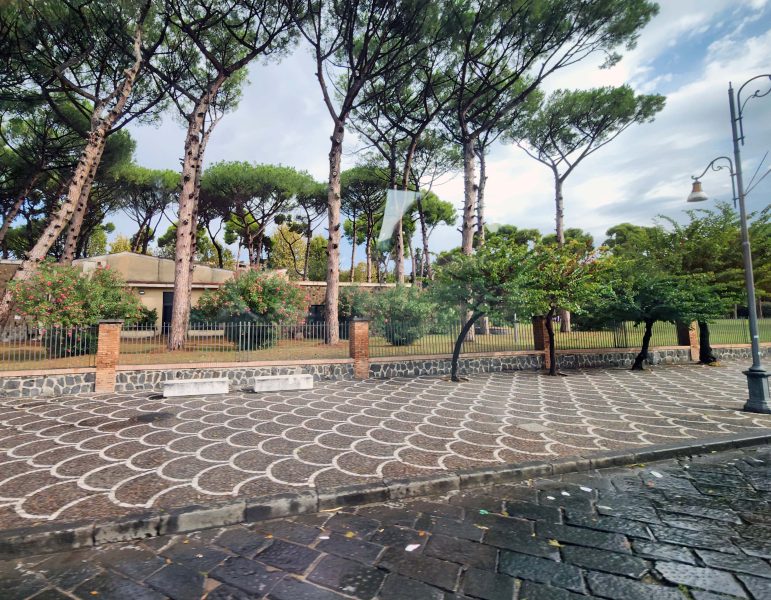
The first thing we saw when we entered Pompeii was the Quadriportico of the Theater where people could mingle before the performance started. The upper seats of the Theater can be seen in the center background. After the 79 AD eruption of Mt. Vesuvius, the ashes covering this quadrangle were 19-23 feet deep.

This was the main street of Pompeii. Look at all those tourists!
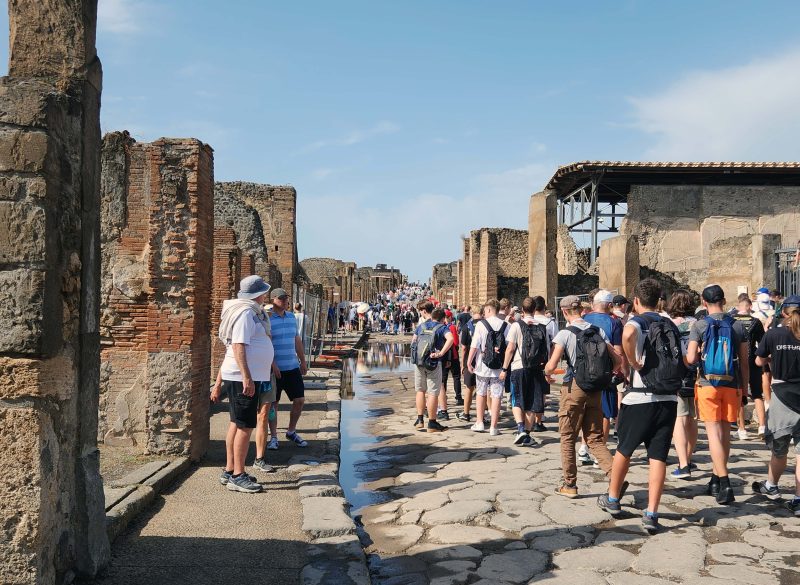
The streets of Pompeii slanted downward from the center to drain the water into the aqueducts. This also removed waste from the streets. The large rocks crossing the street are stepping stones so that pedestrians could avoid stepping in puddles when they crossed the street after a rain. The stepping stones were strategically placed to allow cartwheels to pass between them, and so many carts used the streets that “cart tracks” are worn into the stones. To this day, the distance between those cart wheels is the standard for trains in Europe.
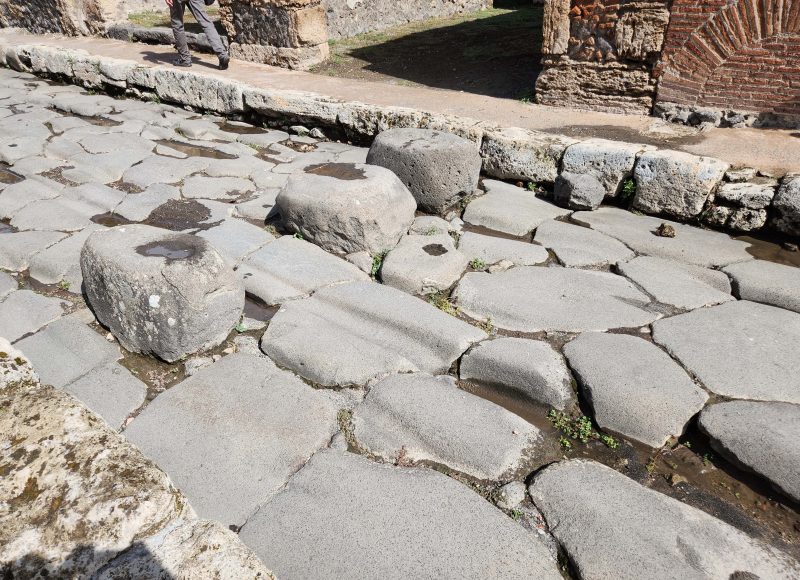
Here’s Ted, trying out the stepping stones and keeping his shoes dry. (There were morning rain showers in this area.)
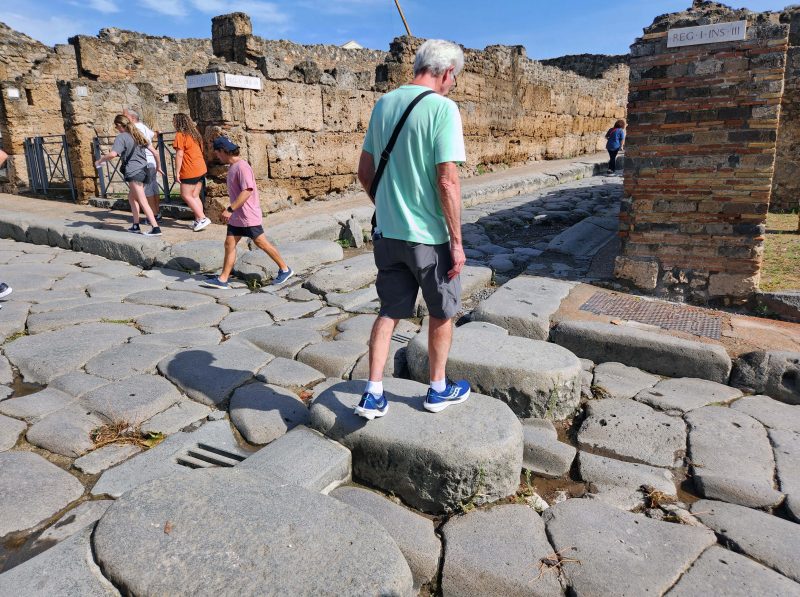
The Romans were so clever that, before street lighting, they placed small white pebbles among the rocks on the roads. The white rocks reflected light at night and helped people stay on the road after drinking and gambling into the wee hours.
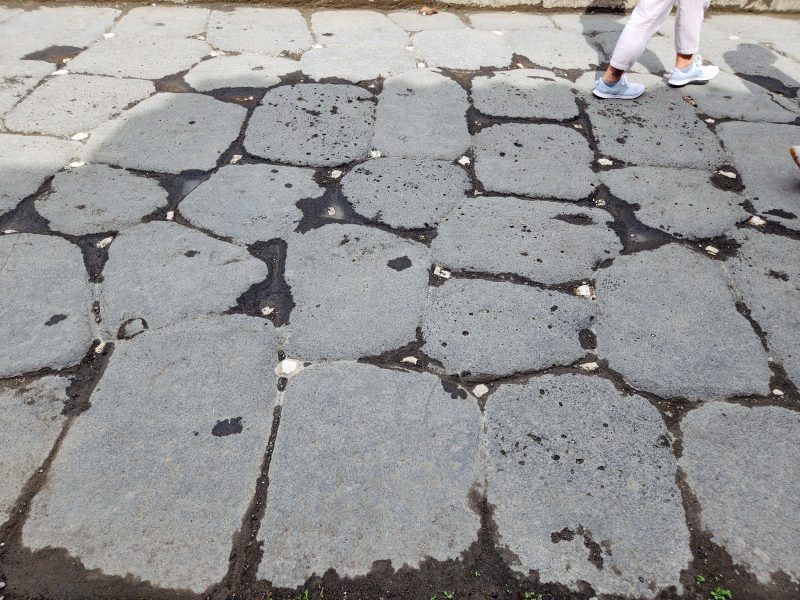
Pompeii was a Roman colony in the first century, so it had an aqueduct system that supplied water, removed waste, and filled fountains and baths. This is one of 40 drinking fountains in Pompeii that has been restored and delivers free water through pipelines from nearby towers. Drinking fountains like this would have been on a commercial street.
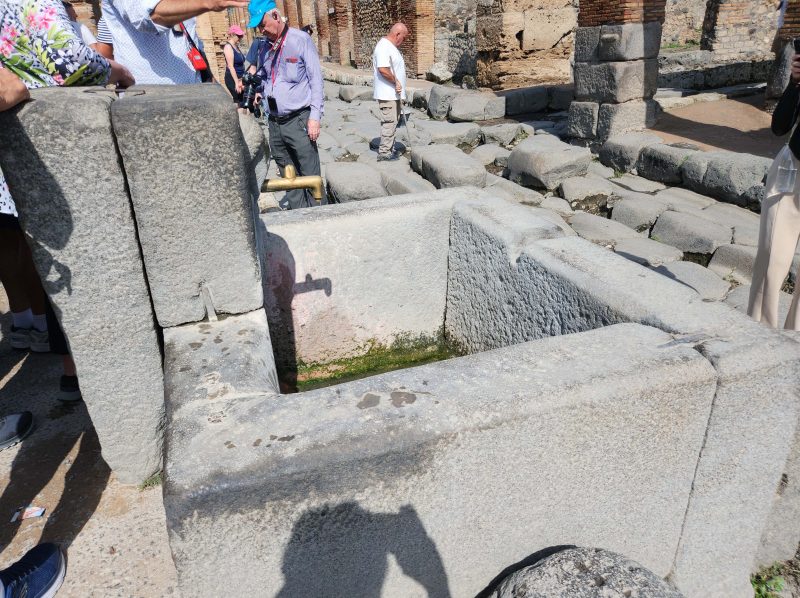
This was the commercial district that included the fountain in the photo above. It looks like the big box store area. Do you think they had a first century Target?

Shops can be identified in the ruins because they had slots in the doorway stones where sliding doors operated. The sign says “Domus Cornelia” (House of the Cornelii). This was one of the buildings that had a fountain in its atrium.
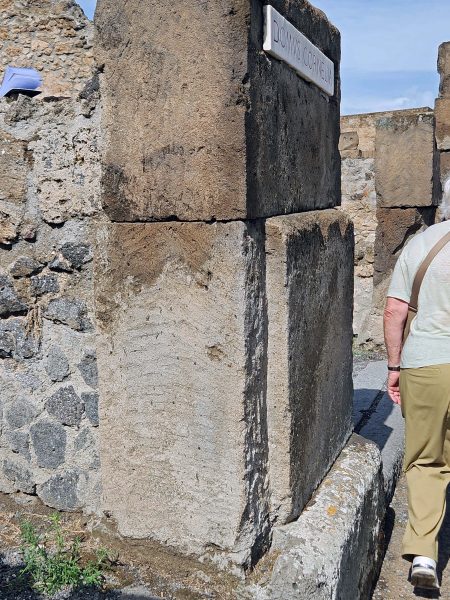
This was a residential street in the city.
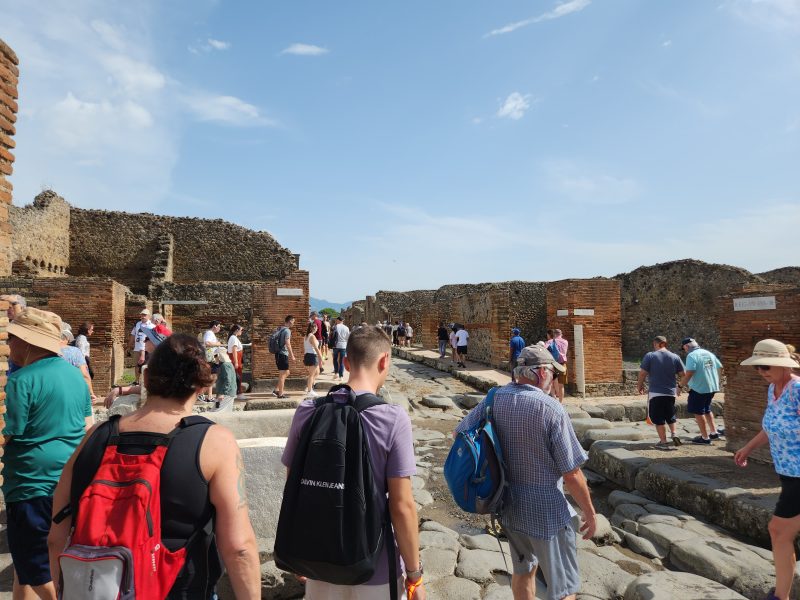
Pillars like this one on street corners identified streets and buildings on those streets. This pillar has an icon showing two men carrying what is probably a container of olive oil on a pole, indicating that delivery persons lived on this street. The sign also provides the information “REG-VII-INS-IV” which indicates that it is Region 7 (REG for “regio,” a section of the city), and apartment/house (INS for “insula”) number 4 (IV). So it means Region 7, Apt. 4 on the delivery workers’ street. Postmen or visitors could find the appropriate sign, then shout down the street for the person they wanted to see (no doorbells or knockers).
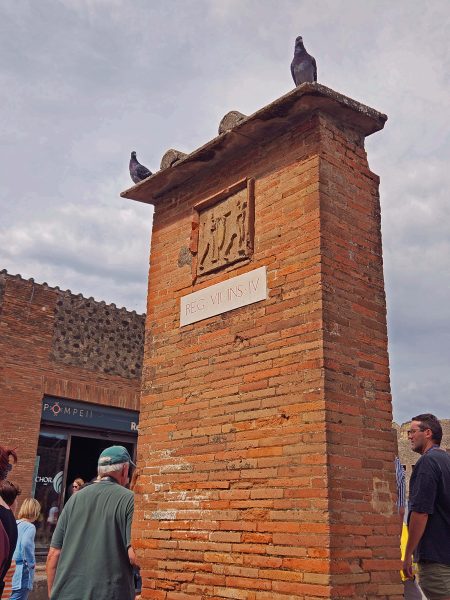
The theater provided popular entertainment. This large theater was for wealthy people, and originally seated about 5,000 spectators. Powerful, rich men sat in the lower front seats; less powerful and less rich men sat in the middle rows; women and children sat in the uppermost rows. (I’ll keep my feminist thoughts to myself here.) Greek theater focused on tragedies, but the Romans liked entertainment (especially in Sin City/Pompeii), so their plays included gladiators, ferocious animals, executions, etc. (Executions are entertainment??)
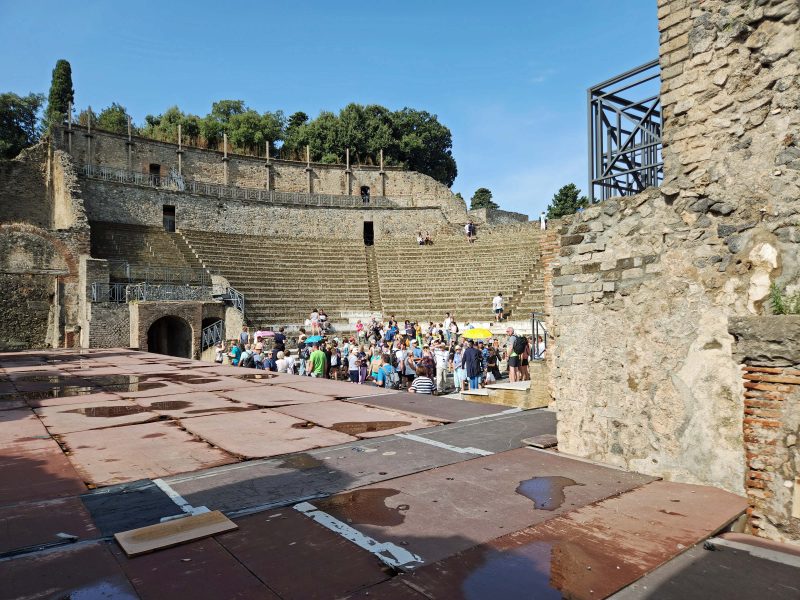
Amazing special effects were possible on the theater stage. A devil could come up from the Underworld in a burst of flame or a god could appear to help someone in distress.

The lower classes of the city had a smaller theater with a seating capacity of only about 1,000 spectators.
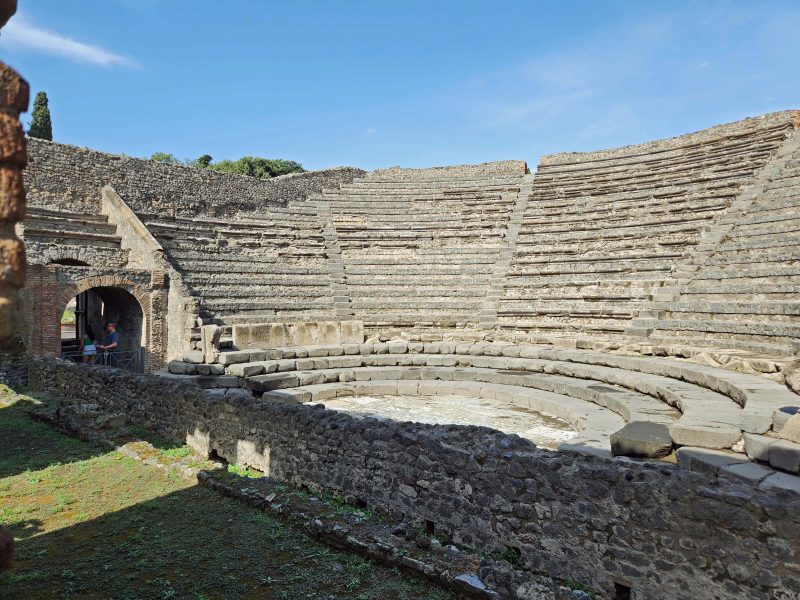
There were very few private baths in the first century. The public baths in Pompeii played an important social role as a place where people could work out, relax, and meet other people. They could also get clean, which they did by putting oil on their skin and then scraping it off before rinsing with water. The Stabian baths in Pompeii are the oldest bath complex in the city, and they’re right near the brothel. Handy. They’re called Stabian baths because they were located at the corner of the Via Stabiana. Well, duh!
Because the Romans were so advanced with water systems, these first century baths had running water connected to the aqueduct system, and they included a swimming pool in addition to hot, tepid, and cold baths and a sauna. They were heated by piping systems circulating hot air from furnaces into the walls and doubled floors. The baths also included changing rooms, latrines, and a gym. Men and women had separate quarters, but the men’s quarters were far more lavish than the women’s. (Feminist thoughts again unstated here.)
Here is the entrance to the baths at Pompeii.
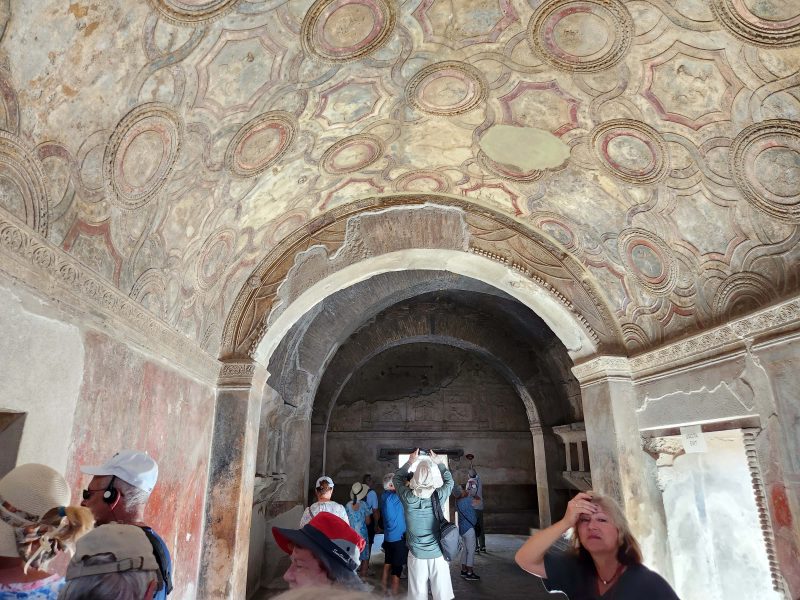
The sauna was heated with water beneath the floor to create steam. You can see the double floor where the water was contained to heat the bath. Because the sauna was so hot, it was opposite the cold bath, shown in the second photo. The cold bath was supplied with cold water through the hole near the floor.
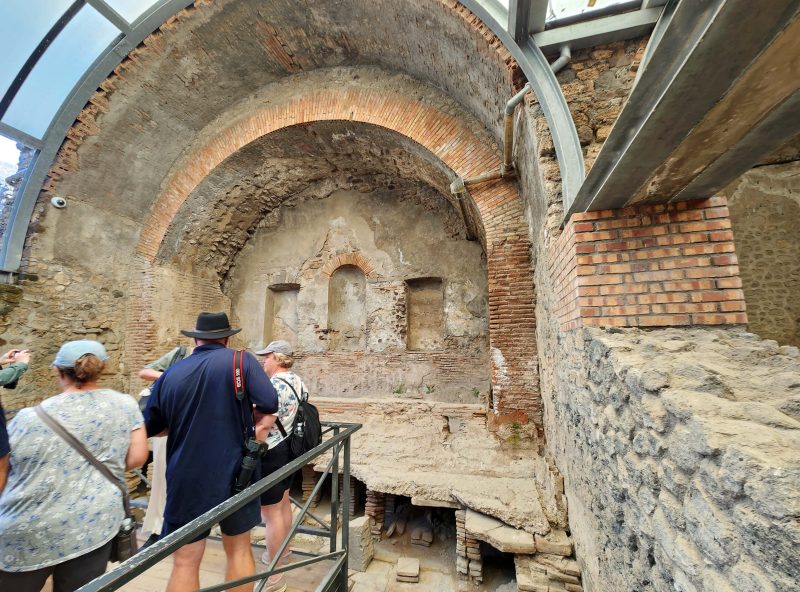
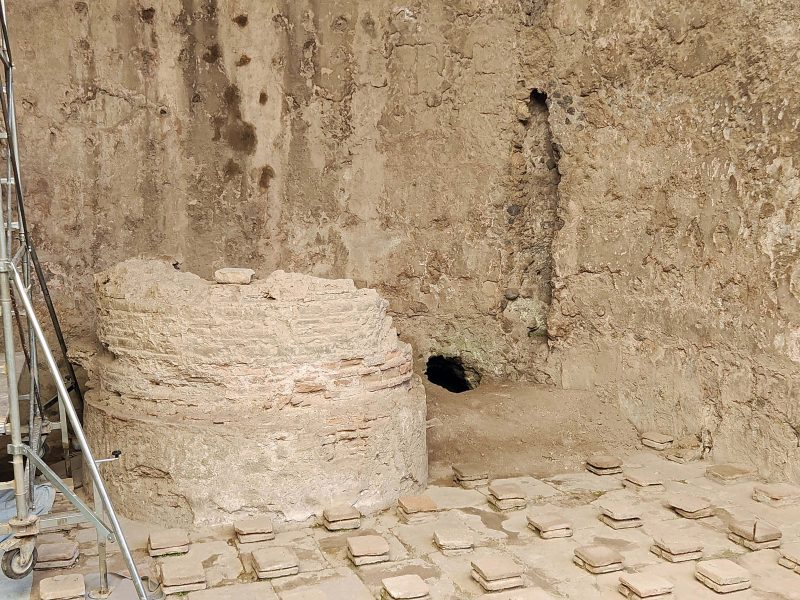
All the baths, including this tepid bath, were originally beautifully decorated.
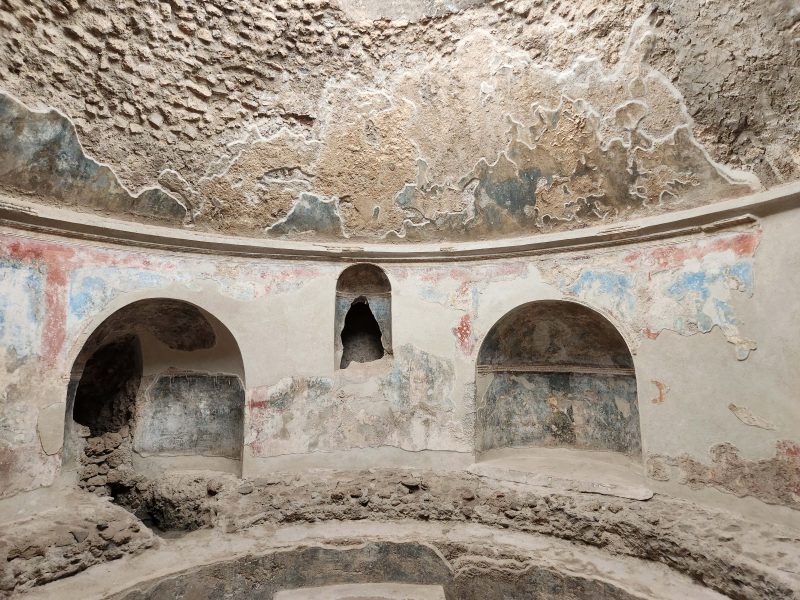
When Mt. Vesuvius violently erupted in 79 AD, the ash cloud rose 21 miles upward. The first blast was heat. It was so hot that the contorted bodies were not evidence of agony; they experienced a cadaveric spasm in which their organs and blood were vaporized. At least one victim’s brain was vitrified (turned to glass) by the temperature of the blast. If a person survived the heat blast, they were quickly suffocated by the ashes or burned by the hot rock and gases that flowed at speeds up to 150 mph. The volcano erupted for three days. Anyone who survived until the third day later suffocated from the small lava pebbles that fell in enormous quantities. It is estimated that 2,000 people were killed by this volcanic eruption.
Contrary to popular belief, intact bodies were not found by excavators in Pompeii. During the excavation process, voids were discovered where humans and animals had perished. Plaster of paris was injected into the voids and took the shape of whatever had perished in that spot. More than 200 plaster casts were made during the excavation of Pompeii.
This is a cast of a pregnant female slave. She is identified as a slave because she is wearing a belt at her hips. It’s known that she was alive after the heat blast on the first day because she had time to roll over and cover her face in an attempt to survive before she suffocated from the lava pebbles that fell relentlessly later in the eruption.
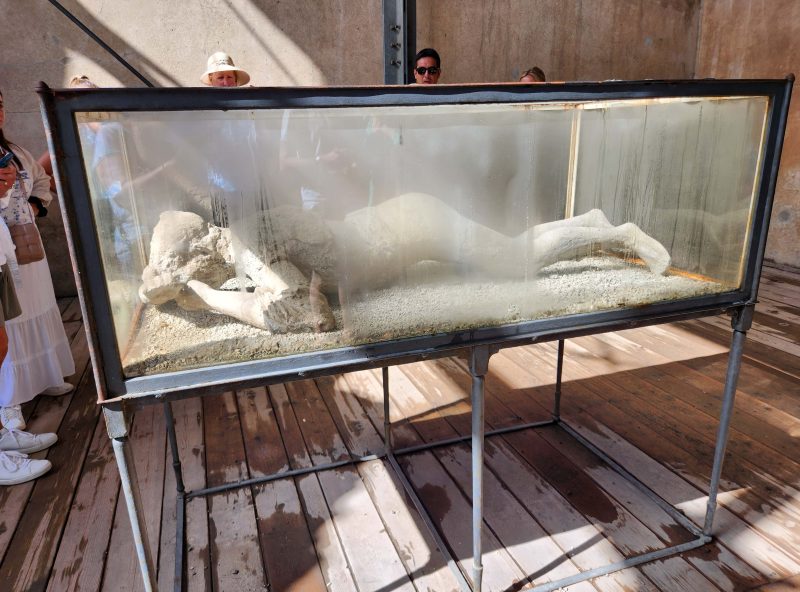
The Vettii family were the richest and most famous people in Pompeii, and their house—the House of Vettii—was one of the grandest houses in the city. Pompeii was known for its explicit and erotic artifacts and the Vettii house is filled with erotic paintings and friezes. The concept of obscenity seems to have been unknown in Pompeii because love and sex were encouraged without prejudice for homosexuality or prostitution.
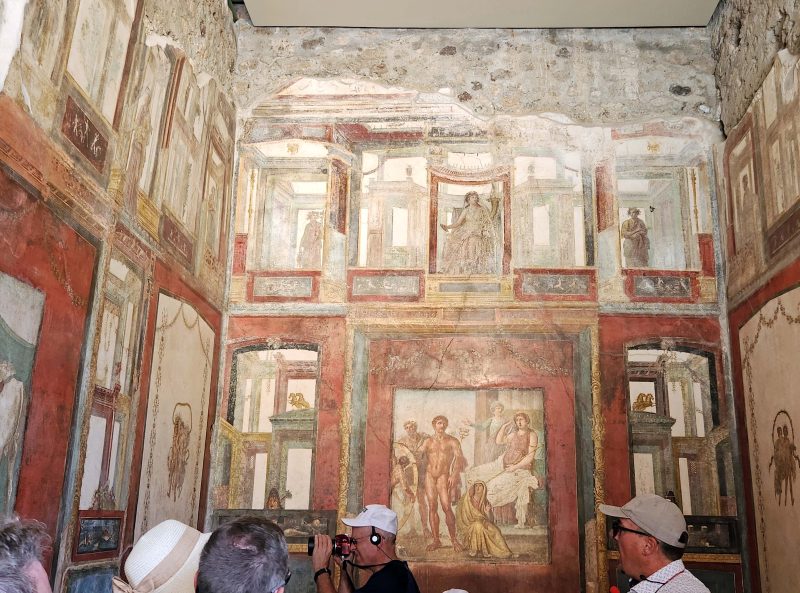
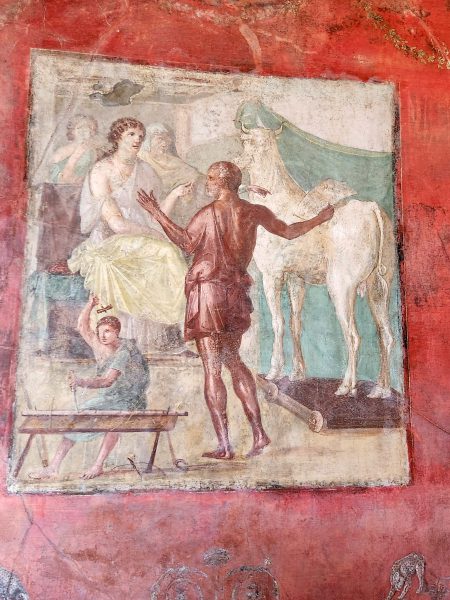
The dining room of the House of Vettii originally had paintings featuring gilded cupids (like those in the red panels) on all the walls. The black frieze that encircled the room featured gilded cupids selling perfumes and flowers, making wine, working with gold, etc. On the side walls, you can see where some of the plaster has fallen away. The walls were covered with thick layers of plaster to make them smooth and suitable for painted artwork.
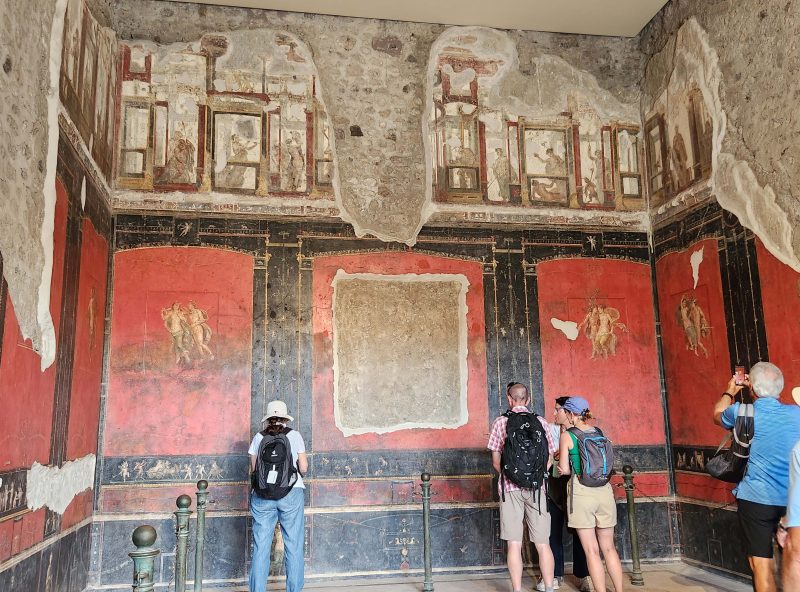
Here is the courtyard of the House of Vettii.
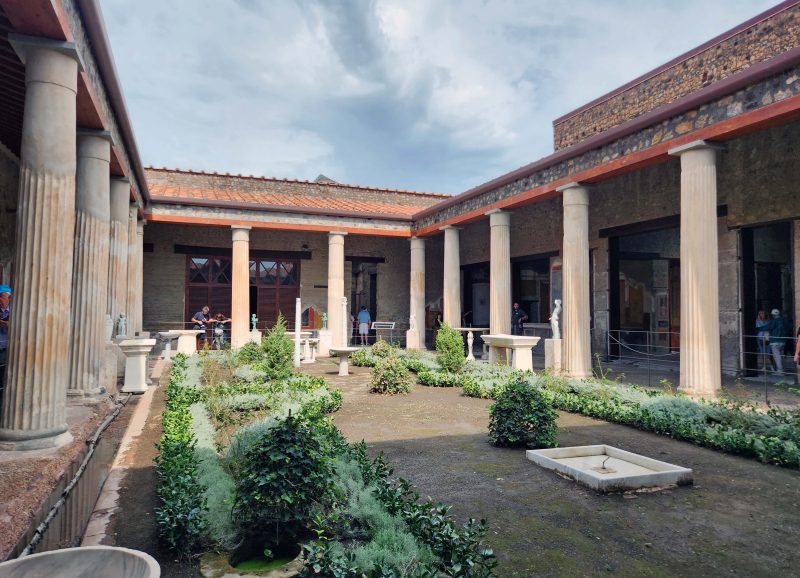
Back on the streets of Pompeii we saw this partial kitchen, perhaps in a communal cooking area or in a restaurant. The circular object in the foreground of the picture is a grindstone for making flour. Long rods could be inserted through the holes in the curved upper stone and were used to first, lift the stone (slaves or animals would do this) while grain was placed on the flat surface of the center cylindrical stone. Then the upper stone was dropped and the rods were used to turn it, grinding the grain into flour. The flour would be pushed out from the top of the middle stone, landing on the flat bottom stone where it was collected to bake bread in the brick oven in the background. That oven would probably have made good wood-fired pizza if pizza had been invented in the first century.

The gladiators’ quarters are on the right side of this picture. The training ground where they practiced was to the left of the colonnade. It was very expensive to train gladiators, making them valuable commodities, so the owners weren’t eager to have them die in battle. According to the Pompeii legend, spectators only voted thumbs up or down instead of killing the loser. At least, that’s what our guide said, but I looked it up and every website said that a thumbs up meant “live” and a thumbs down or a closed fist meant “die.” Maybe in Pompeii, that practice was only a figure of thumb.
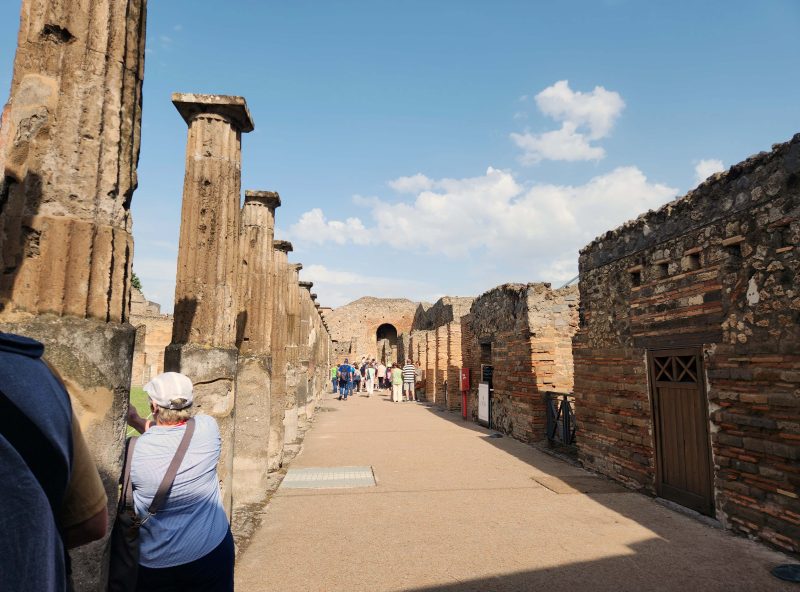
The Forum was the center of religious, political, and cultural life. It was an open, central space with some of the most beautiful buildings in the city surrounding it. It served as the hub of the city and as the commercial center of justice, trade, markets, and worship.
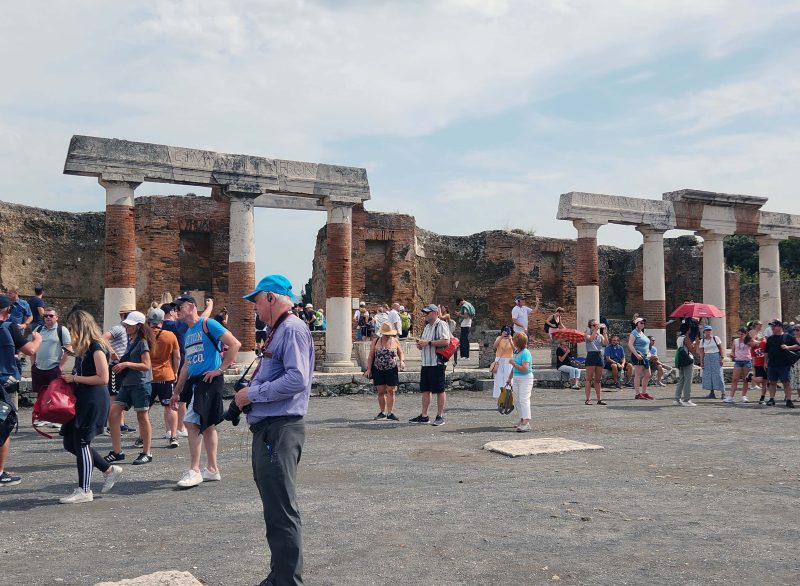
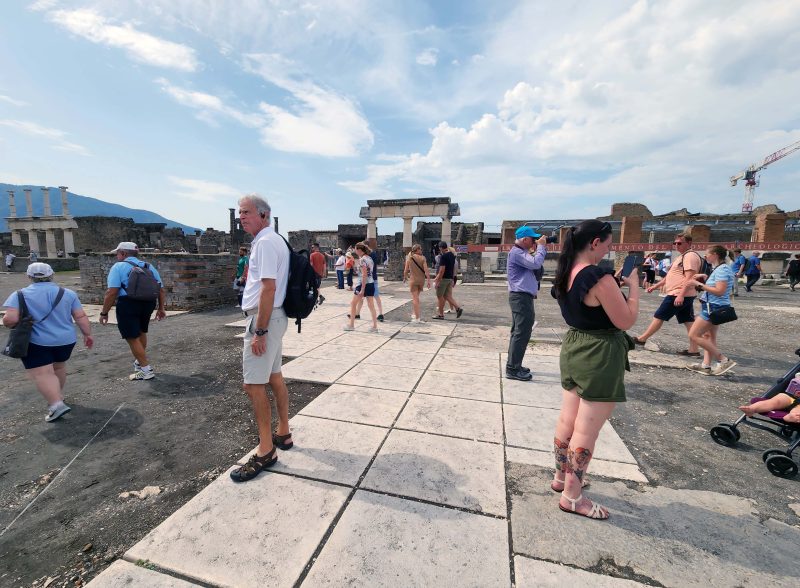
The basilica of Pompeii stood here. It was primarily used for governmental, legal, and administrative purposes and for large group gatherings.
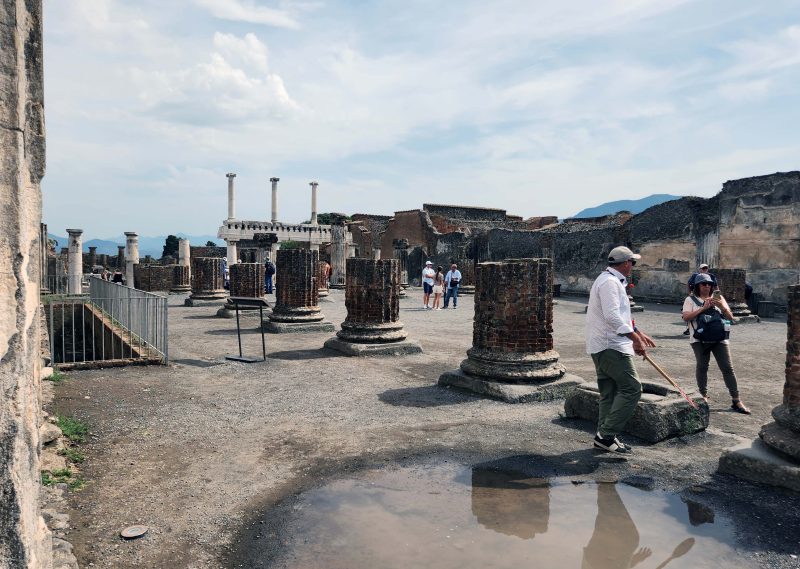
The Temple of Apollo was a place of worship in Pompeii where athletic victories were celebrated with ceremonies to praise Apollo for the victory. Gladiatorial games, theatrical performances, and festivities were also held here. A replica statue of Apollo can be seen in the photo and, on the opposite side of the field, there was a statue of Diana, Apollo’s twin sister. The original statues of Apollo and Diana are now in the Naples Archeological Museum.
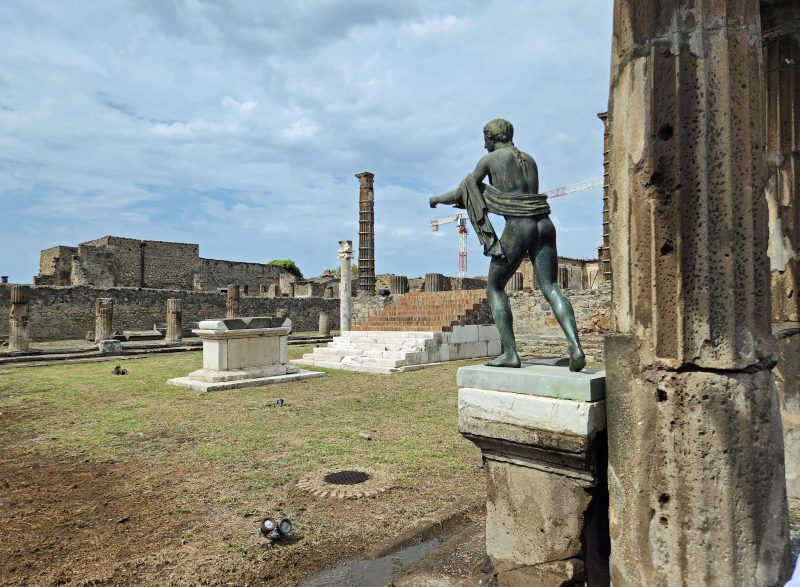
According to the people in Naples, pizza was probably invented here in the 16th or 17th century among the Romans in this area. Because people at that time didn’t always have flatware and dishes, they ate a variety of foods on a piece of bread, leading to the logical development of pizza. Someone (vague, here) squashed tomatoes and made a sauce for the bread, but people were afraid to eat it because tomatoes are a relative of nightshade, a very poisonous and deadly plant. Someone (vague, again) finally convinced the people that tomato sauce was safe to eat, pizza became a big hit, and it’s now a world-wide favorite. It’s the one thing Ted and I have seen in every country we’ve visited and it’s always spelled p-i-z-z-a, no matter what the native language is.
When Ted and I went to Rome in 2019, we made a point of having gelato, spaghetti, and pizza because we were in Italy, the country that created gelato, spaghetti, and pizza. The gelato was great, the spaghetti was so-so, and the pizza was no better than ok. We mentioned the disappointing pizza to a Neopolitan waitress we met in Switzerland, and she firmly informed us that Roman pizza is terrible and that if we want good pizza, we have to go to Naples. Well, Pompeii is part of the metropolis of Naples and our group had lunch today at a pizzeria in Naples.
We could watch the crew make the pizzas and put them in the ovens. Each member of our group was served a 10-inch pepperoni pizza and our choice of beverage—water, soda, wine, or beer. Afterward, each table was served a single dessert pizza with only one piece of that for each of us. I wish I’d taken pictures of the pizzas. All I remember is that both were so-o-o-o good and the dessert pizza had chocolate on it. The woman in Switzerland was right: you have to go to Naples for good pizza.
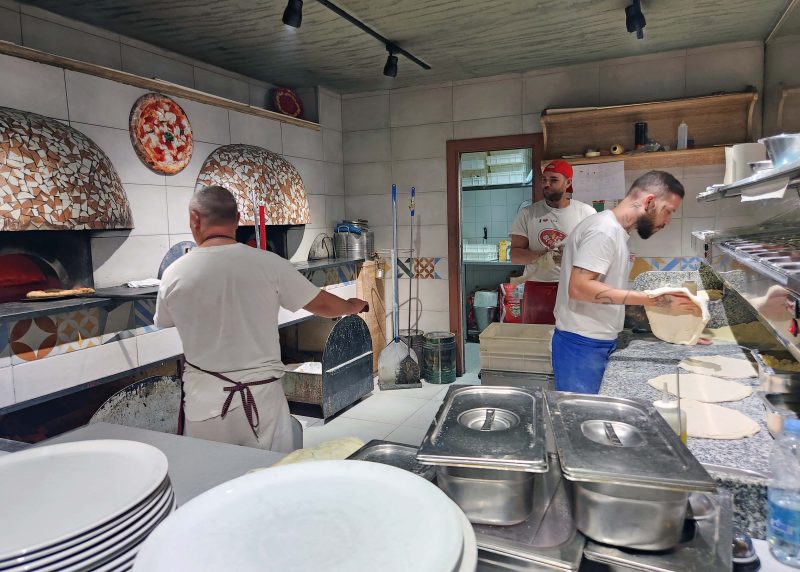
Today our ship was docked in Messina, Italy at the northeastern tip of Sicily on the Messina Strait. Tomorrow, we’ll sail through the Messina Strait into the Tyrrhenian Sea to Naples. BTW, Ted’s good friend, Vince, was born and grew up in Messina.
Until Ted and I went on this cruise, we had no idea there are eleven seas within the Mediterranean Sea. It made me curious, so I went to that know-it-all, Google, and found a very logical answer. This area of the world has a lot of mountains. (Tell us about it—we walk up and down steep hills and stairs on every excursion!) Well, the floor of the Mediterranean is also very mountainous, resulting in the abundance of islands in the Aegean Sea and the partitioning of the Mediterranean into all those smaller seas. Now we know, and we can move on.
On our way to Taormina, our bus stopped at an overlook to provide a view of the city and Mt. Etna. Taormina sits on a rocky terrace overlooking the Ionian Sea and is described as “a scenic city, with spectacular views of Mt. Etna.” Except for today. It was a hazy day, so our views of the iconic mountain weren’t great. Our guide told us the mountain had been active the previous week, but it was quiet today. The lava from Mt. Etna never flows into Taormina, so we were safe. The buildings in the photo are Taormina, and you can just manage to see the silhouette of Mt. Etna in the background.

We started—of course!—by entering the Old City through one of its gates. The gate is in the tower in the background.
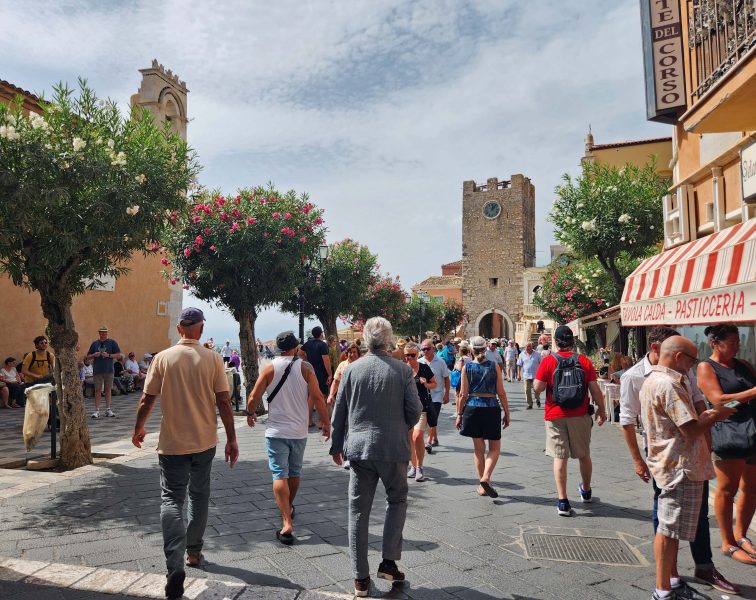
The Church of St. Augustine and its adjoining convent, in the Piazza del Duoma, are now used as a library and a multipurpose room, and for art exhibitions and cultural events. The church dates to the 13th century and was restored for the first time around 1700. Because of its strong cornerstones, the small rose window above the door has survived since that restoration.
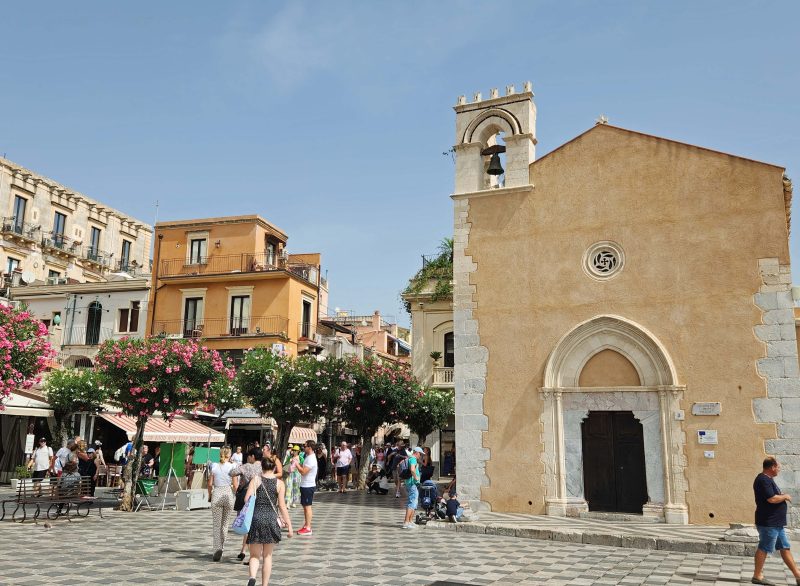
We walked through the city on our way to the ancient Greek Theater and saw some pretty streets and interesting buildings.
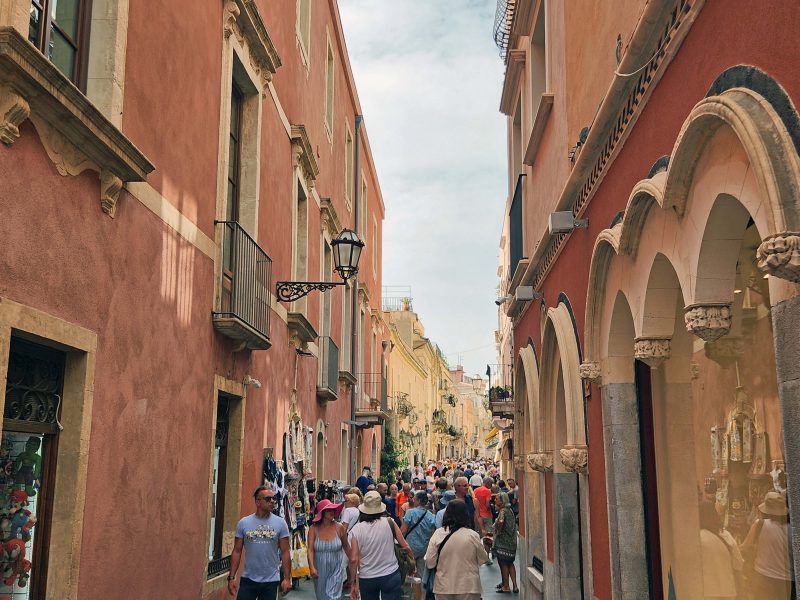
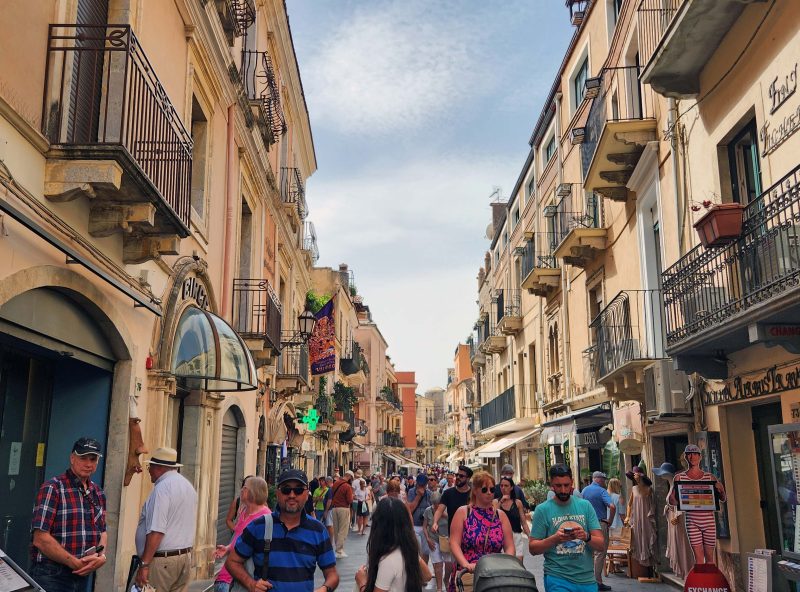
The ancient Greek Theater provides a panoramic view of the sea, the countryside, and the summit of Mt. Etna, Europe’s largest volcano. The theater has been partially restored and is still used for concerts and other events. It has extraordinary acoustics and seats about 6,000 people. In its original form, the theater’s seating capacity was about 12,000 people. Given the scale of the people near the stage, I was obviously standing in the cheap seats to take this picture.
The theater was originally excavated by the Romans, who used it for entertainment—including beheadings and animals eating people. Later, the Greeks used it for plays. All the Greek plays were tragedies because, in their thinking, tragedies taught people about morals and life. The actors wore large masks so that, from a distance (like where I was standing), the audience could tell if they were portraying men or women and could more easily follow the plot.
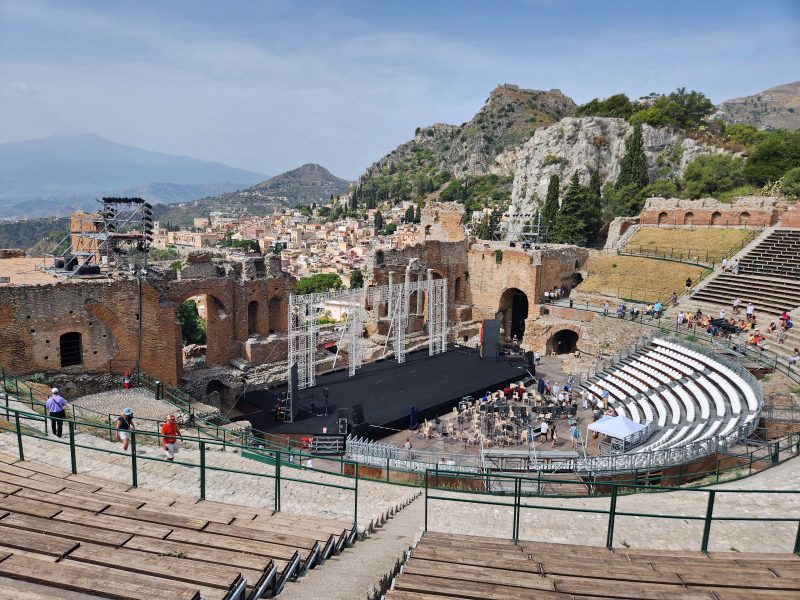
After the theater, our guide left us to spend time on our own. While Ted and I were walking around the theater, we saw these stage prop “rocks.” I think the large one looks like the finger of God.
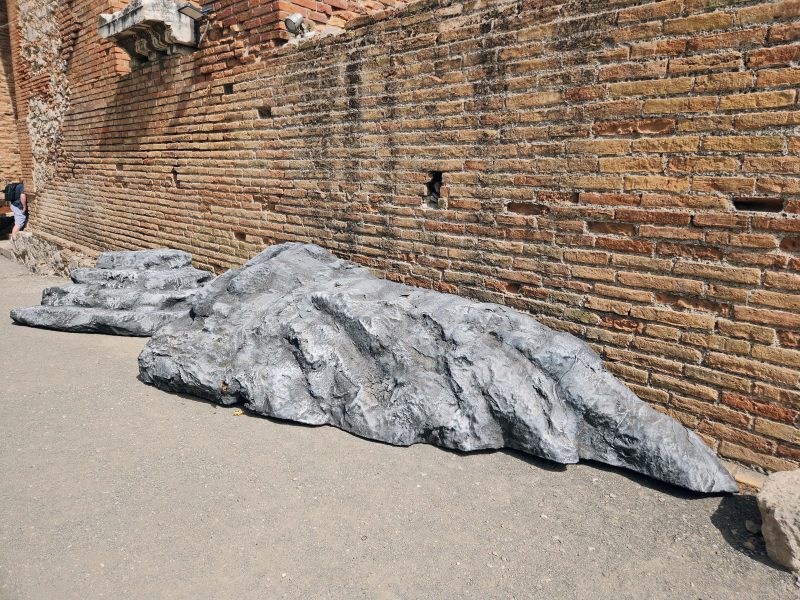
Yep! They’re props.
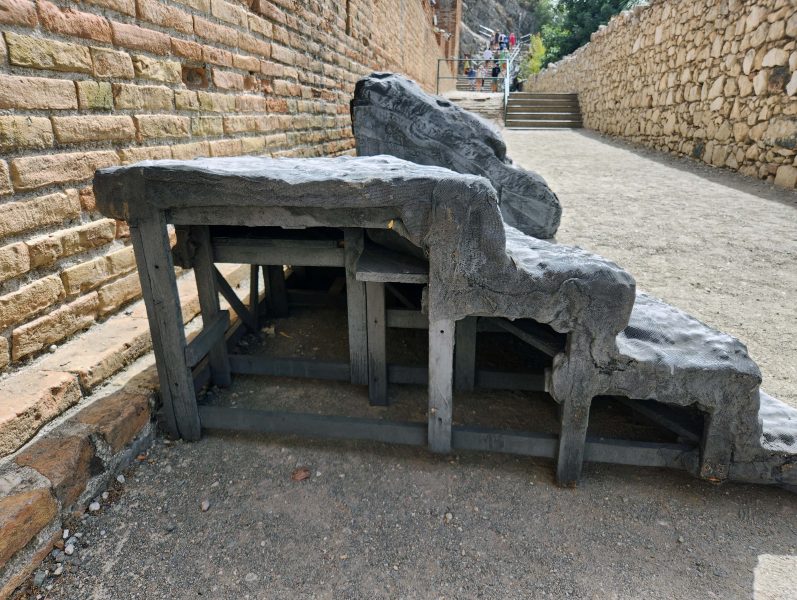
Creative, artistic photography is not my long suit, but I like this picture I took from one of the entrances to the theater. The hazy half mountain on the left of the archway is Mt. Etna.
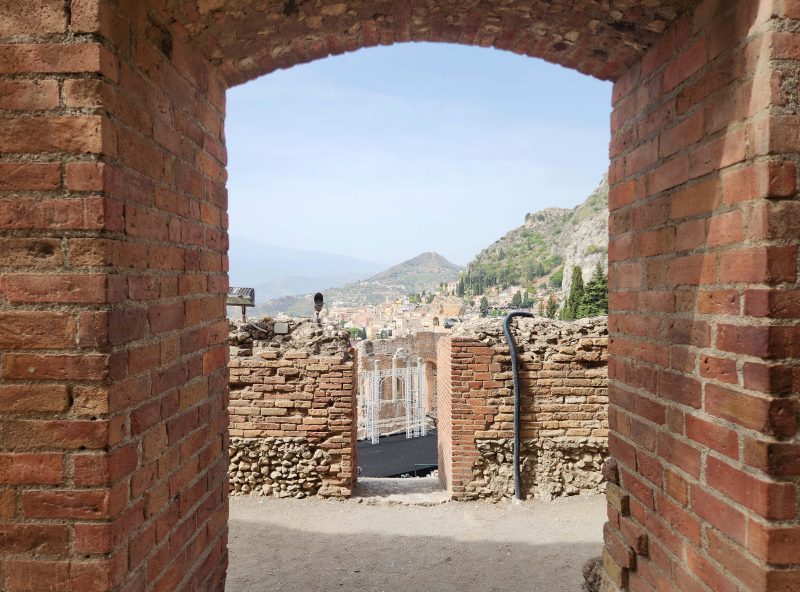
On the back side of the theater, Ted and I (and a few other people) found this shady spot overlooking the Ionian Sea. Our stateroom mini-fridge is stocked daily with, among other things, two snack packets of peanuts. They’re really handy to take along on excursions. There are just enough peanuts in the bag to provide an energy boost in the afternoons. We took a peanut break here and enjoyed the scenery and a nice breeze for a little while.
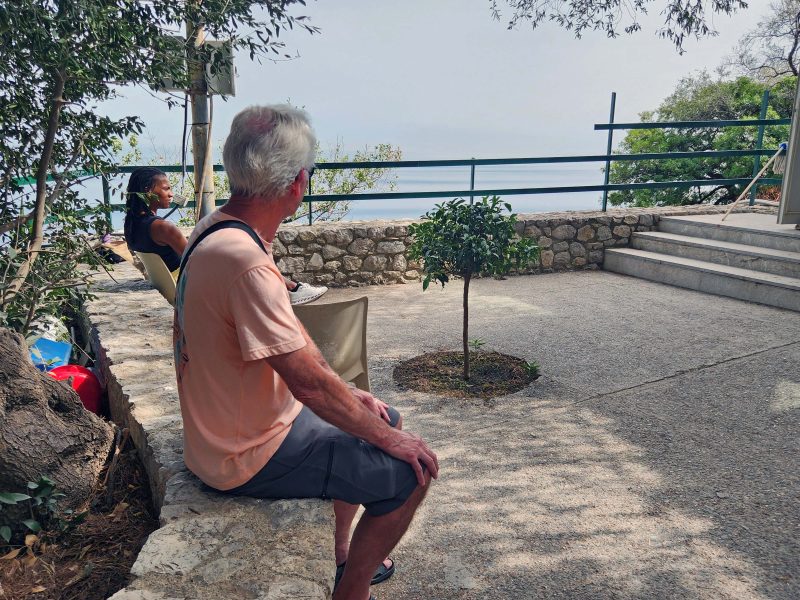
Re-energized, we headed for the downtown area. Notice the head-shaped vases with flowers in them on the shop windowsill. There’s a local legend that goes along with the vases, and it’s so widespread that the vases have become a representative symbol of Sicily. Here’s the legend.
In Palermo, there lived a very beautiful woman who was dedicated to the care of the plants on her balcony. One day a Moor (Arab) passed her house and fell in love with her. He declared his love and she immediately returned the feeling. Unfortunately, she later learned that he would soon return to his wife and children in the East. Feeling betrayed, she cut off his head during the night, hollowed it out, planted basil in it, and displayed it on her balcony. Her neighbors were so envious, they had earthenware pots built to look just like the head of the Moor.
An alternate ending skips the envy of the neighbors and says that the woman watered the basil with her tears, and it grew so prolifically, that other women wanted a vase like hers. They cut off the heads of the men who cheated on them and, if the men didn’t like this solution, well, too bad! They shouldn’t have cheated on their wives.
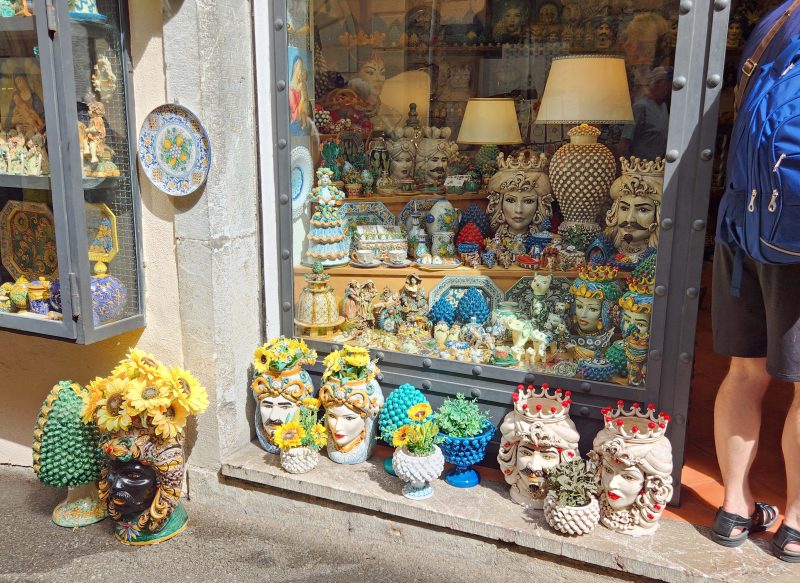
A nearby shop window had these colorful ceramics, another typical product of the area, on display.
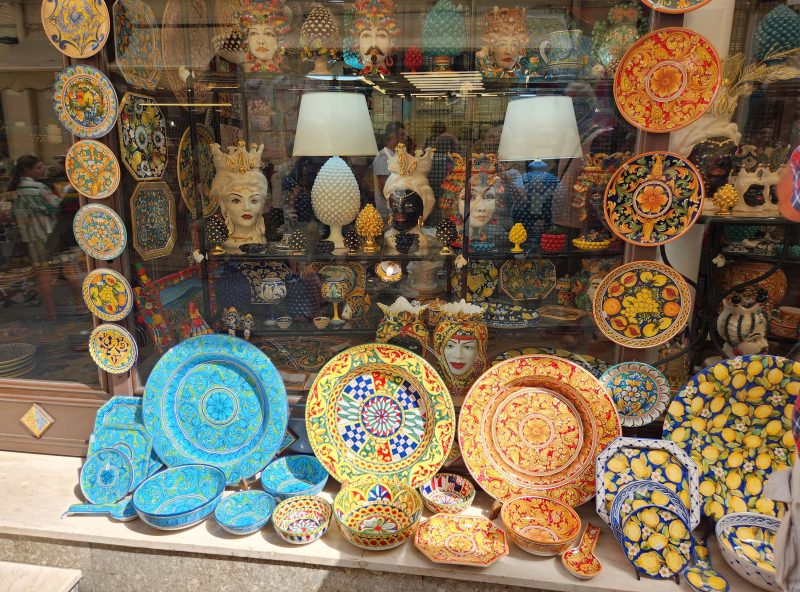
During our time with our guide, she told us the history of the Greeks and wine. (The Greeks ruled Sicily in the 8th century and I think she was Greek.)
According to mythology, the god Dionysus gave the Greeks wine by providing them with grapes that had juice in them. Because wine was given to the Greeks by a god, it’s essential to know how to drink wine as a true Greek. If you don’t know the right way, you’re not worthy of being a Greek. As a knowledgeable Greek, you never dilute wine, but you always drink it with water; you always drink it slowly and with food; and you never get drunk. You start drinking wine when you are three years old, so you’re not a true Greek until then.
Of course, there were outdoor cafés everywhere, including on this stairway, and I’m sure they all included wine on their menus.
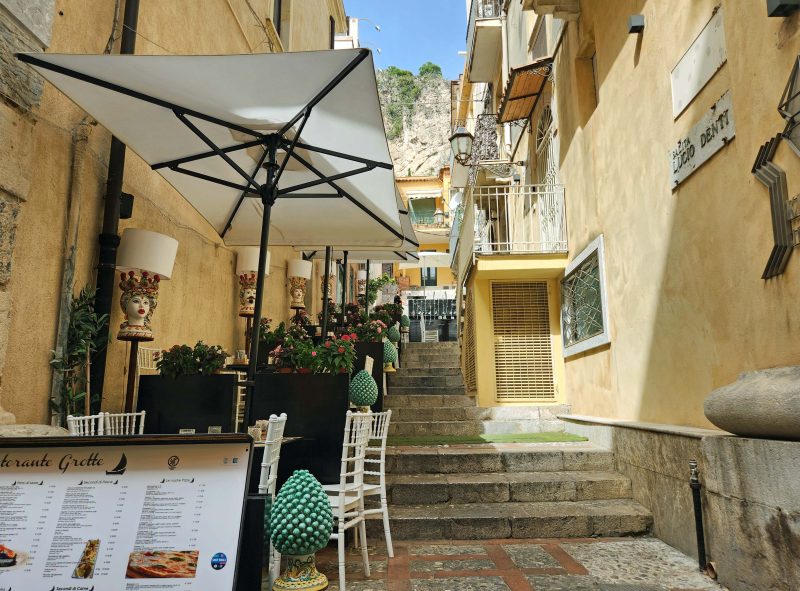
The balconies on this street were pretty.

This candy store caught Ted’s and my attention. I couldn’t miss Superman at the entrance, but the second thing I saw was Elvis, so the store merited a closer look. If you take the time, you’ll see that the shop is decorated with images and models of cartoon characters and superheroes.
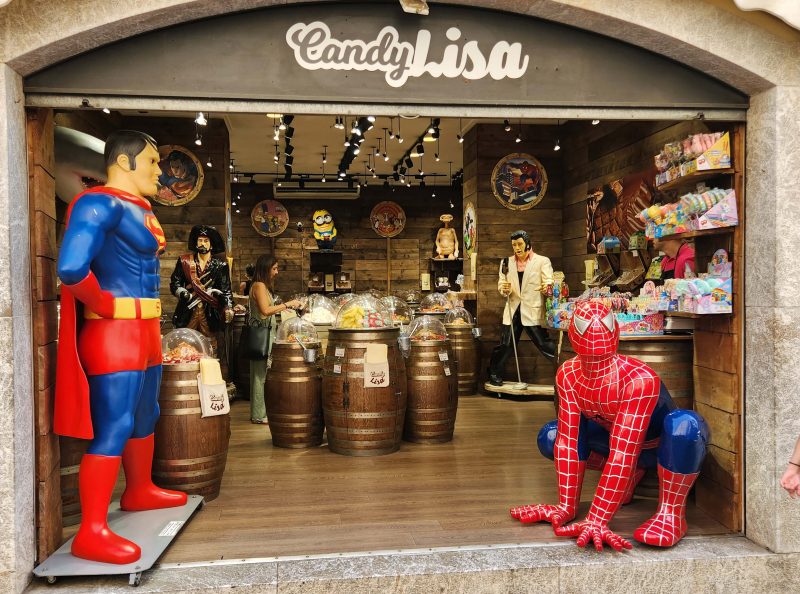
Some things are so pretty, they simply beg to be remembered in a picture.
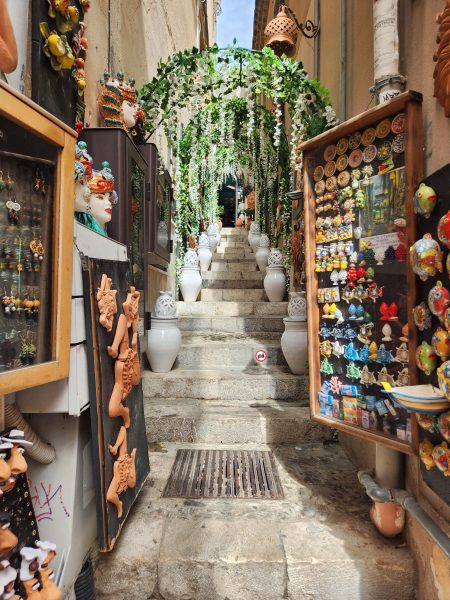
We had a little travel adventure at the end of today’s excursion. As I mentioned, our guide left us to explore the city on our own, which is not unusual, and she asked us to meet her in the piazza at a given time. All of us were there about ten minutes before the scheduled time, but our guide, walking slowly with a beverage in her hand and chatting with a friend, arrived ten minutes late—20 minutes after the rest of us arrived at the meeting point. The parking lot and the public restrooms were on a lower level (the city is on a mountainside), and the elevator required the guide’s group pass to use it.
Quite a few people had planned to stop at the restrooms before boarding the bus and were waiting for the guide and her elevator pass. What could she do but take us down to the parking level and then wait while those in need used the restrooms? As a result, our bus’s paid parking time ran out, and the garage attendant would not let the bus leave without paying the additional overtime fee. I think it was €20, and our guide had to pay it out of her own funds because she was contracted by Viking and not an employee of the company. We did not have a happy guide on our way back to the ship, but it was her own fault for being late. Maybe she learned to set an earlier meeting time or to arrive at the meeting point on time to allow for restroom usage on the parking level.
One of the things I greatly enjoy wherever and whenever Ted and I travel is the people we see and meet. I love to watch children and to talk with adults. No matter where we go, I’ve found that people are all the same. I’m convinced that we could have world peace if we could exist without governments. People get along with each other; it’s the governments that let politics get in the way of my dream for world peace. Here are a few photos I took on Ted’s and my 2023 BT to show how similar people are around the world.
This is a picture of a candy store in Taormina, Sicily. Apparently, superheroes are international. How many can you find and identify in the store? I named 20, counting Superman and Spiderman only once each.
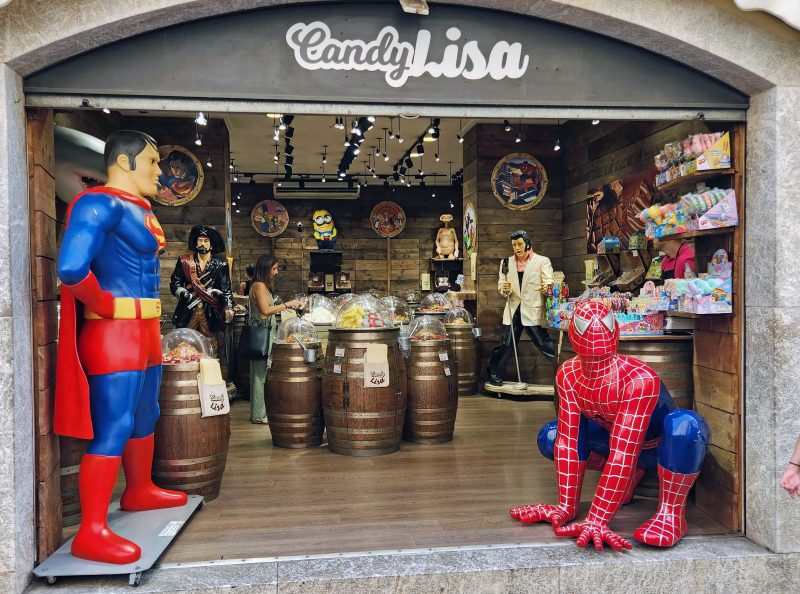
When I was in elementary school, we had several cadences for jumping rope. One was “First comes love, then comes marriage, then comes (name) with a baby carriage.” Well, love came first and here’s the marriage—a wedding that took place at the Church of San Giorggio Maggioni with an official photo being taken in the Venetian Lagoon and Venice in the background.
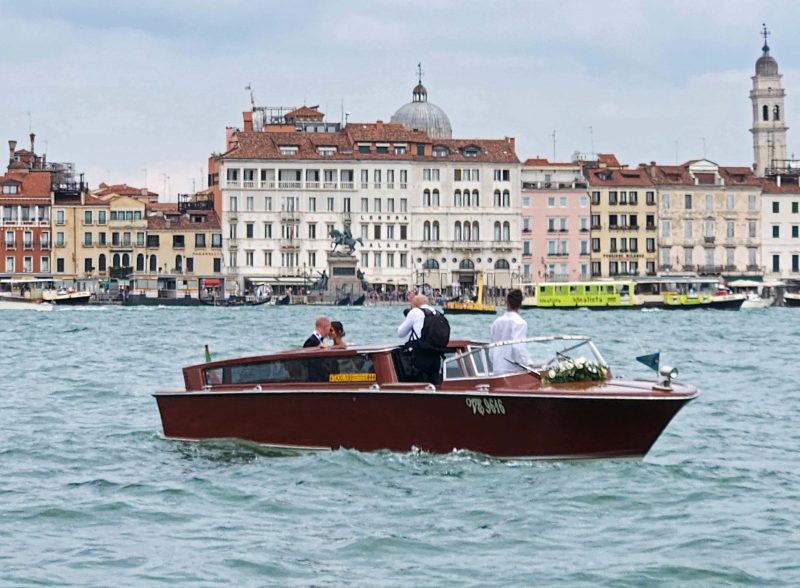
And here’s the baby carriage. Ted and I saw this at a home in Chioggia, Italy. It’s a girl! Baby Lisa was born on September 9. She weighed 3.560 kg (7.8 lb.) and was 51 cm (20 inches) long. Congratulations, Mom and Dad!
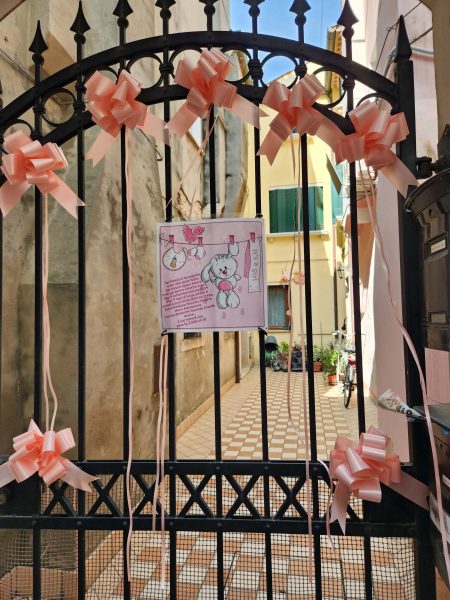
Like everywhere else, in Taormina, Sicily, when it’s naptime and you’re not at home, the best place to sleep is on Dad’s shoulder.
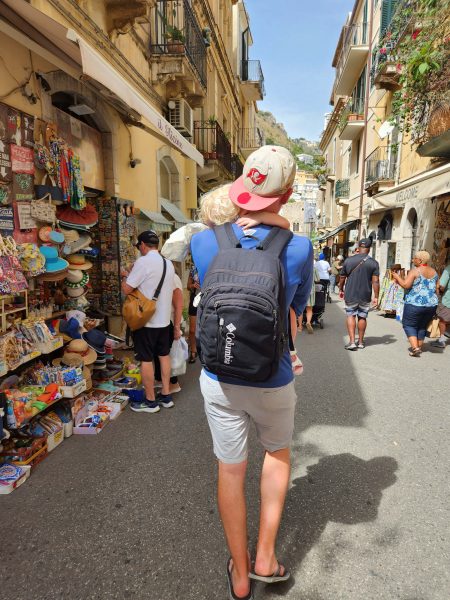
After that refreshing nap, the best seat in the house is on top of Dad’s shoulders, like these two kids in Split, Croatia.
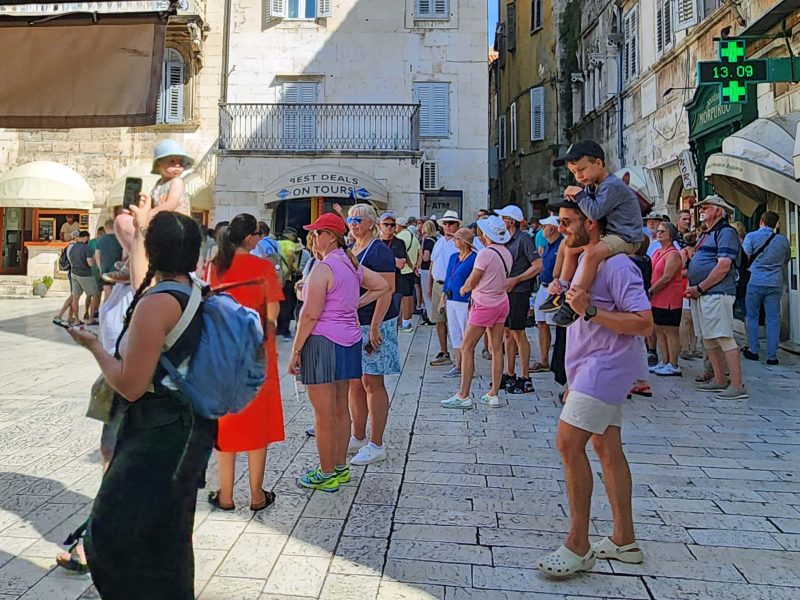
No matter where you go, if there’s a playground, there are kids playing just like they’re doing here in Šibenik, Croatia. I still like to swing, ride the teeter-totter, go down the slide, and spin on the merry-go-round, but I limit myself to doing it when I’m not intruding on the kids.
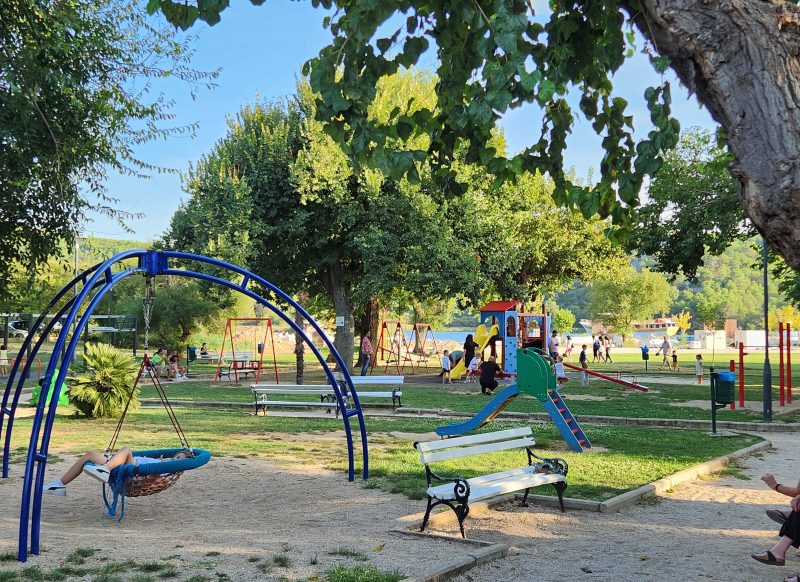
Everyone knows that tired feeling you get after a long day of walking, then finally having an opportunity to sit down and fall asleep. Without Dad’s shoulder to sleep on, these folks settled for the motion of a slow-moving water taxi on our way back to the ship from Venice. They’ll be revived and ready for tonight’s entertainment onboard.
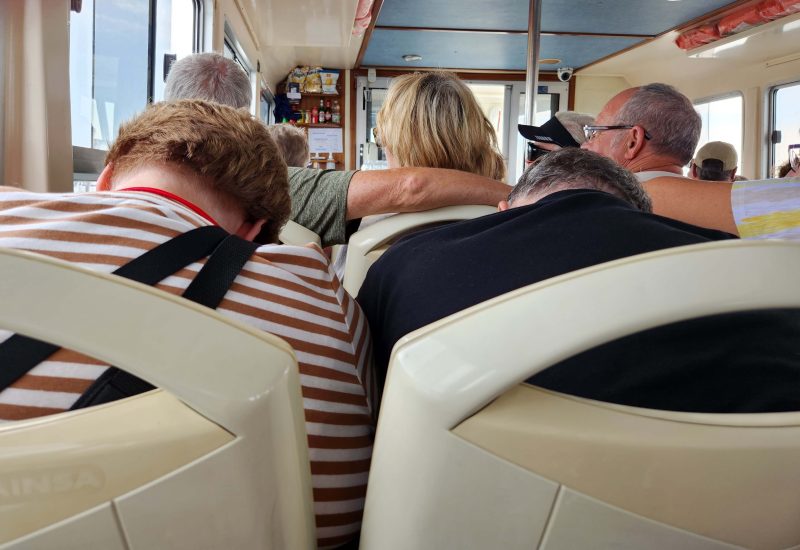
One person we met broke my “people everywhere are the same” mold and stands out because he had an unusual way of introducing himself. You know how you meet new people when you’re traveling and you say, “Where are you from?” When you do that, people usually name a city, a state, or a country, depending on how far away from home they are. This particular man said, “Well, I did two terms in Bloomington, IL, but now I live in Florida.” Bloomington is where the Illinois state penitentiary is located. Wouldn’t most people simply say, “Florida”? That just proves another maxim: people will always surprise you.
Several location names were used when Ted and I took a shore excursion to see “Puglia’s White Cities”: Puglia, Ostuni, and Alberobello. They all sound equally Italian to me, but I’m pretty sure I’m correct when I say, in American terms, that Alberobello is a suburb bordering Ostuni in the district (state) of Puglia in southern Italy on the Adriatic Sea, and that Bari (where our ship docked) is the capital city of Puglia, similar to a state capital in the U.S.
At our ship’s dock, Ted and I saw this installation, and we decided that it represents the trulli (‘troo-lee) houses of Alberobello, the focus of our upcoming excursion.
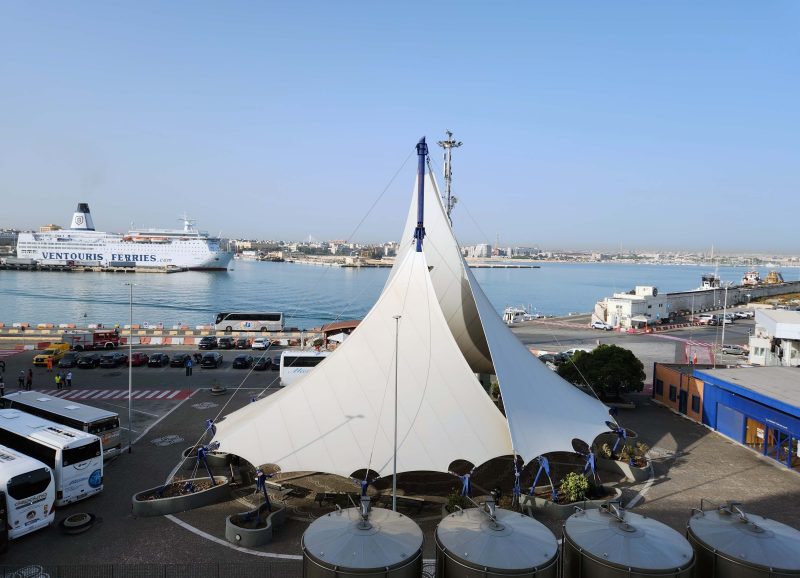
As for seeing “Puglia’s White Cities,” our best overview was this one from our bus.

Most of our time was spent within the cities, so we couldn’t see beyond what you normally see when you’re in a city. This was the single point we found that overlooked the Adriatic Sea and included some of the white city of Ostuni below us. A white city on a sunny day is very light and bright and cheerful.

The trulli houses are in Alberobello, but the downtown area where our bus dropped us off was Ostuni. Ostuni was described in our excursion literature as a “labyrinth of alleyways, staircases and arches” and that was absolutely true. In the photo below, Ted and I are standing at the bottom of a hill in Ostuni, preparing to climb to Alberobello at the top where there are over one thousand trullo (the plural of trulli) waiting for us to see them. We didn’t see every one of the thousand trullo, but we walked around and saw a lot of them.
Our delicious group lunch was held at a restaurant about halfway up this hill. It’s on the right side of the street between the second and third flower pots, and there’s a table sitting on the street. It was a tiny little restaurant with tiny little rooms (and two tiny single-person bathrooms), yet, with practiced efficiency, the staff managed to serve 150 tourists from four buses a full four-course hot meal.
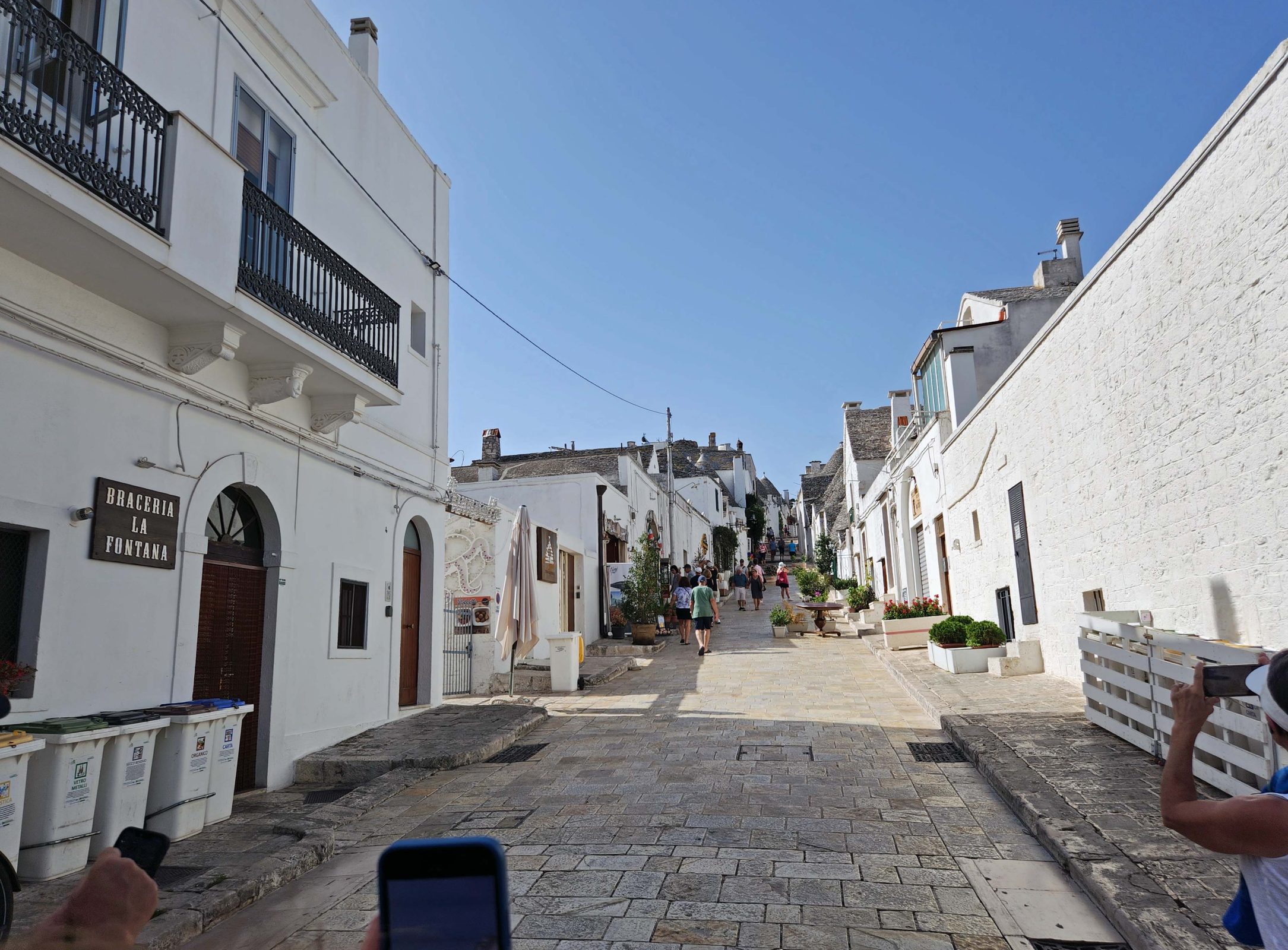
Trulli is the name of a building style that uses a dry stone structure—in other words, stones without mortar. The cone of the roof is built with two layers. The inner limestone layer is capped with a keystone and the second, outer layer ensures that the roof is watertight. The side walls are roughly three feet thick to keep the houses cool in the summer and warm in the winter.
It is believed that, during the 14th century, property taxes were very high in this area. To avoid those taxes, the feudal lords housed their farm workers in trulli structures. When the tax inspectors came to the area, the keystone was removed and the structure became a pile of stones with no resemblance to a residence that could be taxed. When the inspectors left, the trullo were rebuilt.
These fairy tale-like conical, white-washed structures are still inhabited today. I couldn’t find any definitive answer to whether or not they continue to be exempt from property taxes.

Here are some close-ups of how the stones are piled without mortar. There are more stones than dirt in this area—the main reason why tourism, rather than agriculture, provides 20 percent of the country’s income.

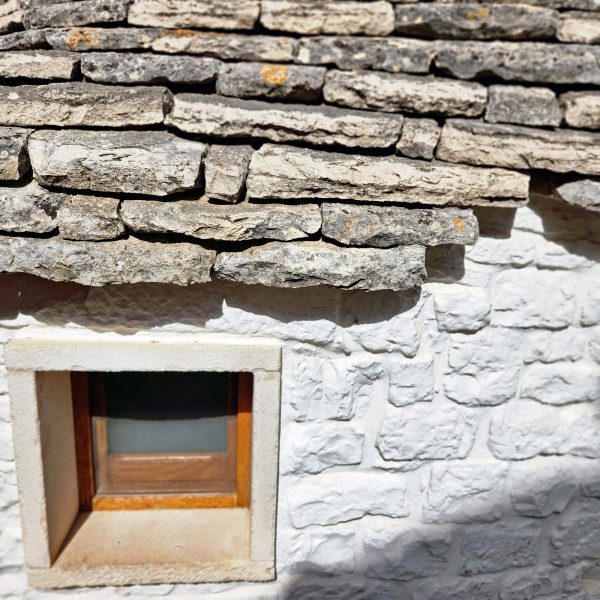
Trulli houses might have more than one large cone as well as several smaller ones, and individual cones might also have a second story, accessible by stairs or a ladder, depending on the size of the first-floor room. Even so, it’s a mystery to me why there are two ladders suspended between roofs in the photo below. It doesn’t seem likely they would take anyone to the first or second floors of the houses.
“Party lights” were strung between many houses—possibly serving as gentle streetlights at night? Naturally, the trullo are UNESCO protected, so maybe the party lights are a concession to safety without the culture clash of modern streetlights.

Trullo are often decorated with symbols, usually with a religious or astrological meaning. The symbols are not original to the houses, but were painted on them at a later time.

This was the prettiest group of trullo Ted and I saw. The whitewashed buildings, the blue sky, and the bright petunias are perfect together! Look closely and you’ll see a resident talking on her cell phone behind the back pot of petunias on the right—proof that these homes are inhabited.

After visiting the trullo neighborhood and fortifying ourselves with lunch, our guide walked us up a high, steep hill to see the 15th century Ostuni Cathedral. The church is located in a small square at the top of the hill and dates back to the year 1000, but was destroyed in a 1456 earthquake. The reconstruction of the cathedral included the large rose window visible in the photo below. The cathedral’s library has an archive of over 200 documents dating back to the 12th century. The artwork on the cathedral ceiling and interior walls is described as “remarkable,” but we were not able to enter the cathedral.
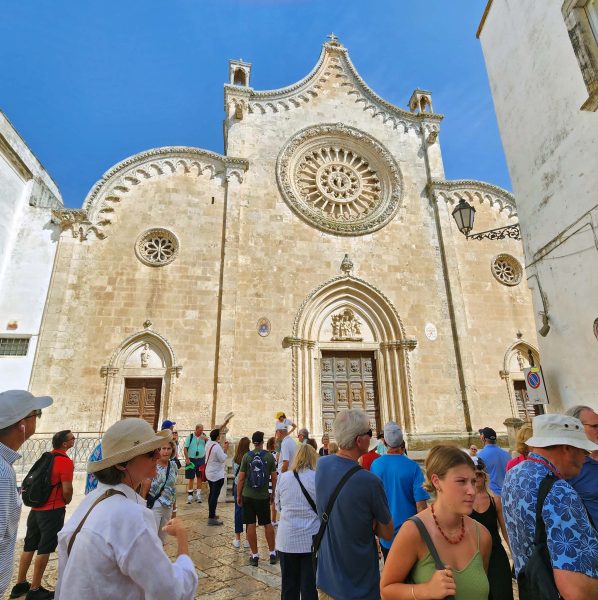
Our guide gave us pertinent information about the cathedral and then left us to spend some free time on our own exploring Ostuni. Before going down the hill, Ted and I walked around this small, historic square for a little while. The Arco Scoppa (the darker, arched portion of the picture, is an elevated passage between the bishop’s palace the seminary. It faces the cathedral and, along with the cathedral, is one of the main landmarks of the town. It’s not a bird, a plane, or even Superman–all those people looking upward are admiring the rose window in the cathedral across from the Arco Scoppa.
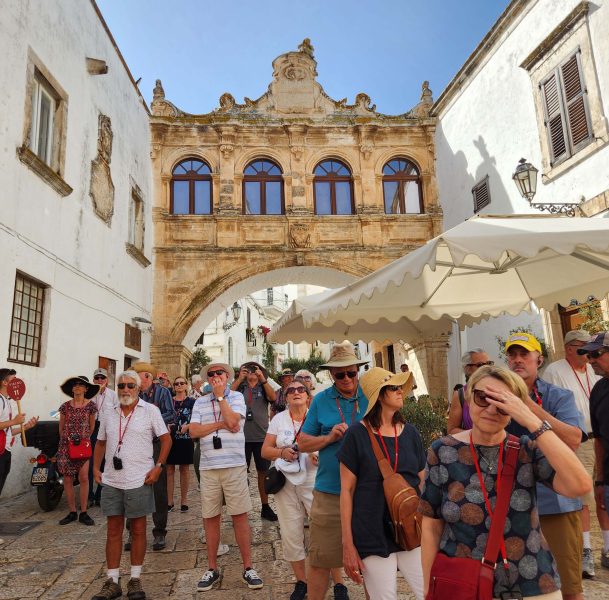
Later, Ted and I walked down this pretty street.
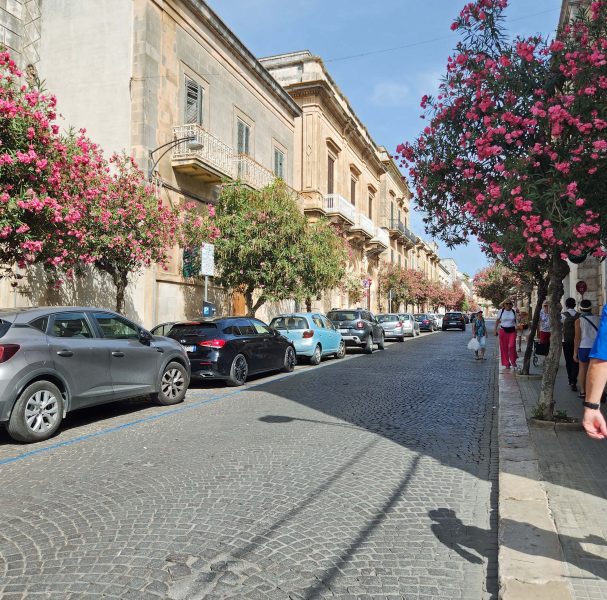
We greeted this vendor, sitting on a stairway that led to several apartments. Maybe he lives in one of them and works close to home. At the top of the first flight of stairs, there’s a woman sweeping her doorway—his wife?
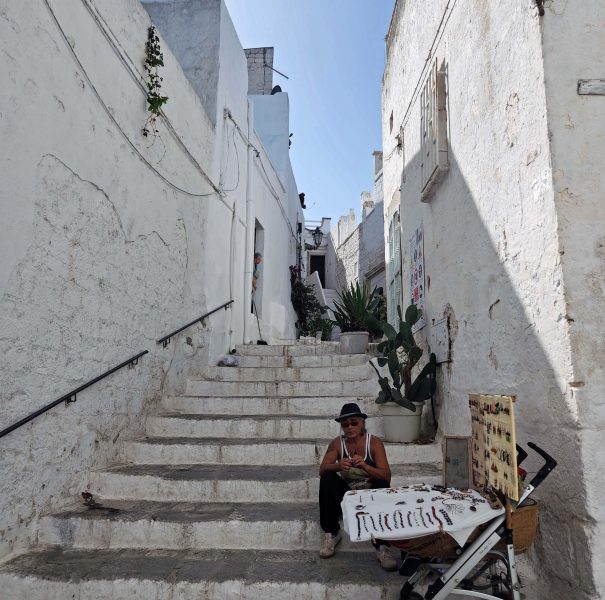
Not surprisingly, we saw another mini café. The indoor restaurant was small, but had more seating than the two four-tops outside.
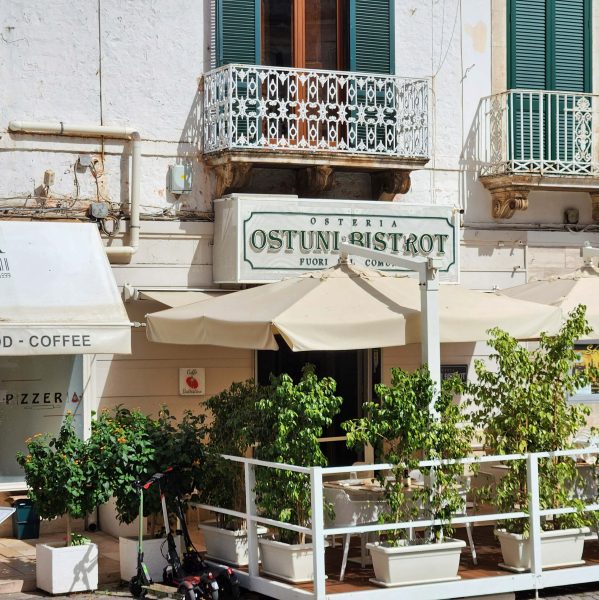
Treedom is an organization that directly finances small agroforestry projects in various countries. The city of Alberobello invited Treedom to create an installation to be placed in the main city square for its Light Festival in 2023. The result is shown below. It is supposed to invoke the image of a geometrical forest of trees, with rocks to add a natural touch. The rocks also have a role in balancing the installation and stabilizing the pole bases. Benches and bar counters are part of the structure and contribute to its stability by connecting the poles. Would “unusual” be an apt description of this installation?
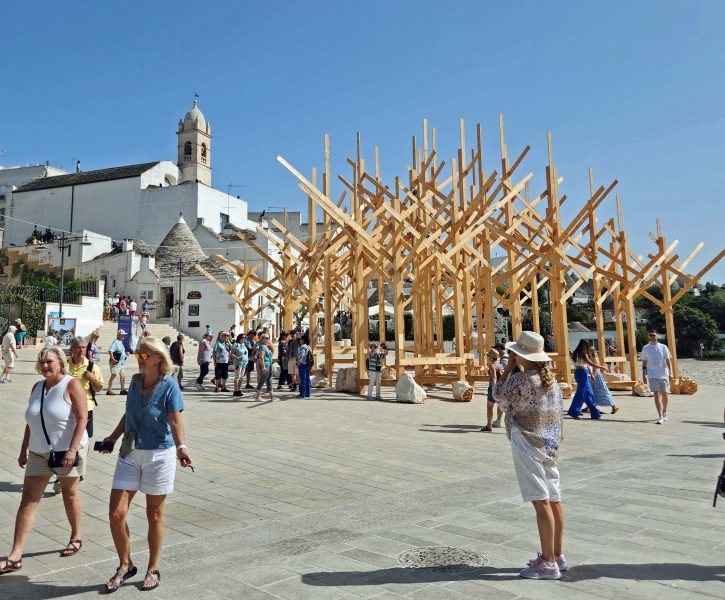
Ted and I had some extra time before it was time to board our bus and head back to Bari and our ship, so we stopped for some ice cream at a café with one of those outdoor European mascots that indicate ice cream shops. The ice cream was good and, when we finished eating it, we used the restroom before our ride back to the ship.
The restroom wasn’t as good as the ice cream. The toilet worked, but there was no toilet paper. (Luckily, when we were in Egypt, Hanan told us to always carry some toilet paper.) There was soap, but the sink faucet failed to produce water and there was nothing to dry our hands. I guess hands don’t need to be dried if there’s no water. To deal with the situation, we soaped up our hands, rinsed them with water from our water bottles, flapped them in the air to dry, and called them clean. We’ve been in worse restrooms, and this one didn’t come close to those we used in Lombok. Chalk it up to another travel adventure and another story to tell.
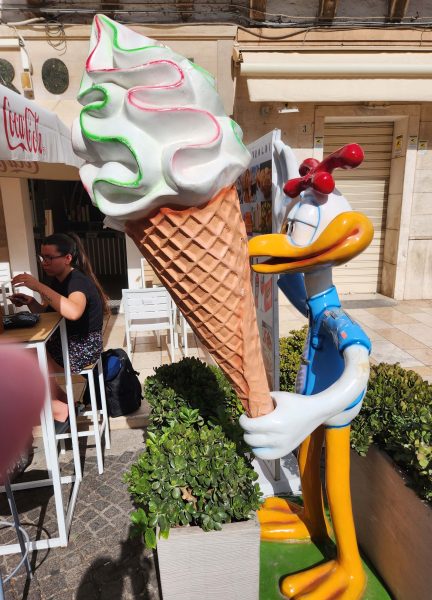
The streets in the old cities of Europe and the Middle East are very narrow and seem to meander at will. I assumed this was because they were established before the invention of automobiles but, just for fun, I searched “why do old European cities have such narrow streets?” and affirmed that I was right. (Insert a high five for me here.)
Streets were not included when the cities were first built; instead, buildings were erected and paths were formed among them by foot traffic. In time, those paths were paved–in my experience, mostly with lumpy, bumpy cobblestones or slippery paving rocks. Because the paved streets followed established foot paths, they really do meander through the cities. A little later in time, newer streets were made wide enough to accommodate a single horse and wagon for deliveries. Today, I think the narrow streets are described as “Old World Charm,” which sounds much better than simply “old.”
Personally, I like the narrow streets. They encourage the development of small shops and restaurants; they invite walking and slowing down to browse and relax; and they seem far more friendly and personal than modern wide sidewalks separated by even wider modern streets. It’s a given that these old, narrow streets will be filled with pedestrians, but sometimes it’s hard to believe my eyes when I see cars inching their way through these streets as well.
Enjoy the pictures of some of the narrow streets Ted and I walked on our 2023 BT.
Jerusalem, Israel
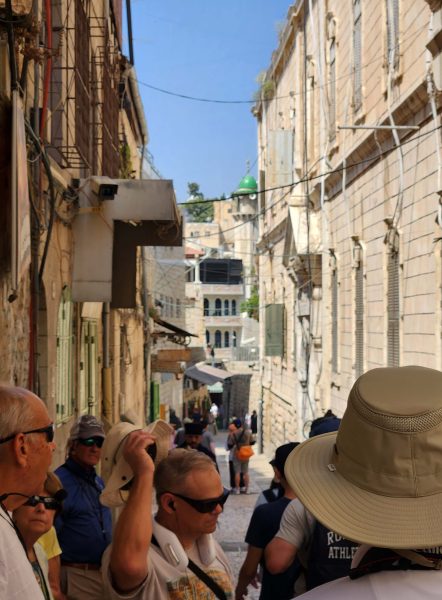
Corfu, Greece
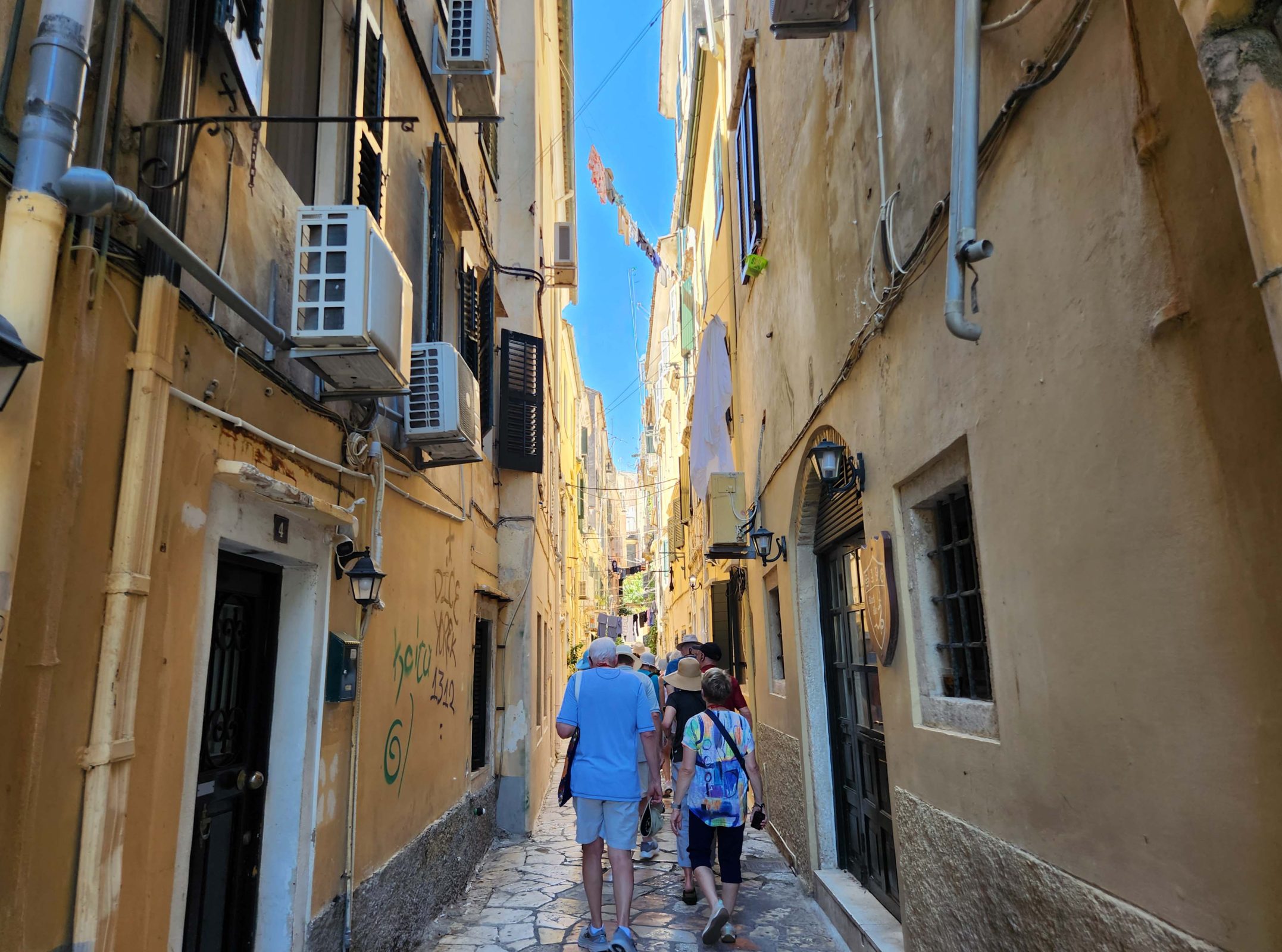
Split, Croatia
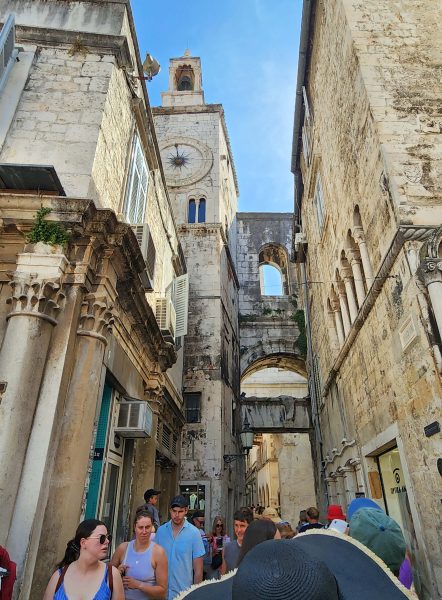
Skradinski, Croatia
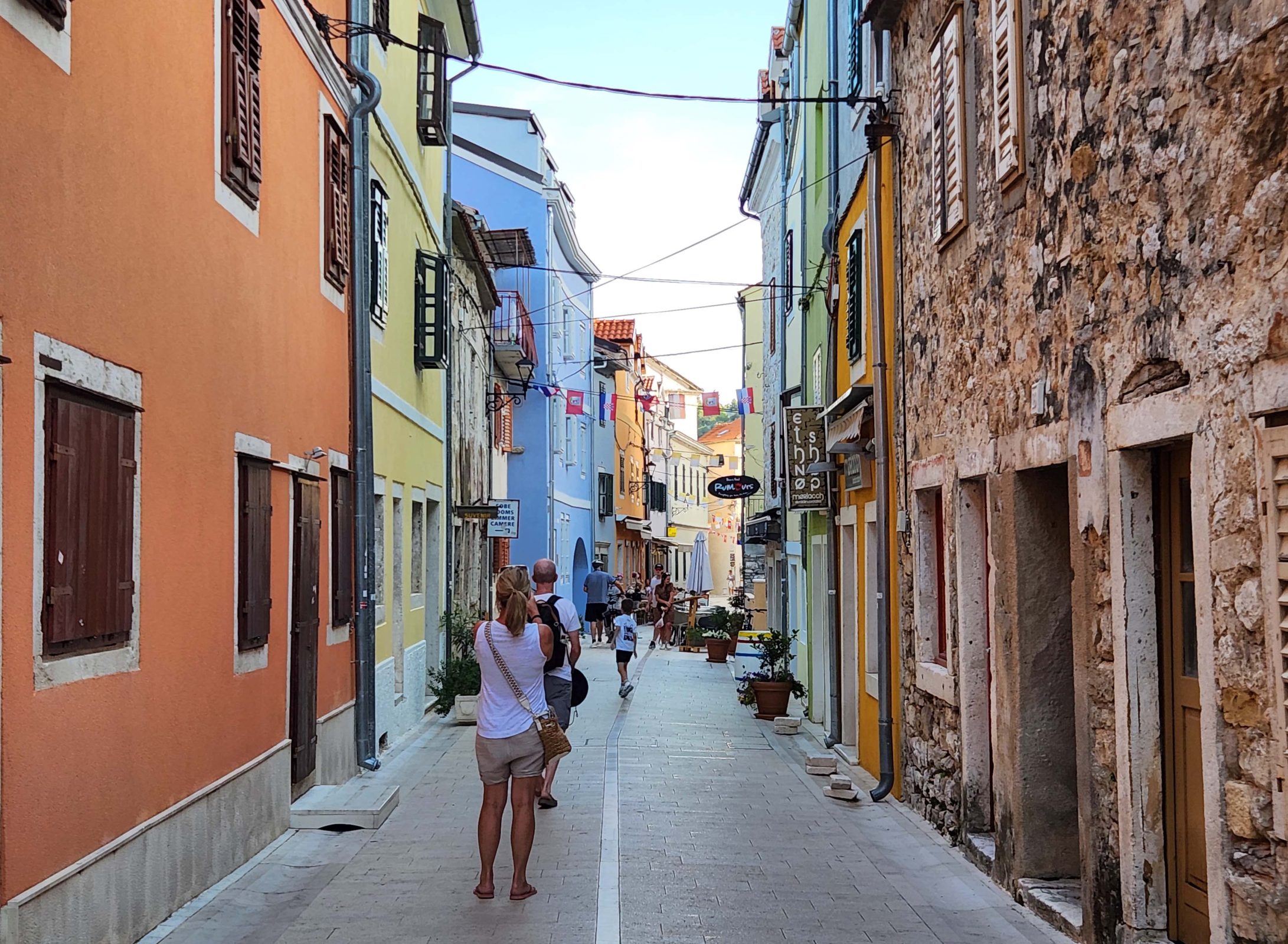
Venice, Italy
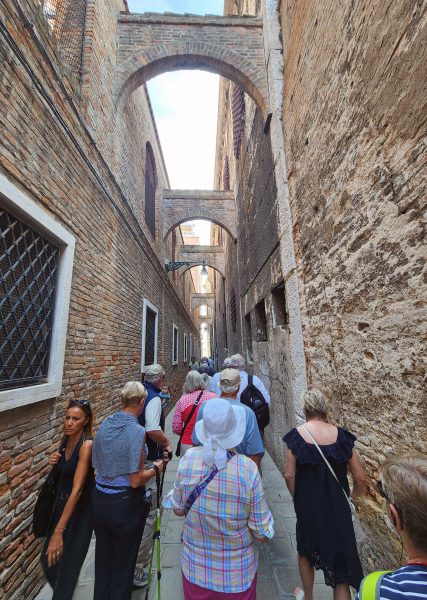
Taormina, Italy
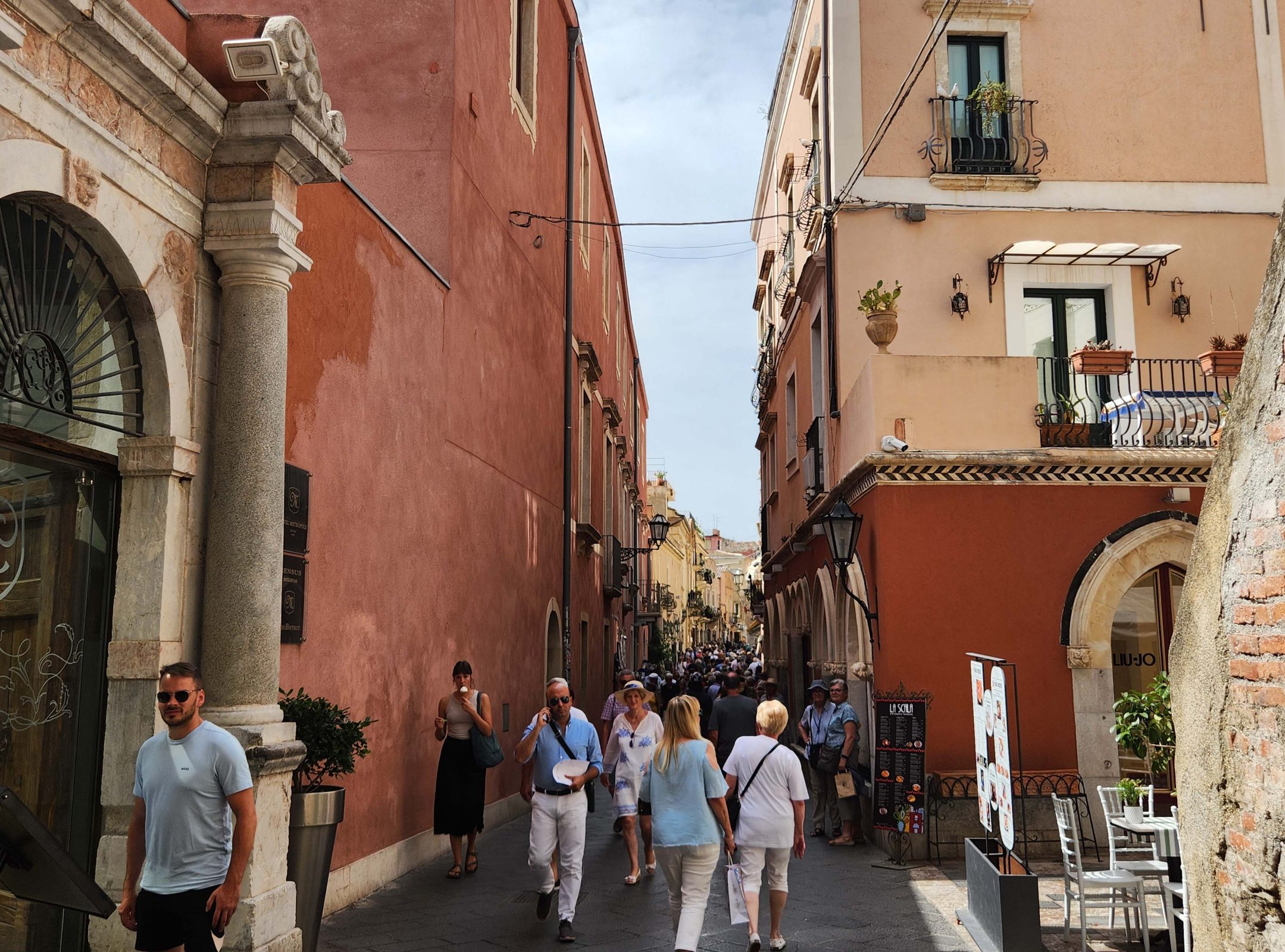
St. Remy de Provence, France
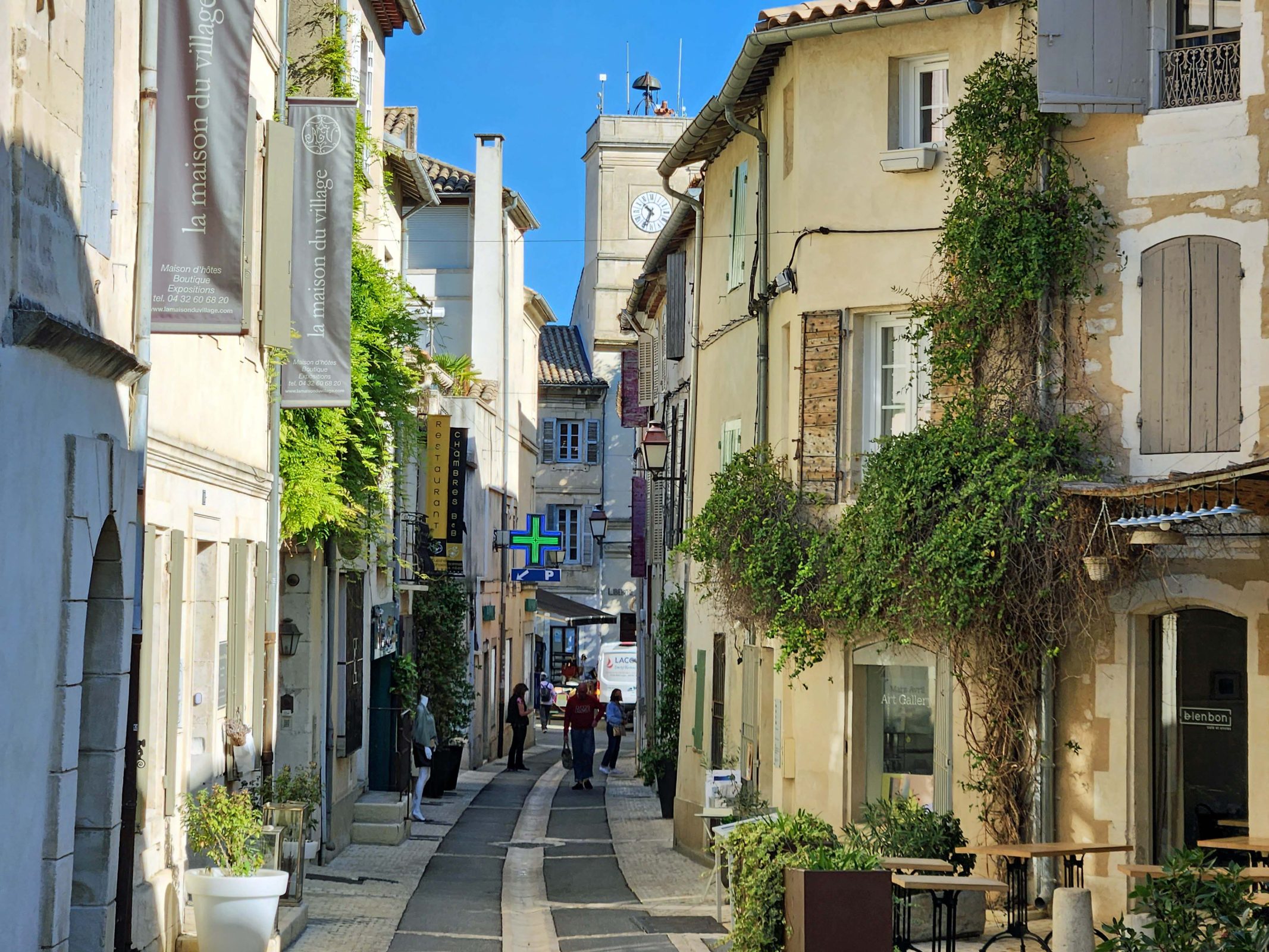
ŠIBENIK / KRKA NATIONAL PARK
Yes, we’re back in Croatia on our way south and around Italy. That’s no hardship, because it’s a beautiful country. Our ship docked in Šibenik, but we spent our day in nearby Krka (‘ker-ka) National Park and in Skradinski, Croatia. Here’s what the scenery looked like as we drove to the national park.

Krka National Park encompasses the entire 42 miles of the Krka River, which eventually runs to the Adriatic Sea. Here are some scenes from around the park.
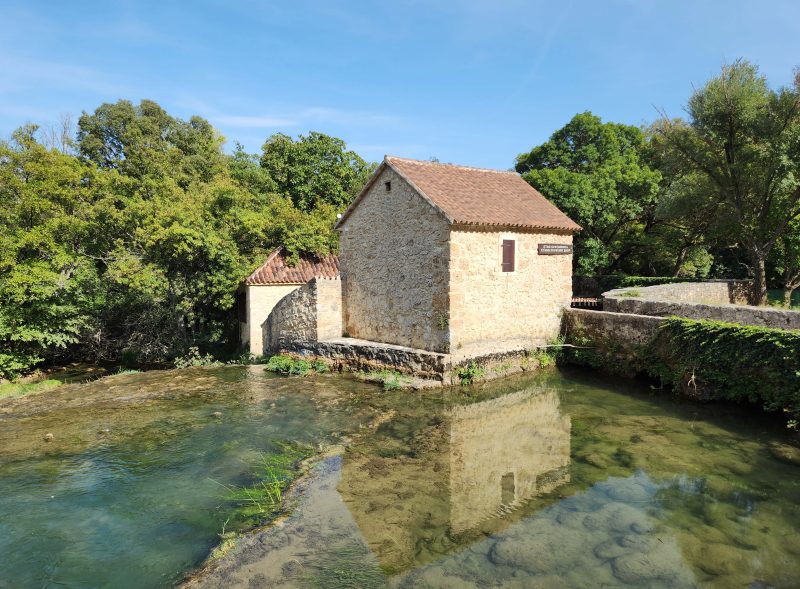


It was an easy walk today—a boardwalk with no cobblestones and only one long series of stairs. There are some hiking trails in the park, but our excursion did not include them.
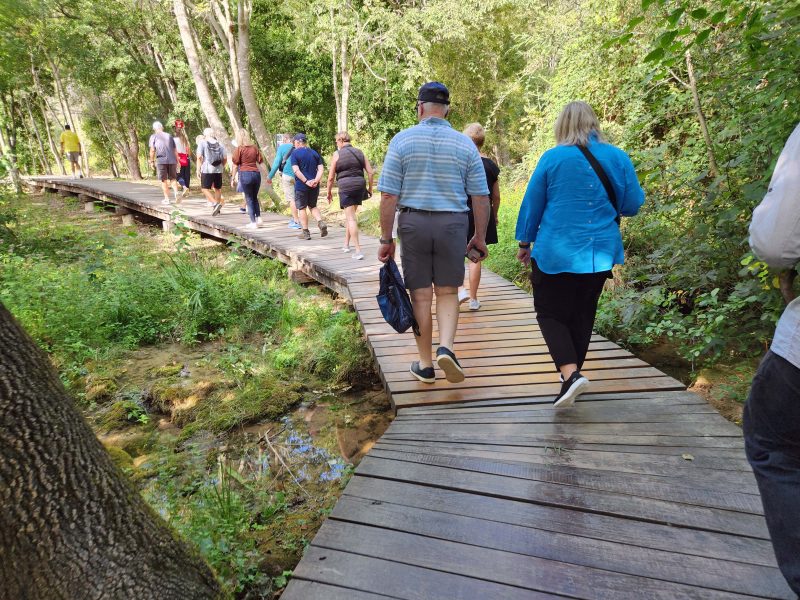
Travertine, a protected species, is a type of limestone deposited by mineral springs. Our guide pointed out the development of travertine, which begins as a mossy fern and looks like this while it’s growing on already-formed travertine rock.

The high calcium carbonate level of the water in Krka National Park helps the travertine fern to become rock. Our guide picked up a loose fern frond (it looks like a dead one) and a loose piece of travertine rock to show us. After we’d all seen it, she returned the pieces to their original places. It’s illegal to damage travertine because it’s so slow-growing–about 3 mm per year.
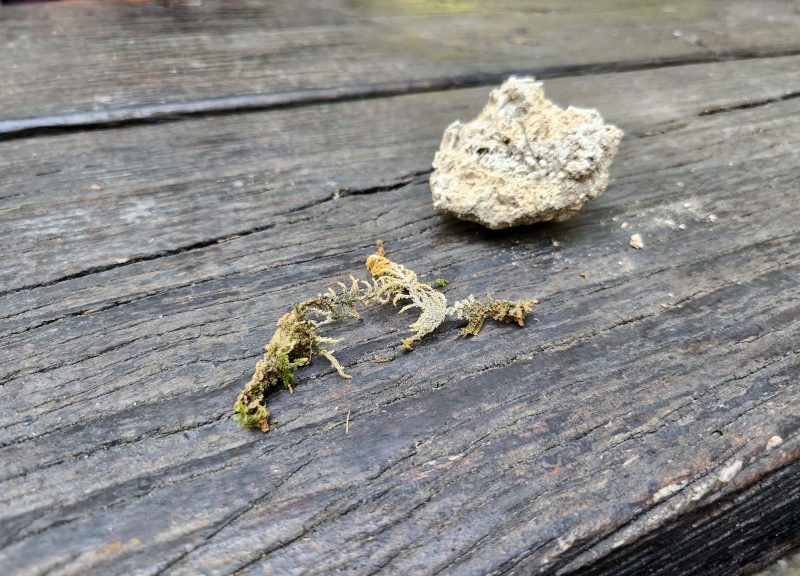
When polished, travertine looks like marble and is used for countertops, tables, buildings, etc. It’s very strong, so it’s a good insulator and suitable for building, but the downside is that it’s also very porous and deteriorates faster than other hard rocks like granite and marble. In addition, it’s a relatively high maintenance surface that requires sealing about every 3-4 months. This is what polished travertine looks like. The key to identifying it is the holes in its porous surface.


The highlight of our park tour was the Skradinski Buk, a clear, natural pool with high waterfalls at one end and cascades at the other. The waterfalls are 145 feet high and more than 2,000 feet wide. Within one-quarter mile on this stretch of the Krka River, there are 17 cascades and waterfalls with a height difference of 156 feet. That accounts for the series of staircases we climbed when our guided walk changed from downhill to uphill.
Water from the Krka River provides fifty percent of the area’s water supply. To preserve the Krka Falls when there is not enough water for the waterfall and for the power plant, the falls trump the power plant, and the power plant shuts down. There is sufficient water from other sources to meet the electrical needs of the community when this happens. You can see how clear the water is.

Look who visited the Skradinski Buk and the waterfalls today.
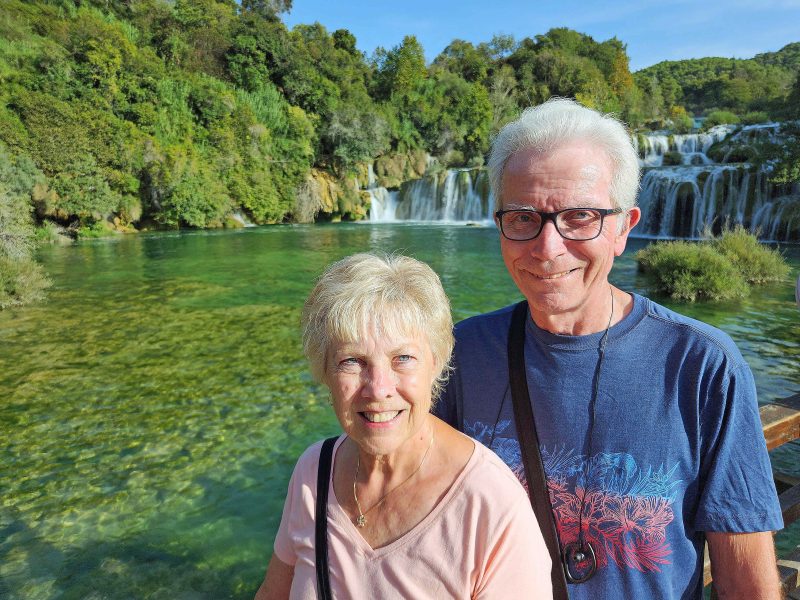
SKRADINSKI
After leaving the national park, we headed for the nearby city of Skradinski. passing more beautiful Croatian scenery along the Krka River.

Skradinski is another UNESCO World Heritage Site, so it has the same protections as Dubrovnik and Split. Notice the boxlike structures of the windows on the two orange buildings and on the yellow building on the right side of the street.
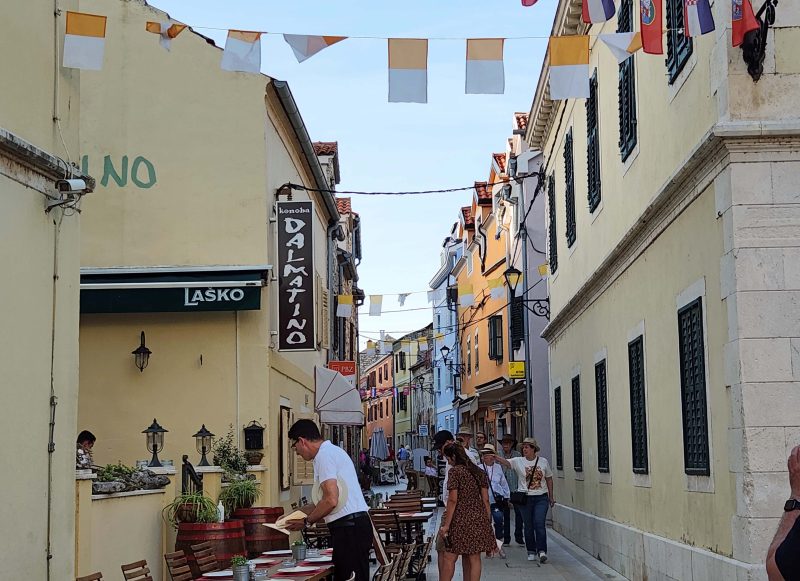
Here’s a close-up of the windows on the yellow building. It’s possible to look down through the bottom of the window box to see who is at the door below. Then you can decide if you really want to go down to let the visitor in—a precursor to the doorbell cameras of today.
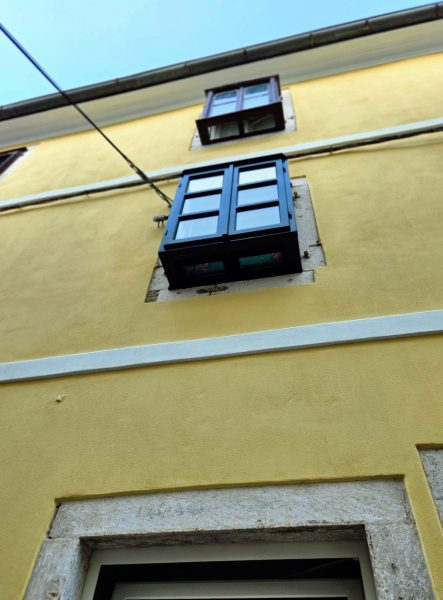
Here are some scenes from around the city.
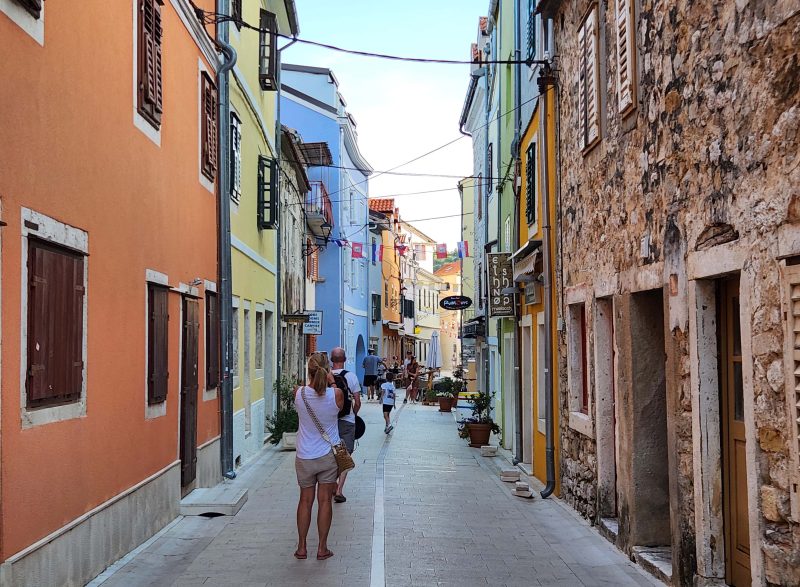
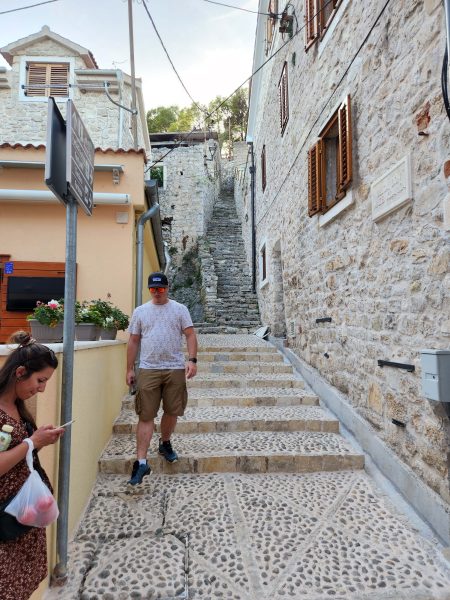
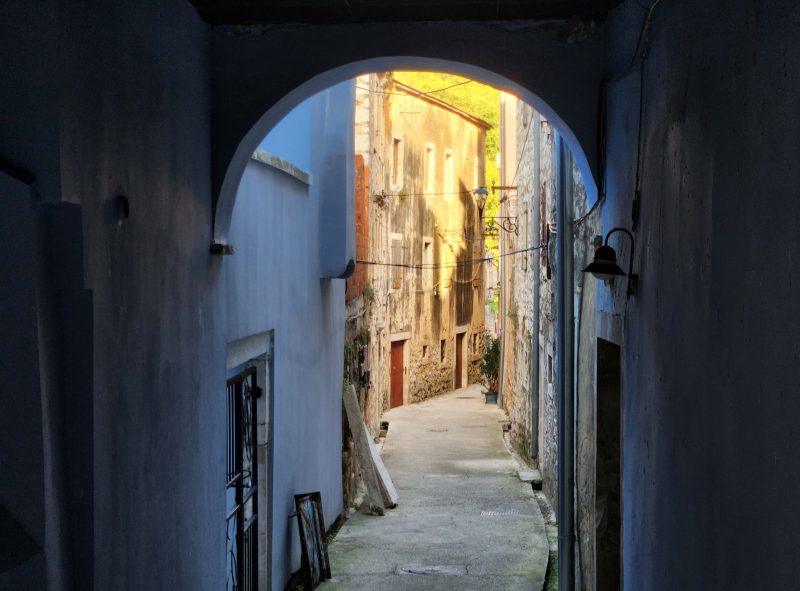
We stopped in one more small town just a short distance from Skradinski. Coincidentally, it was the hometown of our guide, who obviously lives near where she works. The town had a population of about 500. It was very pretty and not UNESCO protected, so there was a modern city park. I didn’t swing in this one. It wouldn’t have been fair to all the kids who were having fun on the playground equipment.
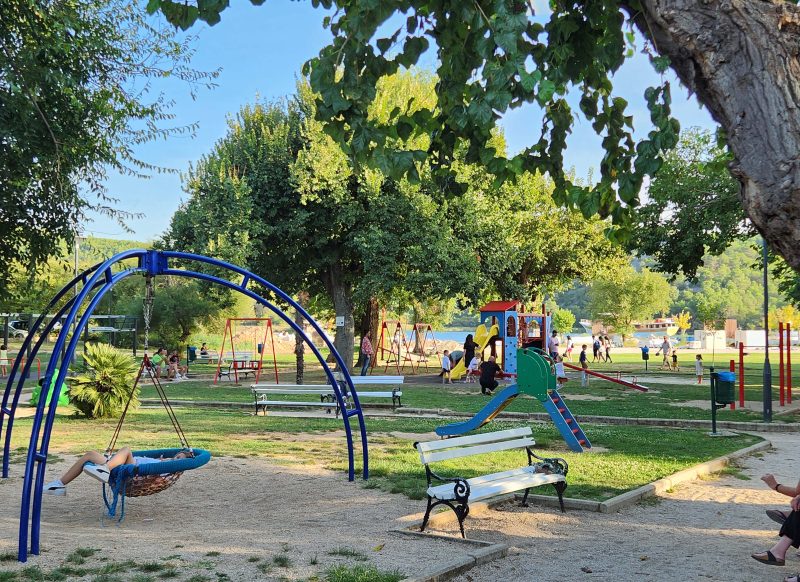
Murano, a small island just north of Venice, has been the home of Venetian glassmaking since the 13th century. It took 50 years to become a master glass blower, and masters usually began learning the trade in their early teens by working with their fathers and grandfathers. Glassmakers were so well respected in the 13th and 14th centuries that they had heightened social status. As of 1376, the law affirmed that if a glassmaker’s daughter married a nobleman, there was no forfeiture of social class, so their children were nobles.
In 1291, a law confined most of Venice’s glassmaking to Murano to remove the threat of a disastrous fire in Venice. Conveniently, this isolation had other benefits as well. First, it prevented the spread of Venetian glassmaking expertise to potential competitors, because either leaving the island without government permission or revealing trade secrets was a crime punishable by death. Second, the confinement simplified government monitoring of glass industry imports and exports.
Venetian glass is made with a soda-lime “metal” in an extremely complicated process that produces a shiny, rock-hard vitreous substance. The glass is typically elaborately decorated with glass-forming techniques, gilding (lots of 24-karat gold), enamel, or engraving. It’s breakable, but it’s more resistant to breakage than lead-based glass. The manager at the glass-blowing shop we visited held a beautiful Venetian glass goblet about 18 inches above a Venetian glass mirror and dropped it. It landed with a crash and a gasp from our group of observers, but neither the goblet nor the mirror cracked or broke. At the sound of the group gasp, the manager (the guy holding the microphone in the photos below) grinned and said, “I just love to scare people that way.”
The single stemmed glass that the manager dropped (or others like it) could be purchased for $155. A small jewelry pendant made of Venetian glass might cost around $30; a large vase can cost thousands of dollars. The high cost of Venetian glass is mostly due to the labor involved in making this complicated, heavily decorated glass; the price of the materials is a distant second. Ted and I looked at a glass sculpture that was about 15-18 inches high. We thought it would look nice on our dining room table, but $6,000 was too much to pay for it, even with free shipping. We were not allowed to take pictures of anything on display in the shop, but you can search “Murano glass images” to see what this kind of glass looks like.
One of the shop’s master glassmakers provided a demonstration of glassblowing. I’ve seen glassblowing demos before, but never by a glassmaker who worked this quickly. He made a vase in roughly two minutes.
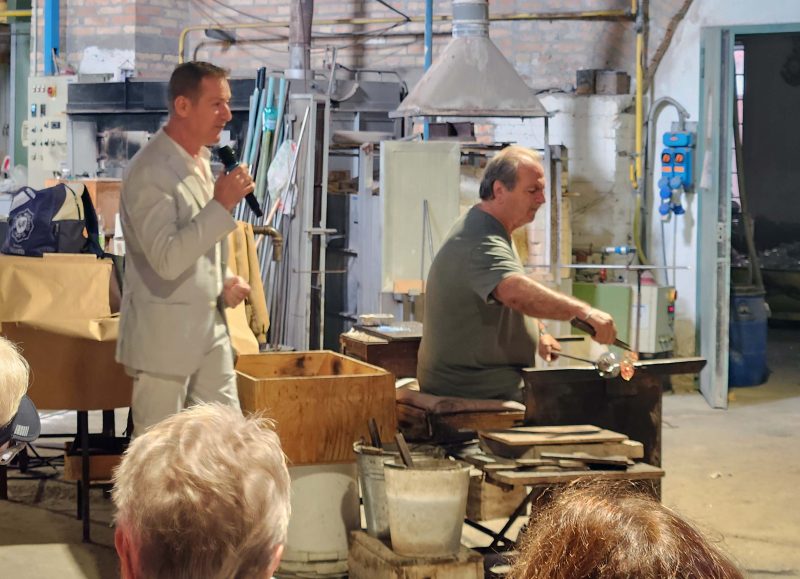
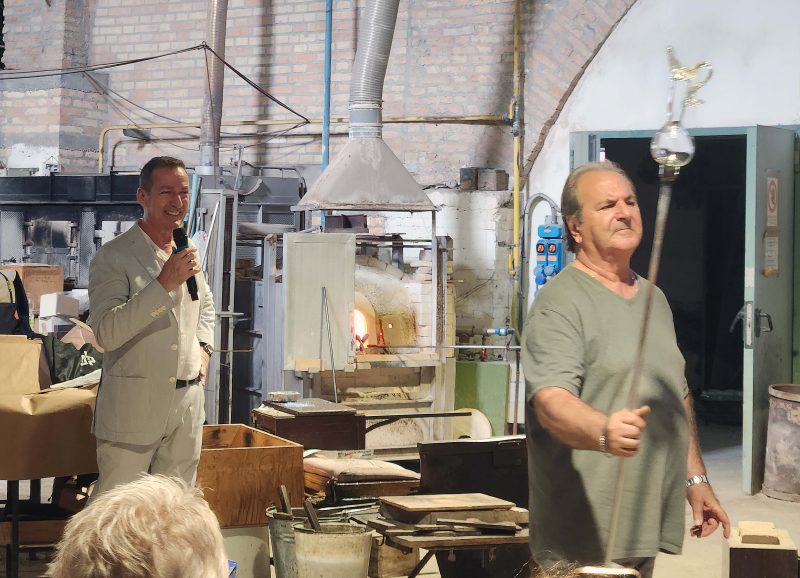
After the vase, the glassmaker shaped a prancing horse, a.k.a., a Ferrari horse, inspired by the original drawings of Leonardo di Vinci. Again, it took him about 2 minutes. He had a blob of hot glass, quickly tugged on it and bent it with his pliers, made a few quick snips, quickly pulled and sculpted it with another tool, then set it down to show us a glass horse with a flowing mane and tail.
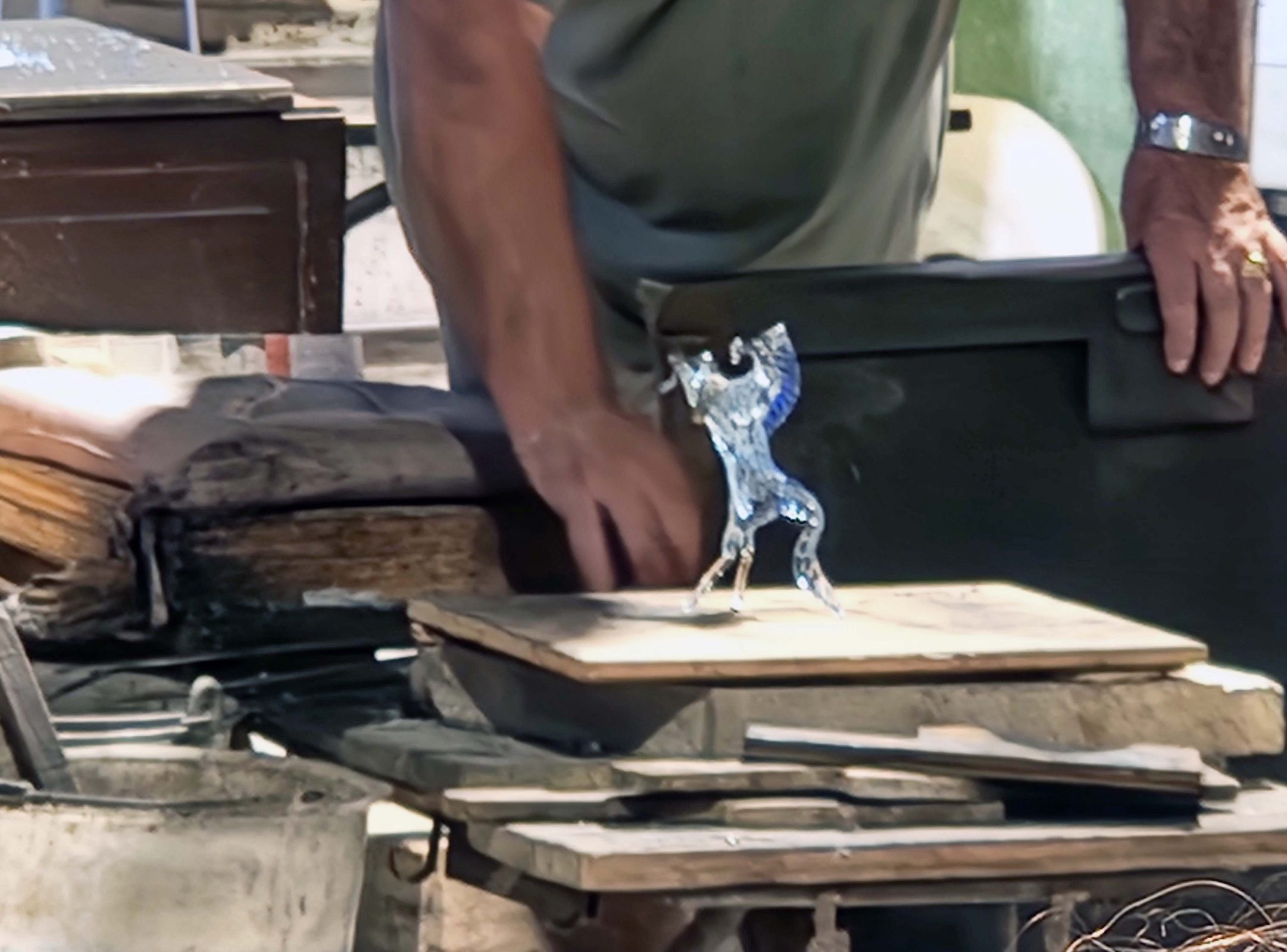
To demonstrate how hot the glass was after the horse was formed, the glassmaker dropped a piece of cloth on it. The cloth immediately burst into flames and became ashes. The moral of the story: Don’t touch hot glass! FYI, a larger Ferrari Murano glass horse costs $6,950. A small one like the one in my photo, sells for $3,995. You can buy them online.
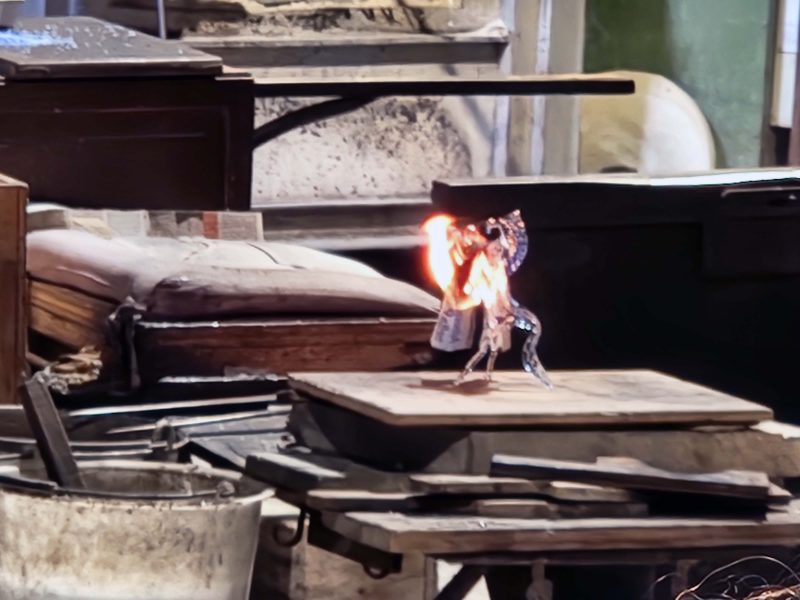
I found an internet video showing a Murano glassmaker forming a prancing horse, followed by an interesting comment.
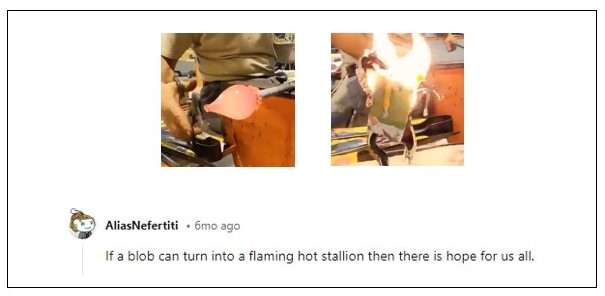
As our water taxi took us through the Venetian Lagoon to San Giorgio Maggione Island today, we saw a boat delivering new sofas to Venice.

This sculpture is called “Building Bridges.” It features six pairs of hands, each pair different from the others, bridging the water as a symbol of the commonality humans share. Each pair of hands depicts one of humanity’s six universal values: Friendship, Faith, Help, Love, Hope, and Wisdom.

San Giorgio Maggiore (St. George Major) Island is very small and has a very large 16th century Benedictine church. The church is a counterpart of St. Mark’s and faces St. Mark’s Square across the basin in Venice. There wasn’t much room to take pictures of the church, so I pulled this one from the internet. In addition to the church, the island is the headquarters of an arts center and an open-air theater, and is also known for its library. The island and the church are popular subjects for painters and are featured in some of Monet’s paintings.

This is a closer view of the front of the church, which you can also see in the picture above.

The interior of the church is very white and very bright. It features massive columns in the nave.

This is one of the small chapels within the church.

There are 48 choir stalls in this apse, and each one is carved with a scene from the life of St. Benedict.

A statue similar to this one of St. George, made of wood and bronze, used to stand on top of the bell tower at the church. Lightning struck the statue during a wedding and the wood caught fire. It is unknown if that was a bad omen for the bride and the groom. Much later (many years?—also unknown), a man said he saw an angel, just like the one that was struck by lightning, hovering over the church. Could that be a good omen? Again, unknown. The hovering angel turned out to be a helicopter setting a replacement statue on the bell tower. There may be no deeper message here than “a statue was struck by lightning, burned, and was replaced,” but the omens and the hovering angel contribute to a nice little story.
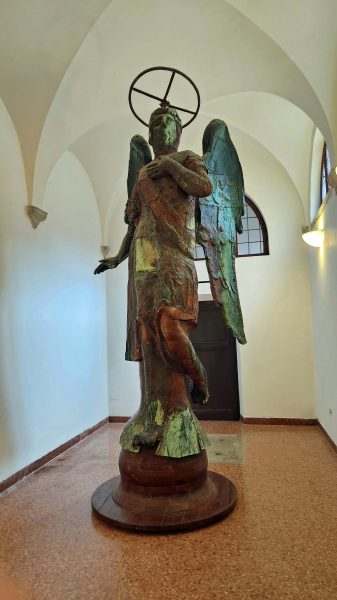
I don’t remember if this particular sarcophagus and/or statue is St. Stephen, but the church claims to have the relics of St. Stephen in its possession. Several other churches make a similar claim. If all the claims to St. Stephen’s relics are true, St. Stephen had 2 heads, 4 arms, and 3 legs. At one point, the Pope of the time said that the relics in these churches will work with prayer as long as the people who are praying believe they are the true relics.
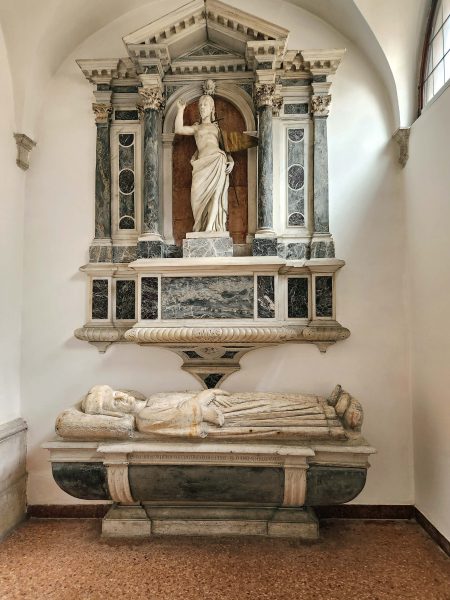
The church has two magnificent paintings by Jacopo Tintoretto: The Jews in the Desert and The Last Supper. I took photos of them, but they were so large (more than 12 by 18 feet) and hung so high, that my pictures weren’t very good. I found them online and was surprised to see that they are available for downloading if I provide the following credit:
By Jacopo Tintoretto-Web Gallery of Art: Image.
The paintings looked much brighter in person, and their size added to their impact. Both have dozens of symbolic representations. Simplified, The Jews in the Desert, painted in 1593, depicts the Israelites’ scorning of the manna, which led to setting up the bronze idol. The Israelites are washing their clothes at the foot of Mt. Sinai; Moses and Aaron are talking in the lower right corner.

Again, simplifying the symbolism in the painting, The Last Supper, painted in 1594, shows winged apparitions that characterize the Eucharist (the bread of angels) and the mystery of transubstantiation (turning bread and wine into the body and blood of Christ). Jesus has a large halo; eleven of the disciples have smaller halos (Judas does not); and John, the beloved disciple, sits to the right of Christ. There are conflicting opinions about which figure is Judas.

I was impressed and moved by Tintoretto’s paintings, but my favorite piece of art in the church was “Belonging,” a bronze installation with crowns of thorns in the center. It is positioned under the dome of the nave. Our entire group thought the base was a mirror because it so perfectly reflects its surroundings, but our guide told us she discovered it is water because, one time when she was conducting a tour, the installation had been drained. It looked so still and so solid that I was tempted to dip my finger into it for proof of its liquidity, but I knew it would take forever for the surface disturbance to disappear—and I’d probably be ejected from the building. That might have been a not-so-good travel story to tell.
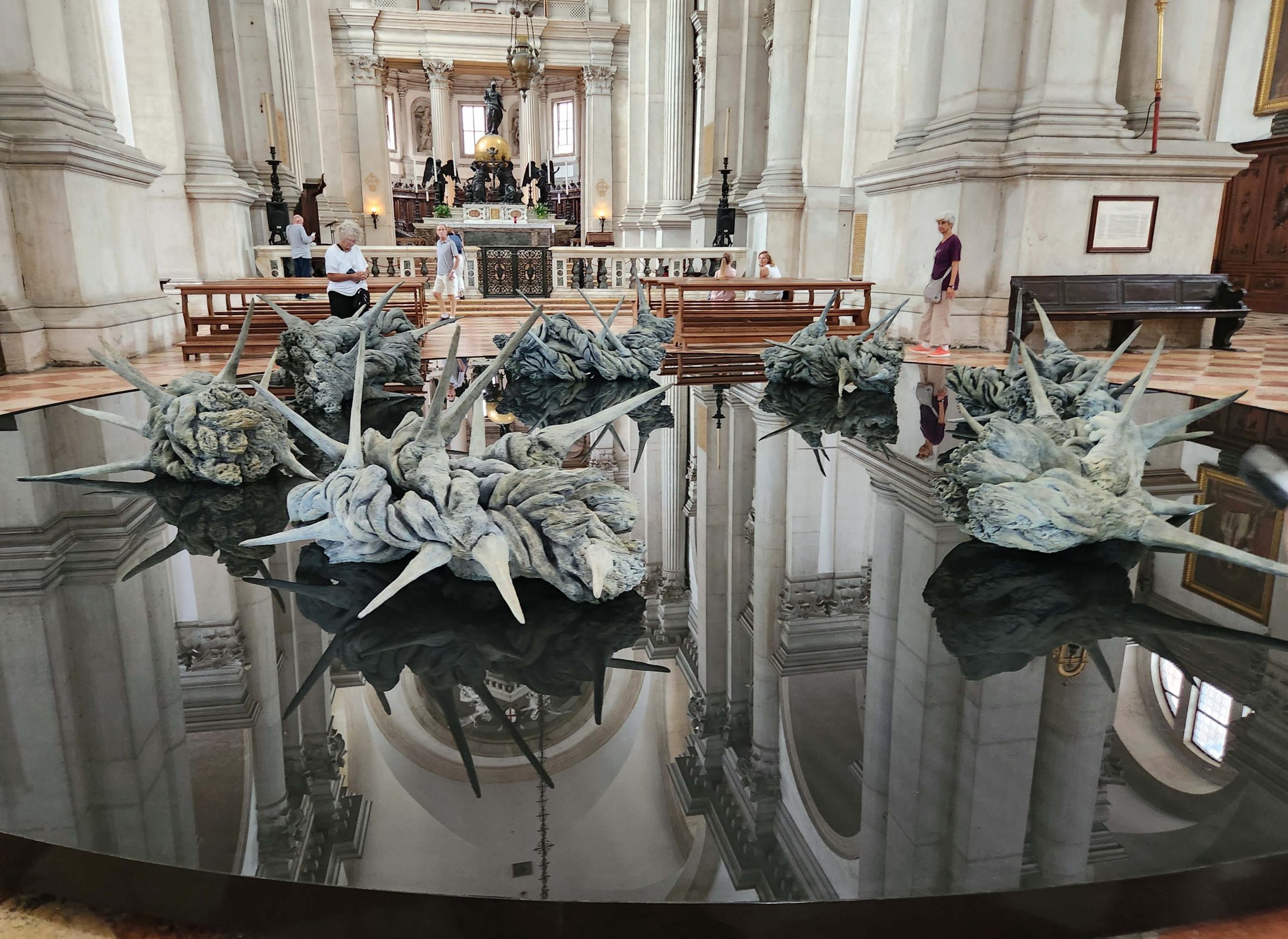
Like Venice, Chioggia is built on wooden piles in the marshy Venetian Lagoon and, because of its canals and bridges, it is often called “Little Venice.” There were fewer canals and fewer bridges in Chioggia, but the city was definitely reminiscent of Venice.
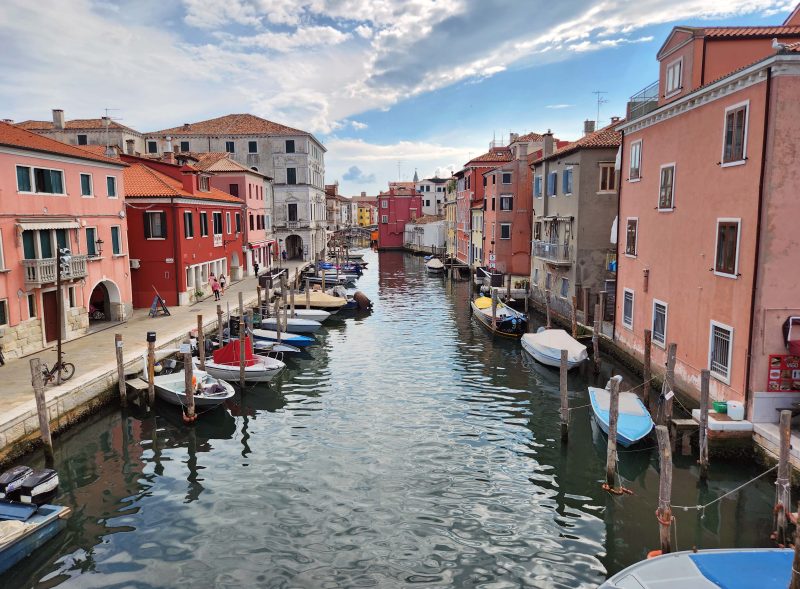
Along this canal, you can see decorative laundry hanging outside the windows of one home, just like in Croatia.

Ted and I spent over two hours walking around Chioggia. It was about a mile from our ship, but it was a pretty walk and even included a bridge over a canal. There were lots of bicyclists, families, and tourists doing the same thing we were doing: enjoying a relaxing day in a charming city.
The main street was a typical main street with shops, cafés, pharmacies, etc. We saw this pretty flower shop and were surprised to learn that all the flowers sold here are artificial, because they looked so real.
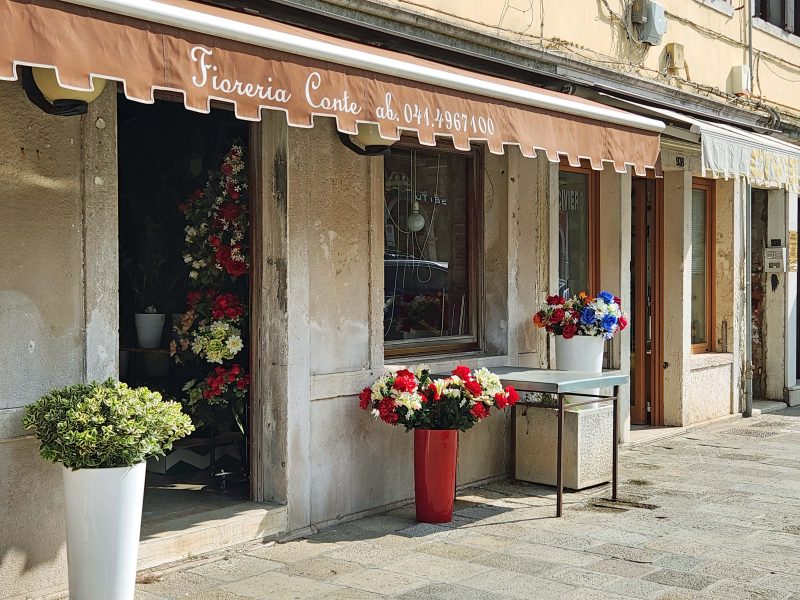
About a half-mile stretch of the main street was dedicated to cafés on one side, with shops on the opposite side. This must be a safe city. There are two bicycles parked in front of one of the cafés and they are not in a bike rack, they are not locked in any way, and no one is sitting immediately beside them to watch them.
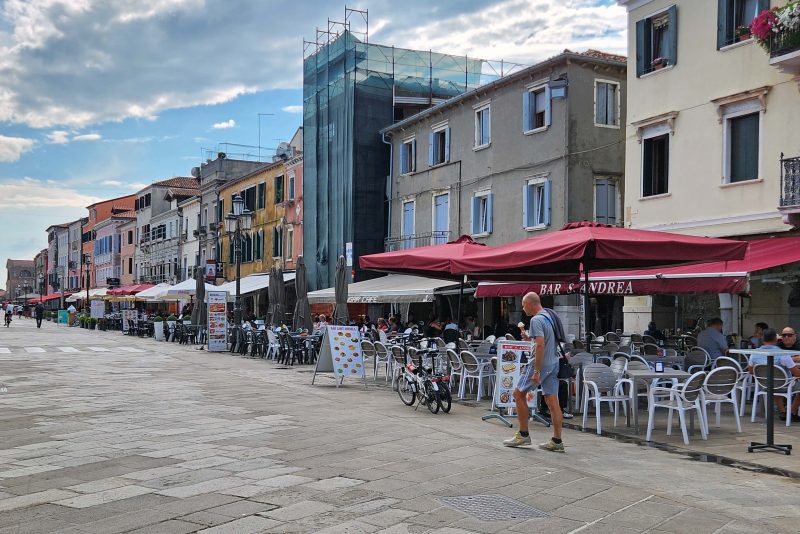
Maybe these cafés didn’t fit on the main street. They were around the corner on a side street. FYI, “No bici” means “no bicycles,” of which there were many in the city.
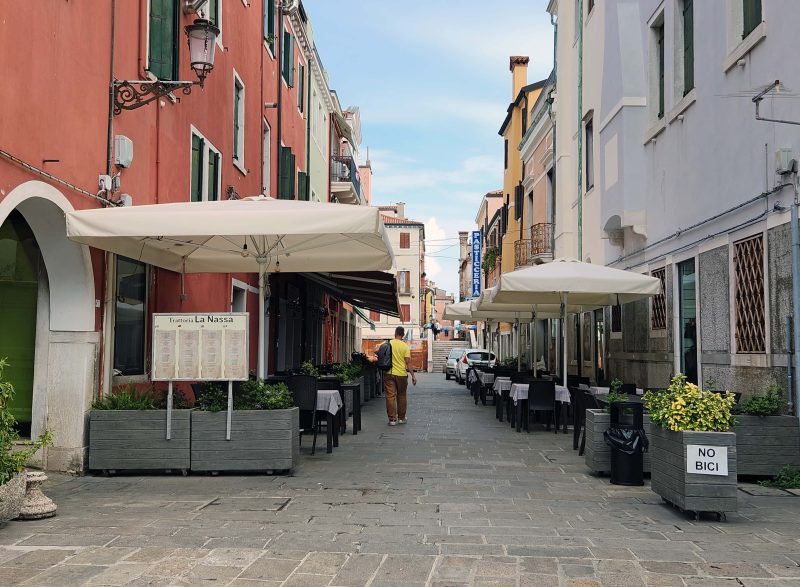
The city dock for small watercraft was at the end of the main street. The dock was also an entrance from the Venetian lagoon to the city canals. About a block inland from the dock, there was a bridge over the entrance canal and there were benches on the bridge. Ted and I just sat there for awhile, talking with each other, and enjoying the beautiful weather and the views of Chioggia.
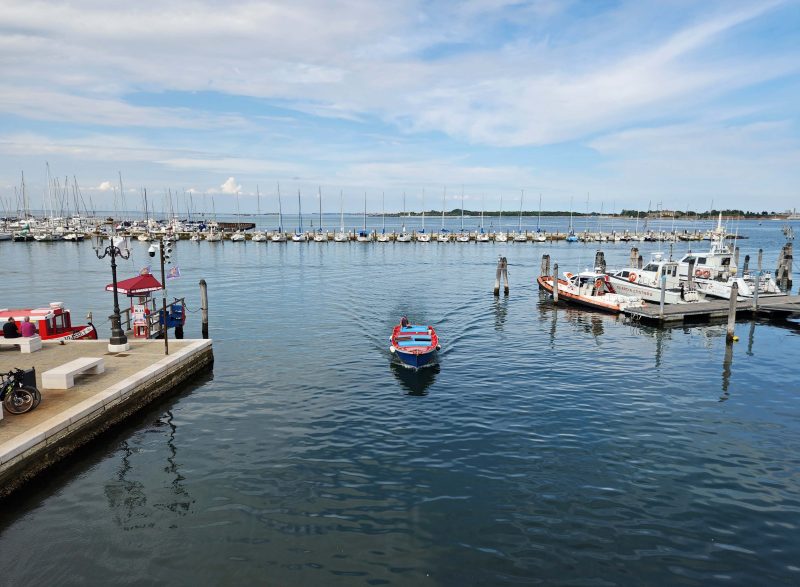
Cruise ships are no longer allowed to dock in Venice for several reasons. Environmentally, they cause pollution in the lagoon, and the waves they generate are eroding the underwater structure of the city. They are also dangerously large.
Venetian citizens opposed to cruise ships docking at the city port won their case in 2019, when a large 100,000-ton 13-deck cruise ship experienced engine failure while docking in Venice. Two tugboats were assisting the ship, but lacked sufficient power to control it. The cruise ship slid against a sightseeing boat just as passengers were disembarking over a short gangplank. People were caught on the walkway as the smaller vessel was dislodged from the pier, and five people were injured falling or trying to run away.
Cruise ships now have a choice of two nearby ports at which they may dock for passengers to visit Venice. One of those ports is located in an industrial area about 30 minutes from Venice by water taxi; the other is located at least 1.5 hours from Venice by water taxi, but it’s in the charming city of Chioggia, where our ship docked. The water taxi ride could be completed in less time, but there is a 12 mph speed limit in the lagoon to prevent erosion from strong wakes and to reduce noise pollution for residents along the lagoon. (For the record, I totally support Venice’s policy changes.)
Venice is in the upper center and Chioggia is in the bottom center of the map below. The larger of the two islands just north of Venice is Murano, the home of Venetian glassmaking and the destination of an upcoming shore excursion for Ted and me. There’s a narrow horizontal island on the south side of Venice with a tiny island at its eastern tip. That tiny island is San Giorgio Maggione Island, another upcoming excursion destination for us.
The water taxi took us for a scenic cruise from Chioggia to Venice through the Venetian Lagoon on the inside of those long, narrow islands shown in the center of the map. The gray line along the edge and running the length of the long islands might be a road, but we saw walkers and bicyclists—not cars—on it.

All the way from Chioggia to Venice, the long islands were dotted with colorful villages. In some places, we could see across the islands to the water on the other side.
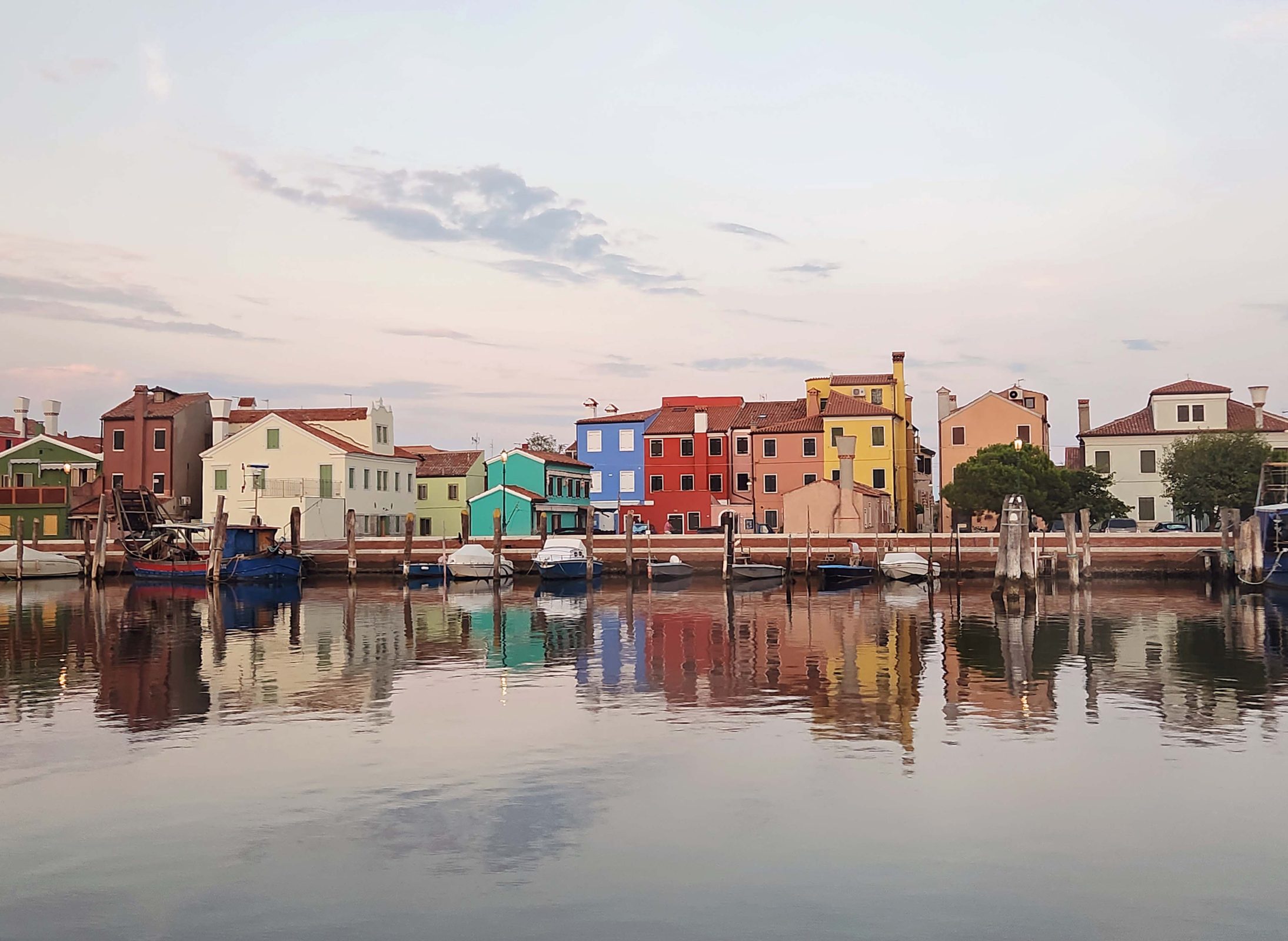
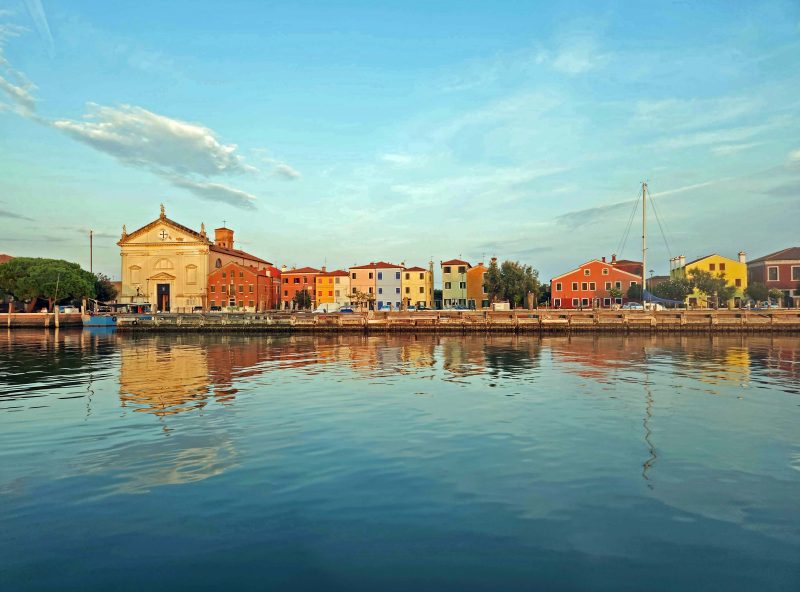
The colorful villages were on our right and there were fishing shacks and wooden triad channel markers on our left as we traveled to Venice. Each wooden triad has a numerical location marker nailed to it. Before the convenience of GPS, boaters in need of assistance or rescue could radio a rescue team and give them the number posted on the nearest triad to direct the rescuers. The triad in the second photo below is marked number 122.
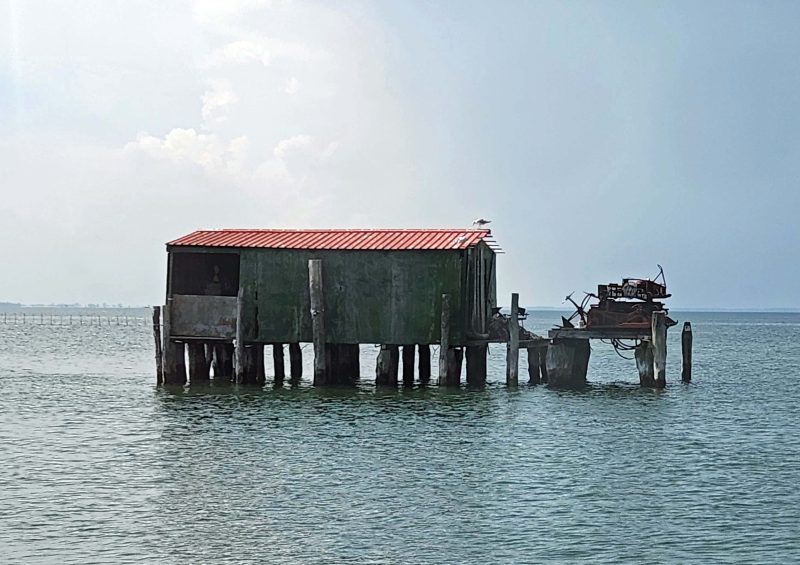
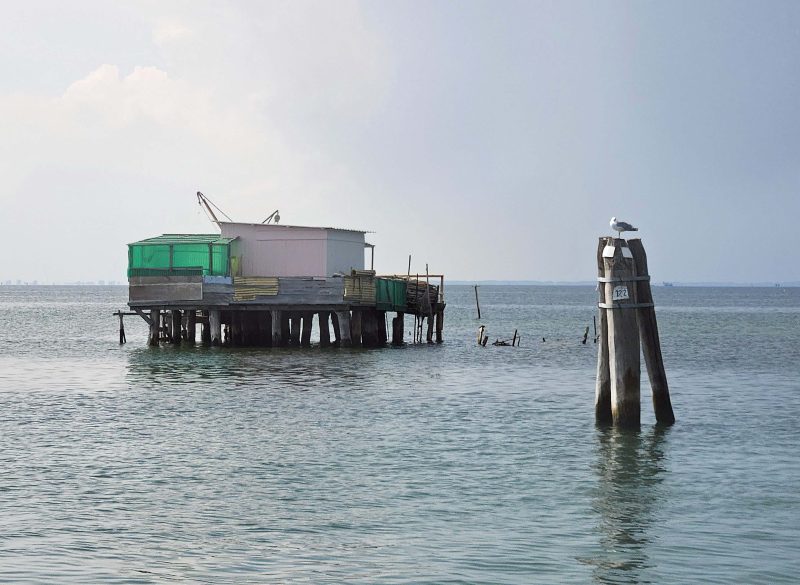
Ted’s and my first sight of Venice included (for my meteorologist husband) an anvil cloud. We were lucky, though—the thunderstorms stayed north of Venice, and we had a sunny day.

The white, red-roofed building on the left is Venice’s old Customs Building and includes a museum inside. The large dome is the Santa Maria della Salute Church, commonly known as the Salute.

The Bridge of Sighs is the arch in the left center of the picture below. The red building on the left used to be the courthouse where criminals were tried and sentenced. The building on the right is wrapped and under construction now, but was formerly the prison. Convicted and sentenced prisoners were taken directly from the courthouse to the prison, and crossing the Bridge of Sighs was their last taste of freedom.
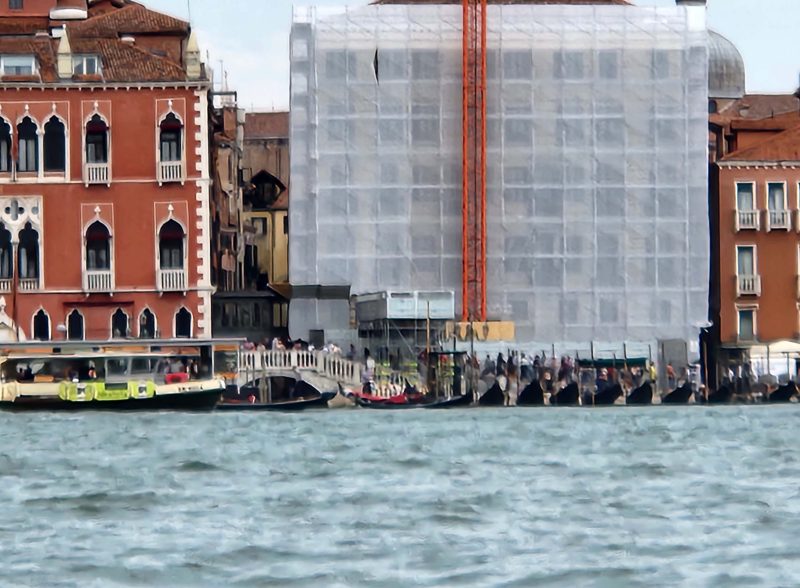
St. Mark’s Square (the Piazza San Marco) is the most renowned piazza in Venice. The bell tower is an iconic landmark of Venice. The light colored building is St. Mark’s Basilica. I took this picture of the piazza from San Giorgio Maggiore Island.

This picture was taken up close while standing in St. Mark’s Square. All that white on the right side of the photo below is part of the front of St. Mark’s Basilica. You can tell by the crowd that the piazza is a popular place.
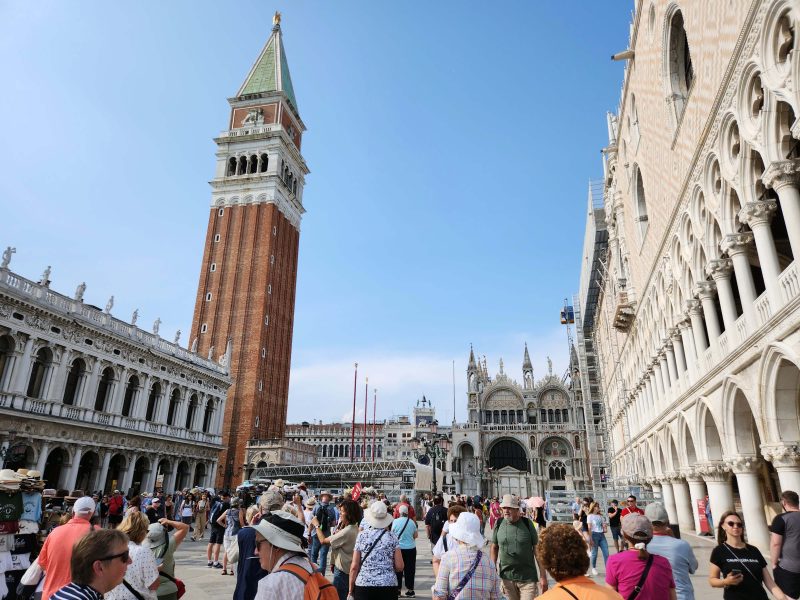
This is the main entrance to the basilica. It faces the bell tower and is in the invisible foreground of the photo above. The basilica is huge, and the piazza is small, so a view of the entire front doesn’t fit in my camera lens.
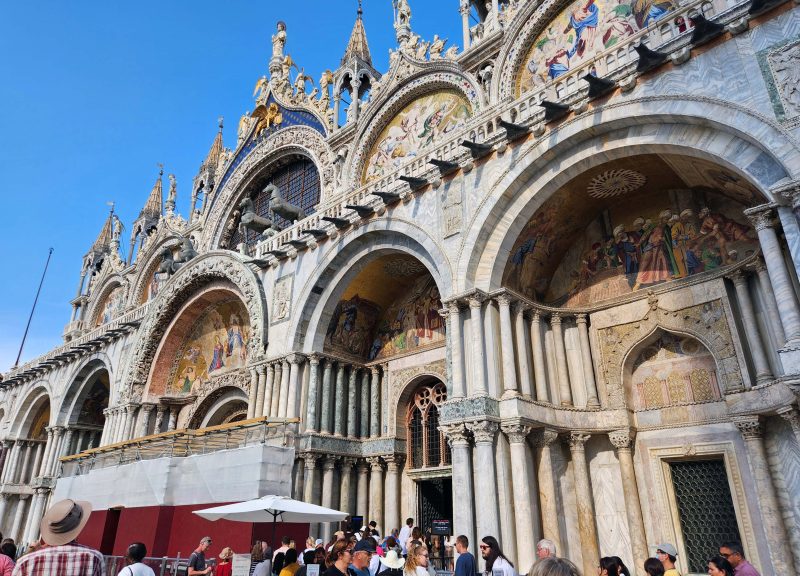
This photo shows the Clock Tower in St. Mark’s Square.
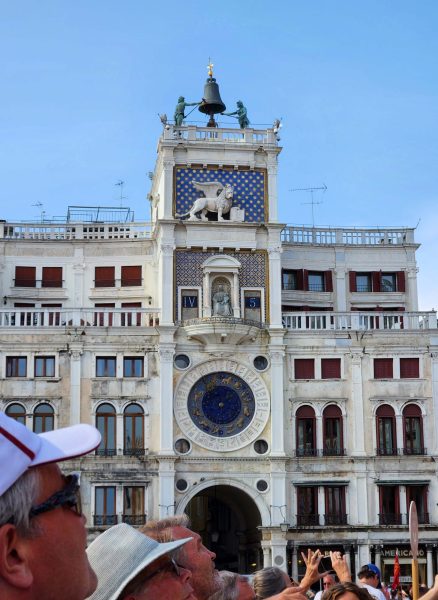
Venice is an archipelago of 118 islands, separated by canals and linked by over 400 bridges. If you cross a bridge, you’re walking to a different island. Because Venice is set in a marshy swamp (who picked this location???), it is a floating city, built on huge wooden piles driven deep into the ground, down to where there is hard clay strong enough to support the buildings. Still, you can’t fight Mother Nature, so Venice is sinking at a rate of about 2mm per year, and research shows it is also tilting slightly.
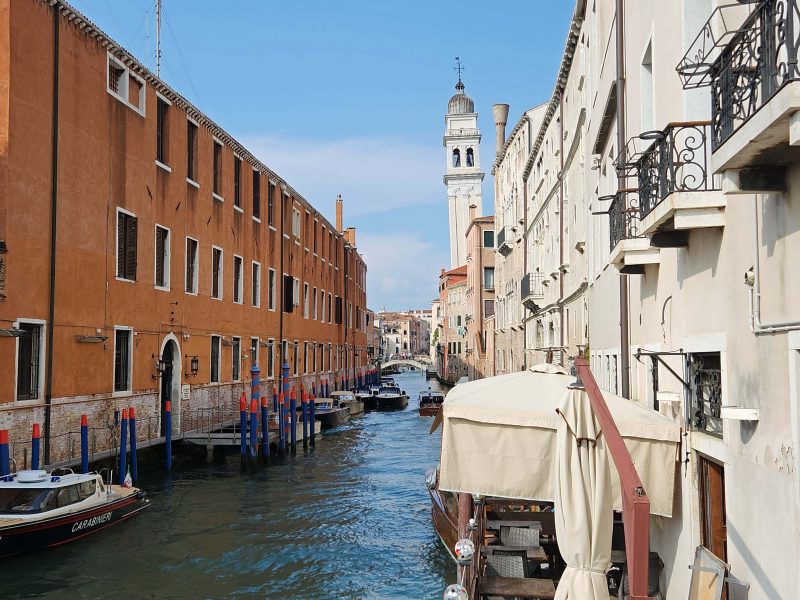
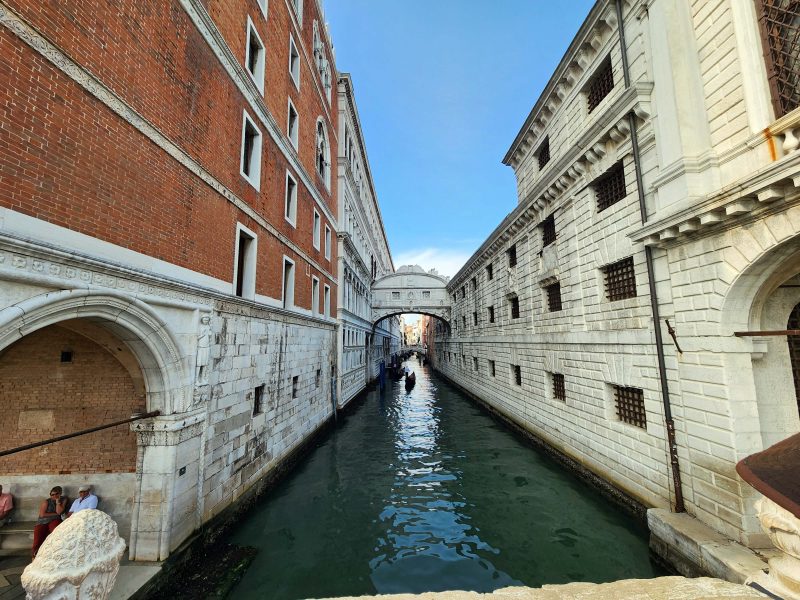
The gondolas of Venice with singing gondoliers sound so-o-o romantic until . . . you see traffic jams of gondolas without the slightest note of song in the air. A 30-minute gondola ride costs about $90 per person during the day and about $130 per person at night. They looked as romantic as a ride at Six Flags, but apparently, the spirit of riding in a gondola in Venice must be taken into account.
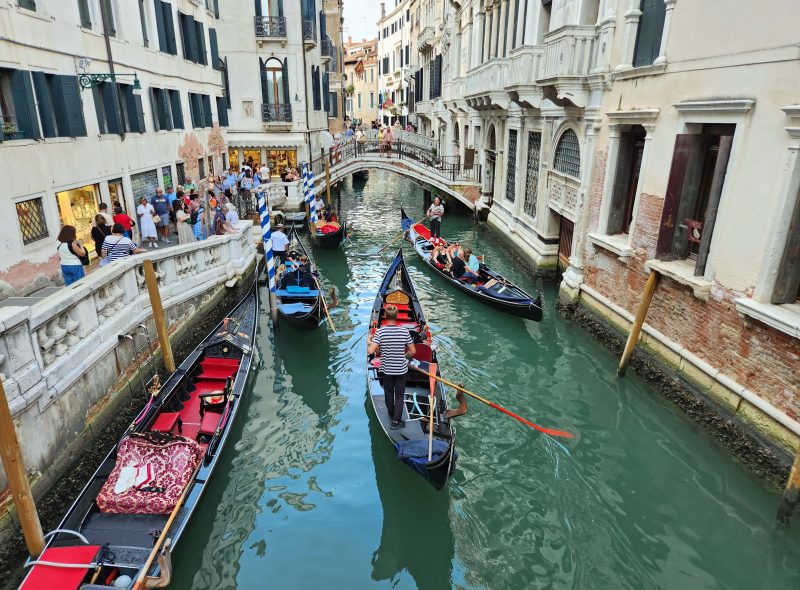

The area of Venice is surprisingly small. Nearly all of the city is within a 20-minute walk from St. Mark’s Square, where we started. Ted and I were surprised to find ourselves at the other end of the city so quickly. Luckily, there were a lot of interesting streets, so we just walked wherever it looked interesting, knowing that it would be easy to find our way back to the water taxi dock.
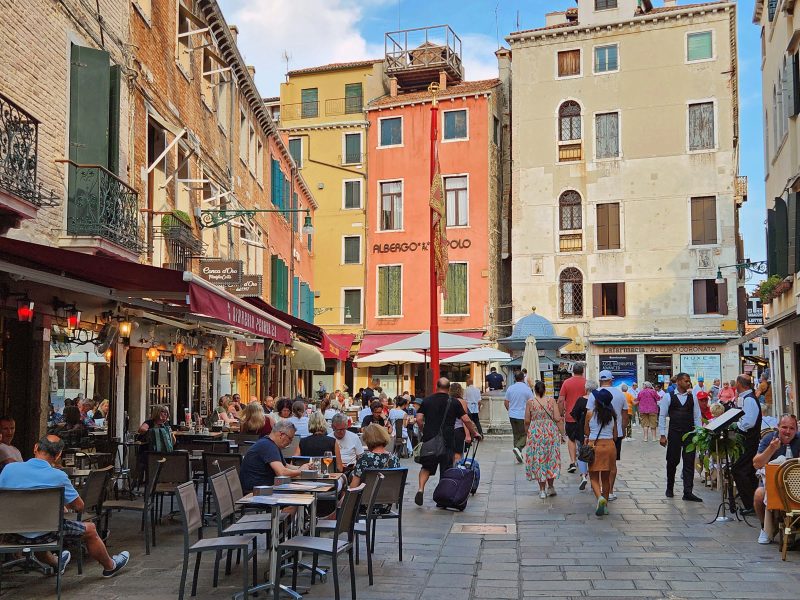
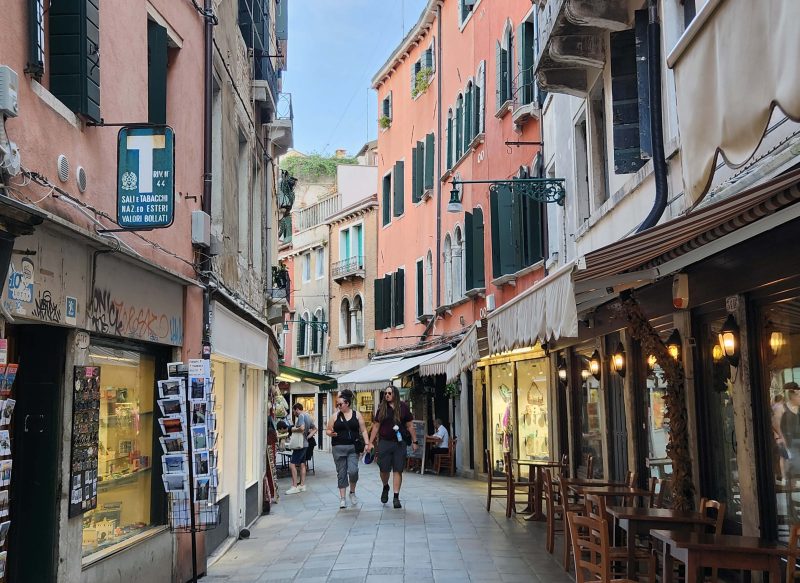
Today, we learned about gelato. If you’ve ever seen trays of gelato temptingly heaped above the upper edge of the tray, so that just thinking about having some of that tempting gelato makes you drool, stop drooling. That’s “tourist gelato” according to Italians. “Real” gelato, for those with discriminating taste, is always low in the tray, requiring you to lean over to see it and to pick your flavor. During our stroll around the city, Ted and I stopped at a sidewalk café for a cool dish of gelato. I don’t know if the waitress brought us “real” gelato or “tourist” gelato, but it tasted good on a warm afternoon in Venice.
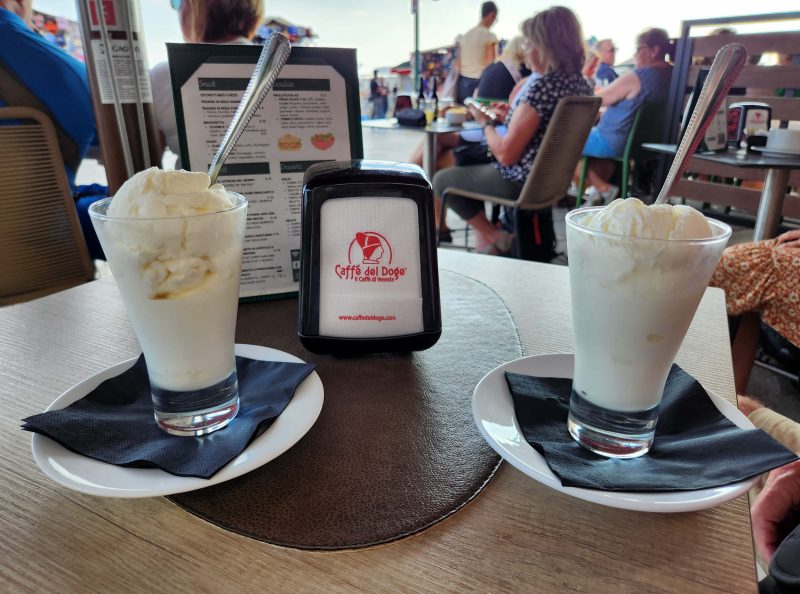
Ted and I are not the people who make vendors rich. Although we’ve bought things in some of the places we’ve visited, it’s not our mission to purchase a souvenir from every place we visit just to prove we were there. Venice turned out to be one of the places we bought something.
Almost as soon as we arrived in Venice, we saw a sidewalk artist’s display and both of us said, “I like that picture.” It isn’t large, so we knew it would fit in our carry-on size suitcase, but we didn’t account for the protective cardboard the vendor slipped it into. Thanks to security checks, we don’t travel with scissors, but the Guest Services folks on our ship had scissors and a box cutter, and they cut the sturdy cardboard down to our suitcase size. Now the picture is hanging in our dining room.
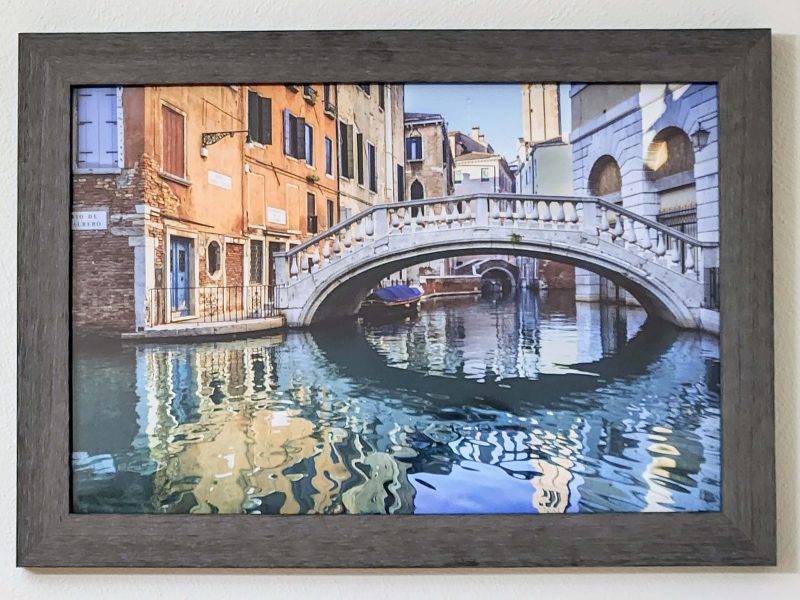
People everywhere have a great sense of humor and I enjoy finding evidence of that when we travel. On Ted’s and my 2023 BT, I found lots of things to smile or laugh about. Here are a few.
We visited several spice markets in Egypt. (FYI, they smell really good!) At a group dinner in a Cairo hotel, this sign had the wrong English homophone for the name of the spice. Or maybe it was a cold powder.
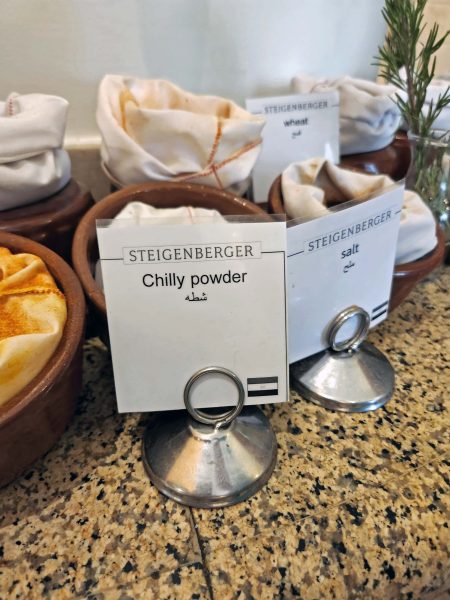
Want a cup of coffee? Stop at Squarebucks in Jerusalem.
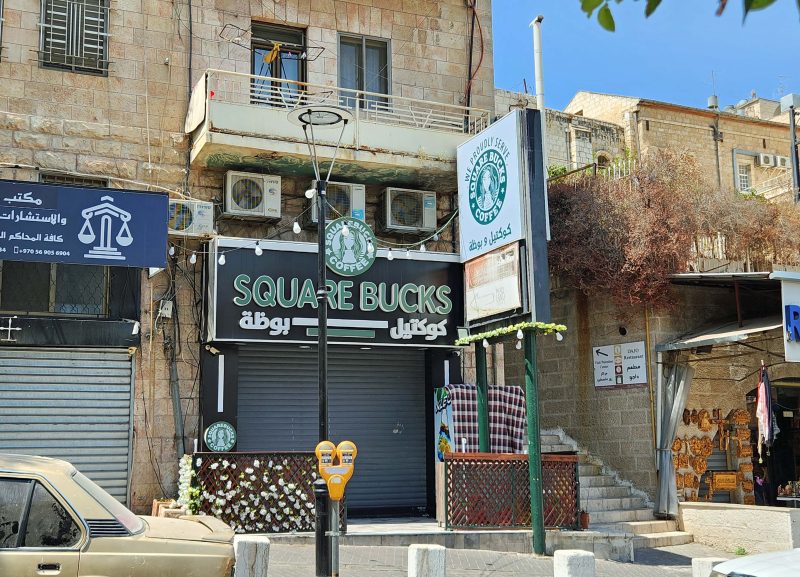
Another “smile sign” was this one in Egypt for Kentucky Fried Camel–a local joke.
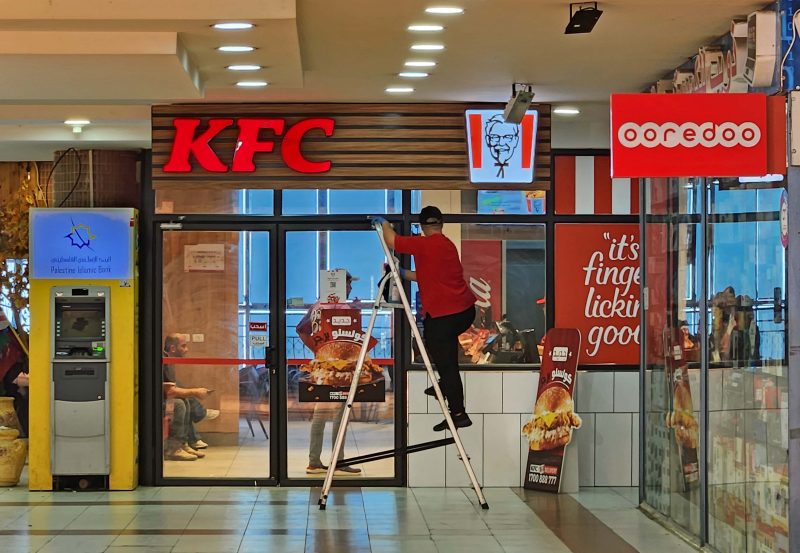
When we were at the Cairo airport for our flight to Istanbul, Ted saw this sign in the men’s room over a low urinal. It’s important to accommodate children.

I saw this bus while we were walking around Istanbul. The city is located on the Bosphorus Strait. Get it?

Who could resist an oxymoron like this near Ephesus, Türkiye?

Wondering where to have lunch in Kotor, Montenegro? This is the place.
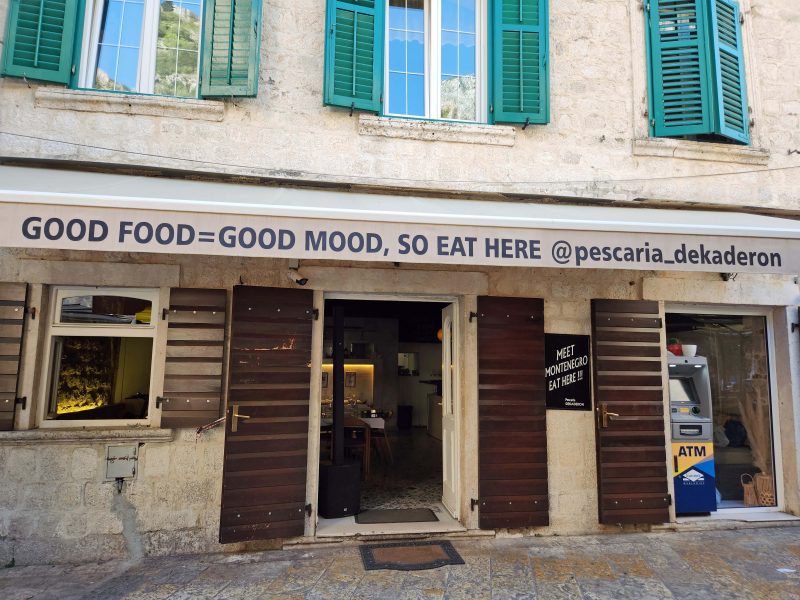
After lunch, you might want to go shopping in the Old City of Kotor to buy a souvenir like this.
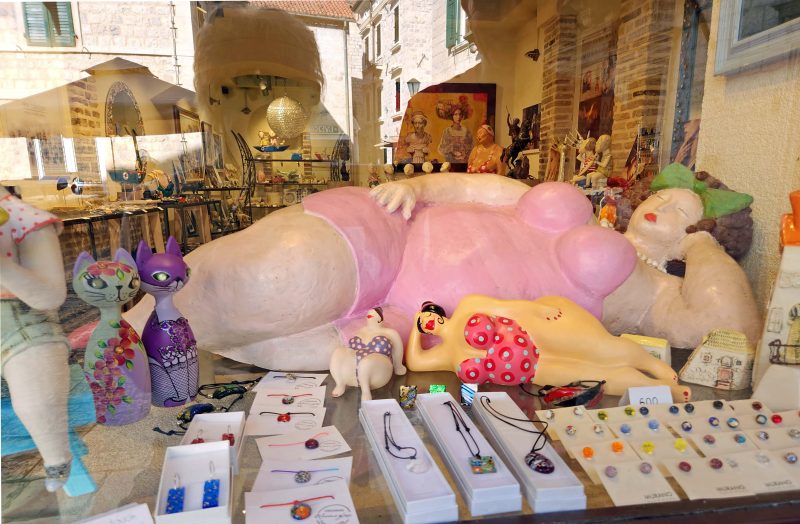
We saw these works of art (?) at an art exhibit in Dubrovnik, Croatia.
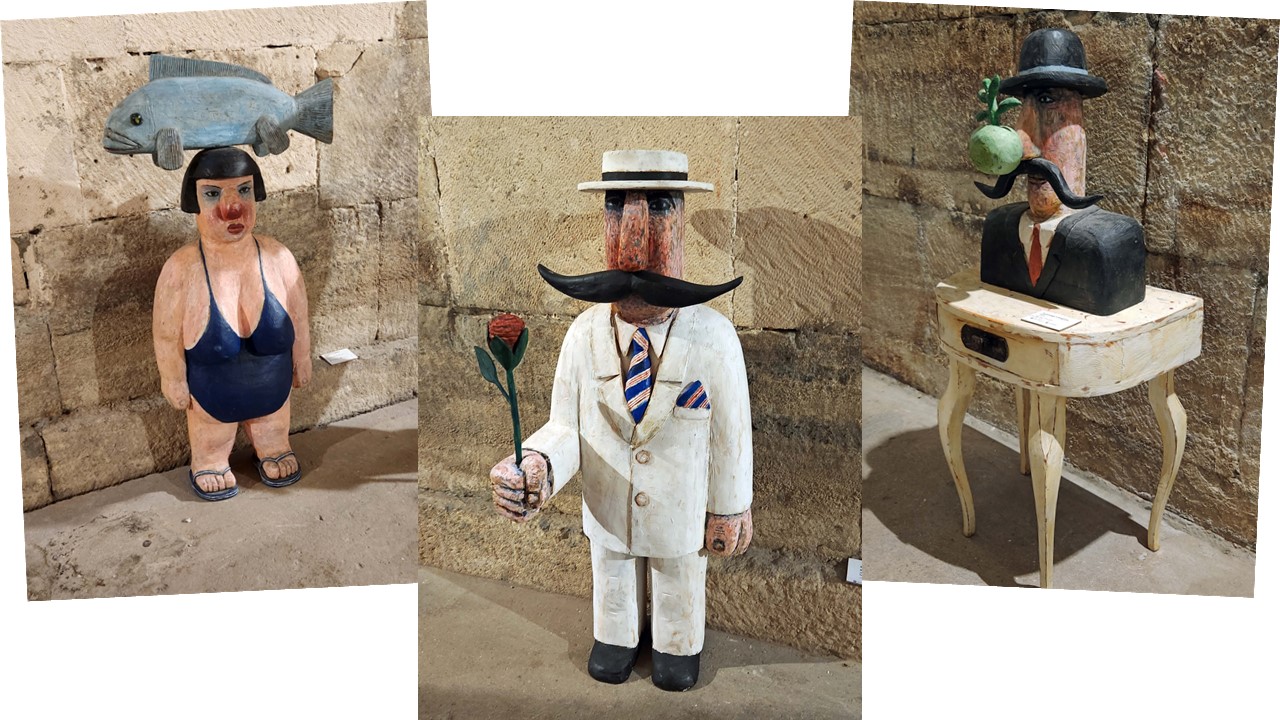
This statue of the Old Diviner was discovered in the excavation of Olympia, Greece. The nickname for it is “Zeus Talking on His Cell Phone.”
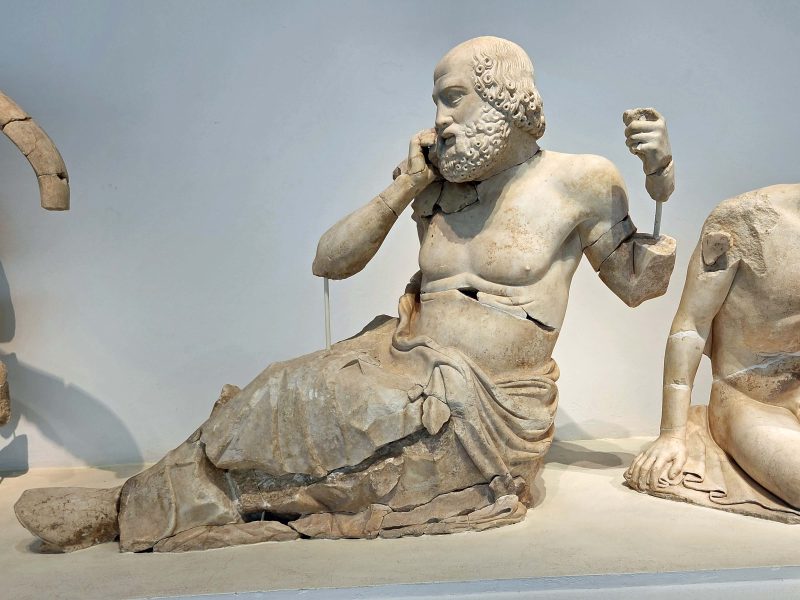
It reminded me of the statue of Apollo that Ted and I saw in the Louvre in 2016. In case you don’t recognize it, this is “Apollo Taking a Selfie.”
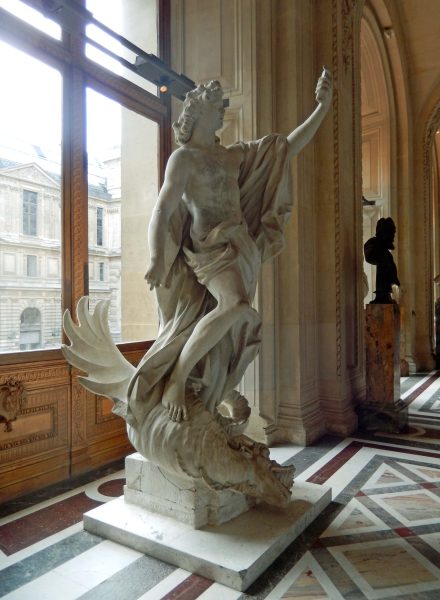
Yes, “Laughter is the closest distance between two people.” –Victor Borge
Split is located on a peninsula on the eastern shore of the Adriatic Sea. It is one of Croatia’s oldest cities and the second-largest city in the country after the capital, Zagreb. The city’s name evolved from the Greek Spalatum to Roman to Venetian and to Slavic before the Habsburg Monarchy settled on Split. The easy version of this evolution is the legend that says the city is named after a local flower. The picture below was our view of Split from the ship.
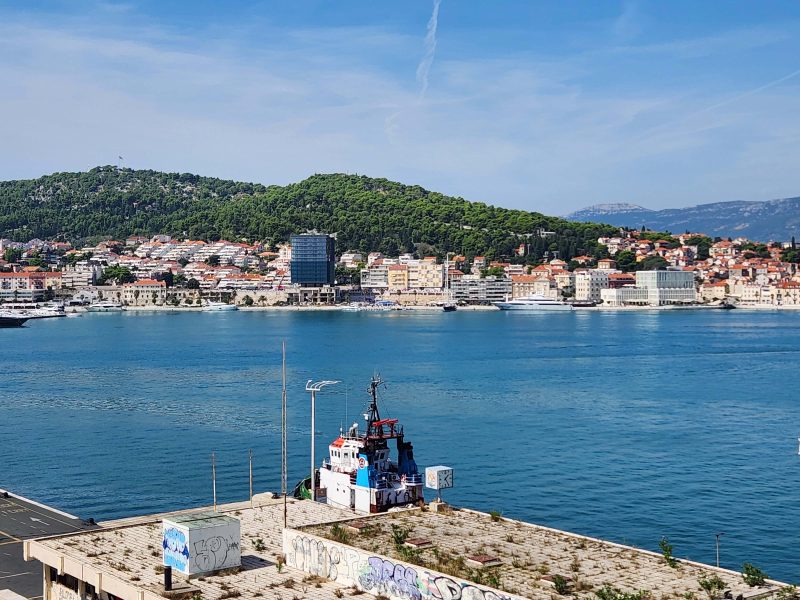
The dominant structure of Split is Diocletian’s Palace, built at the end of the third century as a retirement haven for the emperor Diocletian. It also included housing for a military garrison. It is the best-preserved palace from the late Roman antiquity and has become the Old Town of Split.
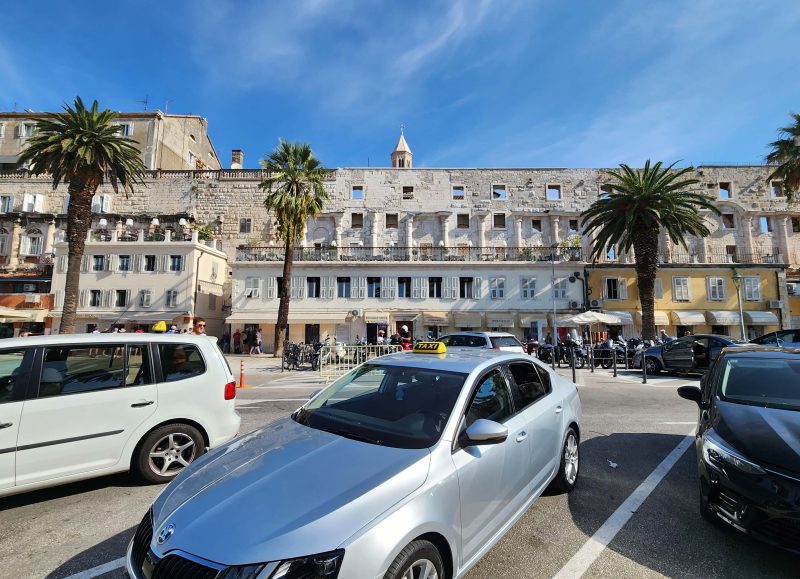
A statue of Marko Marulic stands beside the Central Palace Tower. Marulic was the national poet of Croatia as well as a lawyer and a judge. He lived in the 15th century and coined the term psychology. He was one of the most dynamic and influential theological and devotional writers of the Renaissance–and yet, even as an undergraduate English major with a master’s degree in English, I’ve never heard of him. Is he weeping because of my ignorance?
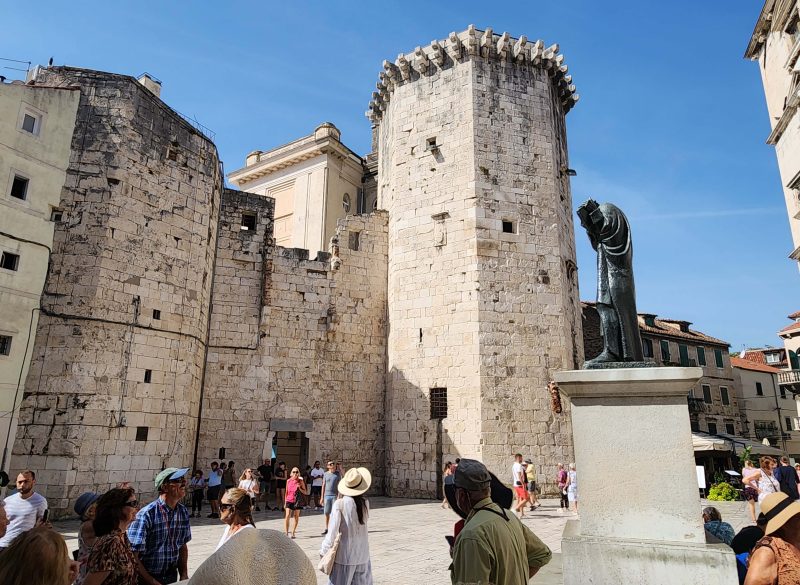
Diocletian’s Palace had four gates. The gates themselves did not survive, but the stone pillars and arches can still be seen. The Golden Gate on the north side of the palace was pretty in the afternoon light.
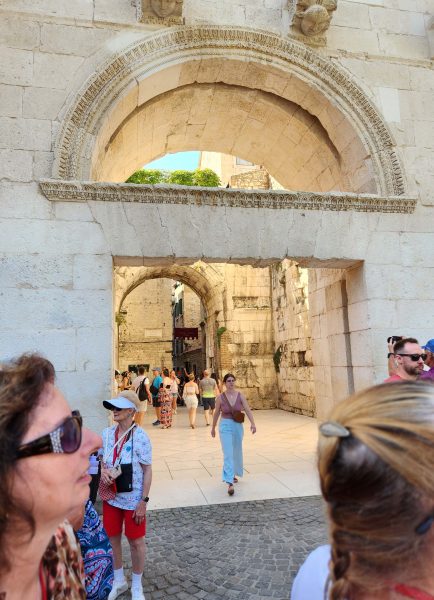
Split city life is interwined with life at the palace. For example, the Ethnographic Museum is inside the palace and the ancient basement hallways are lined with shops. There are many empty rooms in the palace that are used for local events. During our visit, several of the rooms featured an unusual art exhibit.
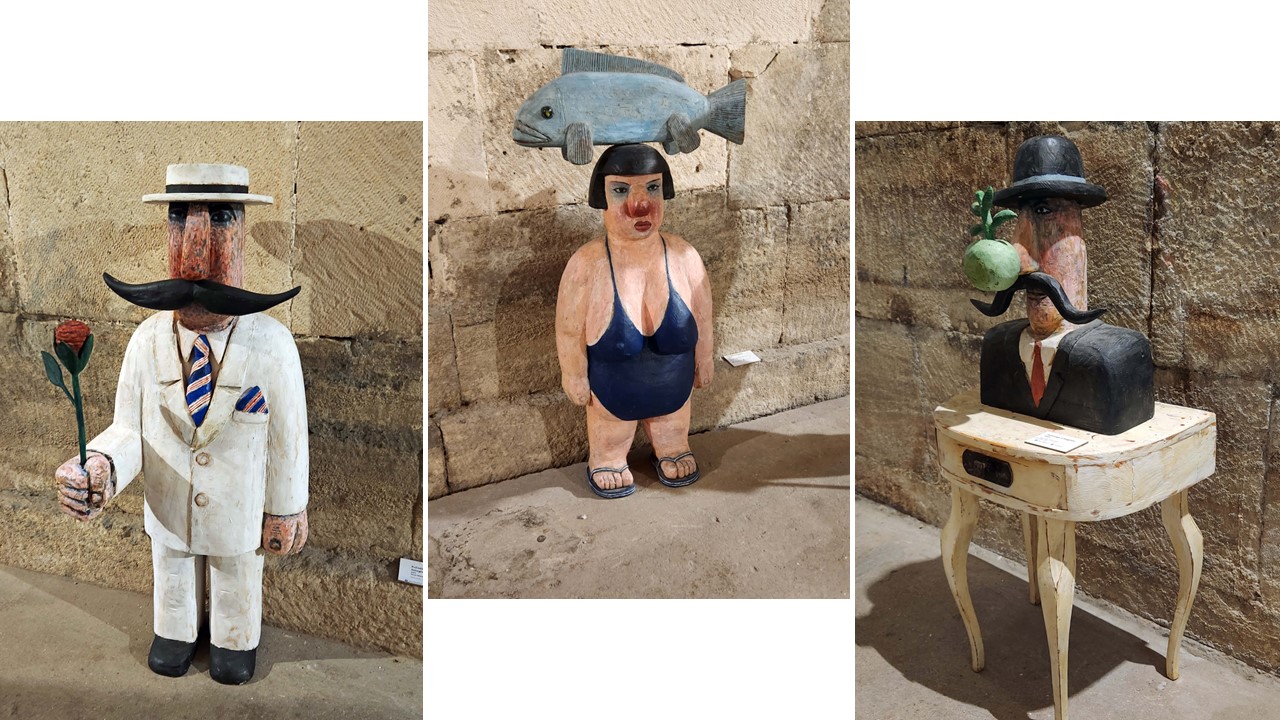
The cellars of Diocletian’s Palace are sometimes called the basement halls. Because it is situated on a hillside, the cellars were built to level the palace and to elevate the emperor’s apartments above them. The cellars were used for food and wine storage and gave the emperor access to the palace without having to disembark his ship. Here’s a picture of one of the basement halls.
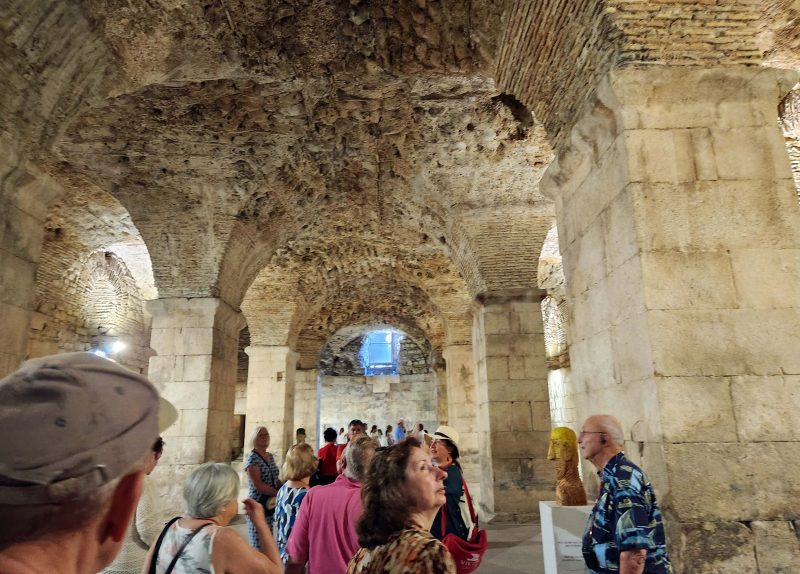
The palace cellars have a labyrinth of secret corridors called the lost tunnels. The long, horizontal log-like object in this tunnel was another of the unusual pieces from the current art exhibit.
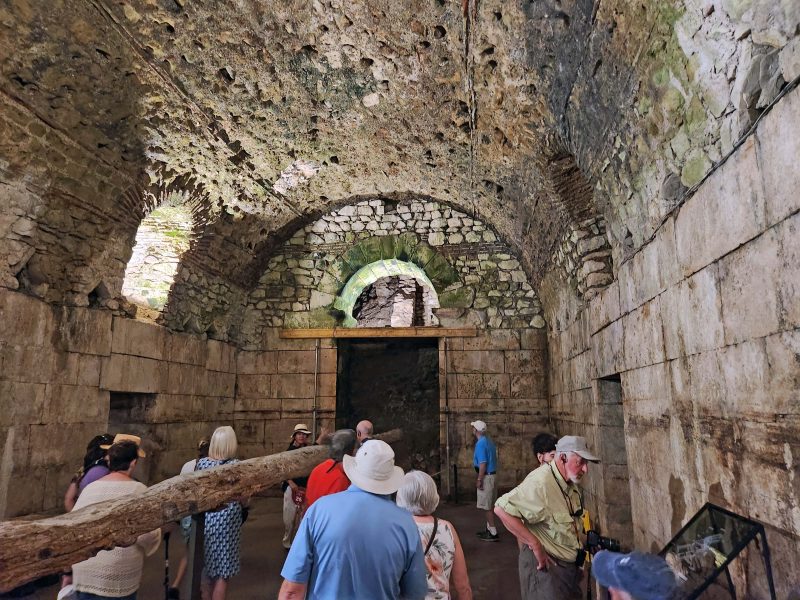
One of the basement rooms had a circular, slightly domed ceiling.

The room pictured below is called the Palace Vestibule or the Rotonda or the Atrium—take your pick. It was once the formal entrance to the imperial apartments. The acoustics in the room are wonderful, so people like to go there to sing.
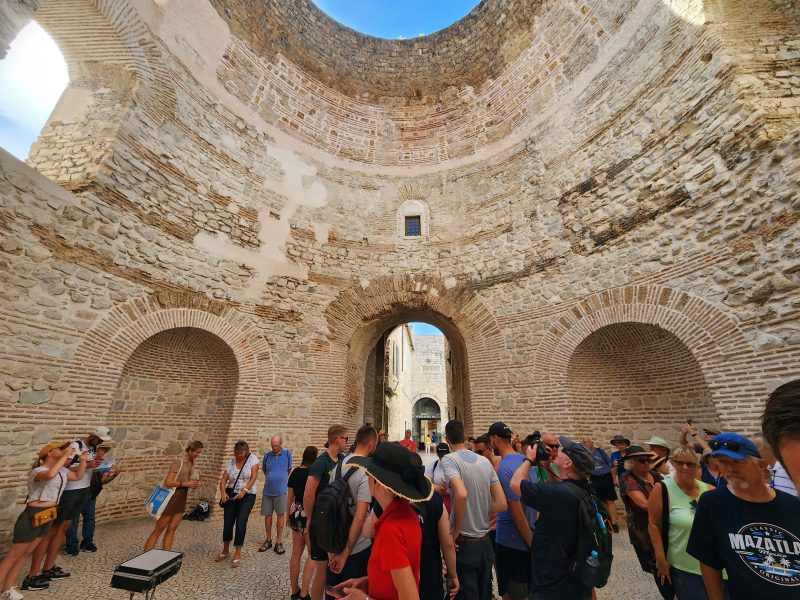
In the summer months, klapa groups perform folk songs in the Vestibule/Rotunda/Atrium, taking advantage of the acoustics to present a cappella performances. A klapa group has a first tenor, a baritone, and a bass singer. Voices can be doubled, up to a dozen male singers. Sometimes there are female groups, but the male and female groups do not generally perform together. We were here in September, so I guess it didn’t count as summer because this klapa group sang “Nearer My God to Thee” which is hardly a folk song. Whenever I hear that hymn, I can’t help thinking about the band playing that song while the Titanic sank—probably not the klapa group’s intended reaction.
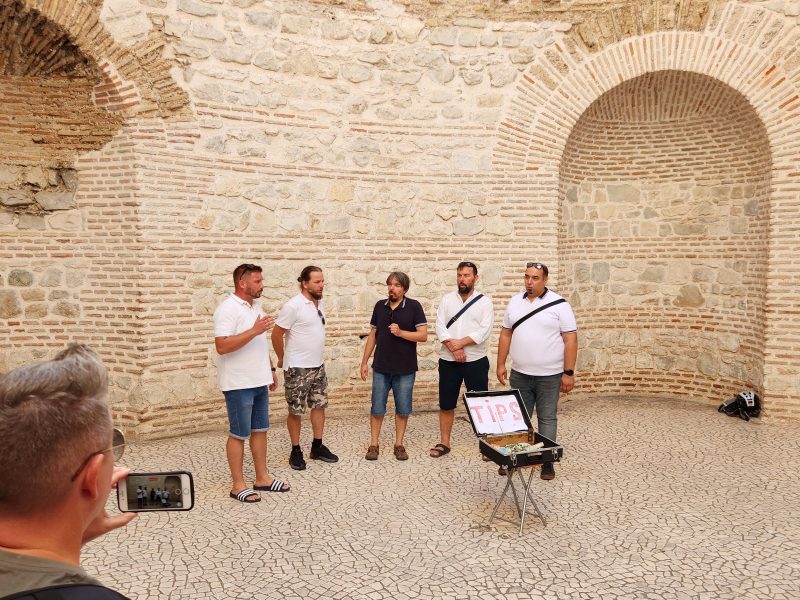
We left the palace, aka the Old Town, through this gate in the palace wall.
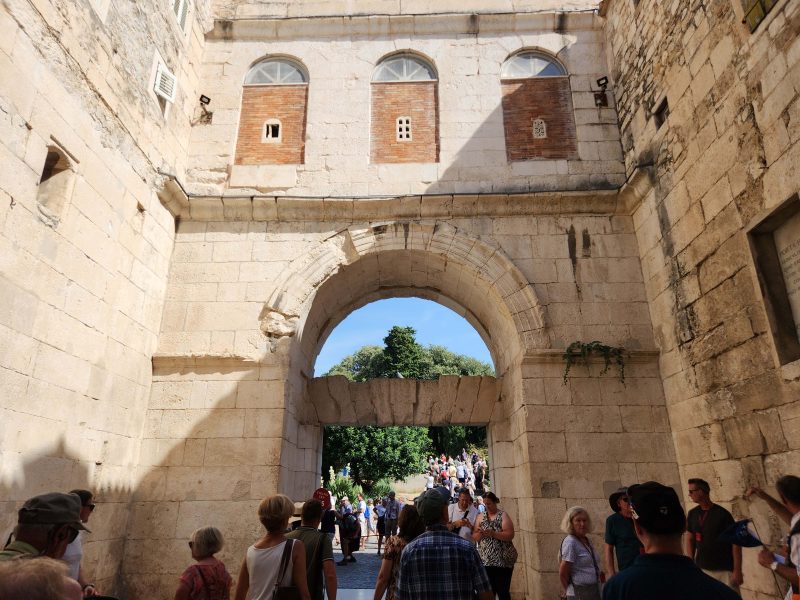
People still live in the Old Town of Split but the palace, which includes the entire Old Town, is a UNESCO World Heritage Site like Dubrovnik. That means, just like Dubrovnik, it’s mostly Airbnbs and it’s hard to renovate or to sell a building because of the preservation regulations.
Just outside the palace is People’s Square, the heart of Split. It was originally named Saint Lawrence’s Square in the 13th century, but no one calls it that. This was the first inhabited part of the city outside the palace and is still the center of public life in Split, with bars, restaurants, and shops.
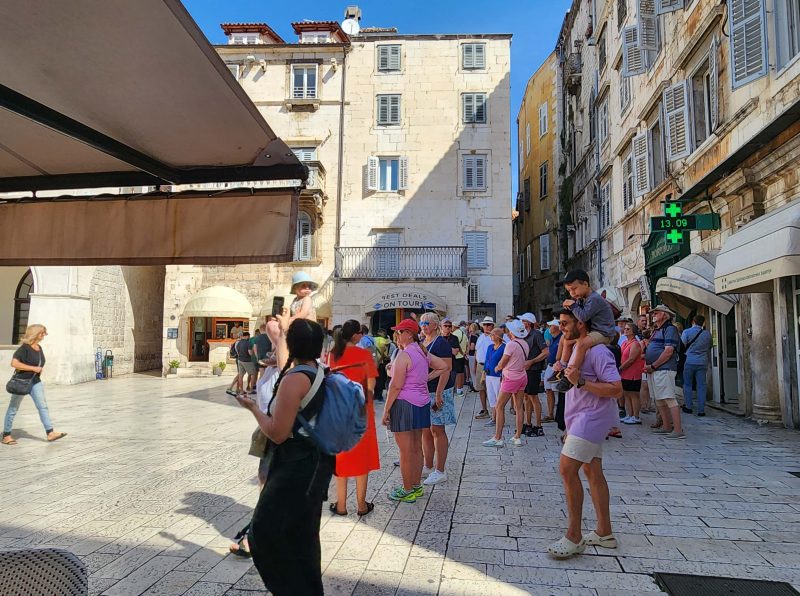
The city clock on the bell tower in People’s Square has been keeping time for centuries. It has an unusual face with 24 hourly markings, rather than twelve. The hours are inscribed in Roman numerals. Hour 12 is at the top and hour 24 is at the bottom where we are accustomed to seeing hour 6. The black arm with the indicator at the end tells the time—almost noon.
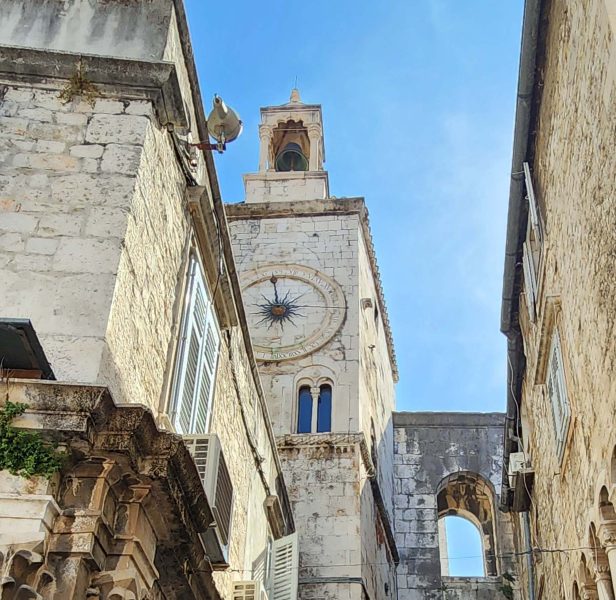
The St. Arnir Bell tower near the Golden Gate was once part of a Benedictine monastery at this site, but the monastery was destroyed by fire in 1945 and only the chapel and the bell tower survived. I think it makes a pretty picture against the blue sky.
